Social Media and Chechen Government
VerifiedAdded on 2020/06/03
|77
|24741
|155
AI Summary
This assignment investigates how the Chechen government utilizes social media for communication purposes. It explores the government's objectives in using platforms like Facebook, Twitter, and Instagram, as well as the perceived benefits and drawbacks for citizens. The questionnaire delves into topics such as transparency, citizen engagement, and the potential influence of social media on government policies.
Contribute Materials
Your contribution can guide someone’s learning journey. Share your
documents today.
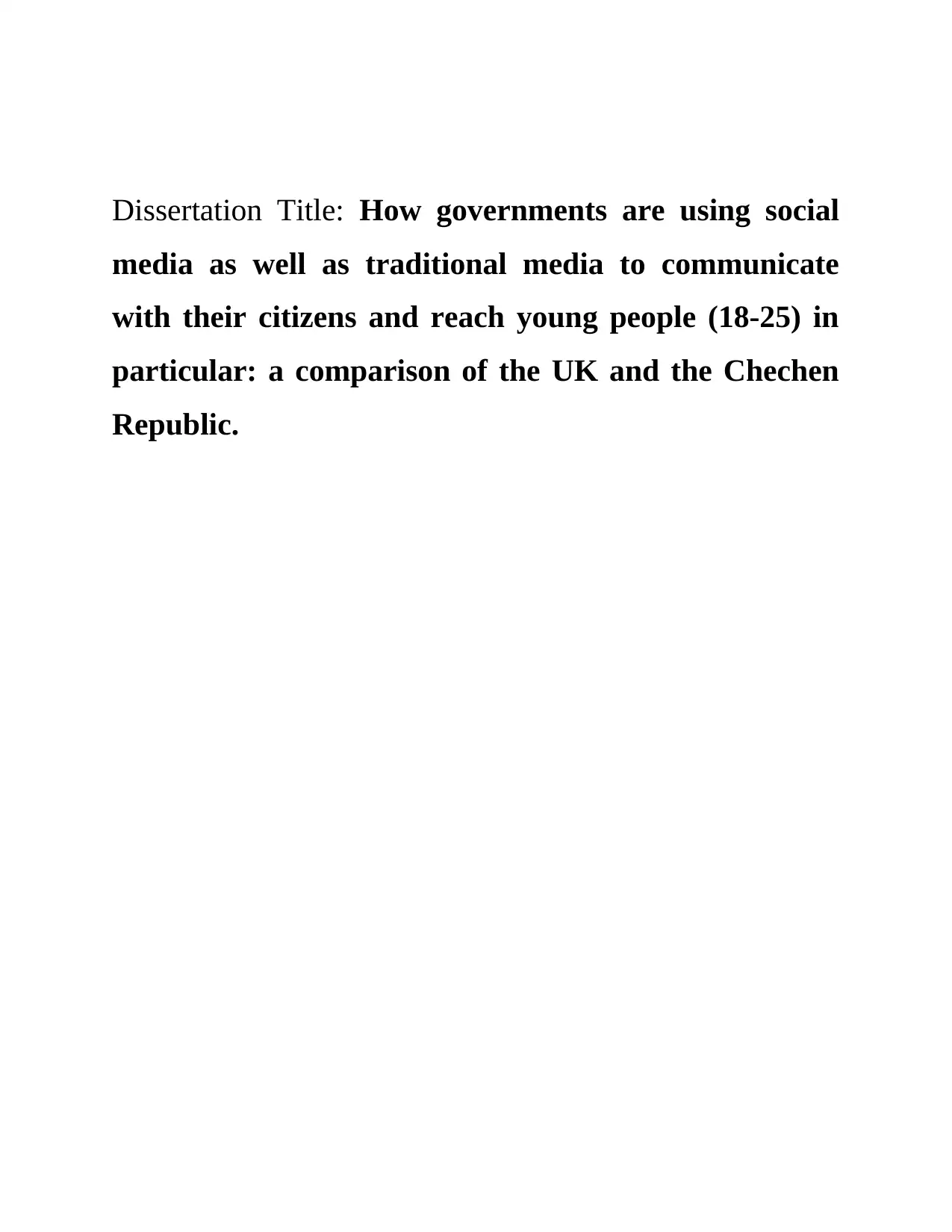
Dissertation Title: How governments are using social
media as well as traditional media to communicate
with their citizens and reach young people (18-25) in
particular: a comparison of the UK and the Chechen
Republic.
media as well as traditional media to communicate
with their citizens and reach young people (18-25) in
particular: a comparison of the UK and the Chechen
Republic.
Secure Best Marks with AI Grader
Need help grading? Try our AI Grader for instant feedback on your assignments.
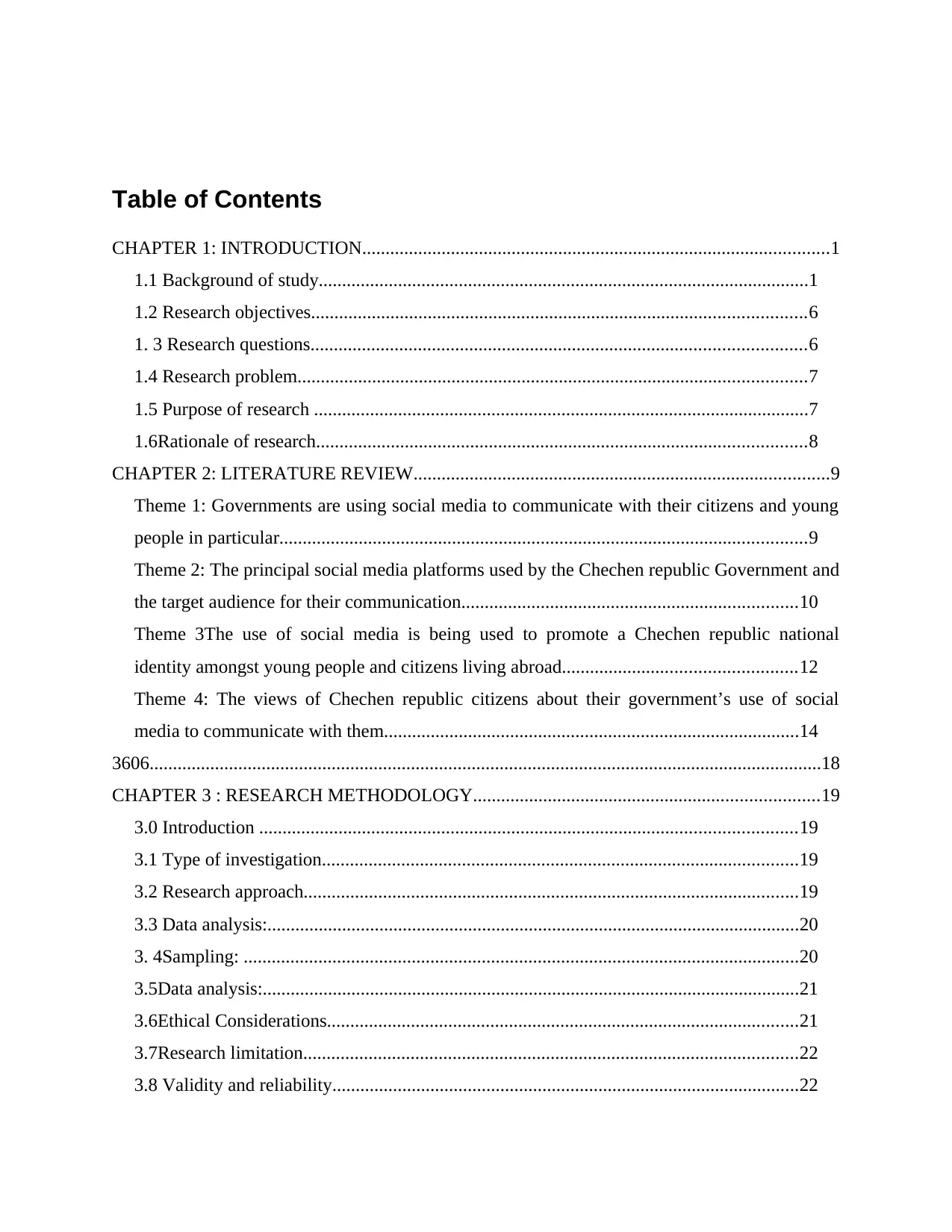
Table of Contents
CHAPTER 1: INTRODUCTION....................................................................................................1
1.1 Background of study.........................................................................................................1
1.2 Research objectives..........................................................................................................6
1. 3 Research questions..........................................................................................................6
1.4 Research problem.............................................................................................................7
1.5 Purpose of research ..........................................................................................................7
1.6Rationale of research.........................................................................................................8
CHAPTER 2: LITERATURE REVIEW.........................................................................................9
Theme 1: Governments are using social media to communicate with their citizens and young
people in particular.................................................................................................................9
Theme 2: The principal social media platforms used by the Chechen republic Government and
the target audience for their communication........................................................................10
Theme 3The use of social media is being used to promote a Chechen republic national
identity amongst young people and citizens living abroad..................................................12
Theme 4: The views of Chechen republic citizens about their government’s use of social
media to communicate with them.........................................................................................14
3606................................................................................................................................................18
CHAPTER 3 : RESEARCH METHODOLOGY..........................................................................19
3.0 Introduction ...................................................................................................................19
3.1 Type of investigation......................................................................................................19
3.2 Research approach..........................................................................................................19
3.3 Data analysis:..................................................................................................................20
3. 4Sampling: .......................................................................................................................20
3.5Data analysis:...................................................................................................................21
3.6Ethical Considerations.....................................................................................................21
3.7Research limitation..........................................................................................................22
3.8 Validity and reliability....................................................................................................22
CHAPTER 1: INTRODUCTION....................................................................................................1
1.1 Background of study.........................................................................................................1
1.2 Research objectives..........................................................................................................6
1. 3 Research questions..........................................................................................................6
1.4 Research problem.............................................................................................................7
1.5 Purpose of research ..........................................................................................................7
1.6Rationale of research.........................................................................................................8
CHAPTER 2: LITERATURE REVIEW.........................................................................................9
Theme 1: Governments are using social media to communicate with their citizens and young
people in particular.................................................................................................................9
Theme 2: The principal social media platforms used by the Chechen republic Government and
the target audience for their communication........................................................................10
Theme 3The use of social media is being used to promote a Chechen republic national
identity amongst young people and citizens living abroad..................................................12
Theme 4: The views of Chechen republic citizens about their government’s use of social
media to communicate with them.........................................................................................14
3606................................................................................................................................................18
CHAPTER 3 : RESEARCH METHODOLOGY..........................................................................19
3.0 Introduction ...................................................................................................................19
3.1 Type of investigation......................................................................................................19
3.2 Research approach..........................................................................................................19
3.3 Data analysis:..................................................................................................................20
3. 4Sampling: .......................................................................................................................20
3.5Data analysis:...................................................................................................................21
3.6Ethical Considerations.....................................................................................................21
3.7Research limitation..........................................................................................................22
3.8 Validity and reliability....................................................................................................22
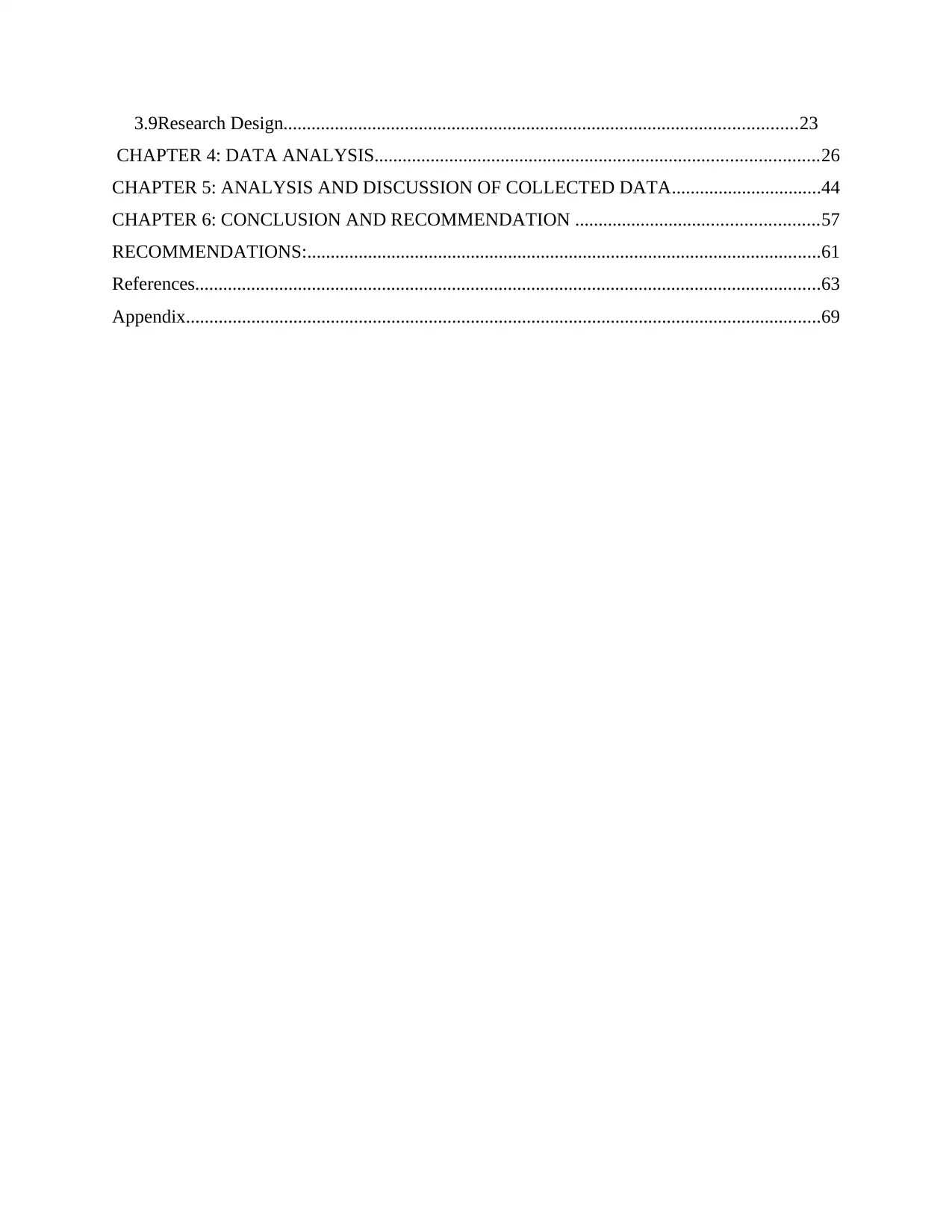
3.9Research Design..............................................................................................................23
CHAPTER 4: DATA ANALYSIS...............................................................................................26
CHAPTER 5: ANALYSIS AND DISCUSSION OF COLLECTED DATA................................44
CHAPTER 6: CONCLUSION AND RECOMMENDATION ....................................................57
RECOMMENDATIONS:..............................................................................................................61
References......................................................................................................................................63
Appendix........................................................................................................................................69
CHAPTER 4: DATA ANALYSIS...............................................................................................26
CHAPTER 5: ANALYSIS AND DISCUSSION OF COLLECTED DATA................................44
CHAPTER 6: CONCLUSION AND RECOMMENDATION ....................................................57
RECOMMENDATIONS:..............................................................................................................61
References......................................................................................................................................63
Appendix........................................................................................................................................69
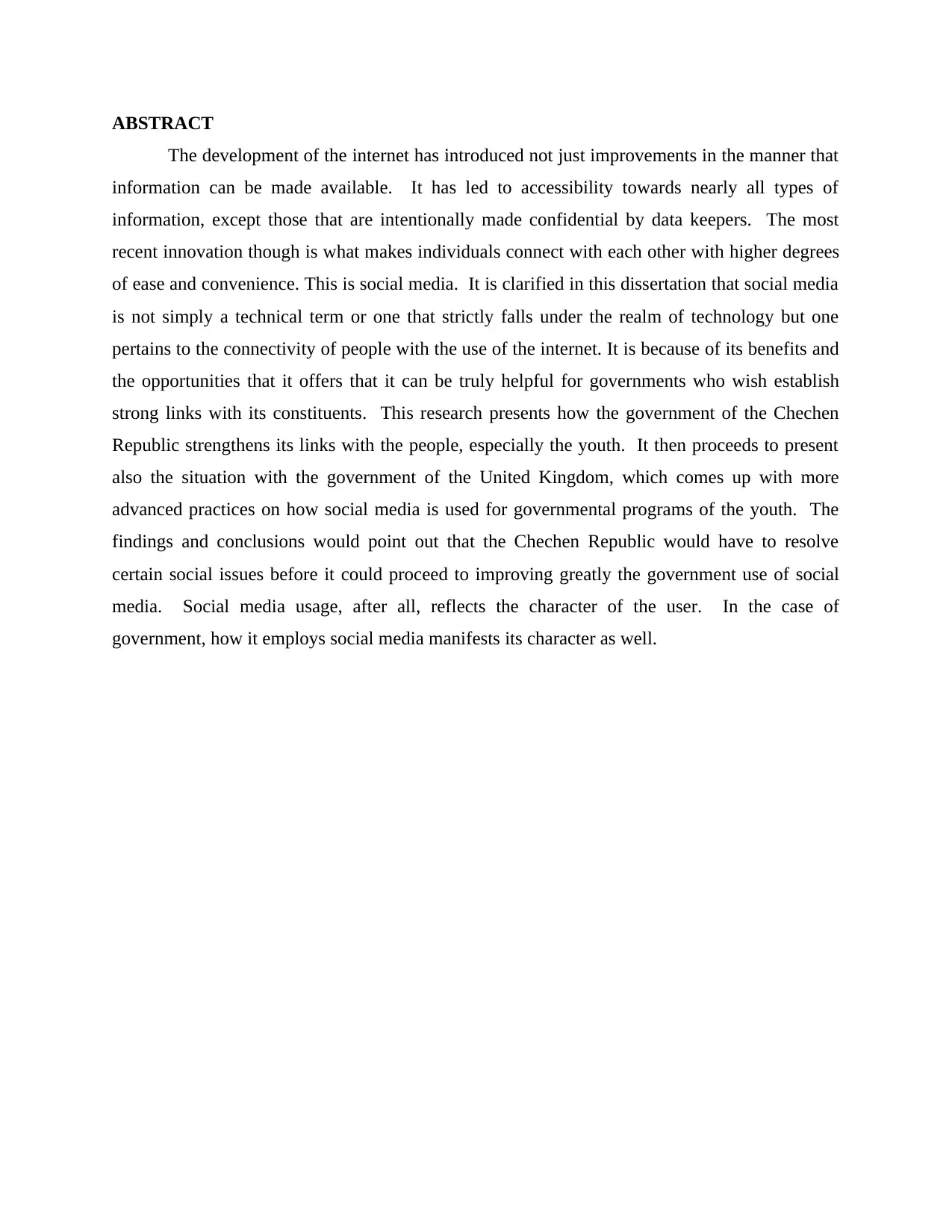
ABSTRACT
The development of the internet has introduced not just improvements in the manner that
information can be made available. It has led to accessibility towards nearly all types of
information, except those that are intentionally made confidential by data keepers. The most
recent innovation though is what makes individuals connect with each other with higher degrees
of ease and convenience. This is social media. It is clarified in this dissertation that social media
is not simply a technical term or one that strictly falls under the realm of technology but one
pertains to the connectivity of people with the use of the internet. It is because of its benefits and
the opportunities that it offers that it can be truly helpful for governments who wish establish
strong links with its constituents. This research presents how the government of the Chechen
Republic strengthens its links with the people, especially the youth. It then proceeds to present
also the situation with the government of the United Kingdom, which comes up with more
advanced practices on how social media is used for governmental programs of the youth. The
findings and conclusions would point out that the Chechen Republic would have to resolve
certain social issues before it could proceed to improving greatly the government use of social
media. Social media usage, after all, reflects the character of the user. In the case of
government, how it employs social media manifests its character as well.
The development of the internet has introduced not just improvements in the manner that
information can be made available. It has led to accessibility towards nearly all types of
information, except those that are intentionally made confidential by data keepers. The most
recent innovation though is what makes individuals connect with each other with higher degrees
of ease and convenience. This is social media. It is clarified in this dissertation that social media
is not simply a technical term or one that strictly falls under the realm of technology but one
pertains to the connectivity of people with the use of the internet. It is because of its benefits and
the opportunities that it offers that it can be truly helpful for governments who wish establish
strong links with its constituents. This research presents how the government of the Chechen
Republic strengthens its links with the people, especially the youth. It then proceeds to present
also the situation with the government of the United Kingdom, which comes up with more
advanced practices on how social media is used for governmental programs of the youth. The
findings and conclusions would point out that the Chechen Republic would have to resolve
certain social issues before it could proceed to improving greatly the government use of social
media. Social media usage, after all, reflects the character of the user. In the case of
government, how it employs social media manifests its character as well.
Secure Best Marks with AI Grader
Need help grading? Try our AI Grader for instant feedback on your assignments.
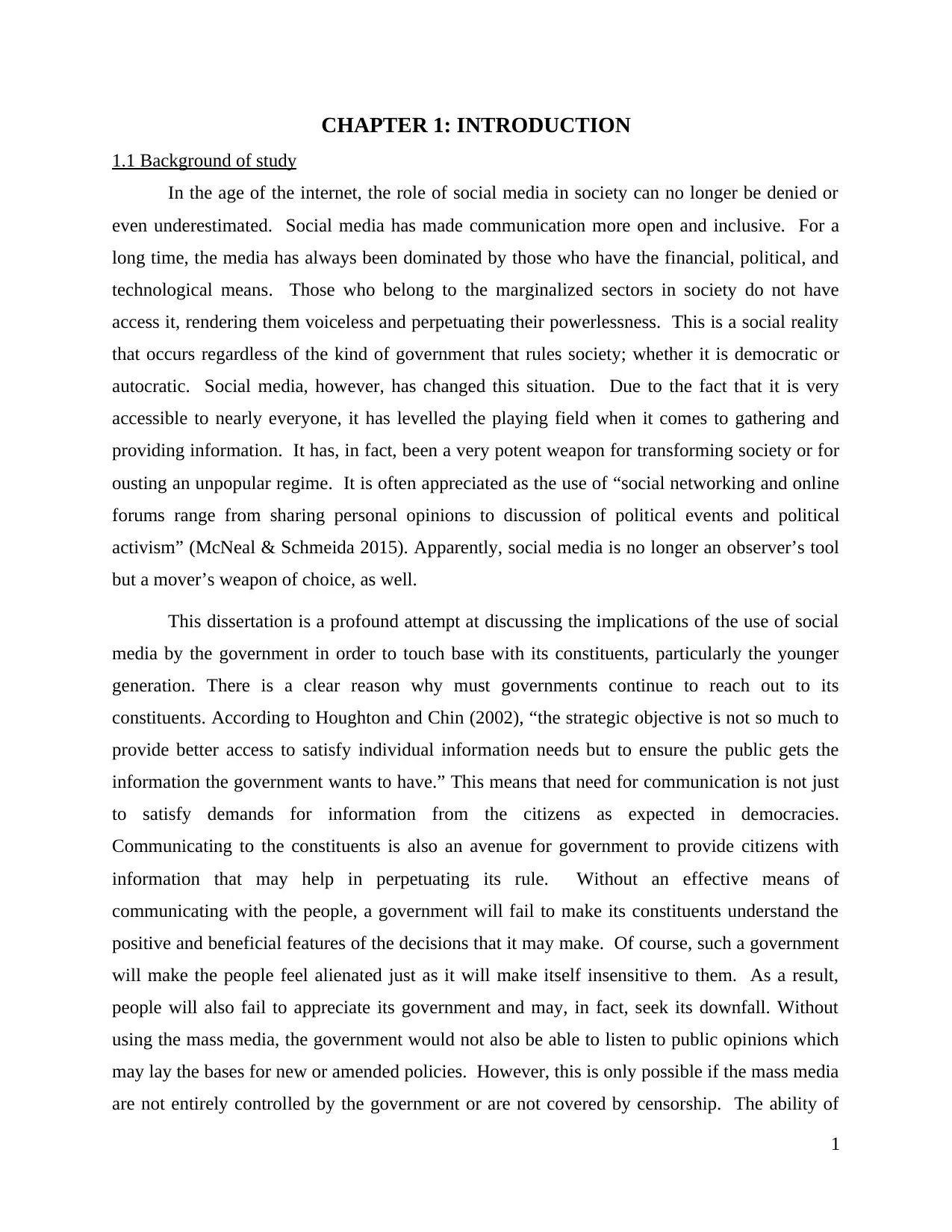
CHAPTER 1: INTRODUCTION
1.1 Background of study
In the age of the internet, the role of social media in society can no longer be denied or
even underestimated. Social media has made communication more open and inclusive. For a
long time, the media has always been dominated by those who have the financial, political, and
technological means. Those who belong to the marginalized sectors in society do not have
access it, rendering them voiceless and perpetuating their powerlessness. This is a social reality
that occurs regardless of the kind of government that rules society; whether it is democratic or
autocratic. Social media, however, has changed this situation. Due to the fact that it is very
accessible to nearly everyone, it has levelled the playing field when it comes to gathering and
providing information. It has, in fact, been a very potent weapon for transforming society or for
ousting an unpopular regime. It is often appreciated as the use of “social networking and online
forums range from sharing personal opinions to discussion of political events and political
activism” (McNeal & Schmeida 2015). Apparently, social media is no longer an observer’s tool
but a mover’s weapon of choice, as well.
This dissertation is a profound attempt at discussing the implications of the use of social
media by the government in order to touch base with its constituents, particularly the younger
generation. There is a clear reason why must governments continue to reach out to its
constituents. According to Houghton and Chin (2002), “the strategic objective is not so much to
provide better access to satisfy individual information needs but to ensure the public gets the
information the government wants to have.” This means that need for communication is not just
to satisfy demands for information from the citizens as expected in democracies.
Communicating to the constituents is also an avenue for government to provide citizens with
information that may help in perpetuating its rule. Without an effective means of
communicating with the people, a government will fail to make its constituents understand the
positive and beneficial features of the decisions that it may make. Of course, such a government
will make the people feel alienated just as it will make itself insensitive to them. As a result,
people will also fail to appreciate its government and may, in fact, seek its downfall. Without
using the mass media, the government would not also be able to listen to public opinions which
may lay the bases for new or amended policies. However, this is only possible if the mass media
are not entirely controlled by the government or are not covered by censorship. The ability of
1
1.1 Background of study
In the age of the internet, the role of social media in society can no longer be denied or
even underestimated. Social media has made communication more open and inclusive. For a
long time, the media has always been dominated by those who have the financial, political, and
technological means. Those who belong to the marginalized sectors in society do not have
access it, rendering them voiceless and perpetuating their powerlessness. This is a social reality
that occurs regardless of the kind of government that rules society; whether it is democratic or
autocratic. Social media, however, has changed this situation. Due to the fact that it is very
accessible to nearly everyone, it has levelled the playing field when it comes to gathering and
providing information. It has, in fact, been a very potent weapon for transforming society or for
ousting an unpopular regime. It is often appreciated as the use of “social networking and online
forums range from sharing personal opinions to discussion of political events and political
activism” (McNeal & Schmeida 2015). Apparently, social media is no longer an observer’s tool
but a mover’s weapon of choice, as well.
This dissertation is a profound attempt at discussing the implications of the use of social
media by the government in order to touch base with its constituents, particularly the younger
generation. There is a clear reason why must governments continue to reach out to its
constituents. According to Houghton and Chin (2002), “the strategic objective is not so much to
provide better access to satisfy individual information needs but to ensure the public gets the
information the government wants to have.” This means that need for communication is not just
to satisfy demands for information from the citizens as expected in democracies.
Communicating to the constituents is also an avenue for government to provide citizens with
information that may help in perpetuating its rule. Without an effective means of
communicating with the people, a government will fail to make its constituents understand the
positive and beneficial features of the decisions that it may make. Of course, such a government
will make the people feel alienated just as it will make itself insensitive to them. As a result,
people will also fail to appreciate its government and may, in fact, seek its downfall. Without
using the mass media, the government would not also be able to listen to public opinions which
may lay the bases for new or amended policies. However, this is only possible if the mass media
are not entirely controlled by the government or are not covered by censorship. The ability of
1
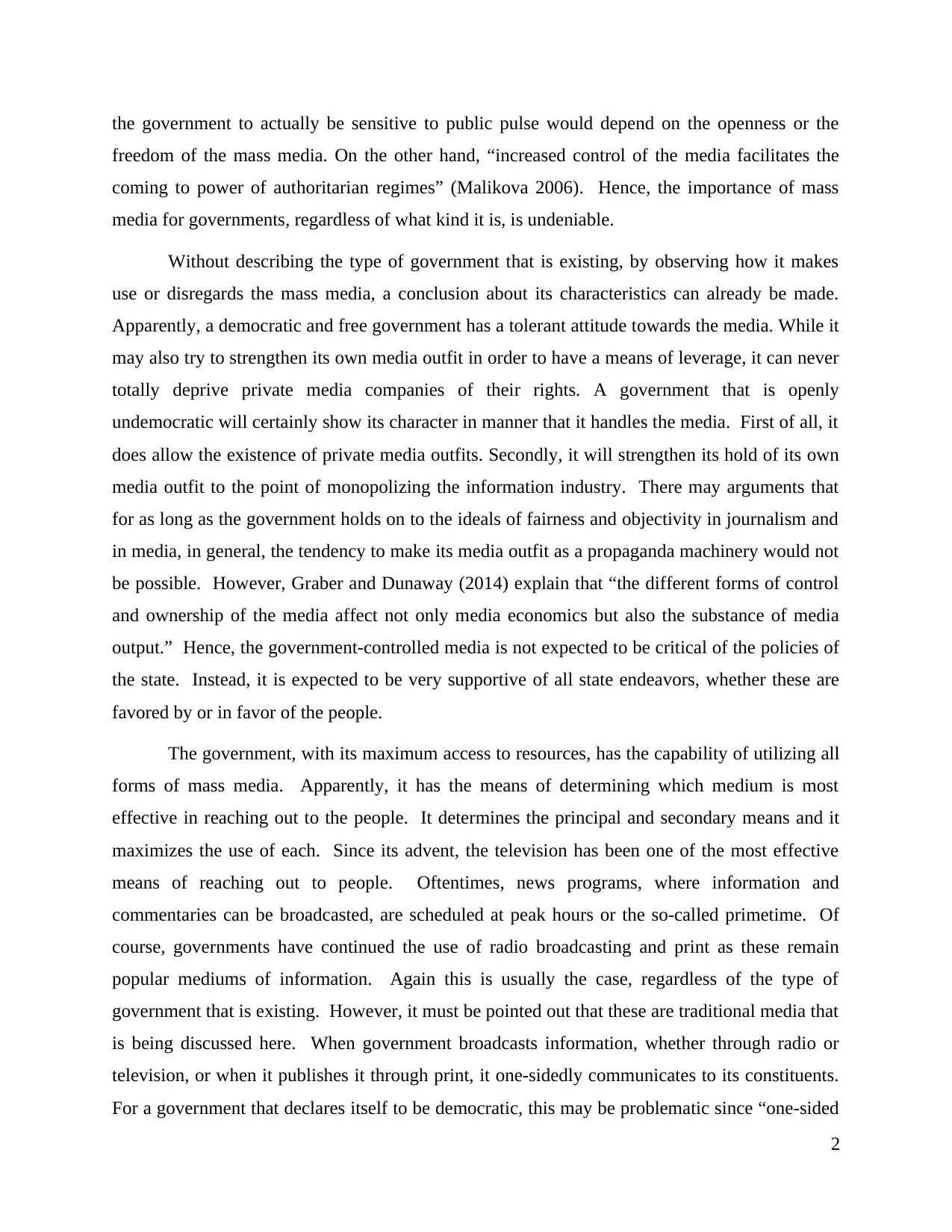
the government to actually be sensitive to public pulse would depend on the openness or the
freedom of the mass media. On the other hand, “increased control of the media facilitates the
coming to power of authoritarian regimes” (Malikova 2006). Hence, the importance of mass
media for governments, regardless of what kind it is, is undeniable.
Without describing the type of government that is existing, by observing how it makes
use or disregards the mass media, a conclusion about its characteristics can already be made.
Apparently, a democratic and free government has a tolerant attitude towards the media. While it
may also try to strengthen its own media outfit in order to have a means of leverage, it can never
totally deprive private media companies of their rights. A government that is openly
undemocratic will certainly show its character in manner that it handles the media. First of all, it
does allow the existence of private media outfits. Secondly, it will strengthen its hold of its own
media outfit to the point of monopolizing the information industry. There may arguments that
for as long as the government holds on to the ideals of fairness and objectivity in journalism and
in media, in general, the tendency to make its media outfit as a propaganda machinery would not
be possible. However, Graber and Dunaway (2014) explain that “the different forms of control
and ownership of the media affect not only media economics but also the substance of media
output.” Hence, the government-controlled media is not expected to be critical of the policies of
the state. Instead, it is expected to be very supportive of all state endeavors, whether these are
favored by or in favor of the people.
The government, with its maximum access to resources, has the capability of utilizing all
forms of mass media. Apparently, it has the means of determining which medium is most
effective in reaching out to the people. It determines the principal and secondary means and it
maximizes the use of each. Since its advent, the television has been one of the most effective
means of reaching out to people. Oftentimes, news programs, where information and
commentaries can be broadcasted, are scheduled at peak hours or the so-called primetime. Of
course, governments have continued the use of radio broadcasting and print as these remain
popular mediums of information. Again this is usually the case, regardless of the type of
government that is existing. However, it must be pointed out that these are traditional media that
is being discussed here. When government broadcasts information, whether through radio or
television, or when it publishes it through print, it one-sidedly communicates to its constituents.
For a government that declares itself to be democratic, this may be problematic since “one-sided
2
freedom of the mass media. On the other hand, “increased control of the media facilitates the
coming to power of authoritarian regimes” (Malikova 2006). Hence, the importance of mass
media for governments, regardless of what kind it is, is undeniable.
Without describing the type of government that is existing, by observing how it makes
use or disregards the mass media, a conclusion about its characteristics can already be made.
Apparently, a democratic and free government has a tolerant attitude towards the media. While it
may also try to strengthen its own media outfit in order to have a means of leverage, it can never
totally deprive private media companies of their rights. A government that is openly
undemocratic will certainly show its character in manner that it handles the media. First of all, it
does allow the existence of private media outfits. Secondly, it will strengthen its hold of its own
media outfit to the point of monopolizing the information industry. There may arguments that
for as long as the government holds on to the ideals of fairness and objectivity in journalism and
in media, in general, the tendency to make its media outfit as a propaganda machinery would not
be possible. However, Graber and Dunaway (2014) explain that “the different forms of control
and ownership of the media affect not only media economics but also the substance of media
output.” Hence, the government-controlled media is not expected to be critical of the policies of
the state. Instead, it is expected to be very supportive of all state endeavors, whether these are
favored by or in favor of the people.
The government, with its maximum access to resources, has the capability of utilizing all
forms of mass media. Apparently, it has the means of determining which medium is most
effective in reaching out to the people. It determines the principal and secondary means and it
maximizes the use of each. Since its advent, the television has been one of the most effective
means of reaching out to people. Oftentimes, news programs, where information and
commentaries can be broadcasted, are scheduled at peak hours or the so-called primetime. Of
course, governments have continued the use of radio broadcasting and print as these remain
popular mediums of information. Again this is usually the case, regardless of the type of
government that is existing. However, it must be pointed out that these are traditional media that
is being discussed here. When government broadcasts information, whether through radio or
television, or when it publishes it through print, it one-sidedly communicates to its constituents.
For a government that declares itself to be democratic, this may be problematic since “one-sided
2
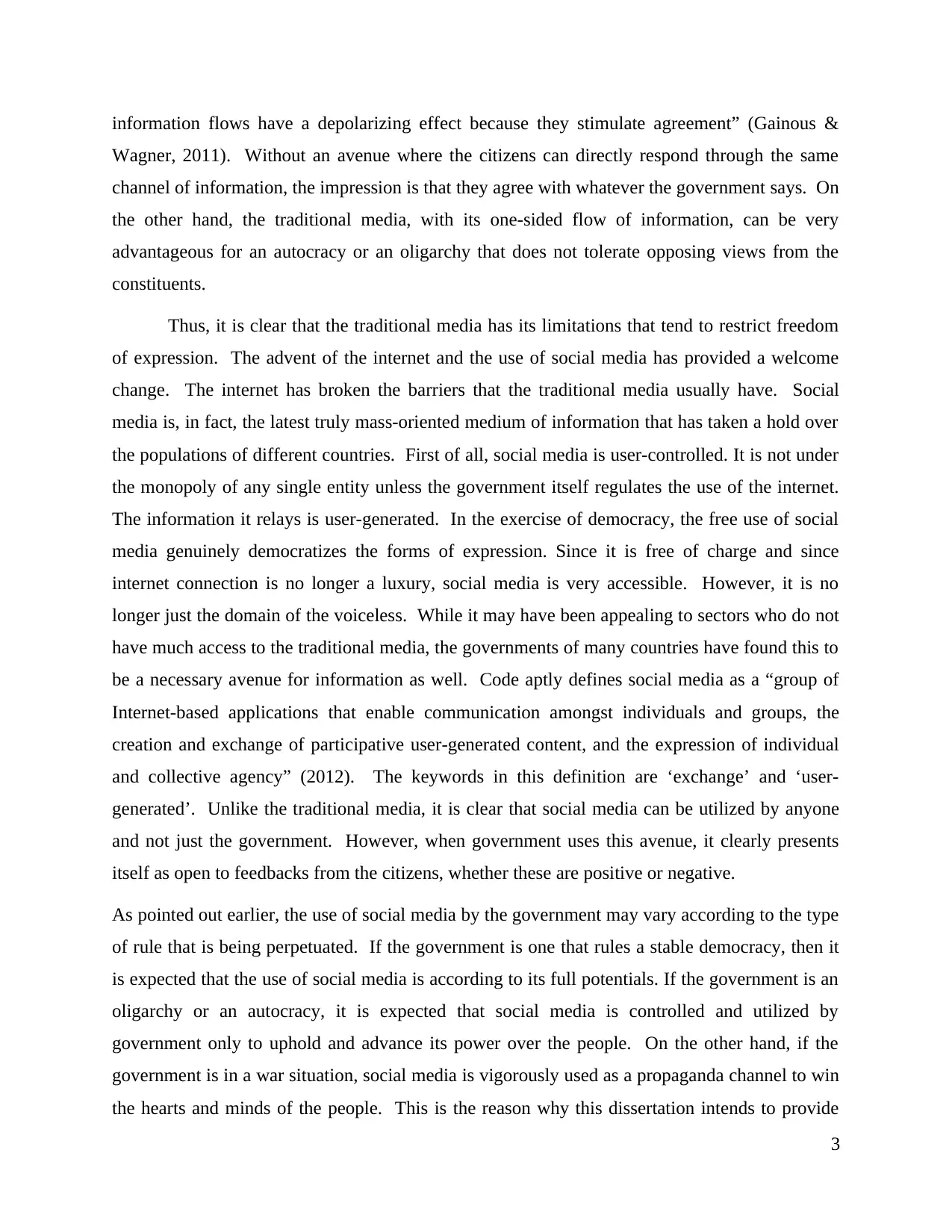
information flows have a depolarizing effect because they stimulate agreement” (Gainous &
Wagner, 2011). Without an avenue where the citizens can directly respond through the same
channel of information, the impression is that they agree with whatever the government says. On
the other hand, the traditional media, with its one-sided flow of information, can be very
advantageous for an autocracy or an oligarchy that does not tolerate opposing views from the
constituents.
Thus, it is clear that the traditional media has its limitations that tend to restrict freedom
of expression. The advent of the internet and the use of social media has provided a welcome
change. The internet has broken the barriers that the traditional media usually have. Social
media is, in fact, the latest truly mass-oriented medium of information that has taken a hold over
the populations of different countries. First of all, social media is user-controlled. It is not under
the monopoly of any single entity unless the government itself regulates the use of the internet.
The information it relays is user-generated. In the exercise of democracy, the free use of social
media genuinely democratizes the forms of expression. Since it is free of charge and since
internet connection is no longer a luxury, social media is very accessible. However, it is no
longer just the domain of the voiceless. While it may have been appealing to sectors who do not
have much access to the traditional media, the governments of many countries have found this to
be a necessary avenue for information as well. Code aptly defines social media as a “group of
Internet-based applications that enable communication amongst individuals and groups, the
creation and exchange of participative user-generated content, and the expression of individual
and collective agency” (2012). The keywords in this definition are ‘exchange’ and ‘user-
generated’. Unlike the traditional media, it is clear that social media can be utilized by anyone
and not just the government. However, when government uses this avenue, it clearly presents
itself as open to feedbacks from the citizens, whether these are positive or negative.
As pointed out earlier, the use of social media by the government may vary according to the type
of rule that is being perpetuated. If the government is one that rules a stable democracy, then it
is expected that the use of social media is according to its full potentials. If the government is an
oligarchy or an autocracy, it is expected that social media is controlled and utilized by
government only to uphold and advance its power over the people. On the other hand, if the
government is in a war situation, social media is vigorously used as a propaganda channel to win
the hearts and minds of the people. This is the reason why this dissertation intends to provide
3
Wagner, 2011). Without an avenue where the citizens can directly respond through the same
channel of information, the impression is that they agree with whatever the government says. On
the other hand, the traditional media, with its one-sided flow of information, can be very
advantageous for an autocracy or an oligarchy that does not tolerate opposing views from the
constituents.
Thus, it is clear that the traditional media has its limitations that tend to restrict freedom
of expression. The advent of the internet and the use of social media has provided a welcome
change. The internet has broken the barriers that the traditional media usually have. Social
media is, in fact, the latest truly mass-oriented medium of information that has taken a hold over
the populations of different countries. First of all, social media is user-controlled. It is not under
the monopoly of any single entity unless the government itself regulates the use of the internet.
The information it relays is user-generated. In the exercise of democracy, the free use of social
media genuinely democratizes the forms of expression. Since it is free of charge and since
internet connection is no longer a luxury, social media is very accessible. However, it is no
longer just the domain of the voiceless. While it may have been appealing to sectors who do not
have much access to the traditional media, the governments of many countries have found this to
be a necessary avenue for information as well. Code aptly defines social media as a “group of
Internet-based applications that enable communication amongst individuals and groups, the
creation and exchange of participative user-generated content, and the expression of individual
and collective agency” (2012). The keywords in this definition are ‘exchange’ and ‘user-
generated’. Unlike the traditional media, it is clear that social media can be utilized by anyone
and not just the government. However, when government uses this avenue, it clearly presents
itself as open to feedbacks from the citizens, whether these are positive or negative.
As pointed out earlier, the use of social media by the government may vary according to the type
of rule that is being perpetuated. If the government is one that rules a stable democracy, then it
is expected that the use of social media is according to its full potentials. If the government is an
oligarchy or an autocracy, it is expected that social media is controlled and utilized by
government only to uphold and advance its power over the people. On the other hand, if the
government is in a war situation, social media is vigorously used as a propaganda channel to win
the hearts and minds of the people. This is the reason why this dissertation intends to provide
3
Paraphrase This Document
Need a fresh take? Get an instant paraphrase of this document with our AI Paraphraser
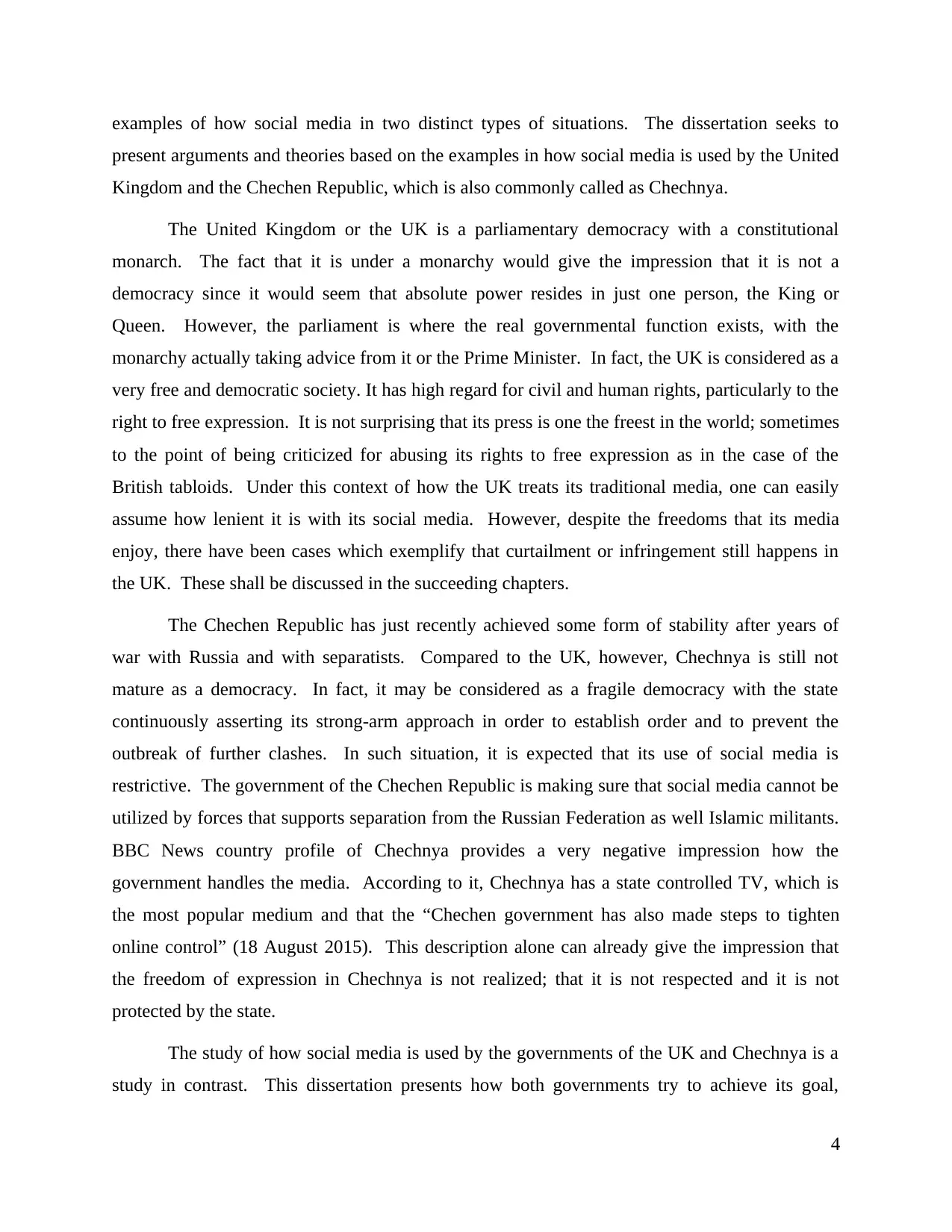
examples of how social media in two distinct types of situations. The dissertation seeks to
present arguments and theories based on the examples in how social media is used by the United
Kingdom and the Chechen Republic, which is also commonly called as Chechnya.
The United Kingdom or the UK is a parliamentary democracy with a constitutional
monarch. The fact that it is under a monarchy would give the impression that it is not a
democracy since it would seem that absolute power resides in just one person, the King or
Queen. However, the parliament is where the real governmental function exists, with the
monarchy actually taking advice from it or the Prime Minister. In fact, the UK is considered as a
very free and democratic society. It has high regard for civil and human rights, particularly to the
right to free expression. It is not surprising that its press is one the freest in the world; sometimes
to the point of being criticized for abusing its rights to free expression as in the case of the
British tabloids. Under this context of how the UK treats its traditional media, one can easily
assume how lenient it is with its social media. However, despite the freedoms that its media
enjoy, there have been cases which exemplify that curtailment or infringement still happens in
the UK. These shall be discussed in the succeeding chapters.
The Chechen Republic has just recently achieved some form of stability after years of
war with Russia and with separatists. Compared to the UK, however, Chechnya is still not
mature as a democracy. In fact, it may be considered as a fragile democracy with the state
continuously asserting its strong-arm approach in order to establish order and to prevent the
outbreak of further clashes. In such situation, it is expected that its use of social media is
restrictive. The government of the Chechen Republic is making sure that social media cannot be
utilized by forces that supports separation from the Russian Federation as well Islamic militants.
BBC News country profile of Chechnya provides a very negative impression how the
government handles the media. According to it, Chechnya has a state controlled TV, which is
the most popular medium and that the “Chechen government has also made steps to tighten
online control” (18 August 2015). This description alone can already give the impression that
the freedom of expression in Chechnya is not realized; that it is not respected and it is not
protected by the state.
The study of how social media is used by the governments of the UK and Chechnya is a
study in contrast. This dissertation presents how both governments try to achieve its goal,
4
present arguments and theories based on the examples in how social media is used by the United
Kingdom and the Chechen Republic, which is also commonly called as Chechnya.
The United Kingdom or the UK is a parliamentary democracy with a constitutional
monarch. The fact that it is under a monarchy would give the impression that it is not a
democracy since it would seem that absolute power resides in just one person, the King or
Queen. However, the parliament is where the real governmental function exists, with the
monarchy actually taking advice from it or the Prime Minister. In fact, the UK is considered as a
very free and democratic society. It has high regard for civil and human rights, particularly to the
right to free expression. It is not surprising that its press is one the freest in the world; sometimes
to the point of being criticized for abusing its rights to free expression as in the case of the
British tabloids. Under this context of how the UK treats its traditional media, one can easily
assume how lenient it is with its social media. However, despite the freedoms that its media
enjoy, there have been cases which exemplify that curtailment or infringement still happens in
the UK. These shall be discussed in the succeeding chapters.
The Chechen Republic has just recently achieved some form of stability after years of
war with Russia and with separatists. Compared to the UK, however, Chechnya is still not
mature as a democracy. In fact, it may be considered as a fragile democracy with the state
continuously asserting its strong-arm approach in order to establish order and to prevent the
outbreak of further clashes. In such situation, it is expected that its use of social media is
restrictive. The government of the Chechen Republic is making sure that social media cannot be
utilized by forces that supports separation from the Russian Federation as well Islamic militants.
BBC News country profile of Chechnya provides a very negative impression how the
government handles the media. According to it, Chechnya has a state controlled TV, which is
the most popular medium and that the “Chechen government has also made steps to tighten
online control” (18 August 2015). This description alone can already give the impression that
the freedom of expression in Chechnya is not realized; that it is not respected and it is not
protected by the state.
The study of how social media is used by the governments of the UK and Chechnya is a
study in contrast. This dissertation presents how both governments try to achieve its goal,
4
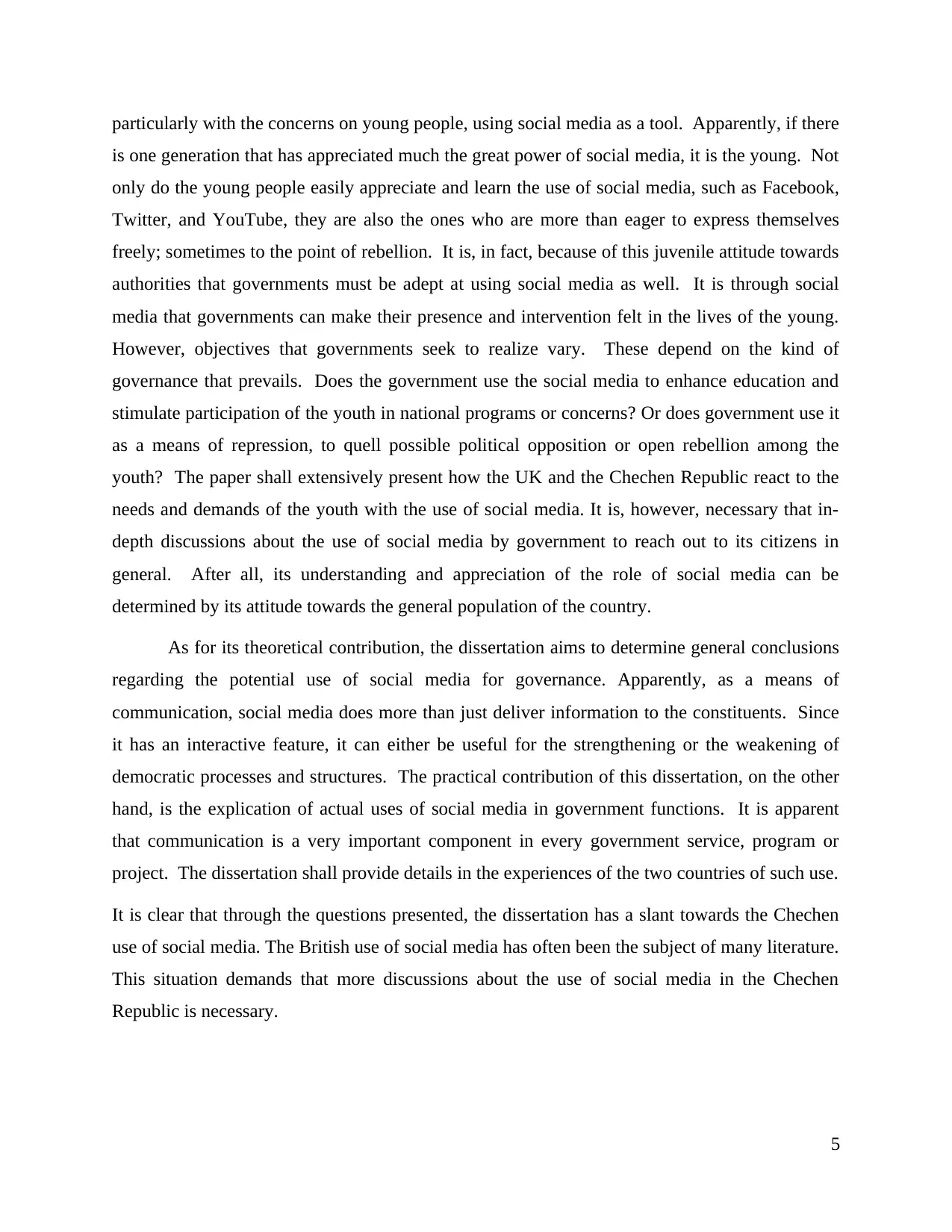
particularly with the concerns on young people, using social media as a tool. Apparently, if there
is one generation that has appreciated much the great power of social media, it is the young. Not
only do the young people easily appreciate and learn the use of social media, such as Facebook,
Twitter, and YouTube, they are also the ones who are more than eager to express themselves
freely; sometimes to the point of rebellion. It is, in fact, because of this juvenile attitude towards
authorities that governments must be adept at using social media as well. It is through social
media that governments can make their presence and intervention felt in the lives of the young.
However, objectives that governments seek to realize vary. These depend on the kind of
governance that prevails. Does the government use the social media to enhance education and
stimulate participation of the youth in national programs or concerns? Or does government use it
as a means of repression, to quell possible political opposition or open rebellion among the
youth? The paper shall extensively present how the UK and the Chechen Republic react to the
needs and demands of the youth with the use of social media. It is, however, necessary that in-
depth discussions about the use of social media by government to reach out to its citizens in
general. After all, its understanding and appreciation of the role of social media can be
determined by its attitude towards the general population of the country.
As for its theoretical contribution, the dissertation aims to determine general conclusions
regarding the potential use of social media for governance. Apparently, as a means of
communication, social media does more than just deliver information to the constituents. Since
it has an interactive feature, it can either be useful for the strengthening or the weakening of
democratic processes and structures. The practical contribution of this dissertation, on the other
hand, is the explication of actual uses of social media in government functions. It is apparent
that communication is a very important component in every government service, program or
project. The dissertation shall provide details in the experiences of the two countries of such use.
It is clear that through the questions presented, the dissertation has a slant towards the Chechen
use of social media. The British use of social media has often been the subject of many literature.
This situation demands that more discussions about the use of social media in the Chechen
Republic is necessary.
5
is one generation that has appreciated much the great power of social media, it is the young. Not
only do the young people easily appreciate and learn the use of social media, such as Facebook,
Twitter, and YouTube, they are also the ones who are more than eager to express themselves
freely; sometimes to the point of rebellion. It is, in fact, because of this juvenile attitude towards
authorities that governments must be adept at using social media as well. It is through social
media that governments can make their presence and intervention felt in the lives of the young.
However, objectives that governments seek to realize vary. These depend on the kind of
governance that prevails. Does the government use the social media to enhance education and
stimulate participation of the youth in national programs or concerns? Or does government use it
as a means of repression, to quell possible political opposition or open rebellion among the
youth? The paper shall extensively present how the UK and the Chechen Republic react to the
needs and demands of the youth with the use of social media. It is, however, necessary that in-
depth discussions about the use of social media by government to reach out to its citizens in
general. After all, its understanding and appreciation of the role of social media can be
determined by its attitude towards the general population of the country.
As for its theoretical contribution, the dissertation aims to determine general conclusions
regarding the potential use of social media for governance. Apparently, as a means of
communication, social media does more than just deliver information to the constituents. Since
it has an interactive feature, it can either be useful for the strengthening or the weakening of
democratic processes and structures. The practical contribution of this dissertation, on the other
hand, is the explication of actual uses of social media in government functions. It is apparent
that communication is a very important component in every government service, program or
project. The dissertation shall provide details in the experiences of the two countries of such use.
It is clear that through the questions presented, the dissertation has a slant towards the Chechen
use of social media. The British use of social media has often been the subject of many literature.
This situation demands that more discussions about the use of social media in the Chechen
Republic is necessary.
5
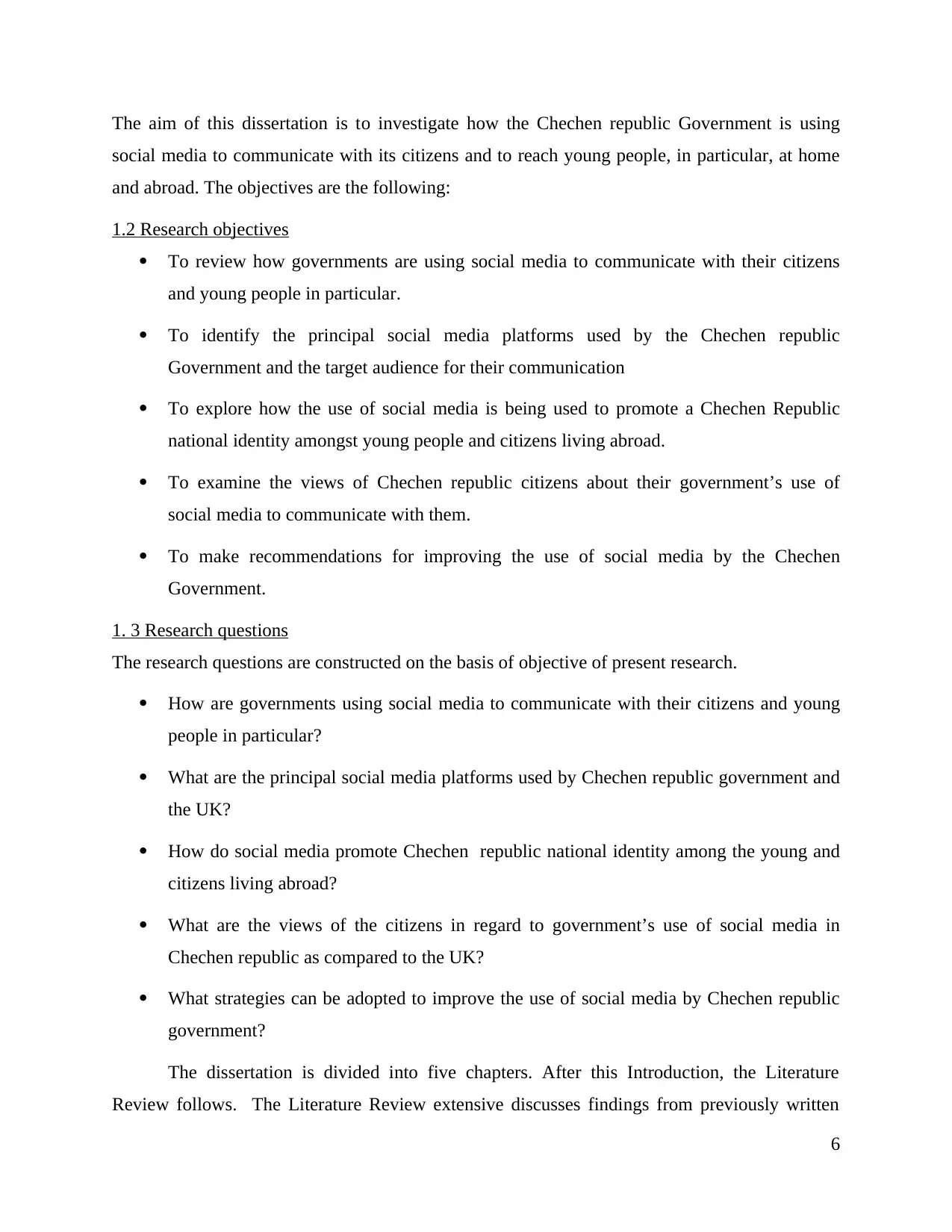
The aim of this dissertation is to investigate how the Chechen republic Government is using
social media to communicate with its citizens and to reach young people, in particular, at home
and abroad. The objectives are the following:
1.2 Research objectives
To review how governments are using social media to communicate with their citizens
and young people in particular.
To identify the principal social media platforms used by the Chechen republic
Government and the target audience for their communication
To explore how the use of social media is being used to promote a Chechen Republic
national identity amongst young people and citizens living abroad.
To examine the views of Chechen republic citizens about their government’s use of
social media to communicate with them.
To make recommendations for improving the use of social media by the Chechen
Government.
1. 3 Research questions
The research questions are constructed on the basis of objective of present research.
How are governments using social media to communicate with their citizens and young
people in particular?
What are the principal social media platforms used by Chechen republic government and
the UK?
How do social media promote Chechen republic national identity among the young and
citizens living abroad?
What are the views of the citizens in regard to government’s use of social media in
Chechen republic as compared to the UK?
What strategies can be adopted to improve the use of social media by Chechen republic
government?
The dissertation is divided into five chapters. After this Introduction, the Literature
Review follows. The Literature Review extensive discusses findings from previously written
6
social media to communicate with its citizens and to reach young people, in particular, at home
and abroad. The objectives are the following:
1.2 Research objectives
To review how governments are using social media to communicate with their citizens
and young people in particular.
To identify the principal social media platforms used by the Chechen republic
Government and the target audience for their communication
To explore how the use of social media is being used to promote a Chechen Republic
national identity amongst young people and citizens living abroad.
To examine the views of Chechen republic citizens about their government’s use of
social media to communicate with them.
To make recommendations for improving the use of social media by the Chechen
Government.
1. 3 Research questions
The research questions are constructed on the basis of objective of present research.
How are governments using social media to communicate with their citizens and young
people in particular?
What are the principal social media platforms used by Chechen republic government and
the UK?
How do social media promote Chechen republic national identity among the young and
citizens living abroad?
What are the views of the citizens in regard to government’s use of social media in
Chechen republic as compared to the UK?
What strategies can be adopted to improve the use of social media by Chechen republic
government?
The dissertation is divided into five chapters. After this Introduction, the Literature
Review follows. The Literature Review extensive discusses findings from previously written
6
Secure Best Marks with AI Grader
Need help grading? Try our AI Grader for instant feedback on your assignments.
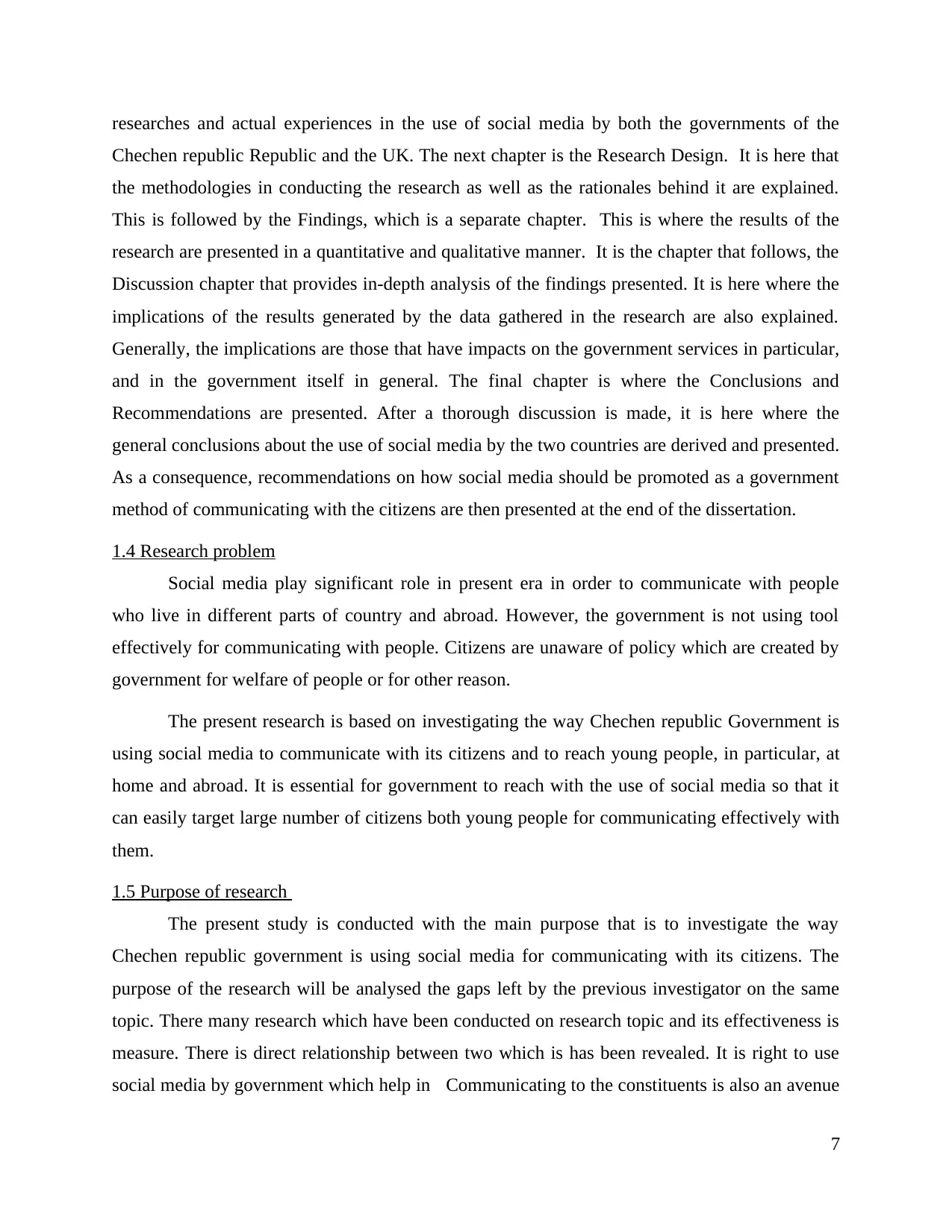
researches and actual experiences in the use of social media by both the governments of the
Chechen republic Republic and the UK. The next chapter is the Research Design. It is here that
the methodologies in conducting the research as well as the rationales behind it are explained.
This is followed by the Findings, which is a separate chapter. This is where the results of the
research are presented in a quantitative and qualitative manner. It is the chapter that follows, the
Discussion chapter that provides in-depth analysis of the findings presented. It is here where the
implications of the results generated by the data gathered in the research are also explained.
Generally, the implications are those that have impacts on the government services in particular,
and in the government itself in general. The final chapter is where the Conclusions and
Recommendations are presented. After a thorough discussion is made, it is here where the
general conclusions about the use of social media by the two countries are derived and presented.
As a consequence, recommendations on how social media should be promoted as a government
method of communicating with the citizens are then presented at the end of the dissertation.
1.4 Research problem
Social media play significant role in present era in order to communicate with people
who live in different parts of country and abroad. However, the government is not using tool
effectively for communicating with people. Citizens are unaware of policy which are created by
government for welfare of people or for other reason.
The present research is based on investigating the way Chechen republic Government is
using social media to communicate with its citizens and to reach young people, in particular, at
home and abroad. It is essential for government to reach with the use of social media so that it
can easily target large number of citizens both young people for communicating effectively with
them.
1.5 Purpose of research
The present study is conducted with the main purpose that is to investigate the way
Chechen republic government is using social media for communicating with its citizens. The
purpose of the research will be analysed the gaps left by the previous investigator on the same
topic. There many research which have been conducted on research topic and its effectiveness is
measure. There is direct relationship between two which is has been revealed. It is right to use
social media by government which help in Communicating to the constituents is also an avenue
7
Chechen republic Republic and the UK. The next chapter is the Research Design. It is here that
the methodologies in conducting the research as well as the rationales behind it are explained.
This is followed by the Findings, which is a separate chapter. This is where the results of the
research are presented in a quantitative and qualitative manner. It is the chapter that follows, the
Discussion chapter that provides in-depth analysis of the findings presented. It is here where the
implications of the results generated by the data gathered in the research are also explained.
Generally, the implications are those that have impacts on the government services in particular,
and in the government itself in general. The final chapter is where the Conclusions and
Recommendations are presented. After a thorough discussion is made, it is here where the
general conclusions about the use of social media by the two countries are derived and presented.
As a consequence, recommendations on how social media should be promoted as a government
method of communicating with the citizens are then presented at the end of the dissertation.
1.4 Research problem
Social media play significant role in present era in order to communicate with people
who live in different parts of country and abroad. However, the government is not using tool
effectively for communicating with people. Citizens are unaware of policy which are created by
government for welfare of people or for other reason.
The present research is based on investigating the way Chechen republic Government is
using social media to communicate with its citizens and to reach young people, in particular, at
home and abroad. It is essential for government to reach with the use of social media so that it
can easily target large number of citizens both young people for communicating effectively with
them.
1.5 Purpose of research
The present study is conducted with the main purpose that is to investigate the way
Chechen republic government is using social media for communicating with its citizens. The
purpose of the research will be analysed the gaps left by the previous investigator on the same
topic. There many research which have been conducted on research topic and its effectiveness is
measure. There is direct relationship between two which is has been revealed. It is right to use
social media by government which help in Communicating to the constituents is also an avenue
7
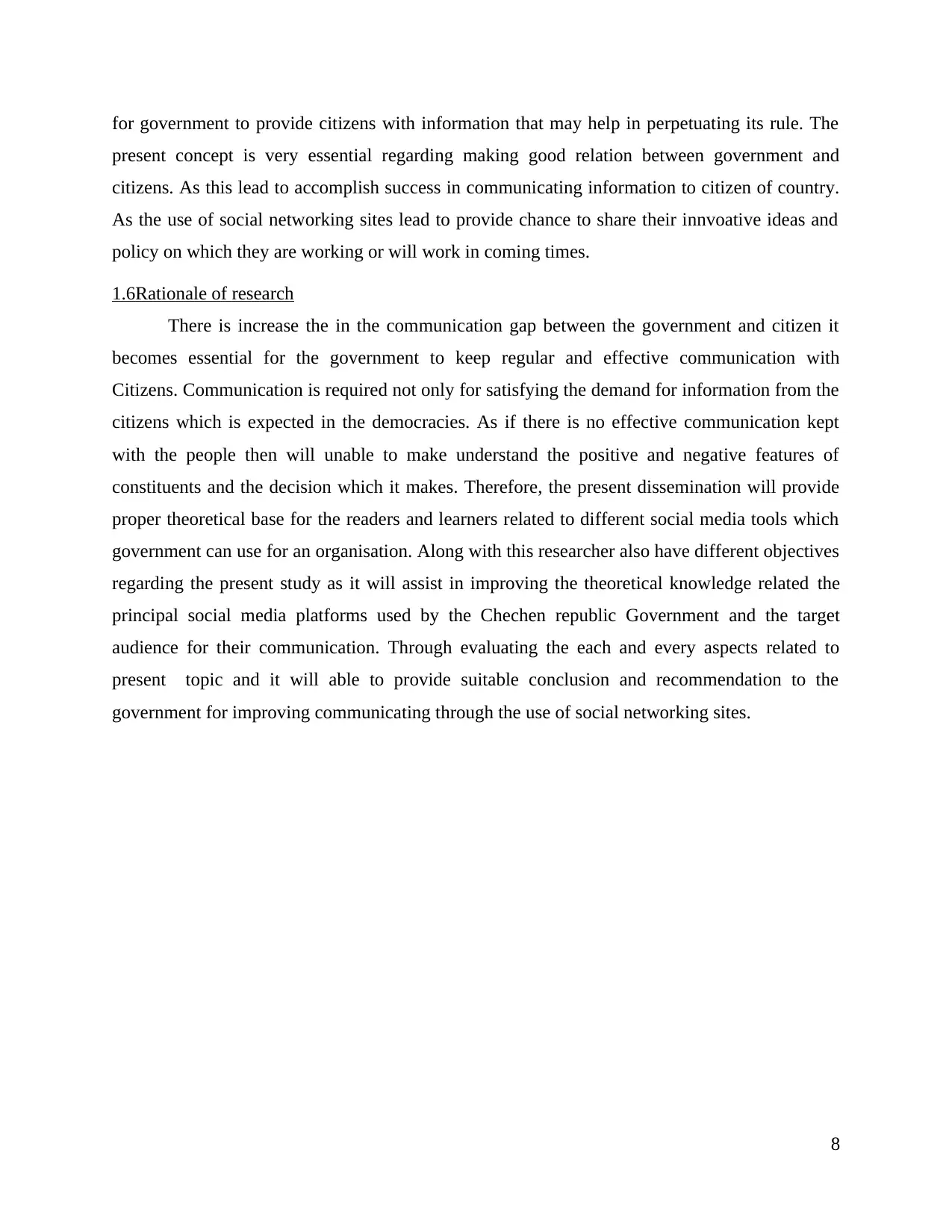
for government to provide citizens with information that may help in perpetuating its rule. The
present concept is very essential regarding making good relation between government and
citizens. As this lead to accomplish success in communicating information to citizen of country.
As the use of social networking sites lead to provide chance to share their innvoative ideas and
policy on which they are working or will work in coming times.
1.6Rationale of research
There is increase the in the communication gap between the government and citizen it
becomes essential for the government to keep regular and effective communication with
Citizens. Communication is required not only for satisfying the demand for information from the
citizens which is expected in the democracies. As if there is no effective communication kept
with the people then will unable to make understand the positive and negative features of
constituents and the decision which it makes. Therefore, the present dissemination will provide
proper theoretical base for the readers and learners related to different social media tools which
government can use for an organisation. Along with this researcher also have different objectives
regarding the present study as it will assist in improving the theoretical knowledge related the
principal social media platforms used by the Chechen republic Government and the target
audience for their communication. Through evaluating the each and every aspects related to
present topic and it will able to provide suitable conclusion and recommendation to the
government for improving communicating through the use of social networking sites.
8
present concept is very essential regarding making good relation between government and
citizens. As this lead to accomplish success in communicating information to citizen of country.
As the use of social networking sites lead to provide chance to share their innvoative ideas and
policy on which they are working or will work in coming times.
1.6Rationale of research
There is increase the in the communication gap between the government and citizen it
becomes essential for the government to keep regular and effective communication with
Citizens. Communication is required not only for satisfying the demand for information from the
citizens which is expected in the democracies. As if there is no effective communication kept
with the people then will unable to make understand the positive and negative features of
constituents and the decision which it makes. Therefore, the present dissemination will provide
proper theoretical base for the readers and learners related to different social media tools which
government can use for an organisation. Along with this researcher also have different objectives
regarding the present study as it will assist in improving the theoretical knowledge related the
principal social media platforms used by the Chechen republic Government and the target
audience for their communication. Through evaluating the each and every aspects related to
present topic and it will able to provide suitable conclusion and recommendation to the
government for improving communicating through the use of social networking sites.
8
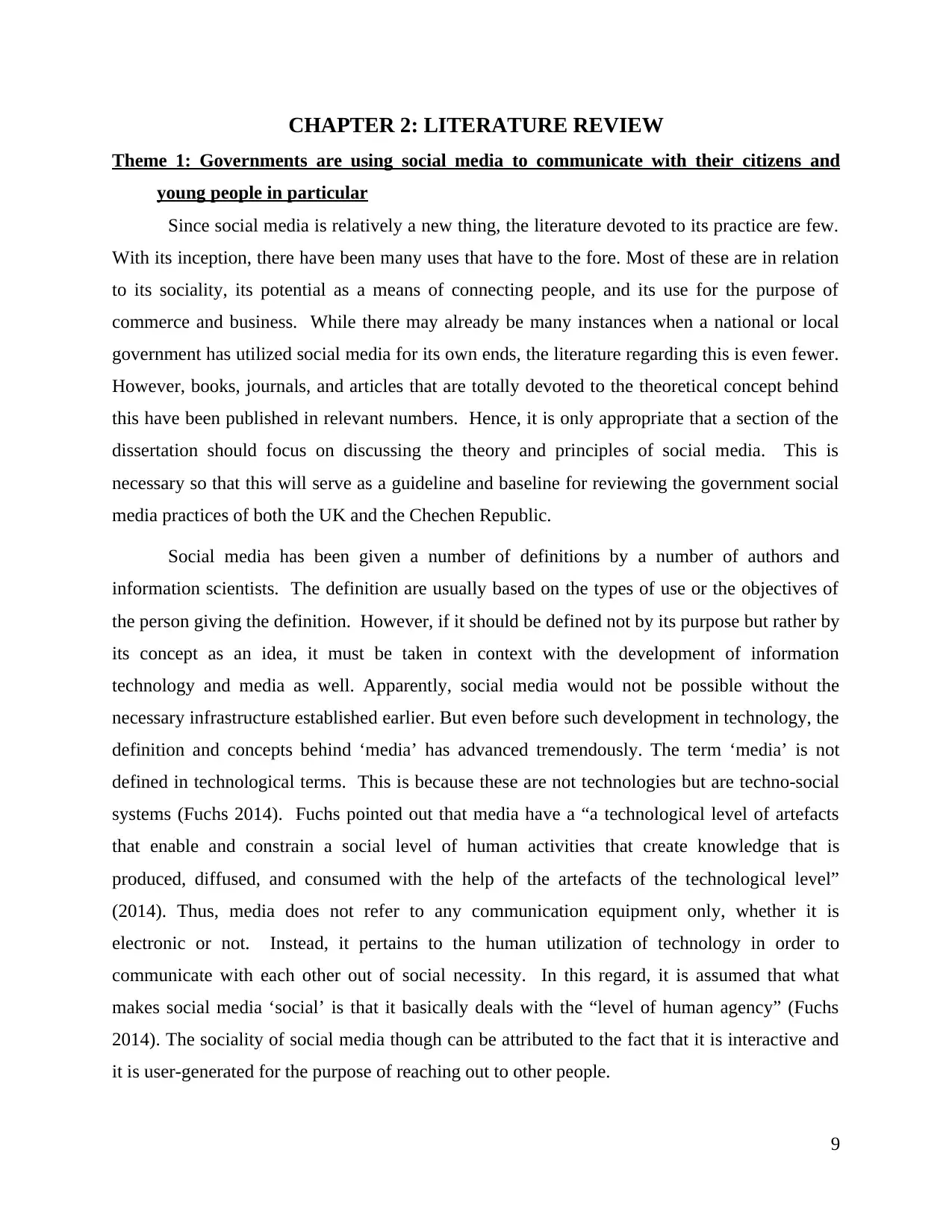
CHAPTER 2: LITERATURE REVIEW
Theme 1: Governments are using social media to communicate with their citizens and
young people in particular
Since social media is relatively a new thing, the literature devoted to its practice are few.
With its inception, there have been many uses that have to the fore. Most of these are in relation
to its sociality, its potential as a means of connecting people, and its use for the purpose of
commerce and business. While there may already be many instances when a national or local
government has utilized social media for its own ends, the literature regarding this is even fewer.
However, books, journals, and articles that are totally devoted to the theoretical concept behind
this have been published in relevant numbers. Hence, it is only appropriate that a section of the
dissertation should focus on discussing the theory and principles of social media. This is
necessary so that this will serve as a guideline and baseline for reviewing the government social
media practices of both the UK and the Chechen Republic.
Social media has been given a number of definitions by a number of authors and
information scientists. The definition are usually based on the types of use or the objectives of
the person giving the definition. However, if it should be defined not by its purpose but rather by
its concept as an idea, it must be taken in context with the development of information
technology and media as well. Apparently, social media would not be possible without the
necessary infrastructure established earlier. But even before such development in technology, the
definition and concepts behind ‘media’ has advanced tremendously. The term ‘media’ is not
defined in technological terms. This is because these are not technologies but are techno-social
systems (Fuchs 2014). Fuchs pointed out that media have a “a technological level of artefacts
that enable and constrain a social level of human activities that create knowledge that is
produced, diffused, and consumed with the help of the artefacts of the technological level”
(2014). Thus, media does not refer to any communication equipment only, whether it is
electronic or not. Instead, it pertains to the human utilization of technology in order to
communicate with each other out of social necessity. In this regard, it is assumed that what
makes social media ‘social’ is that it basically deals with the “level of human agency” (Fuchs
2014). The sociality of social media though can be attributed to the fact that it is interactive and
it is user-generated for the purpose of reaching out to other people.
9
Theme 1: Governments are using social media to communicate with their citizens and
young people in particular
Since social media is relatively a new thing, the literature devoted to its practice are few.
With its inception, there have been many uses that have to the fore. Most of these are in relation
to its sociality, its potential as a means of connecting people, and its use for the purpose of
commerce and business. While there may already be many instances when a national or local
government has utilized social media for its own ends, the literature regarding this is even fewer.
However, books, journals, and articles that are totally devoted to the theoretical concept behind
this have been published in relevant numbers. Hence, it is only appropriate that a section of the
dissertation should focus on discussing the theory and principles of social media. This is
necessary so that this will serve as a guideline and baseline for reviewing the government social
media practices of both the UK and the Chechen Republic.
Social media has been given a number of definitions by a number of authors and
information scientists. The definition are usually based on the types of use or the objectives of
the person giving the definition. However, if it should be defined not by its purpose but rather by
its concept as an idea, it must be taken in context with the development of information
technology and media as well. Apparently, social media would not be possible without the
necessary infrastructure established earlier. But even before such development in technology, the
definition and concepts behind ‘media’ has advanced tremendously. The term ‘media’ is not
defined in technological terms. This is because these are not technologies but are techno-social
systems (Fuchs 2014). Fuchs pointed out that media have a “a technological level of artefacts
that enable and constrain a social level of human activities that create knowledge that is
produced, diffused, and consumed with the help of the artefacts of the technological level”
(2014). Thus, media does not refer to any communication equipment only, whether it is
electronic or not. Instead, it pertains to the human utilization of technology in order to
communicate with each other out of social necessity. In this regard, it is assumed that what
makes social media ‘social’ is that it basically deals with the “level of human agency” (Fuchs
2014). The sociality of social media though can be attributed to the fact that it is interactive and
it is user-generated for the purpose of reaching out to other people.
9
Paraphrase This Document
Need a fresh take? Get an instant paraphrase of this document with our AI Paraphraser
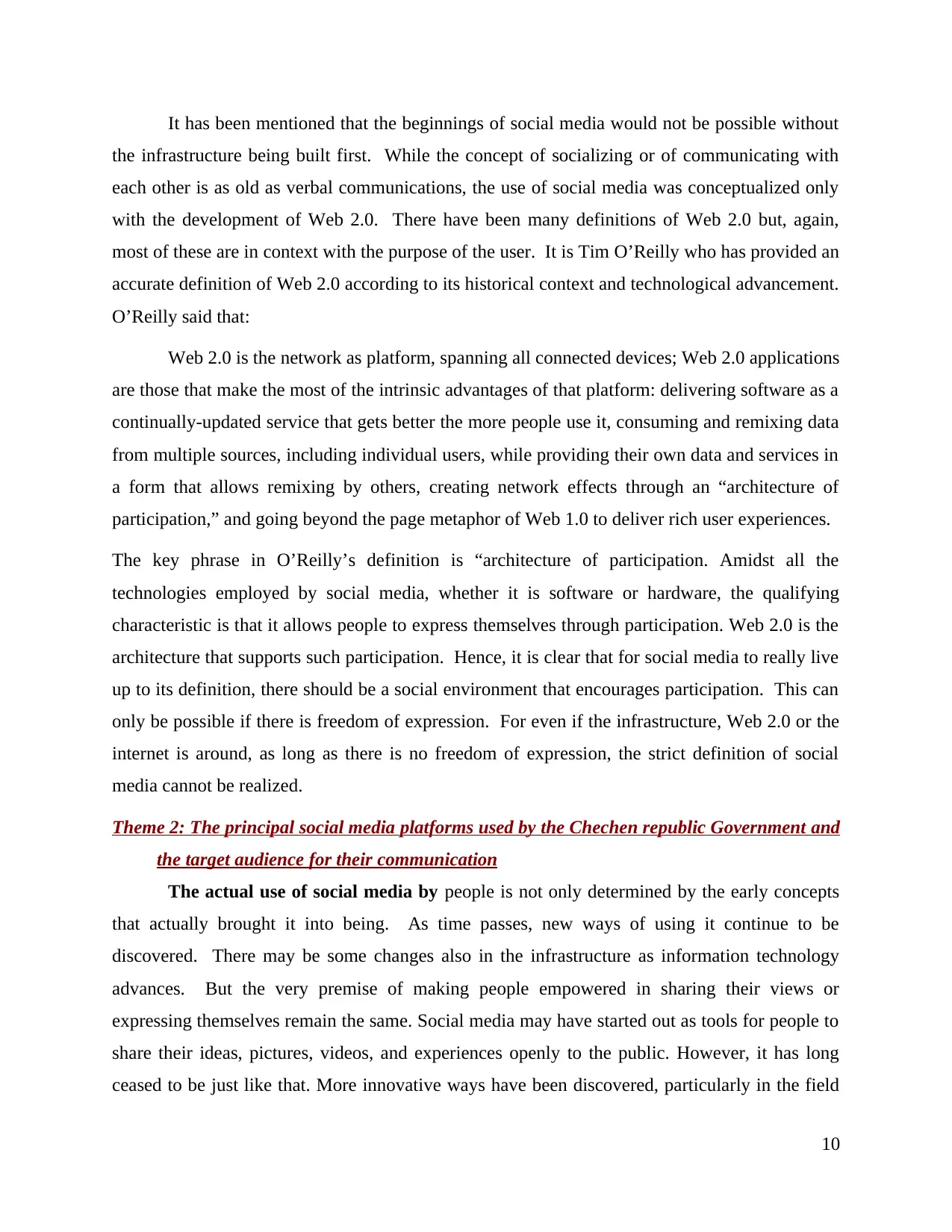
It has been mentioned that the beginnings of social media would not be possible without
the infrastructure being built first. While the concept of socializing or of communicating with
each other is as old as verbal communications, the use of social media was conceptualized only
with the development of Web 2.0. There have been many definitions of Web 2.0 but, again,
most of these are in context with the purpose of the user. It is Tim O’Reilly who has provided an
accurate definition of Web 2.0 according to its historical context and technological advancement.
O’Reilly said that:
Web 2.0 is the network as platform, spanning all connected devices; Web 2.0 applications
are those that make the most of the intrinsic advantages of that platform: delivering software as a
continually-updated service that gets better the more people use it, consuming and remixing data
from multiple sources, including individual users, while providing their own data and services in
a form that allows remixing by others, creating network effects through an “architecture of
participation,” and going beyond the page metaphor of Web 1.0 to deliver rich user experiences.
The key phrase in O’Reilly’s definition is “architecture of participation. Amidst all the
technologies employed by social media, whether it is software or hardware, the qualifying
characteristic is that it allows people to express themselves through participation. Web 2.0 is the
architecture that supports such participation. Hence, it is clear that for social media to really live
up to its definition, there should be a social environment that encourages participation. This can
only be possible if there is freedom of expression. For even if the infrastructure, Web 2.0 or the
internet is around, as long as there is no freedom of expression, the strict definition of social
media cannot be realized.
Theme 2: The principal social media platforms used by the Chechen republic Government and
the target audience for their communication
The actual use of social media by people is not only determined by the early concepts
that actually brought it into being. As time passes, new ways of using it continue to be
discovered. There may be some changes also in the infrastructure as information technology
advances. But the very premise of making people empowered in sharing their views or
expressing themselves remain the same. Social media may have started out as tools for people to
share their ideas, pictures, videos, and experiences openly to the public. However, it has long
ceased to be just like that. More innovative ways have been discovered, particularly in the field
10
the infrastructure being built first. While the concept of socializing or of communicating with
each other is as old as verbal communications, the use of social media was conceptualized only
with the development of Web 2.0. There have been many definitions of Web 2.0 but, again,
most of these are in context with the purpose of the user. It is Tim O’Reilly who has provided an
accurate definition of Web 2.0 according to its historical context and technological advancement.
O’Reilly said that:
Web 2.0 is the network as platform, spanning all connected devices; Web 2.0 applications
are those that make the most of the intrinsic advantages of that platform: delivering software as a
continually-updated service that gets better the more people use it, consuming and remixing data
from multiple sources, including individual users, while providing their own data and services in
a form that allows remixing by others, creating network effects through an “architecture of
participation,” and going beyond the page metaphor of Web 1.0 to deliver rich user experiences.
The key phrase in O’Reilly’s definition is “architecture of participation. Amidst all the
technologies employed by social media, whether it is software or hardware, the qualifying
characteristic is that it allows people to express themselves through participation. Web 2.0 is the
architecture that supports such participation. Hence, it is clear that for social media to really live
up to its definition, there should be a social environment that encourages participation. This can
only be possible if there is freedom of expression. For even if the infrastructure, Web 2.0 or the
internet is around, as long as there is no freedom of expression, the strict definition of social
media cannot be realized.
Theme 2: The principal social media platforms used by the Chechen republic Government and
the target audience for their communication
The actual use of social media by people is not only determined by the early concepts
that actually brought it into being. As time passes, new ways of using it continue to be
discovered. There may be some changes also in the infrastructure as information technology
advances. But the very premise of making people empowered in sharing their views or
expressing themselves remain the same. Social media may have started out as tools for people to
share their ideas, pictures, videos, and experiences openly to the public. However, it has long
ceased to be just like that. More innovative ways have been discovered, particularly in the field
10
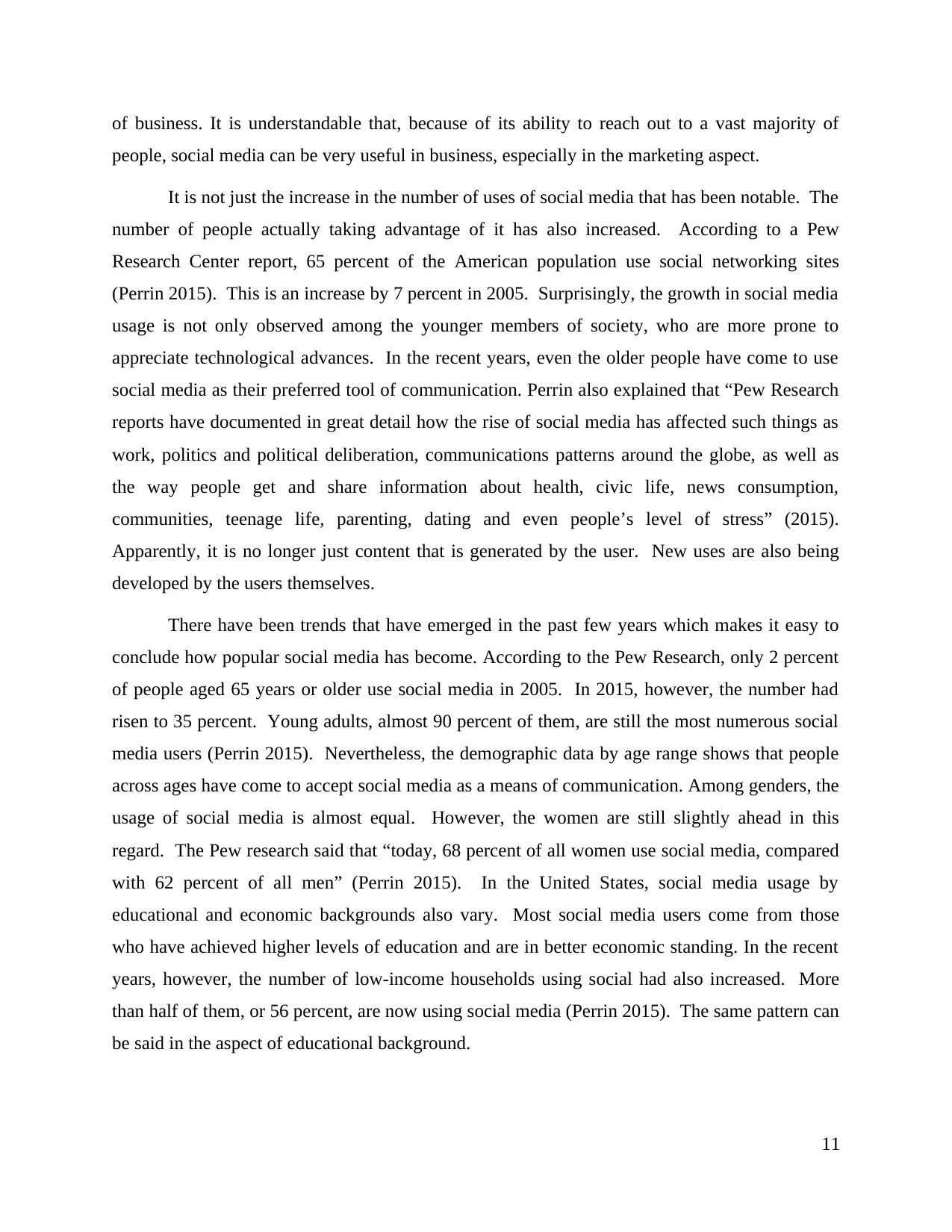
of business. It is understandable that, because of its ability to reach out to a vast majority of
people, social media can be very useful in business, especially in the marketing aspect.
It is not just the increase in the number of uses of social media that has been notable. The
number of people actually taking advantage of it has also increased. According to a Pew
Research Center report, 65 percent of the American population use social networking sites
(Perrin 2015). This is an increase by 7 percent in 2005. Surprisingly, the growth in social media
usage is not only observed among the younger members of society, who are more prone to
appreciate technological advances. In the recent years, even the older people have come to use
social media as their preferred tool of communication. Perrin also explained that “Pew Research
reports have documented in great detail how the rise of social media has affected such things as
work, politics and political deliberation, communications patterns around the globe, as well as
the way people get and share information about health, civic life, news consumption,
communities, teenage life, parenting, dating and even people’s level of stress” (2015).
Apparently, it is no longer just content that is generated by the user. New uses are also being
developed by the users themselves.
There have been trends that have emerged in the past few years which makes it easy to
conclude how popular social media has become. According to the Pew Research, only 2 percent
of people aged 65 years or older use social media in 2005. In 2015, however, the number had
risen to 35 percent. Young adults, almost 90 percent of them, are still the most numerous social
media users (Perrin 2015). Nevertheless, the demographic data by age range shows that people
across ages have come to accept social media as a means of communication. Among genders, the
usage of social media is almost equal. However, the women are still slightly ahead in this
regard. The Pew research said that “today, 68 percent of all women use social media, compared
with 62 percent of all men” (Perrin 2015). In the United States, social media usage by
educational and economic backgrounds also vary. Most social media users come from those
who have achieved higher levels of education and are in better economic standing. In the recent
years, however, the number of low-income households using social had also increased. More
than half of them, or 56 percent, are now using social media (Perrin 2015). The same pattern can
be said in the aspect of educational background.
11
people, social media can be very useful in business, especially in the marketing aspect.
It is not just the increase in the number of uses of social media that has been notable. The
number of people actually taking advantage of it has also increased. According to a Pew
Research Center report, 65 percent of the American population use social networking sites
(Perrin 2015). This is an increase by 7 percent in 2005. Surprisingly, the growth in social media
usage is not only observed among the younger members of society, who are more prone to
appreciate technological advances. In the recent years, even the older people have come to use
social media as their preferred tool of communication. Perrin also explained that “Pew Research
reports have documented in great detail how the rise of social media has affected such things as
work, politics and political deliberation, communications patterns around the globe, as well as
the way people get and share information about health, civic life, news consumption,
communities, teenage life, parenting, dating and even people’s level of stress” (2015).
Apparently, it is no longer just content that is generated by the user. New uses are also being
developed by the users themselves.
There have been trends that have emerged in the past few years which makes it easy to
conclude how popular social media has become. According to the Pew Research, only 2 percent
of people aged 65 years or older use social media in 2005. In 2015, however, the number had
risen to 35 percent. Young adults, almost 90 percent of them, are still the most numerous social
media users (Perrin 2015). Nevertheless, the demographic data by age range shows that people
across ages have come to accept social media as a means of communication. Among genders, the
usage of social media is almost equal. However, the women are still slightly ahead in this
regard. The Pew research said that “today, 68 percent of all women use social media, compared
with 62 percent of all men” (Perrin 2015). In the United States, social media usage by
educational and economic backgrounds also vary. Most social media users come from those
who have achieved higher levels of education and are in better economic standing. In the recent
years, however, the number of low-income households using social had also increased. More
than half of them, or 56 percent, are now using social media (Perrin 2015). The same pattern can
be said in the aspect of educational background.
11
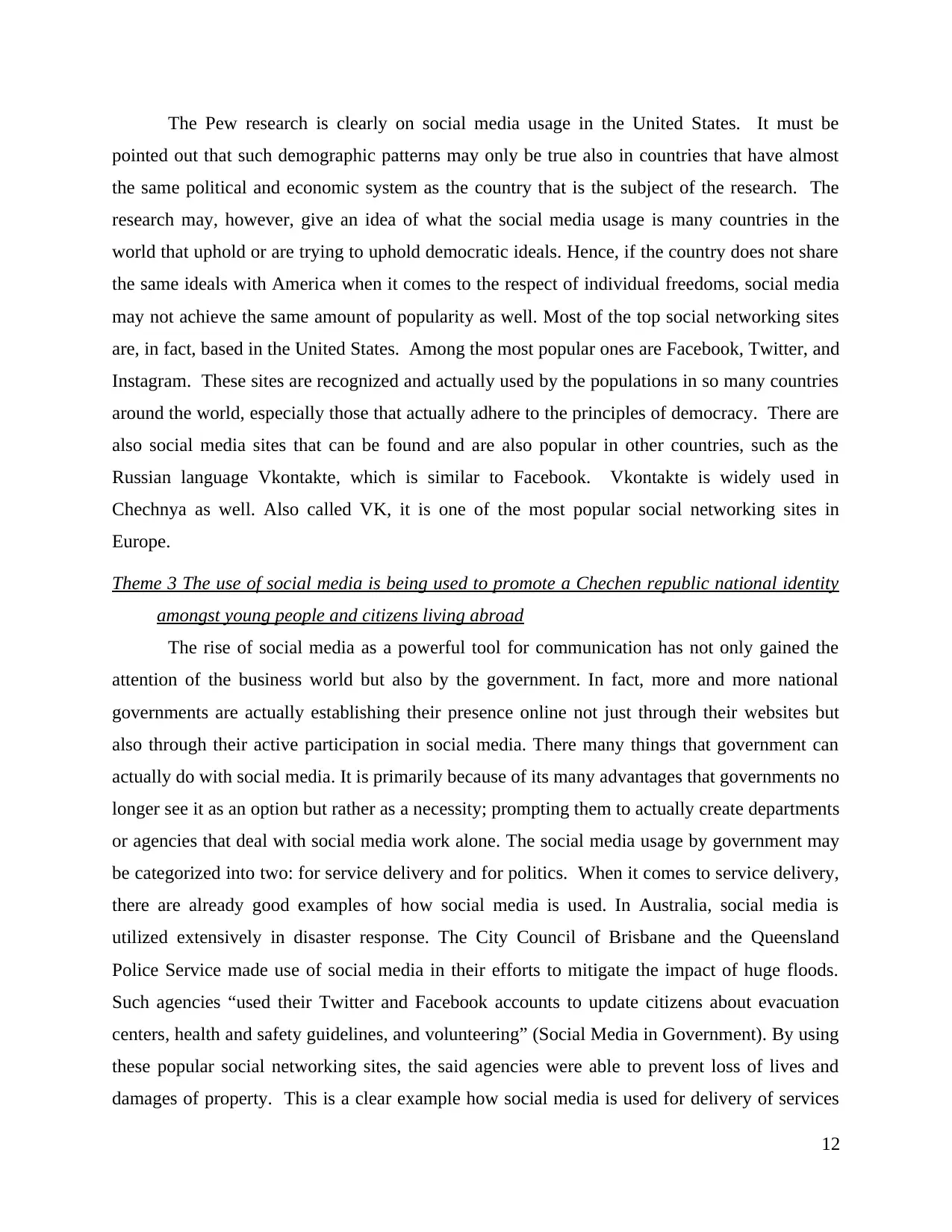
The Pew research is clearly on social media usage in the United States. It must be
pointed out that such demographic patterns may only be true also in countries that have almost
the same political and economic system as the country that is the subject of the research. The
research may, however, give an idea of what the social media usage is many countries in the
world that uphold or are trying to uphold democratic ideals. Hence, if the country does not share
the same ideals with America when it comes to the respect of individual freedoms, social media
may not achieve the same amount of popularity as well. Most of the top social networking sites
are, in fact, based in the United States. Among the most popular ones are Facebook, Twitter, and
Instagram. These sites are recognized and actually used by the populations in so many countries
around the world, especially those that actually adhere to the principles of democracy. There are
also social media sites that can be found and are also popular in other countries, such as the
Russian language Vkontakte, which is similar to Facebook. Vkontakte is widely used in
Chechnya as well. Also called VK, it is one of the most popular social networking sites in
Europe.
Theme 3 The use of social media is being used to promote a Chechen republic national identity
amongst young people and citizens living abroad
The rise of social media as a powerful tool for communication has not only gained the
attention of the business world but also by the government. In fact, more and more national
governments are actually establishing their presence online not just through their websites but
also through their active participation in social media. There many things that government can
actually do with social media. It is primarily because of its many advantages that governments no
longer see it as an option but rather as a necessity; prompting them to actually create departments
or agencies that deal with social media work alone. The social media usage by government may
be categorized into two: for service delivery and for politics. When it comes to service delivery,
there are already good examples of how social media is used. In Australia, social media is
utilized extensively in disaster response. The City Council of Brisbane and the Queensland
Police Service made use of social media in their efforts to mitigate the impact of huge floods.
Such agencies “used their Twitter and Facebook accounts to update citizens about evacuation
centers, health and safety guidelines, and volunteering” (Social Media in Government). By using
these popular social networking sites, the said agencies were able to prevent loss of lives and
damages of property. This is a clear example how social media is used for delivery of services
12
pointed out that such demographic patterns may only be true also in countries that have almost
the same political and economic system as the country that is the subject of the research. The
research may, however, give an idea of what the social media usage is many countries in the
world that uphold or are trying to uphold democratic ideals. Hence, if the country does not share
the same ideals with America when it comes to the respect of individual freedoms, social media
may not achieve the same amount of popularity as well. Most of the top social networking sites
are, in fact, based in the United States. Among the most popular ones are Facebook, Twitter, and
Instagram. These sites are recognized and actually used by the populations in so many countries
around the world, especially those that actually adhere to the principles of democracy. There are
also social media sites that can be found and are also popular in other countries, such as the
Russian language Vkontakte, which is similar to Facebook. Vkontakte is widely used in
Chechnya as well. Also called VK, it is one of the most popular social networking sites in
Europe.
Theme 3 The use of social media is being used to promote a Chechen republic national identity
amongst young people and citizens living abroad
The rise of social media as a powerful tool for communication has not only gained the
attention of the business world but also by the government. In fact, more and more national
governments are actually establishing their presence online not just through their websites but
also through their active participation in social media. There many things that government can
actually do with social media. It is primarily because of its many advantages that governments no
longer see it as an option but rather as a necessity; prompting them to actually create departments
or agencies that deal with social media work alone. The social media usage by government may
be categorized into two: for service delivery and for politics. When it comes to service delivery,
there are already good examples of how social media is used. In Australia, social media is
utilized extensively in disaster response. The City Council of Brisbane and the Queensland
Police Service made use of social media in their efforts to mitigate the impact of huge floods.
Such agencies “used their Twitter and Facebook accounts to update citizens about evacuation
centers, health and safety guidelines, and volunteering” (Social Media in Government). By using
these popular social networking sites, the said agencies were able to prevent loss of lives and
damages of property. This is a clear example how social media is used for delivery of services
12
Secure Best Marks with AI Grader
Need help grading? Try our AI Grader for instant feedback on your assignments.
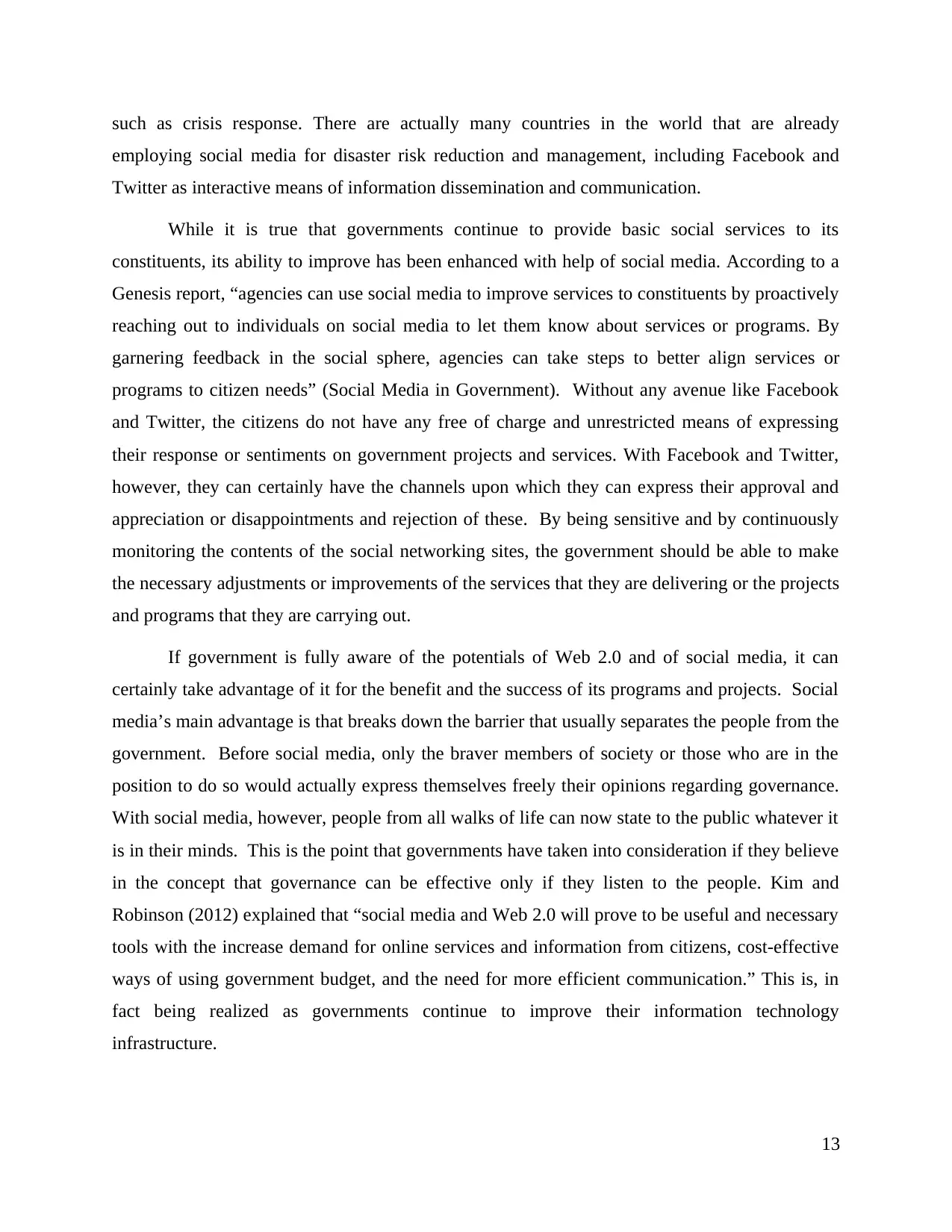
such as crisis response. There are actually many countries in the world that are already
employing social media for disaster risk reduction and management, including Facebook and
Twitter as interactive means of information dissemination and communication.
While it is true that governments continue to provide basic social services to its
constituents, its ability to improve has been enhanced with help of social media. According to a
Genesis report, “agencies can use social media to improve services to constituents by proactively
reaching out to individuals on social media to let them know about services or programs. By
garnering feedback in the social sphere, agencies can take steps to better align services or
programs to citizen needs” (Social Media in Government). Without any avenue like Facebook
and Twitter, the citizens do not have any free of charge and unrestricted means of expressing
their response or sentiments on government projects and services. With Facebook and Twitter,
however, they can certainly have the channels upon which they can express their approval and
appreciation or disappointments and rejection of these. By being sensitive and by continuously
monitoring the contents of the social networking sites, the government should be able to make
the necessary adjustments or improvements of the services that they are delivering or the projects
and programs that they are carrying out.
If government is fully aware of the potentials of Web 2.0 and of social media, it can
certainly take advantage of it for the benefit and the success of its programs and projects. Social
media’s main advantage is that breaks down the barrier that usually separates the people from the
government. Before social media, only the braver members of society or those who are in the
position to do so would actually express themselves freely their opinions regarding governance.
With social media, however, people from all walks of life can now state to the public whatever it
is in their minds. This is the point that governments have taken into consideration if they believe
in the concept that governance can be effective only if they listen to the people. Kim and
Robinson (2012) explained that “social media and Web 2.0 will prove to be useful and necessary
tools with the increase demand for online services and information from citizens, cost-effective
ways of using government budget, and the need for more efficient communication.” This is, in
fact being realized as governments continue to improve their information technology
infrastructure.
13
employing social media for disaster risk reduction and management, including Facebook and
Twitter as interactive means of information dissemination and communication.
While it is true that governments continue to provide basic social services to its
constituents, its ability to improve has been enhanced with help of social media. According to a
Genesis report, “agencies can use social media to improve services to constituents by proactively
reaching out to individuals on social media to let them know about services or programs. By
garnering feedback in the social sphere, agencies can take steps to better align services or
programs to citizen needs” (Social Media in Government). Without any avenue like Facebook
and Twitter, the citizens do not have any free of charge and unrestricted means of expressing
their response or sentiments on government projects and services. With Facebook and Twitter,
however, they can certainly have the channels upon which they can express their approval and
appreciation or disappointments and rejection of these. By being sensitive and by continuously
monitoring the contents of the social networking sites, the government should be able to make
the necessary adjustments or improvements of the services that they are delivering or the projects
and programs that they are carrying out.
If government is fully aware of the potentials of Web 2.0 and of social media, it can
certainly take advantage of it for the benefit and the success of its programs and projects. Social
media’s main advantage is that breaks down the barrier that usually separates the people from the
government. Before social media, only the braver members of society or those who are in the
position to do so would actually express themselves freely their opinions regarding governance.
With social media, however, people from all walks of life can now state to the public whatever it
is in their minds. This is the point that governments have taken into consideration if they believe
in the concept that governance can be effective only if they listen to the people. Kim and
Robinson (2012) explained that “social media and Web 2.0 will prove to be useful and necessary
tools with the increase demand for online services and information from citizens, cost-effective
ways of using government budget, and the need for more efficient communication.” This is, in
fact being realized as governments continue to improve their information technology
infrastructure.
13
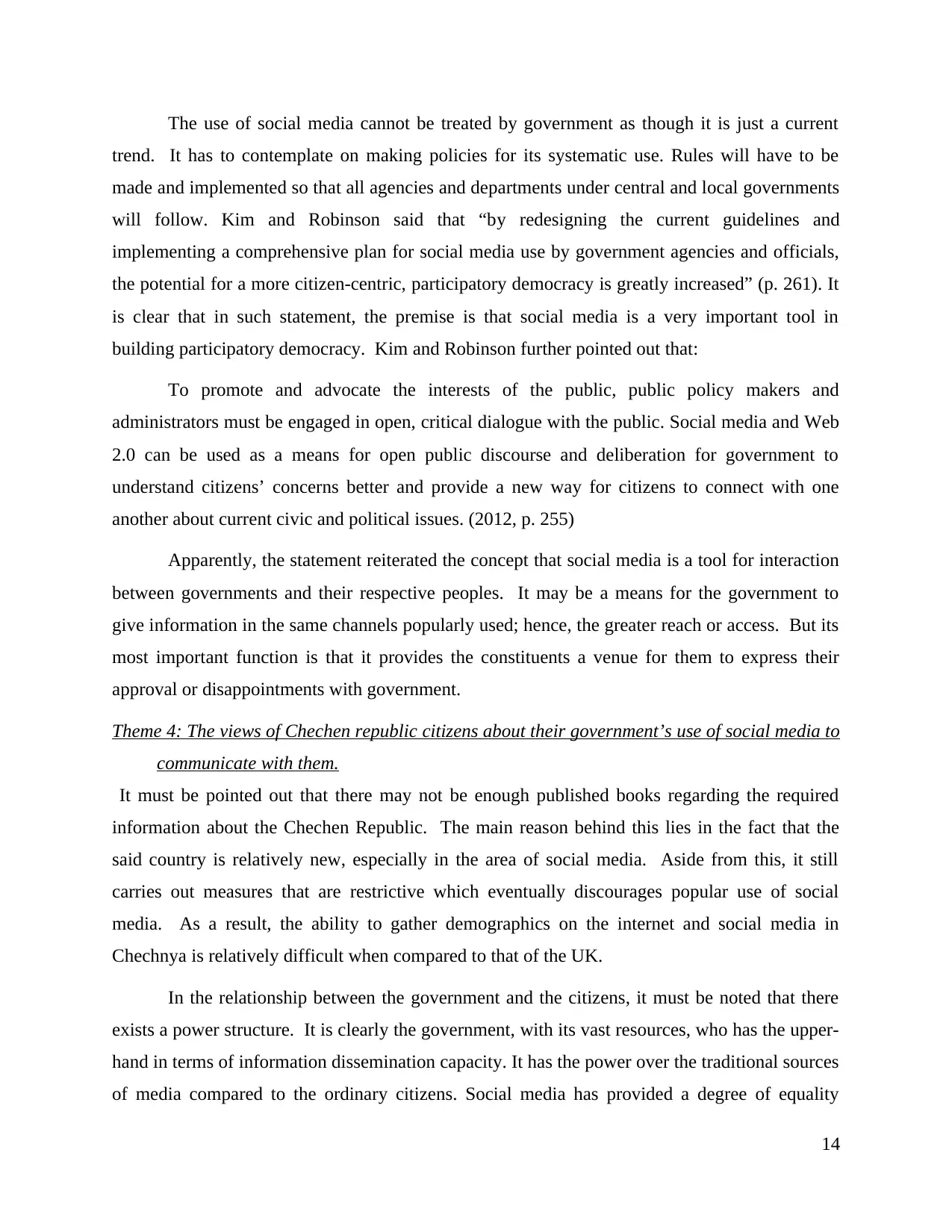
The use of social media cannot be treated by government as though it is just a current
trend. It has to contemplate on making policies for its systematic use. Rules will have to be
made and implemented so that all agencies and departments under central and local governments
will follow. Kim and Robinson said that “by redesigning the current guidelines and
implementing a comprehensive plan for social media use by government agencies and officials,
the potential for a more citizen-centric, participatory democracy is greatly increased” (p. 261). It
is clear that in such statement, the premise is that social media is a very important tool in
building participatory democracy. Kim and Robinson further pointed out that:
To promote and advocate the interests of the public, public policy makers and
administrators must be engaged in open, critical dialogue with the public. Social media and Web
2.0 can be used as a means for open public discourse and deliberation for government to
understand citizens’ concerns better and provide a new way for citizens to connect with one
another about current civic and political issues. (2012, p. 255)
Apparently, the statement reiterated the concept that social media is a tool for interaction
between governments and their respective peoples. It may be a means for the government to
give information in the same channels popularly used; hence, the greater reach or access. But its
most important function is that it provides the constituents a venue for them to express their
approval or disappointments with government.
Theme 4: The views of Chechen republic citizens about their government’s use of social media to
communicate with them.
It must be pointed out that there may not be enough published books regarding the required
information about the Chechen Republic. The main reason behind this lies in the fact that the
said country is relatively new, especially in the area of social media. Aside from this, it still
carries out measures that are restrictive which eventually discourages popular use of social
media. As a result, the ability to gather demographics on the internet and social media in
Chechnya is relatively difficult when compared to that of the UK.
In the relationship between the government and the citizens, it must be noted that there
exists a power structure. It is clearly the government, with its vast resources, who has the upper-
hand in terms of information dissemination capacity. It has the power over the traditional sources
of media compared to the ordinary citizens. Social media has provided a degree of equality
14
trend. It has to contemplate on making policies for its systematic use. Rules will have to be
made and implemented so that all agencies and departments under central and local governments
will follow. Kim and Robinson said that “by redesigning the current guidelines and
implementing a comprehensive plan for social media use by government agencies and officials,
the potential for a more citizen-centric, participatory democracy is greatly increased” (p. 261). It
is clear that in such statement, the premise is that social media is a very important tool in
building participatory democracy. Kim and Robinson further pointed out that:
To promote and advocate the interests of the public, public policy makers and
administrators must be engaged in open, critical dialogue with the public. Social media and Web
2.0 can be used as a means for open public discourse and deliberation for government to
understand citizens’ concerns better and provide a new way for citizens to connect with one
another about current civic and political issues. (2012, p. 255)
Apparently, the statement reiterated the concept that social media is a tool for interaction
between governments and their respective peoples. It may be a means for the government to
give information in the same channels popularly used; hence, the greater reach or access. But its
most important function is that it provides the constituents a venue for them to express their
approval or disappointments with government.
Theme 4: The views of Chechen republic citizens about their government’s use of social media to
communicate with them.
It must be pointed out that there may not be enough published books regarding the required
information about the Chechen Republic. The main reason behind this lies in the fact that the
said country is relatively new, especially in the area of social media. Aside from this, it still
carries out measures that are restrictive which eventually discourages popular use of social
media. As a result, the ability to gather demographics on the internet and social media in
Chechnya is relatively difficult when compared to that of the UK.
In the relationship between the government and the citizens, it must be noted that there
exists a power structure. It is clearly the government, with its vast resources, who has the upper-
hand in terms of information dissemination capacity. It has the power over the traditional sources
of media compared to the ordinary citizens. Social media has provided a degree of equality
14
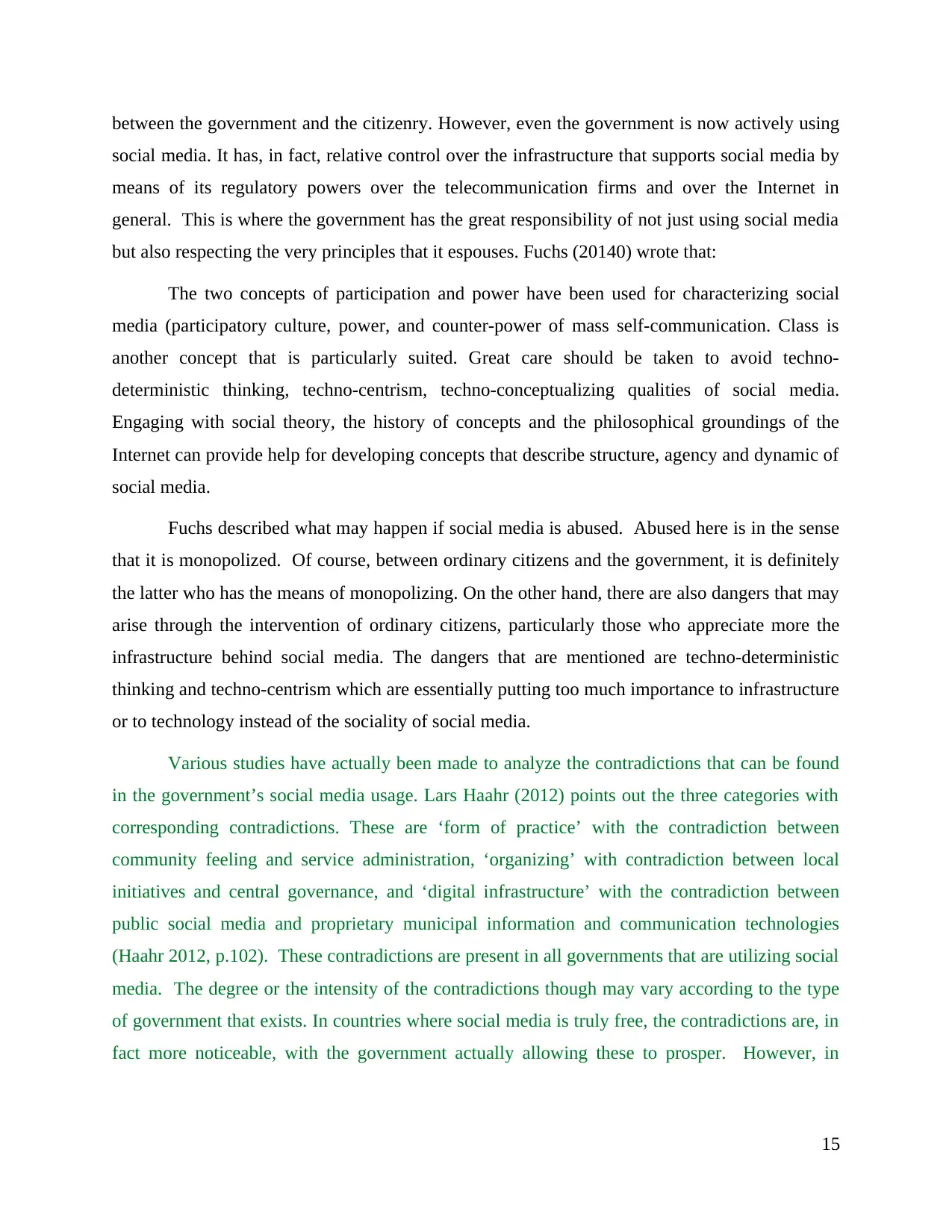
between the government and the citizenry. However, even the government is now actively using
social media. It has, in fact, relative control over the infrastructure that supports social media by
means of its regulatory powers over the telecommunication firms and over the Internet in
general. This is where the government has the great responsibility of not just using social media
but also respecting the very principles that it espouses. Fuchs (20140) wrote that:
The two concepts of participation and power have been used for characterizing social
media (participatory culture, power, and counter-power of mass self-communication. Class is
another concept that is particularly suited. Great care should be taken to avoid techno-
deterministic thinking, techno-centrism, techno-conceptualizing qualities of social media.
Engaging with social theory, the history of concepts and the philosophical groundings of the
Internet can provide help for developing concepts that describe structure, agency and dynamic of
social media.
Fuchs described what may happen if social media is abused. Abused here is in the sense
that it is monopolized. Of course, between ordinary citizens and the government, it is definitely
the latter who has the means of monopolizing. On the other hand, there are also dangers that may
arise through the intervention of ordinary citizens, particularly those who appreciate more the
infrastructure behind social media. The dangers that are mentioned are techno-deterministic
thinking and techno-centrism which are essentially putting too much importance to infrastructure
or to technology instead of the sociality of social media.
Various studies have actually been made to analyze the contradictions that can be found
in the government’s social media usage. Lars Haahr (2012) points out the three categories with
corresponding contradictions. These are ‘form of practice’ with the contradiction between
community feeling and service administration, ‘organizing’ with contradiction between local
initiatives and central governance, and ‘digital infrastructure’ with the contradiction between
public social media and proprietary municipal information and communication technologies
(Haahr 2012, p.102). These contradictions are present in all governments that are utilizing social
media. The degree or the intensity of the contradictions though may vary according to the type
of government that exists. In countries where social media is truly free, the contradictions are, in
fact more noticeable, with the government actually allowing these to prosper. However, in
15
social media. It has, in fact, relative control over the infrastructure that supports social media by
means of its regulatory powers over the telecommunication firms and over the Internet in
general. This is where the government has the great responsibility of not just using social media
but also respecting the very principles that it espouses. Fuchs (20140) wrote that:
The two concepts of participation and power have been used for characterizing social
media (participatory culture, power, and counter-power of mass self-communication. Class is
another concept that is particularly suited. Great care should be taken to avoid techno-
deterministic thinking, techno-centrism, techno-conceptualizing qualities of social media.
Engaging with social theory, the history of concepts and the philosophical groundings of the
Internet can provide help for developing concepts that describe structure, agency and dynamic of
social media.
Fuchs described what may happen if social media is abused. Abused here is in the sense
that it is monopolized. Of course, between ordinary citizens and the government, it is definitely
the latter who has the means of monopolizing. On the other hand, there are also dangers that may
arise through the intervention of ordinary citizens, particularly those who appreciate more the
infrastructure behind social media. The dangers that are mentioned are techno-deterministic
thinking and techno-centrism which are essentially putting too much importance to infrastructure
or to technology instead of the sociality of social media.
Various studies have actually been made to analyze the contradictions that can be found
in the government’s social media usage. Lars Haahr (2012) points out the three categories with
corresponding contradictions. These are ‘form of practice’ with the contradiction between
community feeling and service administration, ‘organizing’ with contradiction between local
initiatives and central governance, and ‘digital infrastructure’ with the contradiction between
public social media and proprietary municipal information and communication technologies
(Haahr 2012, p.102). These contradictions are present in all governments that are utilizing social
media. The degree or the intensity of the contradictions though may vary according to the type
of government that exists. In countries where social media is truly free, the contradictions are, in
fact more noticeable, with the government actually allowing these to prosper. However, in
15
Paraphrase This Document
Need a fresh take? Get an instant paraphrase of this document with our AI Paraphraser
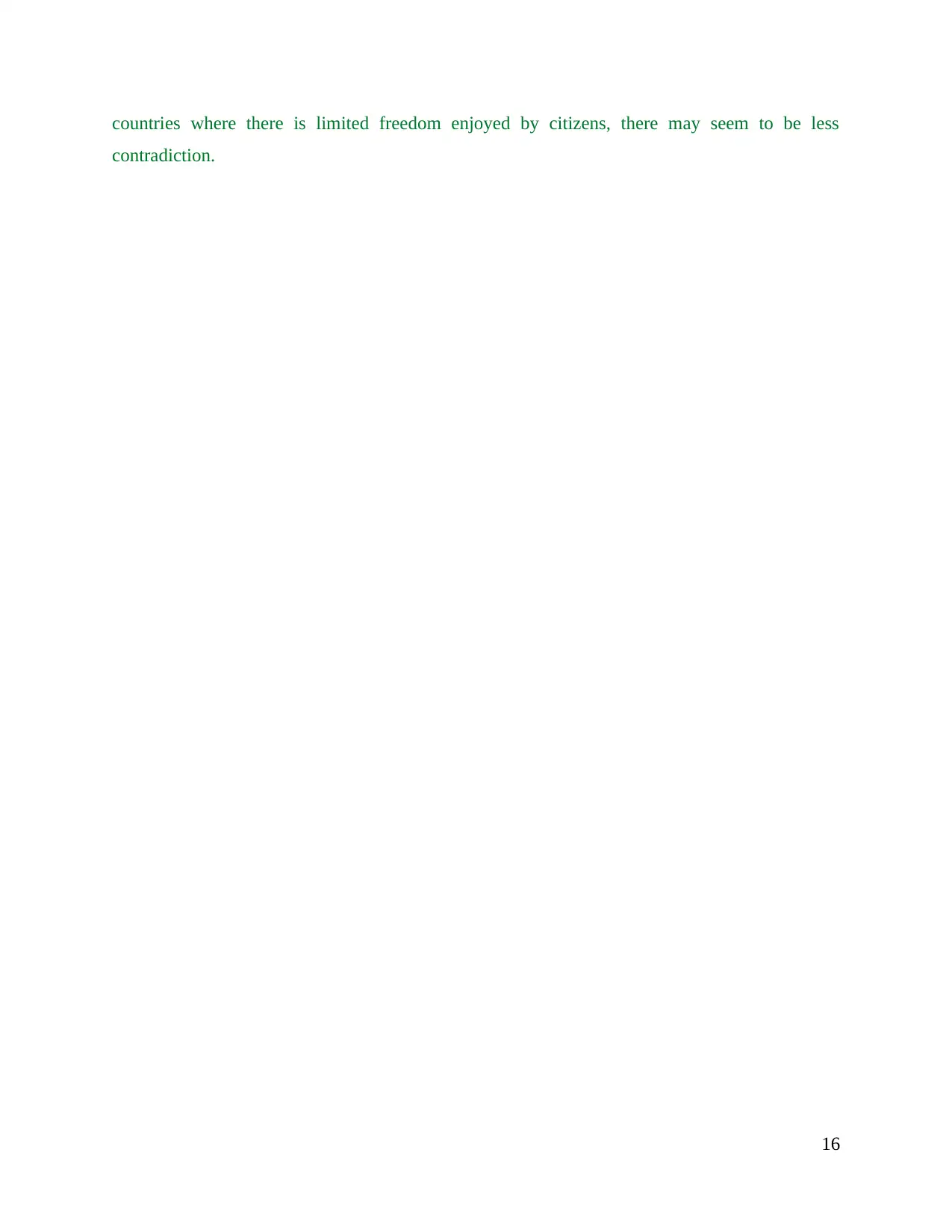
countries where there is limited freedom enjoyed by citizens, there may seem to be less
contradiction.
16
contradiction.
16
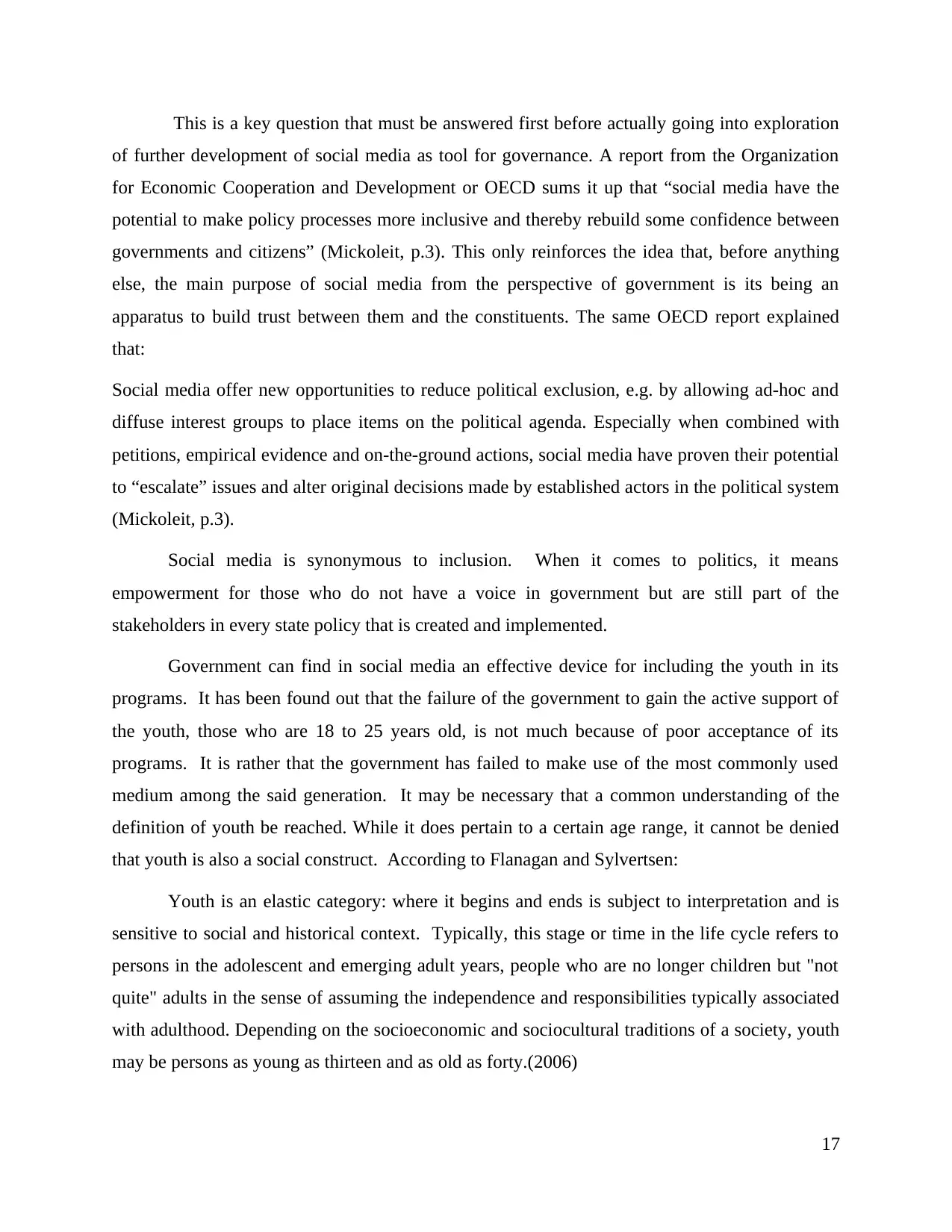
This is a key question that must be answered first before actually going into exploration
of further development of social media as tool for governance. A report from the Organization
for Economic Cooperation and Development or OECD sums it up that “social media have the
potential to make policy processes more inclusive and thereby rebuild some confidence between
governments and citizens” (Mickoleit, p.3). This only reinforces the idea that, before anything
else, the main purpose of social media from the perspective of government is its being an
apparatus to build trust between them and the constituents. The same OECD report explained
that:
Social media offer new opportunities to reduce political exclusion, e.g. by allowing ad-hoc and
diffuse interest groups to place items on the political agenda. Especially when combined with
petitions, empirical evidence and on-the-ground actions, social media have proven their potential
to “escalate” issues and alter original decisions made by established actors in the political system
(Mickoleit, p.3).
Social media is synonymous to inclusion. When it comes to politics, it means
empowerment for those who do not have a voice in government but are still part of the
stakeholders in every state policy that is created and implemented.
Government can find in social media an effective device for including the youth in its
programs. It has been found out that the failure of the government to gain the active support of
the youth, those who are 18 to 25 years old, is not much because of poor acceptance of its
programs. It is rather that the government has failed to make use of the most commonly used
medium among the said generation. It may be necessary that a common understanding of the
definition of youth be reached. While it does pertain to a certain age range, it cannot be denied
that youth is also a social construct. According to Flanagan and Sylvertsen:
Youth is an elastic category: where it begins and ends is subject to interpretation and is
sensitive to social and historical context. Typically, this stage or time in the life cycle refers to
persons in the adolescent and emerging adult years, people who are no longer children but "not
quite" adults in the sense of assuming the independence and responsibilities typically associated
with adulthood. Depending on the socioeconomic and sociocultural traditions of a society, youth
may be persons as young as thirteen and as old as forty.(2006)
17
of further development of social media as tool for governance. A report from the Organization
for Economic Cooperation and Development or OECD sums it up that “social media have the
potential to make policy processes more inclusive and thereby rebuild some confidence between
governments and citizens” (Mickoleit, p.3). This only reinforces the idea that, before anything
else, the main purpose of social media from the perspective of government is its being an
apparatus to build trust between them and the constituents. The same OECD report explained
that:
Social media offer new opportunities to reduce political exclusion, e.g. by allowing ad-hoc and
diffuse interest groups to place items on the political agenda. Especially when combined with
petitions, empirical evidence and on-the-ground actions, social media have proven their potential
to “escalate” issues and alter original decisions made by established actors in the political system
(Mickoleit, p.3).
Social media is synonymous to inclusion. When it comes to politics, it means
empowerment for those who do not have a voice in government but are still part of the
stakeholders in every state policy that is created and implemented.
Government can find in social media an effective device for including the youth in its
programs. It has been found out that the failure of the government to gain the active support of
the youth, those who are 18 to 25 years old, is not much because of poor acceptance of its
programs. It is rather that the government has failed to make use of the most commonly used
medium among the said generation. It may be necessary that a common understanding of the
definition of youth be reached. While it does pertain to a certain age range, it cannot be denied
that youth is also a social construct. According to Flanagan and Sylvertsen:
Youth is an elastic category: where it begins and ends is subject to interpretation and is
sensitive to social and historical context. Typically, this stage or time in the life cycle refers to
persons in the adolescent and emerging adult years, people who are no longer children but "not
quite" adults in the sense of assuming the independence and responsibilities typically associated
with adulthood. Depending on the socioeconomic and sociocultural traditions of a society, youth
may be persons as young as thirteen and as old as forty.(2006)
17
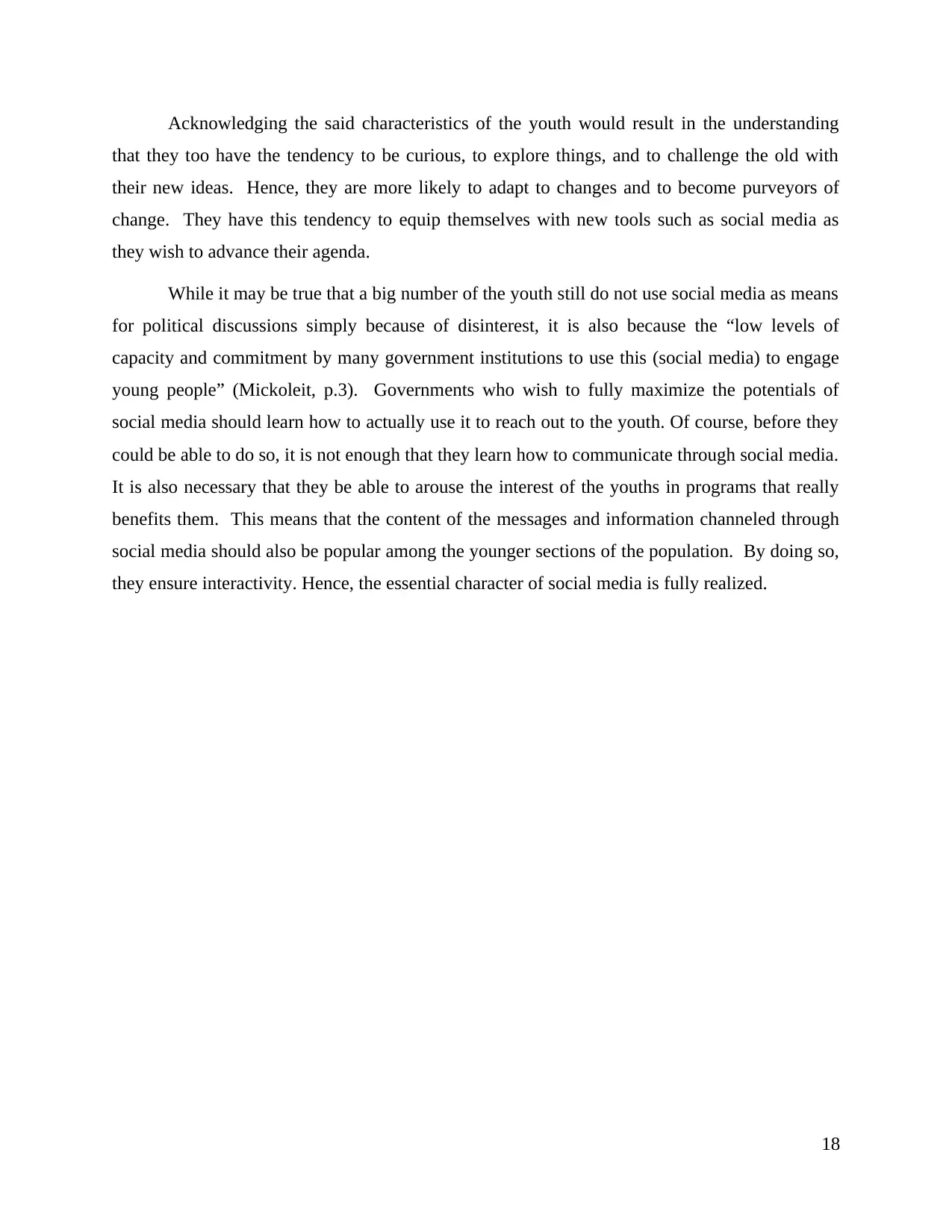
Acknowledging the said characteristics of the youth would result in the understanding
that they too have the tendency to be curious, to explore things, and to challenge the old with
their new ideas. Hence, they are more likely to adapt to changes and to become purveyors of
change. They have this tendency to equip themselves with new tools such as social media as
they wish to advance their agenda.
While it may be true that a big number of the youth still do not use social media as means
for political discussions simply because of disinterest, it is also because the “low levels of
capacity and commitment by many government institutions to use this (social media) to engage
young people” (Mickoleit, p.3). Governments who wish to fully maximize the potentials of
social media should learn how to actually use it to reach out to the youth. Of course, before they
could be able to do so, it is not enough that they learn how to communicate through social media.
It is also necessary that they be able to arouse the interest of the youths in programs that really
benefits them. This means that the content of the messages and information channeled through
social media should also be popular among the younger sections of the population. By doing so,
they ensure interactivity. Hence, the essential character of social media is fully realized.
18
that they too have the tendency to be curious, to explore things, and to challenge the old with
their new ideas. Hence, they are more likely to adapt to changes and to become purveyors of
change. They have this tendency to equip themselves with new tools such as social media as
they wish to advance their agenda.
While it may be true that a big number of the youth still do not use social media as means
for political discussions simply because of disinterest, it is also because the “low levels of
capacity and commitment by many government institutions to use this (social media) to engage
young people” (Mickoleit, p.3). Governments who wish to fully maximize the potentials of
social media should learn how to actually use it to reach out to the youth. Of course, before they
could be able to do so, it is not enough that they learn how to communicate through social media.
It is also necessary that they be able to arouse the interest of the youths in programs that really
benefits them. This means that the content of the messages and information channeled through
social media should also be popular among the younger sections of the population. By doing so,
they ensure interactivity. Hence, the essential character of social media is fully realized.
18
Secure Best Marks with AI Grader
Need help grading? Try our AI Grader for instant feedback on your assignments.
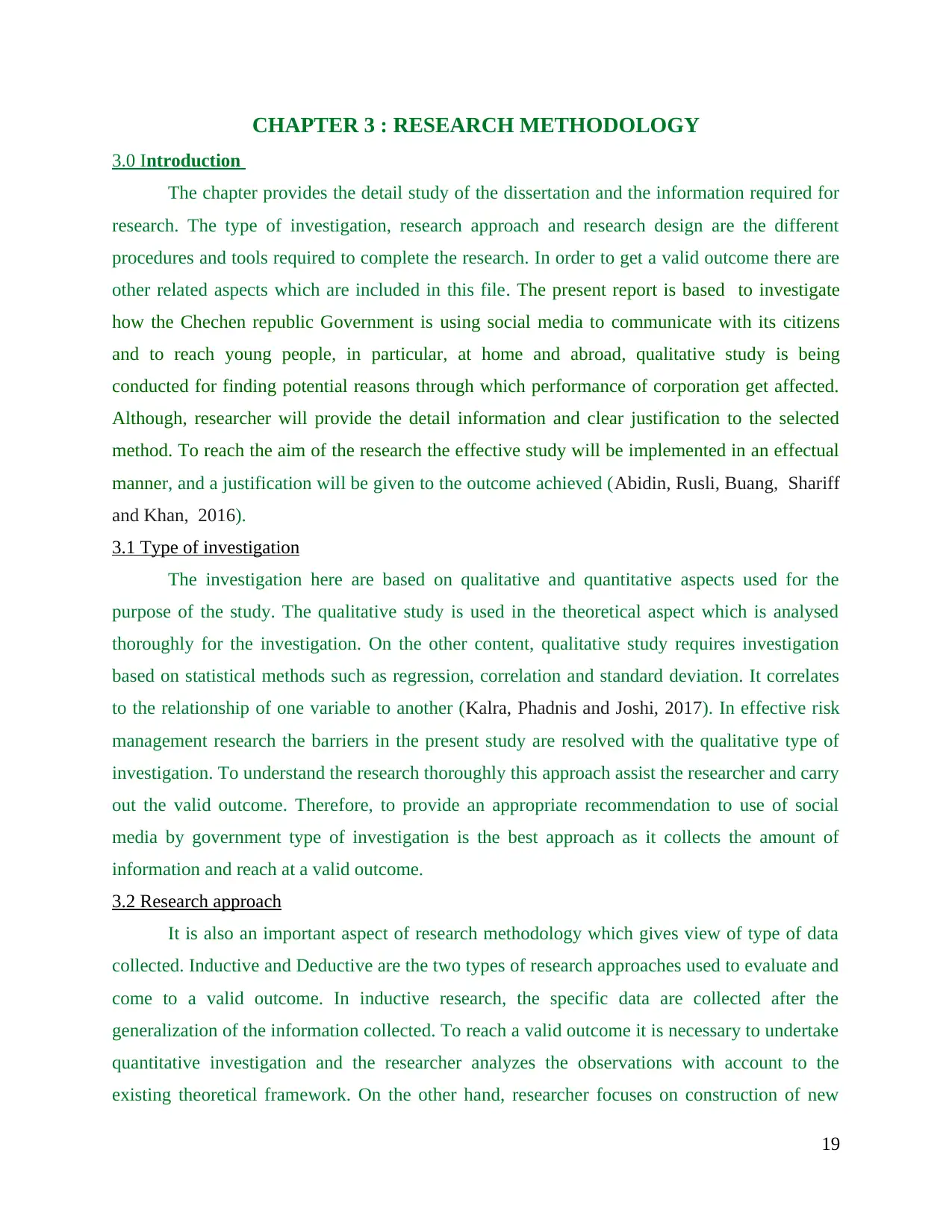
CHAPTER 3 : RESEARCH METHODOLOGY
3.0 Introduction
The chapter provides the detail study of the dissertation and the information required for
research. The type of investigation, research approach and research design are the different
procedures and tools required to complete the research. In order to get a valid outcome there are
other related aspects which are included in this file. The present report is based to investigate
how the Chechen republic Government is using social media to communicate with its citizens
and to reach young people, in particular, at home and abroad, qualitative study is being
conducted for finding potential reasons through which performance of corporation get affected.
Although, researcher will provide the detail information and clear justification to the selected
method. To reach the aim of the research the effective study will be implemented in an effectual
manner, and a justification will be given to the outcome achieved (Abidin, Rusli, Buang, Shariff
and Khan, 2016).
3.1 Type of investigation
The investigation here are based on qualitative and quantitative aspects used for the
purpose of the study. The qualitative study is used in the theoretical aspect which is analysed
thoroughly for the investigation. On the other content, qualitative study requires investigation
based on statistical methods such as regression, correlation and standard deviation. It correlates
to the relationship of one variable to another (Kalra, Phadnis and Joshi, 2017). In effective risk
management research the barriers in the present study are resolved with the qualitative type of
investigation. To understand the research thoroughly this approach assist the researcher and carry
out the valid outcome. Therefore, to provide an appropriate recommendation to use of social
media by government type of investigation is the best approach as it collects the amount of
information and reach at a valid outcome.
3.2 Research approach
It is also an important aspect of research methodology which gives view of type of data
collected. Inductive and Deductive are the two types of research approaches used to evaluate and
come to a valid outcome. In inductive research, the specific data are collected after the
generalization of the information collected. To reach a valid outcome it is necessary to undertake
quantitative investigation and the researcher analyzes the observations with account to the
existing theoretical framework. On the other hand, researcher focuses on construction of new
19
3.0 Introduction
The chapter provides the detail study of the dissertation and the information required for
research. The type of investigation, research approach and research design are the different
procedures and tools required to complete the research. In order to get a valid outcome there are
other related aspects which are included in this file. The present report is based to investigate
how the Chechen republic Government is using social media to communicate with its citizens
and to reach young people, in particular, at home and abroad, qualitative study is being
conducted for finding potential reasons through which performance of corporation get affected.
Although, researcher will provide the detail information and clear justification to the selected
method. To reach the aim of the research the effective study will be implemented in an effectual
manner, and a justification will be given to the outcome achieved (Abidin, Rusli, Buang, Shariff
and Khan, 2016).
3.1 Type of investigation
The investigation here are based on qualitative and quantitative aspects used for the
purpose of the study. The qualitative study is used in the theoretical aspect which is analysed
thoroughly for the investigation. On the other content, qualitative study requires investigation
based on statistical methods such as regression, correlation and standard deviation. It correlates
to the relationship of one variable to another (Kalra, Phadnis and Joshi, 2017). In effective risk
management research the barriers in the present study are resolved with the qualitative type of
investigation. To understand the research thoroughly this approach assist the researcher and carry
out the valid outcome. Therefore, to provide an appropriate recommendation to use of social
media by government type of investigation is the best approach as it collects the amount of
information and reach at a valid outcome.
3.2 Research approach
It is also an important aspect of research methodology which gives view of type of data
collected. Inductive and Deductive are the two types of research approaches used to evaluate and
come to a valid outcome. In inductive research, the specific data are collected after the
generalization of the information collected. To reach a valid outcome it is necessary to undertake
quantitative investigation and the researcher analyzes the observations with account to the
existing theoretical framework. On the other hand, researcher focuses on construction of new
19
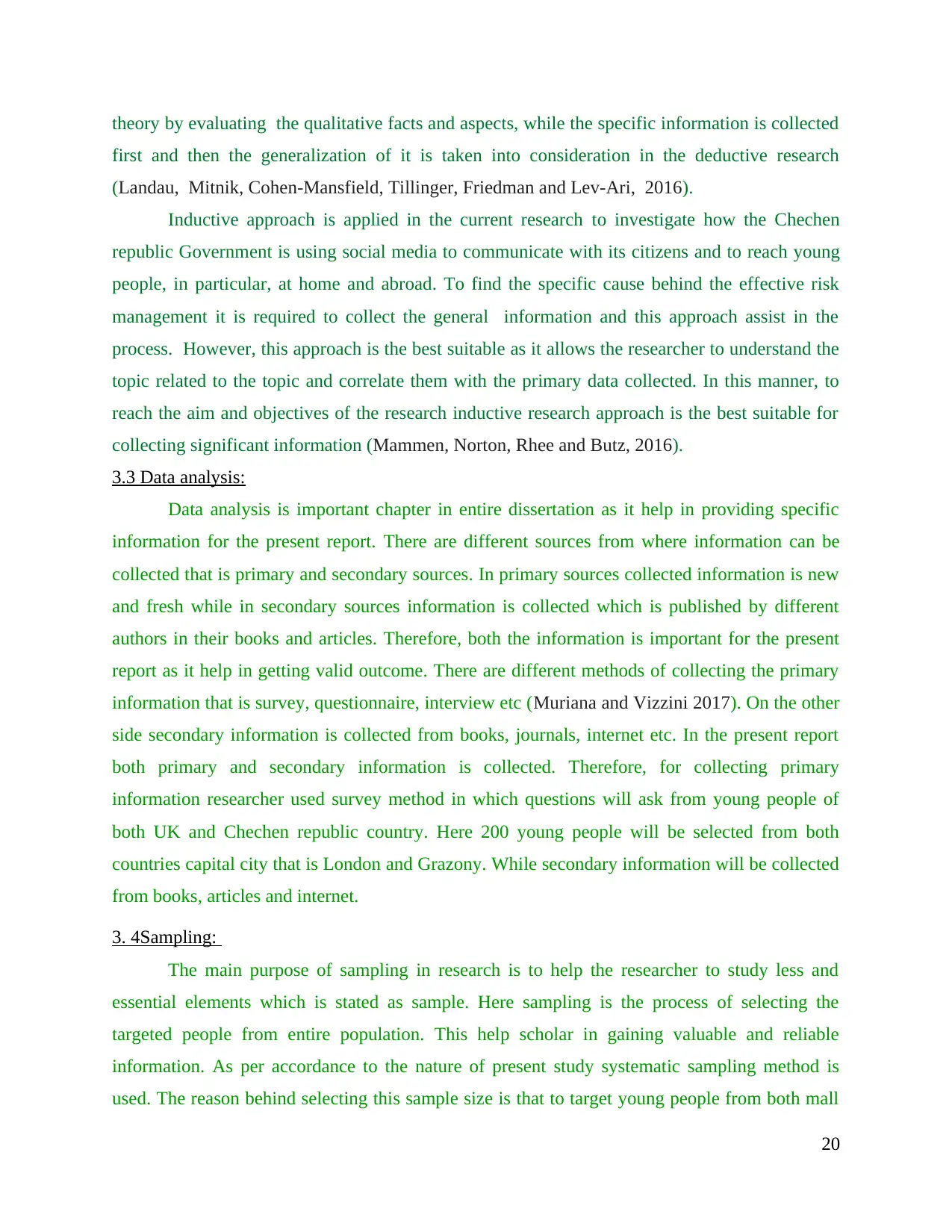
theory by evaluating the qualitative facts and aspects, while the specific information is collected
first and then the generalization of it is taken into consideration in the deductive research
(Landau, Mitnik, Cohen-Mansfield, Tillinger, Friedman and Lev-Ari, 2016).
Inductive approach is applied in the current research to investigate how the Chechen
republic Government is using social media to communicate with its citizens and to reach young
people, in particular, at home and abroad. To find the specific cause behind the effective risk
management it is required to collect the general information and this approach assist in the
process. However, this approach is the best suitable as it allows the researcher to understand the
topic related to the topic and correlate them with the primary data collected. In this manner, to
reach the aim and objectives of the research inductive research approach is the best suitable for
collecting significant information (Mammen, Norton, Rhee and Butz, 2016).
3.3 Data analysis:
Data analysis is important chapter in entire dissertation as it help in providing specific
information for the present report. There are different sources from where information can be
collected that is primary and secondary sources. In primary sources collected information is new
and fresh while in secondary sources information is collected which is published by different
authors in their books and articles. Therefore, both the information is important for the present
report as it help in getting valid outcome. There are different methods of collecting the primary
information that is survey, questionnaire, interview etc (Muriana and Vizzini 2017). On the other
side secondary information is collected from books, journals, internet etc. In the present report
both primary and secondary information is collected. Therefore, for collecting primary
information researcher used survey method in which questions will ask from young people of
both UK and Chechen republic country. Here 200 young people will be selected from both
countries capital city that is London and Grazony. While secondary information will be collected
from books, articles and internet.
3. 4Sampling:
The main purpose of sampling in research is to help the researcher to study less and
essential elements which is stated as sample. Here sampling is the process of selecting the
targeted people from entire population. This help scholar in gaining valuable and reliable
information. As per accordance to the nature of present study systematic sampling method is
used. The reason behind selecting this sample size is that to target young people from both mall
20
first and then the generalization of it is taken into consideration in the deductive research
(Landau, Mitnik, Cohen-Mansfield, Tillinger, Friedman and Lev-Ari, 2016).
Inductive approach is applied in the current research to investigate how the Chechen
republic Government is using social media to communicate with its citizens and to reach young
people, in particular, at home and abroad. To find the specific cause behind the effective risk
management it is required to collect the general information and this approach assist in the
process. However, this approach is the best suitable as it allows the researcher to understand the
topic related to the topic and correlate them with the primary data collected. In this manner, to
reach the aim and objectives of the research inductive research approach is the best suitable for
collecting significant information (Mammen, Norton, Rhee and Butz, 2016).
3.3 Data analysis:
Data analysis is important chapter in entire dissertation as it help in providing specific
information for the present report. There are different sources from where information can be
collected that is primary and secondary sources. In primary sources collected information is new
and fresh while in secondary sources information is collected which is published by different
authors in their books and articles. Therefore, both the information is important for the present
report as it help in getting valid outcome. There are different methods of collecting the primary
information that is survey, questionnaire, interview etc (Muriana and Vizzini 2017). On the other
side secondary information is collected from books, journals, internet etc. In the present report
both primary and secondary information is collected. Therefore, for collecting primary
information researcher used survey method in which questions will ask from young people of
both UK and Chechen republic country. Here 200 young people will be selected from both
countries capital city that is London and Grazony. While secondary information will be collected
from books, articles and internet.
3. 4Sampling:
The main purpose of sampling in research is to help the researcher to study less and
essential elements which is stated as sample. Here sampling is the process of selecting the
targeted people from entire population. This help scholar in gaining valuable and reliable
information. As per accordance to the nature of present study systematic sampling method is
used. The reason behind selecting this sample size is that to target young people from both mall
20
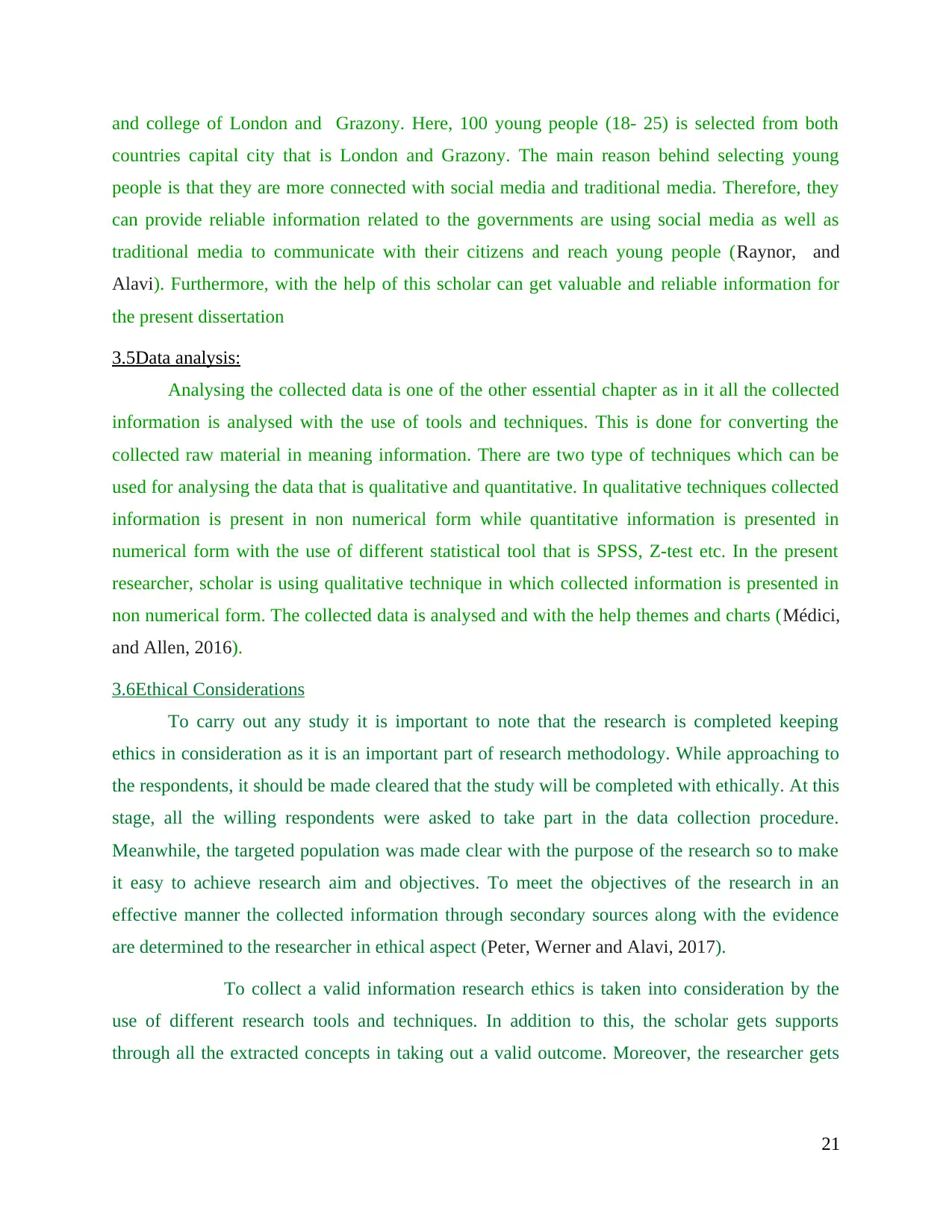
and college of London and Grazony. Here, 100 young people (18- 25) is selected from both
countries capital city that is London and Grazony. The main reason behind selecting young
people is that they are more connected with social media and traditional media. Therefore, they
can provide reliable information related to the governments are using social media as well as
traditional media to communicate with their citizens and reach young people (Raynor, and
Alavi). Furthermore, with the help of this scholar can get valuable and reliable information for
the present dissertation
3.5Data analysis:
Analysing the collected data is one of the other essential chapter as in it all the collected
information is analysed with the use of tools and techniques. This is done for converting the
collected raw material in meaning information. There are two type of techniques which can be
used for analysing the data that is qualitative and quantitative. In qualitative techniques collected
information is present in non numerical form while quantitative information is presented in
numerical form with the use of different statistical tool that is SPSS, Z-test etc. In the present
researcher, scholar is using qualitative technique in which collected information is presented in
non numerical form. The collected data is analysed and with the help themes and charts (Médici,
and Allen, 2016).
3.6Ethical Considerations
To carry out any study it is important to note that the research is completed keeping
ethics in consideration as it is an important part of research methodology. While approaching to
the respondents, it should be made cleared that the study will be completed with ethically. At this
stage, all the willing respondents were asked to take part in the data collection procedure.
Meanwhile, the targeted population was made clear with the purpose of the research so to make
it easy to achieve research aim and objectives. To meet the objectives of the research in an
effective manner the collected information through secondary sources along with the evidence
are determined to the researcher in ethical aspect (Peter, Werner and Alavi, 2017).
To collect a valid information research ethics is taken into consideration by the
use of different research tools and techniques. In addition to this, the scholar gets supports
through all the extracted concepts in taking out a valid outcome. Moreover, the researcher gets
21
countries capital city that is London and Grazony. The main reason behind selecting young
people is that they are more connected with social media and traditional media. Therefore, they
can provide reliable information related to the governments are using social media as well as
traditional media to communicate with their citizens and reach young people (Raynor, and
Alavi). Furthermore, with the help of this scholar can get valuable and reliable information for
the present dissertation
3.5Data analysis:
Analysing the collected data is one of the other essential chapter as in it all the collected
information is analysed with the use of tools and techniques. This is done for converting the
collected raw material in meaning information. There are two type of techniques which can be
used for analysing the data that is qualitative and quantitative. In qualitative techniques collected
information is present in non numerical form while quantitative information is presented in
numerical form with the use of different statistical tool that is SPSS, Z-test etc. In the present
researcher, scholar is using qualitative technique in which collected information is presented in
non numerical form. The collected data is analysed and with the help themes and charts (Médici,
and Allen, 2016).
3.6Ethical Considerations
To carry out any study it is important to note that the research is completed keeping
ethics in consideration as it is an important part of research methodology. While approaching to
the respondents, it should be made cleared that the study will be completed with ethically. At this
stage, all the willing respondents were asked to take part in the data collection procedure.
Meanwhile, the targeted population was made clear with the purpose of the research so to make
it easy to achieve research aim and objectives. To meet the objectives of the research in an
effective manner the collected information through secondary sources along with the evidence
are determined to the researcher in ethical aspect (Peter, Werner and Alavi, 2017).
To collect a valid information research ethics is taken into consideration by the
use of different research tools and techniques. In addition to this, the scholar gets supports
through all the extracted concepts in taking out a valid outcome. Moreover, the researcher gets
21
Paraphrase This Document
Need a fresh take? Get an instant paraphrase of this document with our AI Paraphraser
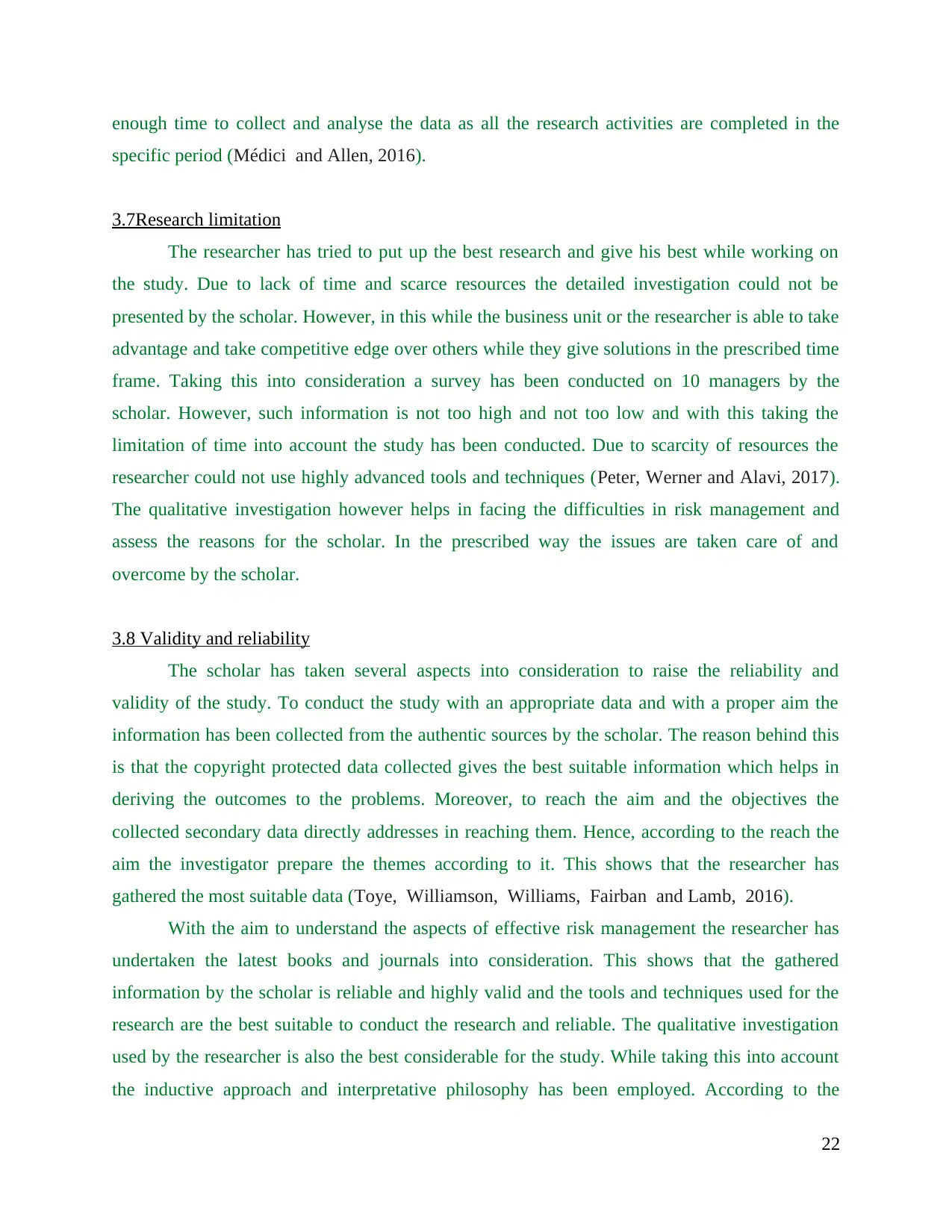
enough time to collect and analyse the data as all the research activities are completed in the
specific period (Médici and Allen, 2016).
3.7Research limitation
The researcher has tried to put up the best research and give his best while working on
the study. Due to lack of time and scarce resources the detailed investigation could not be
presented by the scholar. However, in this while the business unit or the researcher is able to take
advantage and take competitive edge over others while they give solutions in the prescribed time
frame. Taking this into consideration a survey has been conducted on 10 managers by the
scholar. However, such information is not too high and not too low and with this taking the
limitation of time into account the study has been conducted. Due to scarcity of resources the
researcher could not use highly advanced tools and techniques (Peter, Werner and Alavi, 2017).
The qualitative investigation however helps in facing the difficulties in risk management and
assess the reasons for the scholar. In the prescribed way the issues are taken care of and
overcome by the scholar.
3.8 Validity and reliability
The scholar has taken several aspects into consideration to raise the reliability and
validity of the study. To conduct the study with an appropriate data and with a proper aim the
information has been collected from the authentic sources by the scholar. The reason behind this
is that the copyright protected data collected gives the best suitable information which helps in
deriving the outcomes to the problems. Moreover, to reach the aim and the objectives the
collected secondary data directly addresses in reaching them. Hence, according to the reach the
aim the investigator prepare the themes according to it. This shows that the researcher has
gathered the most suitable data (Toye, Williamson, Williams, Fairban and Lamb, 2016).
With the aim to understand the aspects of effective risk management the researcher has
undertaken the latest books and journals into consideration. This shows that the gathered
information by the scholar is reliable and highly valid and the tools and techniques used for the
research are the best suitable to conduct the research and reliable. The qualitative investigation
used by the researcher is also the best considerable for the study. While taking this into account
the inductive approach and interpretative philosophy has been employed. According to the
22
specific period (Médici and Allen, 2016).
3.7Research limitation
The researcher has tried to put up the best research and give his best while working on
the study. Due to lack of time and scarce resources the detailed investigation could not be
presented by the scholar. However, in this while the business unit or the researcher is able to take
advantage and take competitive edge over others while they give solutions in the prescribed time
frame. Taking this into consideration a survey has been conducted on 10 managers by the
scholar. However, such information is not too high and not too low and with this taking the
limitation of time into account the study has been conducted. Due to scarcity of resources the
researcher could not use highly advanced tools and techniques (Peter, Werner and Alavi, 2017).
The qualitative investigation however helps in facing the difficulties in risk management and
assess the reasons for the scholar. In the prescribed way the issues are taken care of and
overcome by the scholar.
3.8 Validity and reliability
The scholar has taken several aspects into consideration to raise the reliability and
validity of the study. To conduct the study with an appropriate data and with a proper aim the
information has been collected from the authentic sources by the scholar. The reason behind this
is that the copyright protected data collected gives the best suitable information which helps in
deriving the outcomes to the problems. Moreover, to reach the aim and the objectives the
collected secondary data directly addresses in reaching them. Hence, according to the reach the
aim the investigator prepare the themes according to it. This shows that the researcher has
gathered the most suitable data (Toye, Williamson, Williams, Fairban and Lamb, 2016).
With the aim to understand the aspects of effective risk management the researcher has
undertaken the latest books and journals into consideration. This shows that the gathered
information by the scholar is reliable and highly valid and the tools and techniques used for the
research are the best suitable to conduct the research and reliable. The qualitative investigation
used by the researcher is also the best considerable for the study. While taking this into account
the inductive approach and interpretative philosophy has been employed. According to the
22
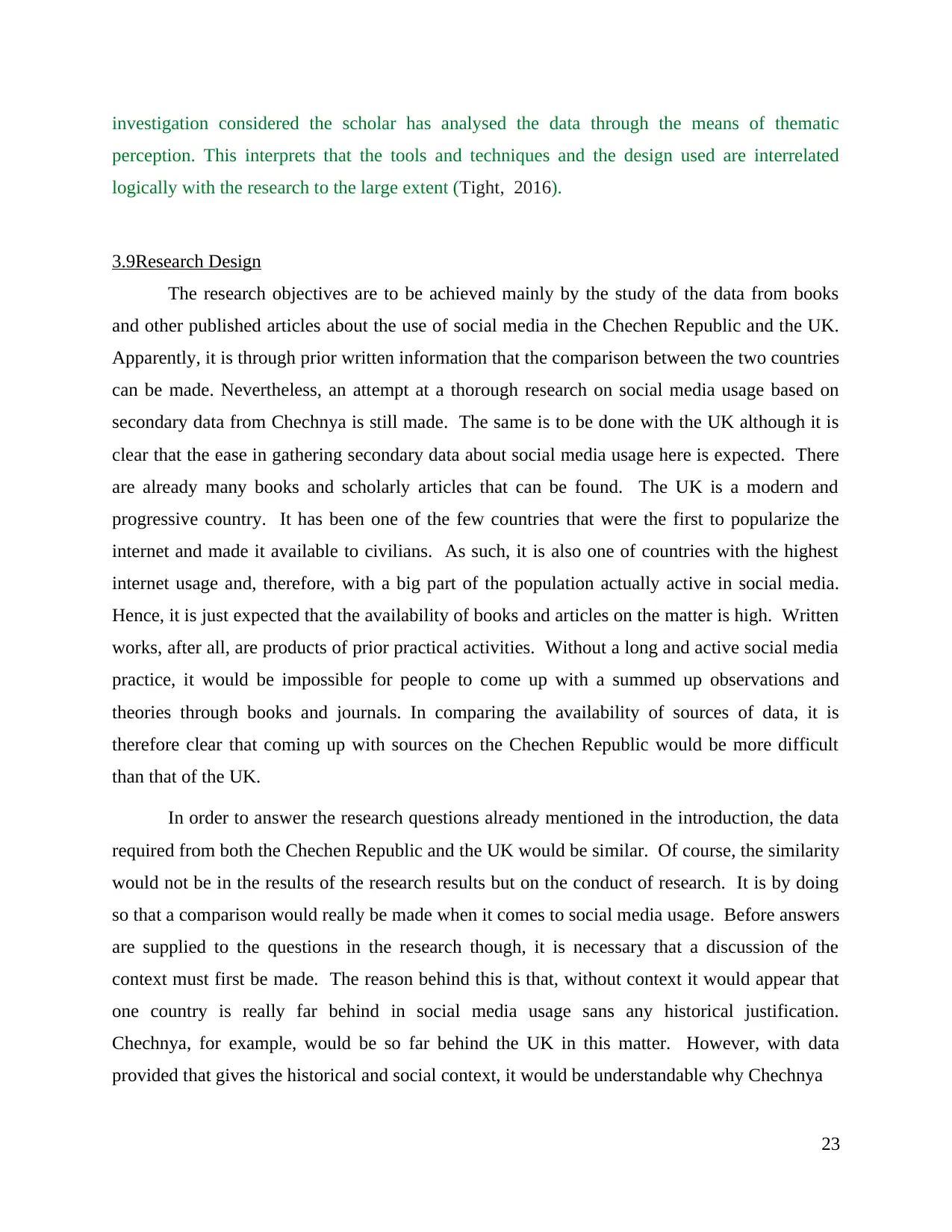
investigation considered the scholar has analysed the data through the means of thematic
perception. This interprets that the tools and techniques and the design used are interrelated
logically with the research to the large extent (Tight, 2016).
3.9Research Design
The research objectives are to be achieved mainly by the study of the data from books
and other published articles about the use of social media in the Chechen Republic and the UK.
Apparently, it is through prior written information that the comparison between the two countries
can be made. Nevertheless, an attempt at a thorough research on social media usage based on
secondary data from Chechnya is still made. The same is to be done with the UK although it is
clear that the ease in gathering secondary data about social media usage here is expected. There
are already many books and scholarly articles that can be found. The UK is a modern and
progressive country. It has been one of the few countries that were the first to popularize the
internet and made it available to civilians. As such, it is also one of countries with the highest
internet usage and, therefore, with a big part of the population actually active in social media.
Hence, it is just expected that the availability of books and articles on the matter is high. Written
works, after all, are products of prior practical activities. Without a long and active social media
practice, it would be impossible for people to come up with a summed up observations and
theories through books and journals. In comparing the availability of sources of data, it is
therefore clear that coming up with sources on the Chechen Republic would be more difficult
than that of the UK.
In order to answer the research questions already mentioned in the introduction, the data
required from both the Chechen Republic and the UK would be similar. Of course, the similarity
would not be in the results of the research results but on the conduct of research. It is by doing
so that a comparison would really be made when it comes to social media usage. Before answers
are supplied to the questions in the research though, it is necessary that a discussion of the
context must first be made. The reason behind this is that, without context it would appear that
one country is really far behind in social media usage sans any historical justification.
Chechnya, for example, would be so far behind the UK in this matter. However, with data
provided that gives the historical and social context, it would be understandable why Chechnya
23
perception. This interprets that the tools and techniques and the design used are interrelated
logically with the research to the large extent (Tight, 2016).
3.9Research Design
The research objectives are to be achieved mainly by the study of the data from books
and other published articles about the use of social media in the Chechen Republic and the UK.
Apparently, it is through prior written information that the comparison between the two countries
can be made. Nevertheless, an attempt at a thorough research on social media usage based on
secondary data from Chechnya is still made. The same is to be done with the UK although it is
clear that the ease in gathering secondary data about social media usage here is expected. There
are already many books and scholarly articles that can be found. The UK is a modern and
progressive country. It has been one of the few countries that were the first to popularize the
internet and made it available to civilians. As such, it is also one of countries with the highest
internet usage and, therefore, with a big part of the population actually active in social media.
Hence, it is just expected that the availability of books and articles on the matter is high. Written
works, after all, are products of prior practical activities. Without a long and active social media
practice, it would be impossible for people to come up with a summed up observations and
theories through books and journals. In comparing the availability of sources of data, it is
therefore clear that coming up with sources on the Chechen Republic would be more difficult
than that of the UK.
In order to answer the research questions already mentioned in the introduction, the data
required from both the Chechen Republic and the UK would be similar. Of course, the similarity
would not be in the results of the research results but on the conduct of research. It is by doing
so that a comparison would really be made when it comes to social media usage. Before answers
are supplied to the questions in the research though, it is necessary that a discussion of the
context must first be made. The reason behind this is that, without context it would appear that
one country is really far behind in social media usage sans any historical justification.
Chechnya, for example, would be so far behind the UK in this matter. However, with data
provided that gives the historical and social context, it would be understandable why Chechnya
23
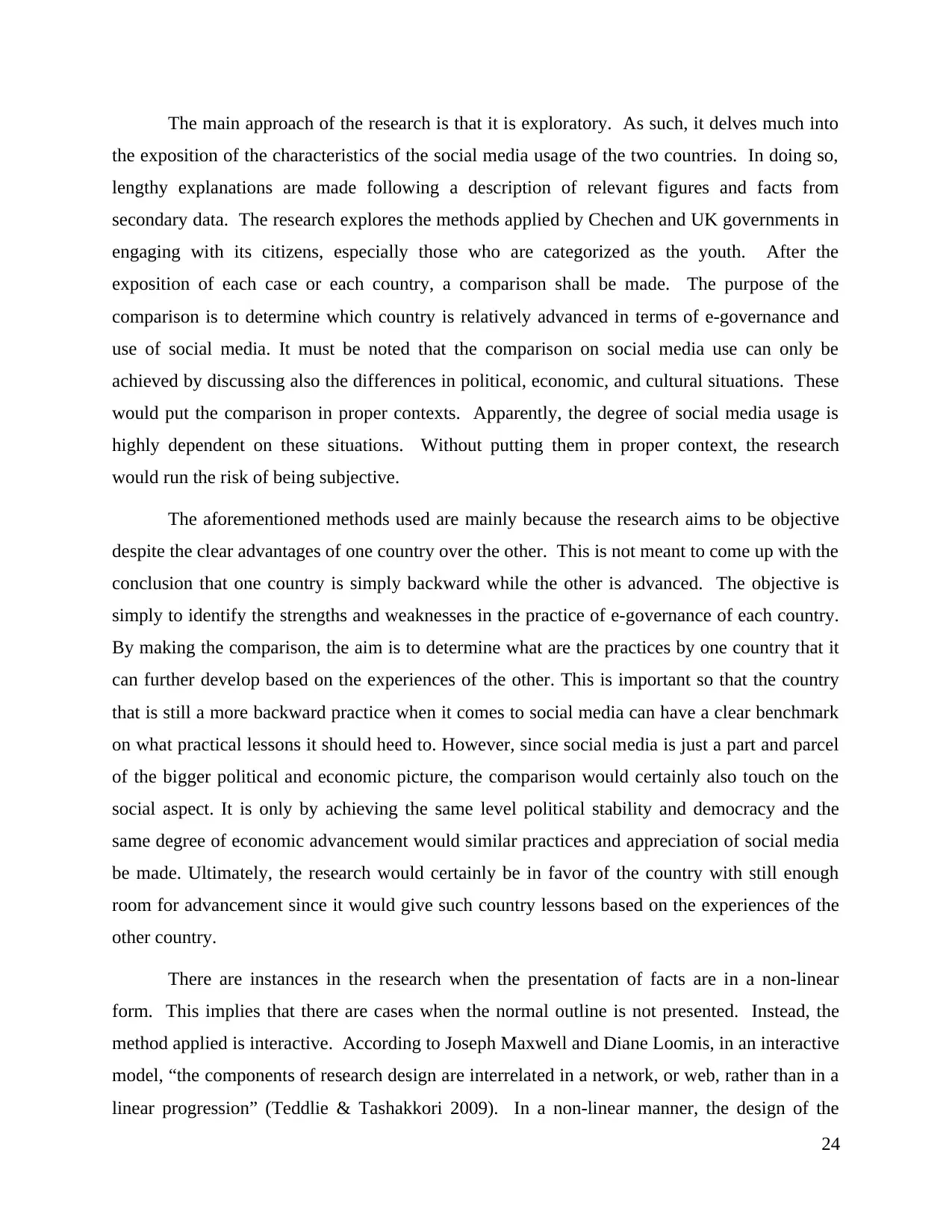
The main approach of the research is that it is exploratory. As such, it delves much into
the exposition of the characteristics of the social media usage of the two countries. In doing so,
lengthy explanations are made following a description of relevant figures and facts from
secondary data. The research explores the methods applied by Chechen and UK governments in
engaging with its citizens, especially those who are categorized as the youth. After the
exposition of each case or each country, a comparison shall be made. The purpose of the
comparison is to determine which country is relatively advanced in terms of e-governance and
use of social media. It must be noted that the comparison on social media use can only be
achieved by discussing also the differences in political, economic, and cultural situations. These
would put the comparison in proper contexts. Apparently, the degree of social media usage is
highly dependent on these situations. Without putting them in proper context, the research
would run the risk of being subjective.
The aforementioned methods used are mainly because the research aims to be objective
despite the clear advantages of one country over the other. This is not meant to come up with the
conclusion that one country is simply backward while the other is advanced. The objective is
simply to identify the strengths and weaknesses in the practice of e-governance of each country.
By making the comparison, the aim is to determine what are the practices by one country that it
can further develop based on the experiences of the other. This is important so that the country
that is still a more backward practice when it comes to social media can have a clear benchmark
on what practical lessons it should heed to. However, since social media is just a part and parcel
of the bigger political and economic picture, the comparison would certainly also touch on the
social aspect. It is only by achieving the same level political stability and democracy and the
same degree of economic advancement would similar practices and appreciation of social media
be made. Ultimately, the research would certainly be in favor of the country with still enough
room for advancement since it would give such country lessons based on the experiences of the
other country.
There are instances in the research when the presentation of facts are in a non-linear
form. This implies that there are cases when the normal outline is not presented. Instead, the
method applied is interactive. According to Joseph Maxwell and Diane Loomis, in an interactive
model, “the components of research design are interrelated in a network, or web, rather than in a
linear progression” (Teddlie & Tashakkori 2009). In a non-linear manner, the design of the
24
the exposition of the characteristics of the social media usage of the two countries. In doing so,
lengthy explanations are made following a description of relevant figures and facts from
secondary data. The research explores the methods applied by Chechen and UK governments in
engaging with its citizens, especially those who are categorized as the youth. After the
exposition of each case or each country, a comparison shall be made. The purpose of the
comparison is to determine which country is relatively advanced in terms of e-governance and
use of social media. It must be noted that the comparison on social media use can only be
achieved by discussing also the differences in political, economic, and cultural situations. These
would put the comparison in proper contexts. Apparently, the degree of social media usage is
highly dependent on these situations. Without putting them in proper context, the research
would run the risk of being subjective.
The aforementioned methods used are mainly because the research aims to be objective
despite the clear advantages of one country over the other. This is not meant to come up with the
conclusion that one country is simply backward while the other is advanced. The objective is
simply to identify the strengths and weaknesses in the practice of e-governance of each country.
By making the comparison, the aim is to determine what are the practices by one country that it
can further develop based on the experiences of the other. This is important so that the country
that is still a more backward practice when it comes to social media can have a clear benchmark
on what practical lessons it should heed to. However, since social media is just a part and parcel
of the bigger political and economic picture, the comparison would certainly also touch on the
social aspect. It is only by achieving the same level political stability and democracy and the
same degree of economic advancement would similar practices and appreciation of social media
be made. Ultimately, the research would certainly be in favor of the country with still enough
room for advancement since it would give such country lessons based on the experiences of the
other country.
There are instances in the research when the presentation of facts are in a non-linear
form. This implies that there are cases when the normal outline is not presented. Instead, the
method applied is interactive. According to Joseph Maxwell and Diane Loomis, in an interactive
model, “the components of research design are interrelated in a network, or web, rather than in a
linear progression” (Teddlie & Tashakkori 2009). In a non-linear manner, the design of the
24
Secure Best Marks with AI Grader
Need help grading? Try our AI Grader for instant feedback on your assignments.
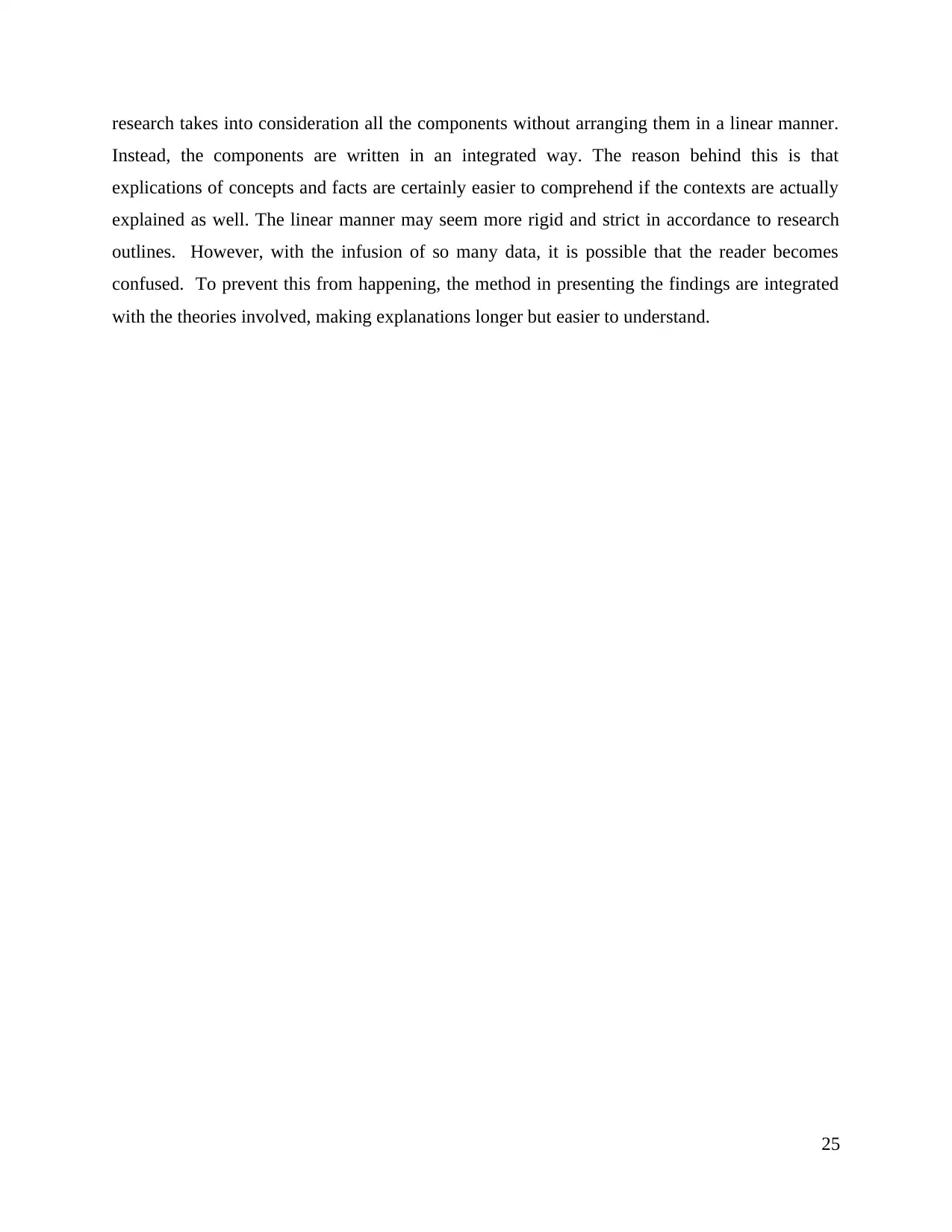
research takes into consideration all the components without arranging them in a linear manner.
Instead, the components are written in an integrated way. The reason behind this is that
explications of concepts and facts are certainly easier to comprehend if the contexts are actually
explained as well. The linear manner may seem more rigid and strict in accordance to research
outlines. However, with the infusion of so many data, it is possible that the reader becomes
confused. To prevent this from happening, the method in presenting the findings are integrated
with the theories involved, making explanations longer but easier to understand.
25
Instead, the components are written in an integrated way. The reason behind this is that
explications of concepts and facts are certainly easier to comprehend if the contexts are actually
explained as well. The linear manner may seem more rigid and strict in accordance to research
outlines. However, with the infusion of so many data, it is possible that the reader becomes
confused. To prevent this from happening, the method in presenting the findings are integrated
with the theories involved, making explanations longer but easier to understand.
25
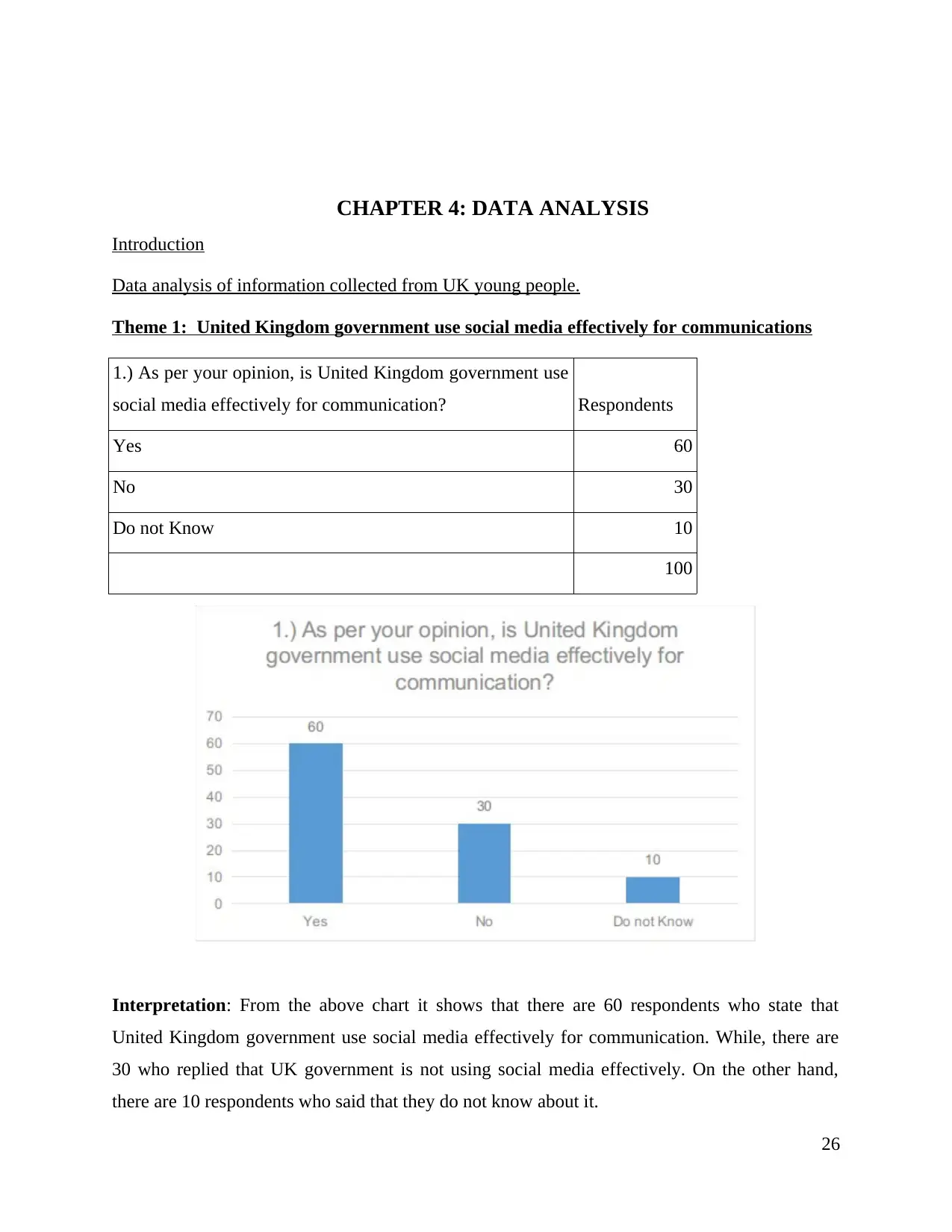
CHAPTER 4: DATA ANALYSIS
Introduction
Data analysis of information collected from UK young people.
Theme 1: United Kingdom government use social media effectively for communications
1.) As per your opinion, is United Kingdom government use
social media effectively for communication? Respondents
Yes 60
No 30
Do not Know 10
100
Interpretation: From the above chart it shows that there are 60 respondents who state that
United Kingdom government use social media effectively for communication. While, there are
30 who replied that UK government is not using social media effectively. On the other hand,
there are 10 respondents who said that they do not know about it.
26
Introduction
Data analysis of information collected from UK young people.
Theme 1: United Kingdom government use social media effectively for communications
1.) As per your opinion, is United Kingdom government use
social media effectively for communication? Respondents
Yes 60
No 30
Do not Know 10
100
Interpretation: From the above chart it shows that there are 60 respondents who state that
United Kingdom government use social media effectively for communication. While, there are
30 who replied that UK government is not using social media effectively. On the other hand,
there are 10 respondents who said that they do not know about it.
26
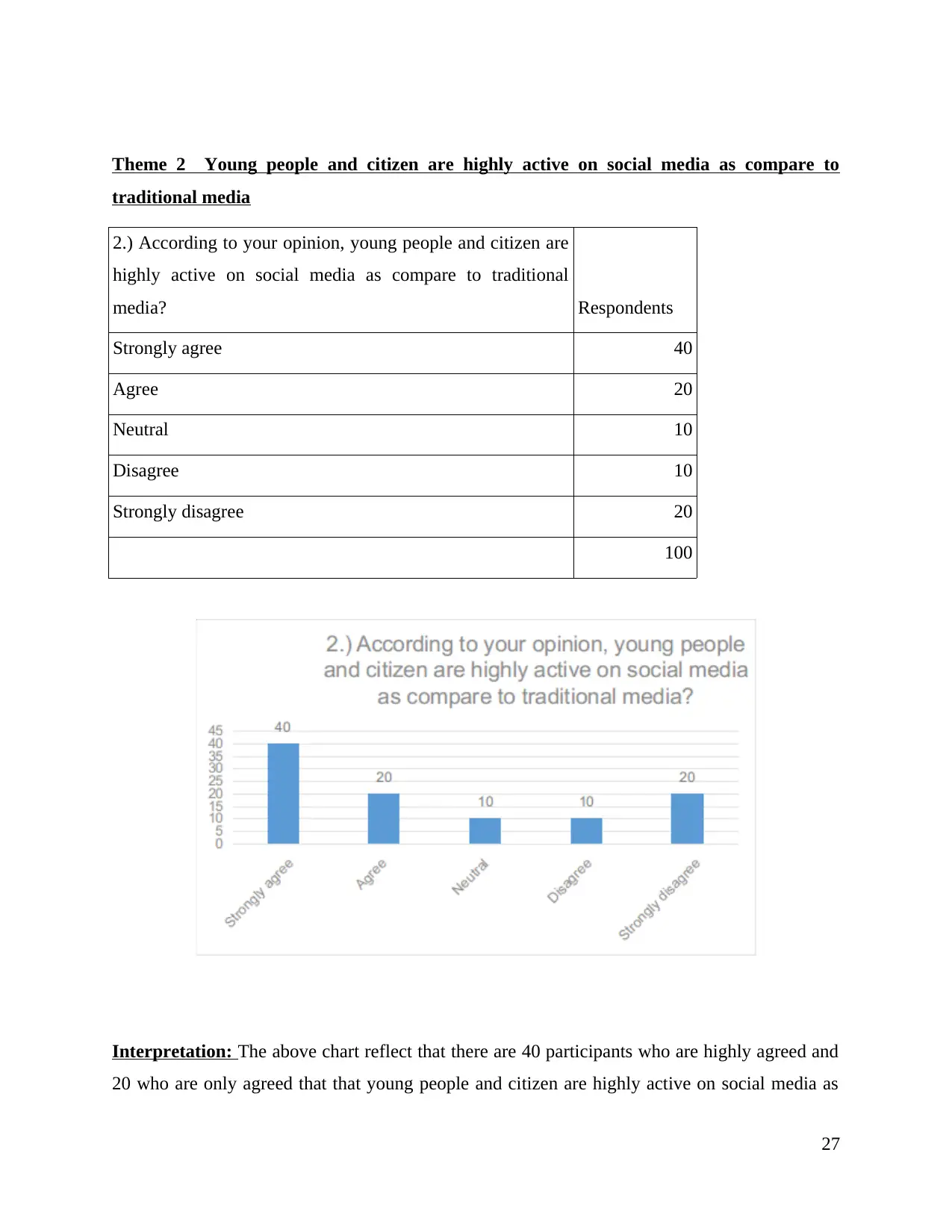
Theme 2 Young people and citizen are highly active on social media as compare to
traditional media
2.) According to your opinion, young people and citizen are
highly active on social media as compare to traditional
media? Respondents
Strongly agree 40
Agree 20
Neutral 10
Disagree 10
Strongly disagree 20
100
Interpretation: The above chart reflect that there are 40 participants who are highly agreed and
20 who are only agreed that that young people and citizen are highly active on social media as
27
traditional media
2.) According to your opinion, young people and citizen are
highly active on social media as compare to traditional
media? Respondents
Strongly agree 40
Agree 20
Neutral 10
Disagree 10
Strongly disagree 20
100
Interpretation: The above chart reflect that there are 40 participants who are highly agreed and
20 who are only agreed that that young people and citizen are highly active on social media as
27
Paraphrase This Document
Need a fresh take? Get an instant paraphrase of this document with our AI Paraphraser
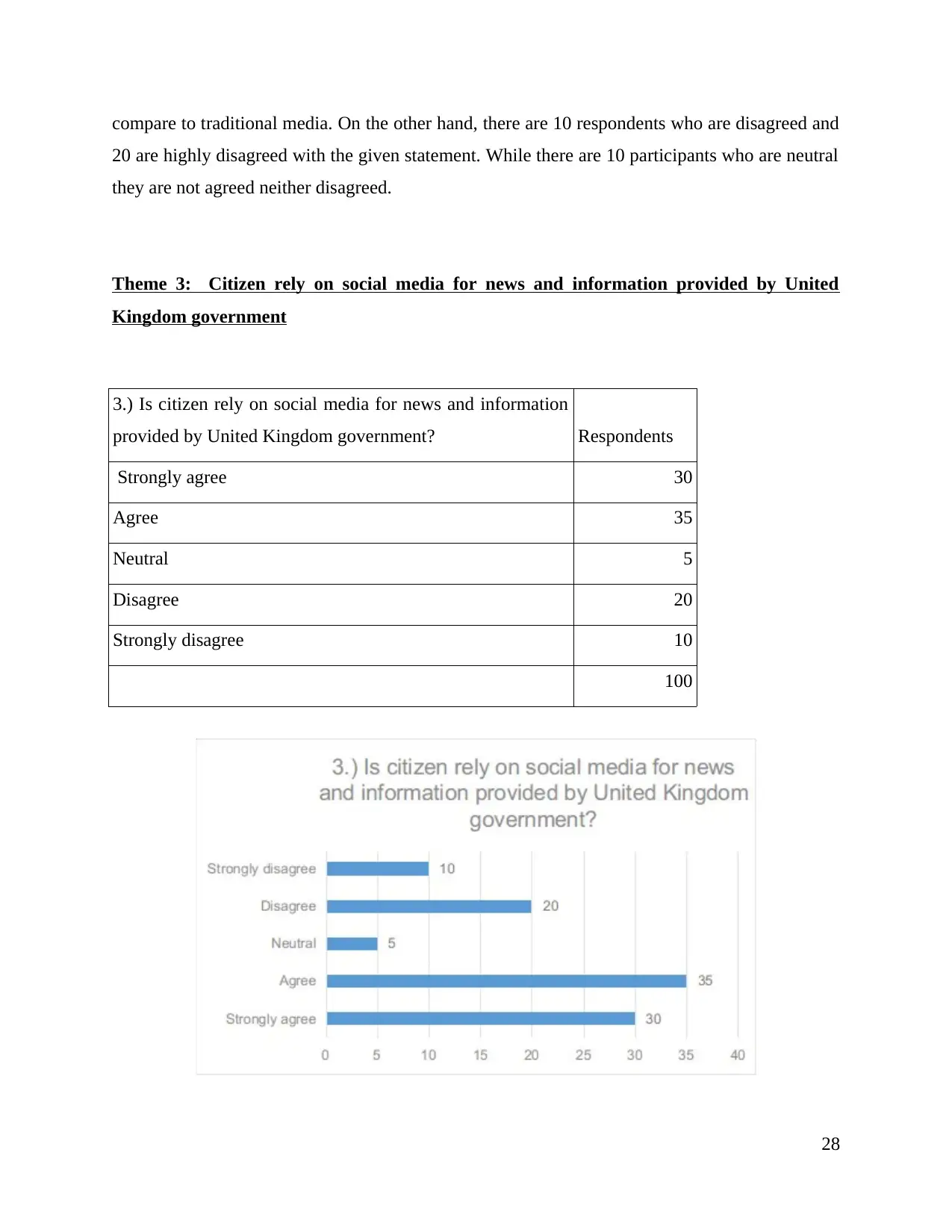
compare to traditional media. On the other hand, there are 10 respondents who are disagreed and
20 are highly disagreed with the given statement. While there are 10 participants who are neutral
they are not agreed neither disagreed.
Theme 3: Citizen rely on social media for news and information provided by United
Kingdom government
3.) Is citizen rely on social media for news and information
provided by United Kingdom government? Respondents
Strongly agree 30
Agree 35
Neutral 5
Disagree 20
Strongly disagree 10
100
28
20 are highly disagreed with the given statement. While there are 10 participants who are neutral
they are not agreed neither disagreed.
Theme 3: Citizen rely on social media for news and information provided by United
Kingdom government
3.) Is citizen rely on social media for news and information
provided by United Kingdom government? Respondents
Strongly agree 30
Agree 35
Neutral 5
Disagree 20
Strongly disagree 10
100
28
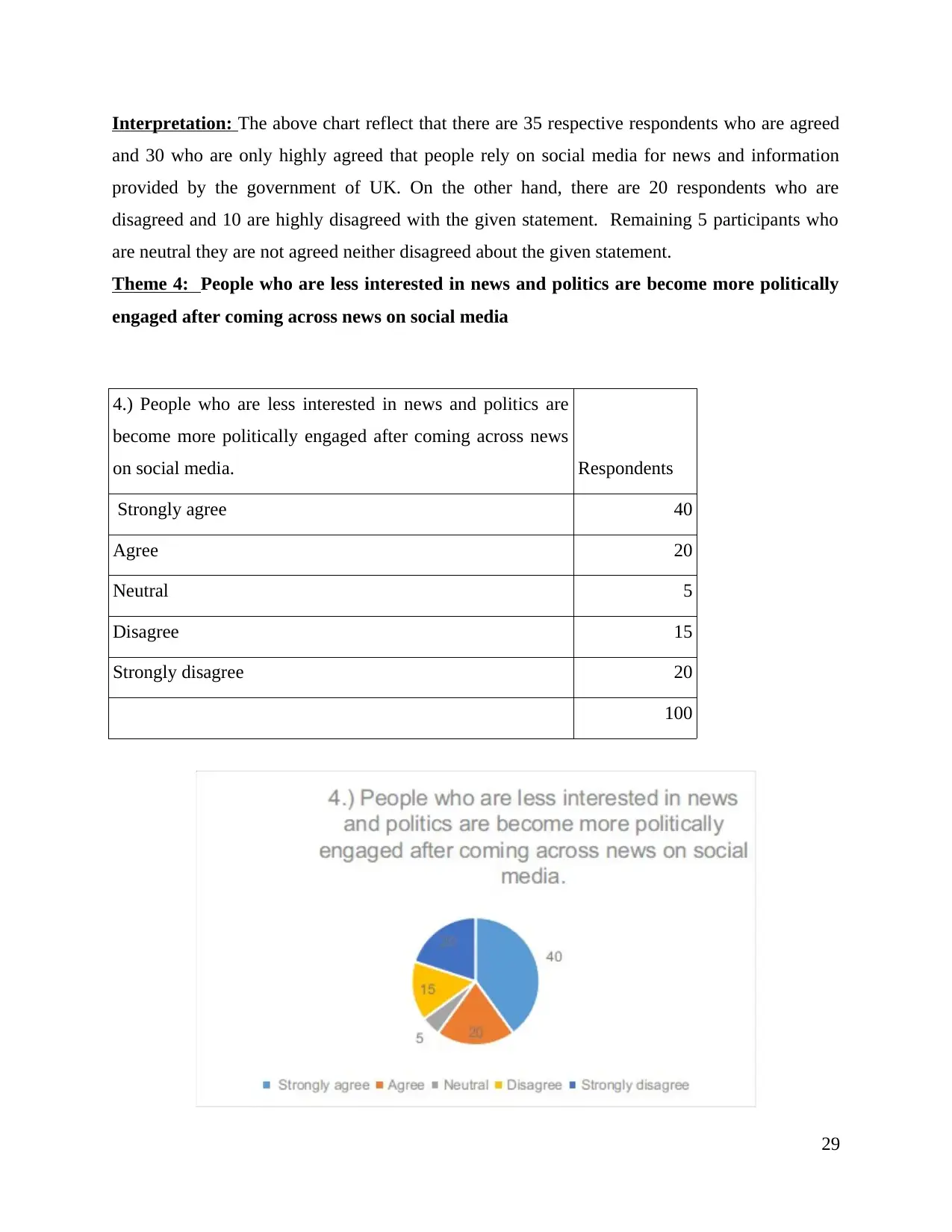
Interpretation: The above chart reflect that there are 35 respective respondents who are agreed
and 30 who are only highly agreed that people rely on social media for news and information
provided by the government of UK. On the other hand, there are 20 respondents who are
disagreed and 10 are highly disagreed with the given statement. Remaining 5 participants who
are neutral they are not agreed neither disagreed about the given statement.
Theme 4: People who are less interested in news and politics are become more politically
engaged after coming across news on social media
4.) People who are less interested in news and politics are
become more politically engaged after coming across news
on social media. Respondents
Strongly agree 40
Agree 20
Neutral 5
Disagree 15
Strongly disagree 20
100
29
and 30 who are only highly agreed that people rely on social media for news and information
provided by the government of UK. On the other hand, there are 20 respondents who are
disagreed and 10 are highly disagreed with the given statement. Remaining 5 participants who
are neutral they are not agreed neither disagreed about the given statement.
Theme 4: People who are less interested in news and politics are become more politically
engaged after coming across news on social media
4.) People who are less interested in news and politics are
become more politically engaged after coming across news
on social media. Respondents
Strongly agree 40
Agree 20
Neutral 5
Disagree 15
Strongly disagree 20
100
29
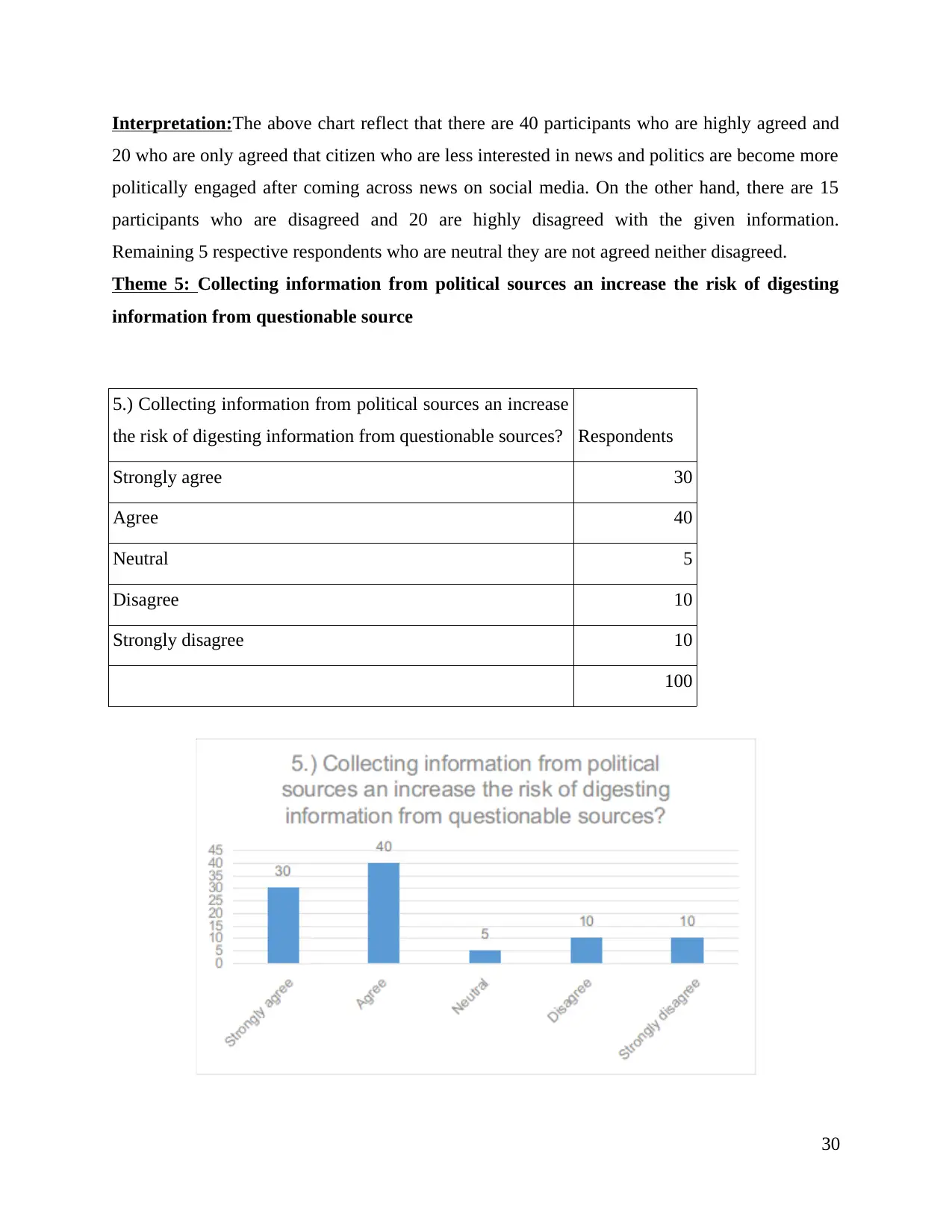
Interpretation:The above chart reflect that there are 40 participants who are highly agreed and
20 who are only agreed that citizen who are less interested in news and politics are become more
politically engaged after coming across news on social media. On the other hand, there are 15
participants who are disagreed and 20 are highly disagreed with the given information.
Remaining 5 respective respondents who are neutral they are not agreed neither disagreed.
Theme 5: Collecting information from political sources an increase the risk of digesting
information from questionable source
5.) Collecting information from political sources an increase
the risk of digesting information from questionable sources? Respondents
Strongly agree 30
Agree 40
Neutral 5
Disagree 10
Strongly disagree 10
100
30
20 who are only agreed that citizen who are less interested in news and politics are become more
politically engaged after coming across news on social media. On the other hand, there are 15
participants who are disagreed and 20 are highly disagreed with the given information.
Remaining 5 respective respondents who are neutral they are not agreed neither disagreed.
Theme 5: Collecting information from political sources an increase the risk of digesting
information from questionable source
5.) Collecting information from political sources an increase
the risk of digesting information from questionable sources? Respondents
Strongly agree 30
Agree 40
Neutral 5
Disagree 10
Strongly disagree 10
100
30
Secure Best Marks with AI Grader
Need help grading? Try our AI Grader for instant feedback on your assignments.
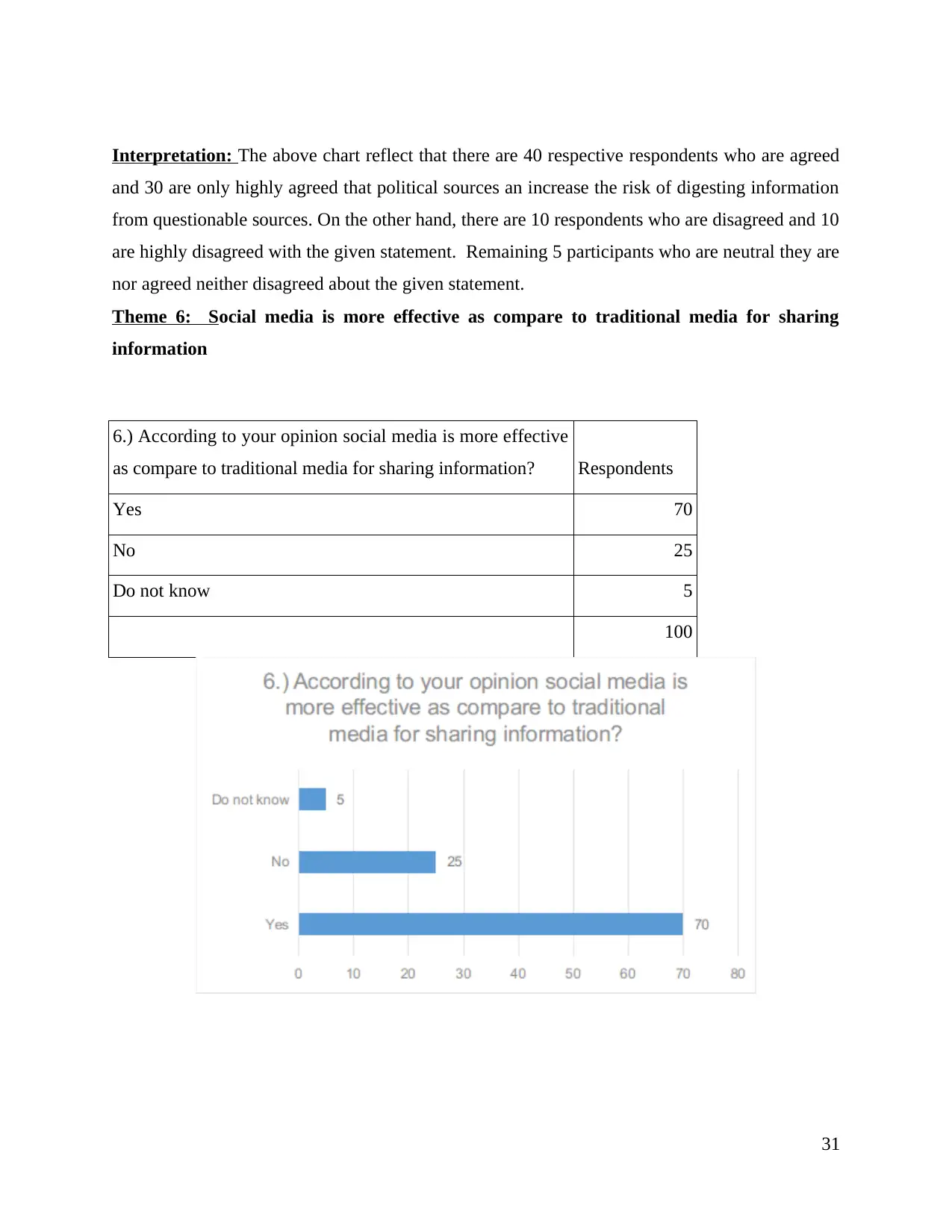
Interpretation: The above chart reflect that there are 40 respective respondents who are agreed
and 30 are only highly agreed that political sources an increase the risk of digesting information
from questionable sources. On the other hand, there are 10 respondents who are disagreed and 10
are highly disagreed with the given statement. Remaining 5 participants who are neutral they are
nor agreed neither disagreed about the given statement.
Theme 6: Social media is more effective as compare to traditional media for sharing
information
6.) According to your opinion social media is more effective
as compare to traditional media for sharing information? Respondents
Yes 70
No 25
Do not know 5
100
31
and 30 are only highly agreed that political sources an increase the risk of digesting information
from questionable sources. On the other hand, there are 10 respondents who are disagreed and 10
are highly disagreed with the given statement. Remaining 5 participants who are neutral they are
nor agreed neither disagreed about the given statement.
Theme 6: Social media is more effective as compare to traditional media for sharing
information
6.) According to your opinion social media is more effective
as compare to traditional media for sharing information? Respondents
Yes 70
No 25
Do not know 5
100
31
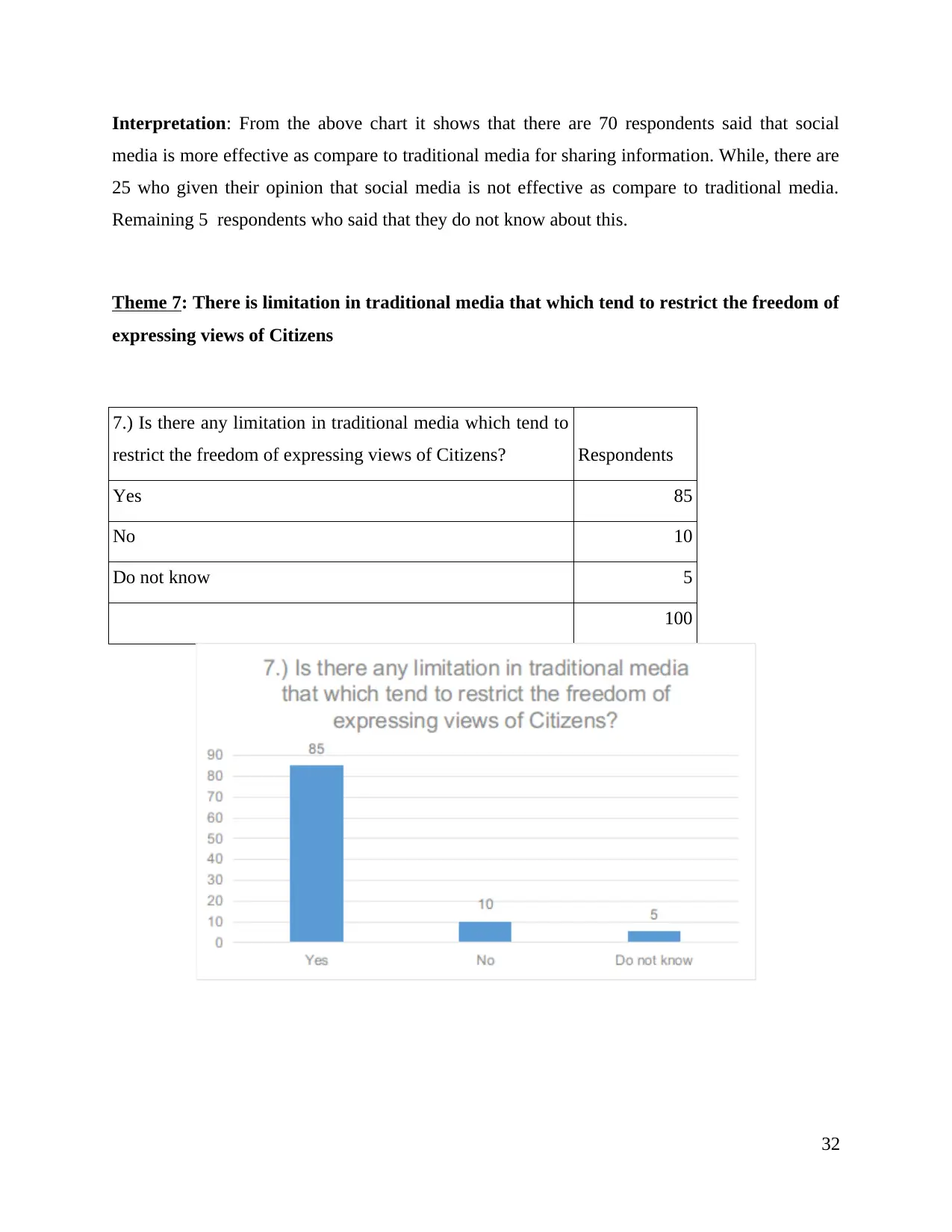
Interpretation: From the above chart it shows that there are 70 respondents said that social
media is more effective as compare to traditional media for sharing information. While, there are
25 who given their opinion that social media is not effective as compare to traditional media.
Remaining 5 respondents who said that they do not know about this.
Theme 7: There is limitation in traditional media that which tend to restrict the freedom of
expressing views of Citizens
7.) Is there any limitation in traditional media which tend to
restrict the freedom of expressing views of Citizens? Respondents
Yes 85
No 10
Do not know 5
100
32
media is more effective as compare to traditional media for sharing information. While, there are
25 who given their opinion that social media is not effective as compare to traditional media.
Remaining 5 respondents who said that they do not know about this.
Theme 7: There is limitation in traditional media that which tend to restrict the freedom of
expressing views of Citizens
7.) Is there any limitation in traditional media which tend to
restrict the freedom of expressing views of Citizens? Respondents
Yes 85
No 10
Do not know 5
100
32
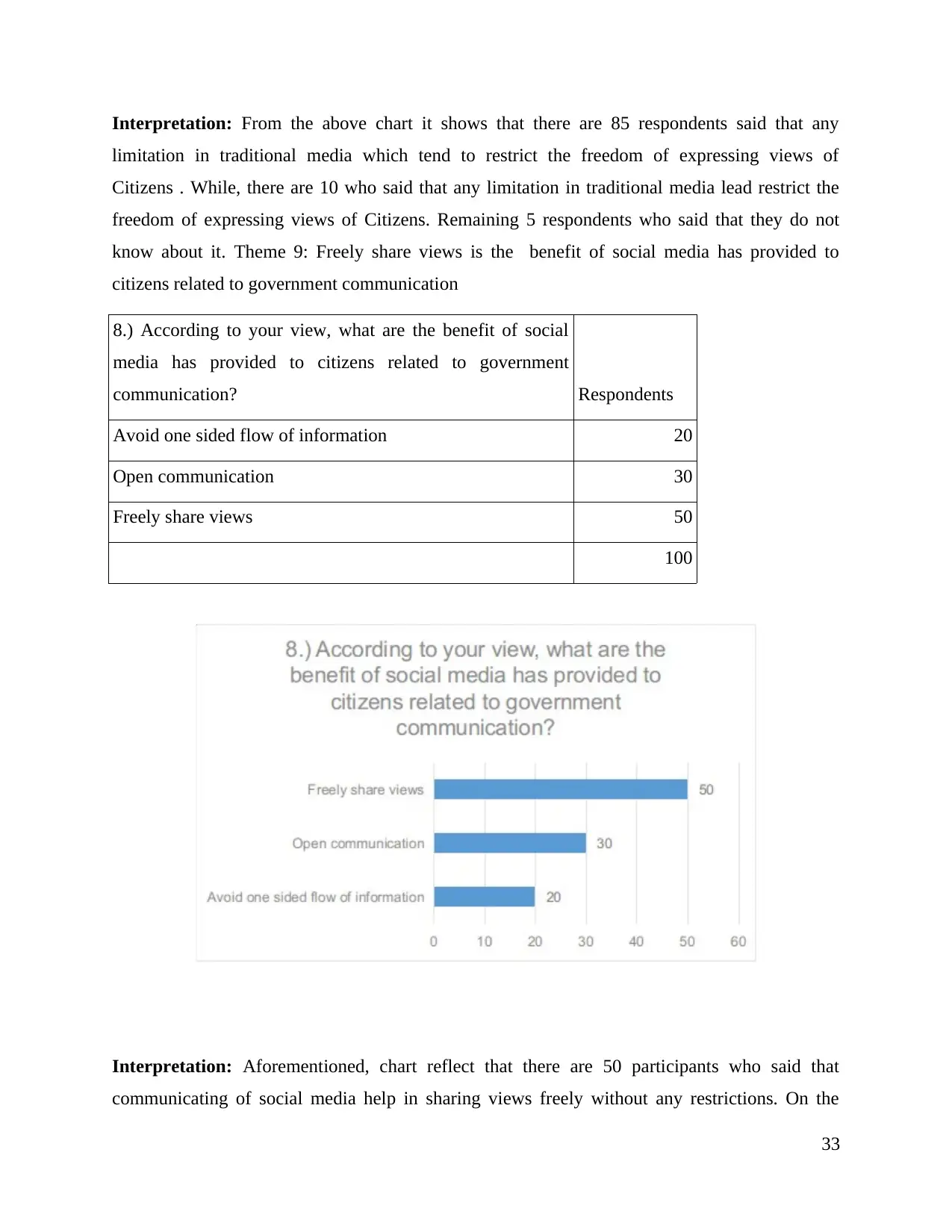
Interpretation: From the above chart it shows that there are 85 respondents said that any
limitation in traditional media which tend to restrict the freedom of expressing views of
Citizens . While, there are 10 who said that any limitation in traditional media lead restrict the
freedom of expressing views of Citizens. Remaining 5 respondents who said that they do not
know about it. Theme 9: Freely share views is the benefit of social media has provided to
citizens related to government communication
8.) According to your view, what are the benefit of social
media has provided to citizens related to government
communication? Respondents
Avoid one sided flow of information 20
Open communication 30
Freely share views 50
100
Interpretation: Aforementioned, chart reflect that there are 50 participants who said that
communicating of social media help in sharing views freely without any restrictions. On the
33
limitation in traditional media which tend to restrict the freedom of expressing views of
Citizens . While, there are 10 who said that any limitation in traditional media lead restrict the
freedom of expressing views of Citizens. Remaining 5 respondents who said that they do not
know about it. Theme 9: Freely share views is the benefit of social media has provided to
citizens related to government communication
8.) According to your view, what are the benefit of social
media has provided to citizens related to government
communication? Respondents
Avoid one sided flow of information 20
Open communication 30
Freely share views 50
100
Interpretation: Aforementioned, chart reflect that there are 50 participants who said that
communicating of social media help in sharing views freely without any restrictions. On the
33
Paraphrase This Document
Need a fresh take? Get an instant paraphrase of this document with our AI Paraphraser
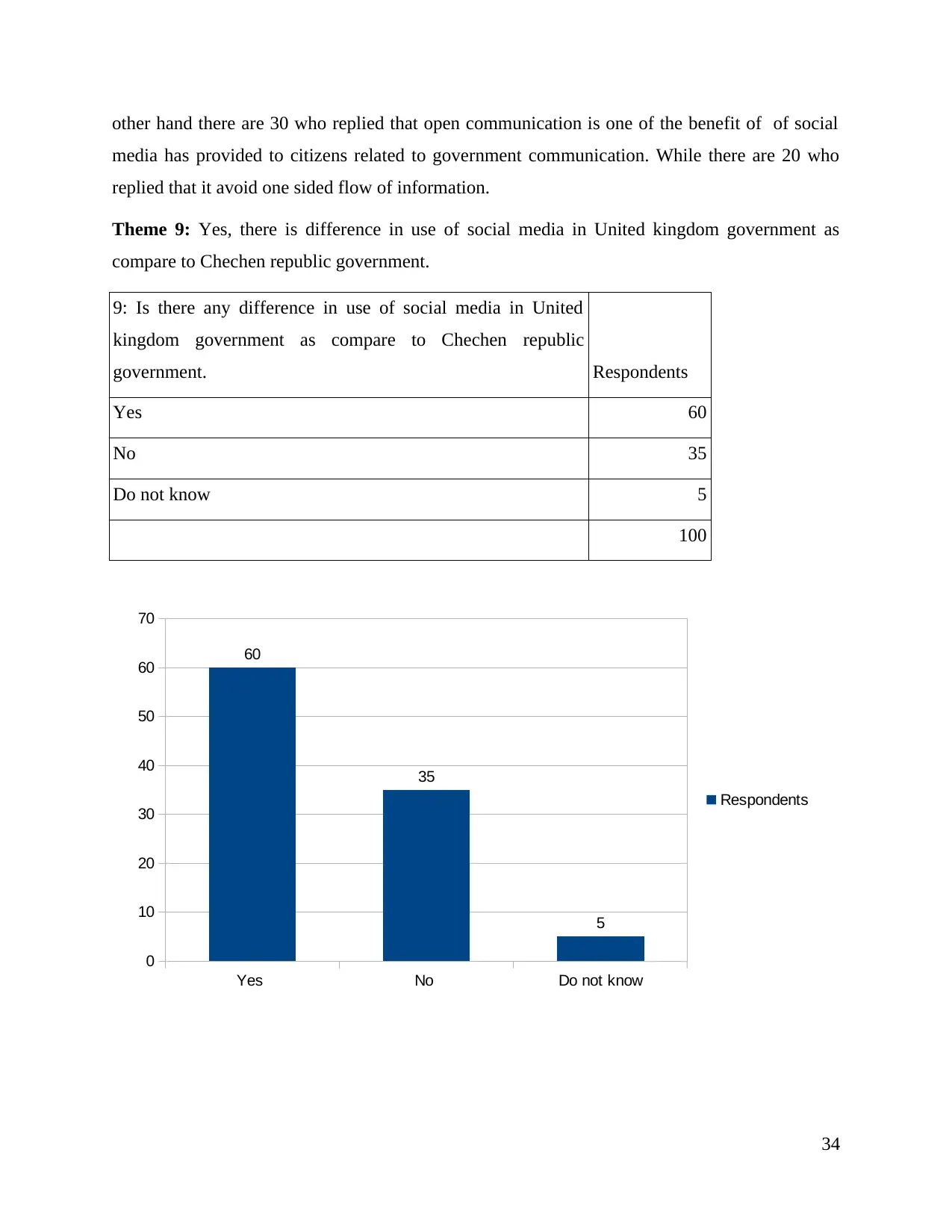
other hand there are 30 who replied that open communication is one of the benefit of of social
media has provided to citizens related to government communication. While there are 20 who
replied that it avoid one sided flow of information.
Theme 9: Yes, there is difference in use of social media in United kingdom government as
compare to Chechen republic government.
9: Is there any difference in use of social media in United
kingdom government as compare to Chechen republic
government. Respondents
Yes 60
No 35
Do not know 5
100
34
Yes No Do not know
0
10
20
30
40
50
60
70
60
35
5
Respondents
media has provided to citizens related to government communication. While there are 20 who
replied that it avoid one sided flow of information.
Theme 9: Yes, there is difference in use of social media in United kingdom government as
compare to Chechen republic government.
9: Is there any difference in use of social media in United
kingdom government as compare to Chechen republic
government. Respondents
Yes 60
No 35
Do not know 5
100
34
Yes No Do not know
0
10
20
30
40
50
60
70
60
35
5
Respondents
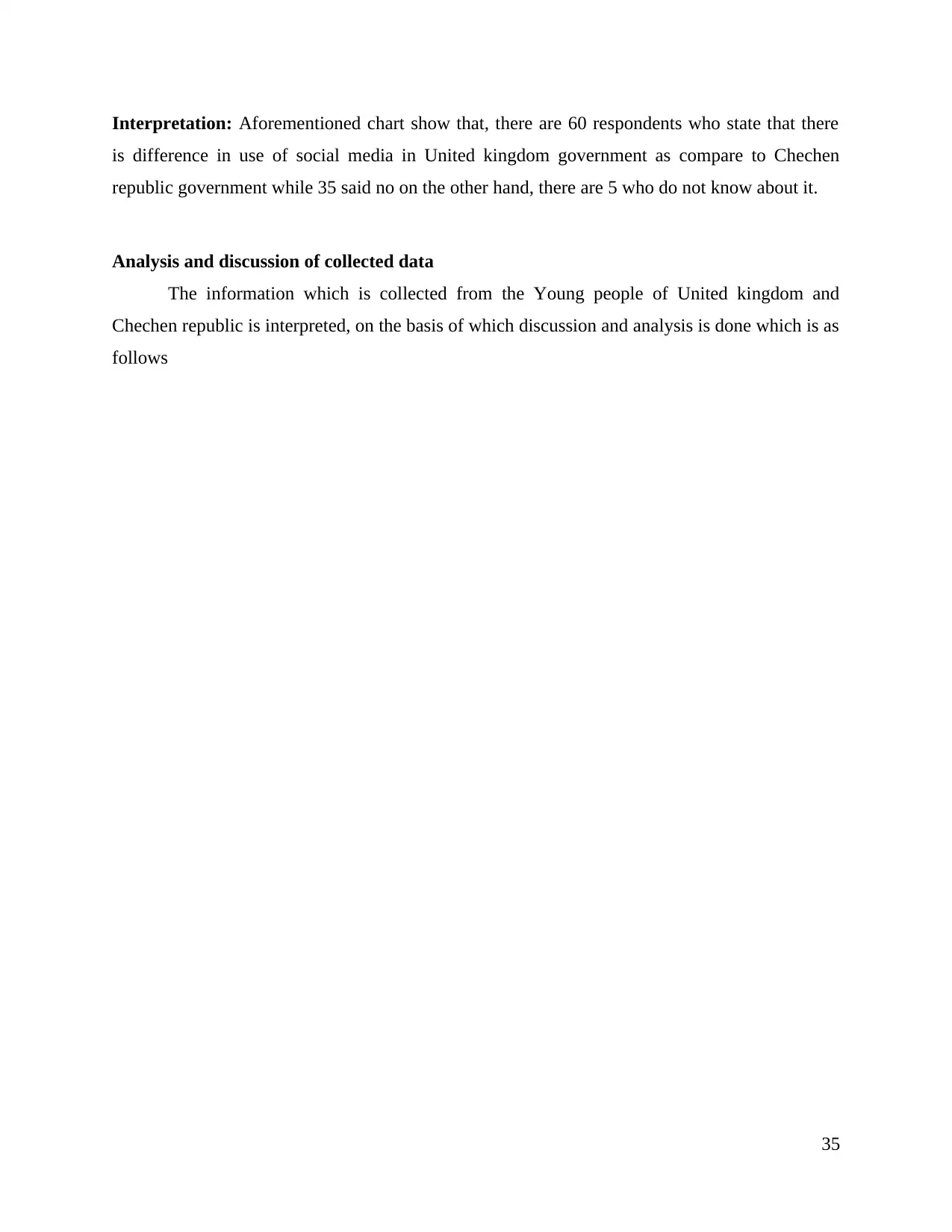
Interpretation: Aforementioned chart show that, there are 60 respondents who state that there
is difference in use of social media in United kingdom government as compare to Chechen
republic government while 35 said no on the other hand, there are 5 who do not know about it.
Analysis and discussion of collected data
The information which is collected from the Young people of United kingdom and
Chechen republic is interpreted, on the basis of which discussion and analysis is done which is as
follows
35
is difference in use of social media in United kingdom government as compare to Chechen
republic government while 35 said no on the other hand, there are 5 who do not know about it.
Analysis and discussion of collected data
The information which is collected from the Young people of United kingdom and
Chechen republic is interpreted, on the basis of which discussion and analysis is done which is as
follows
35
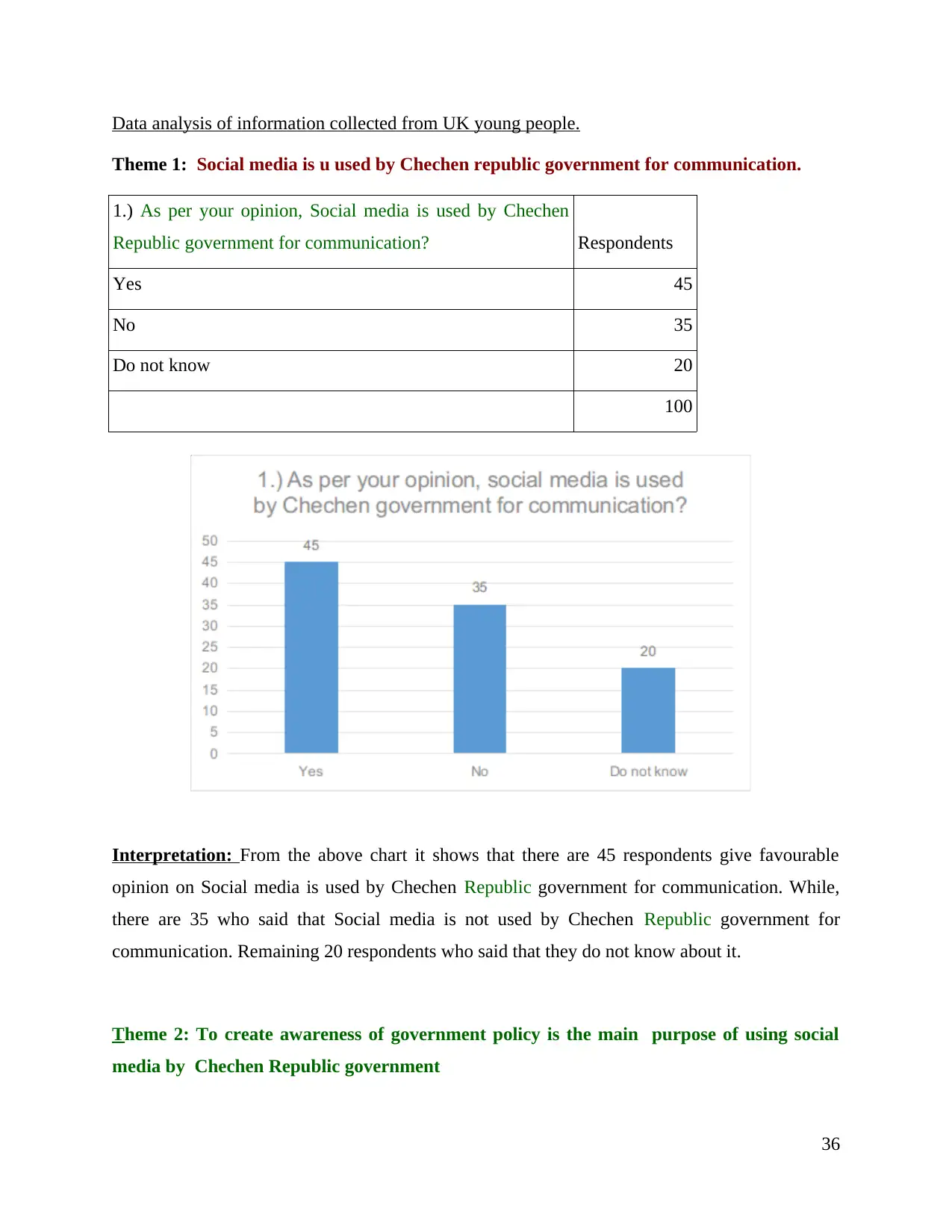
Data analysis of information collected from UK young people.
Theme 1: Social media is u used by Chechen republic government for communication.
1.) As per your opinion, Social media is used by Chechen
Republic government for communication? Respondents
Yes 45
No 35
Do not know 20
100
Interpretation: From the above chart it shows that there are 45 respondents give favourable
opinion on Social media is used by Chechen Republic government for communication. While,
there are 35 who said that Social media is not used by Chechen Republic government for
communication. Remaining 20 respondents who said that they do not know about it.
Theme 2: To create awareness of government policy is the main purpose of using social
media by Chechen Republic government
36
Theme 1: Social media is u used by Chechen republic government for communication.
1.) As per your opinion, Social media is used by Chechen
Republic government for communication? Respondents
Yes 45
No 35
Do not know 20
100
Interpretation: From the above chart it shows that there are 45 respondents give favourable
opinion on Social media is used by Chechen Republic government for communication. While,
there are 35 who said that Social media is not used by Chechen Republic government for
communication. Remaining 20 respondents who said that they do not know about it.
Theme 2: To create awareness of government policy is the main purpose of using social
media by Chechen Republic government
36
Secure Best Marks with AI Grader
Need help grading? Try our AI Grader for instant feedback on your assignments.
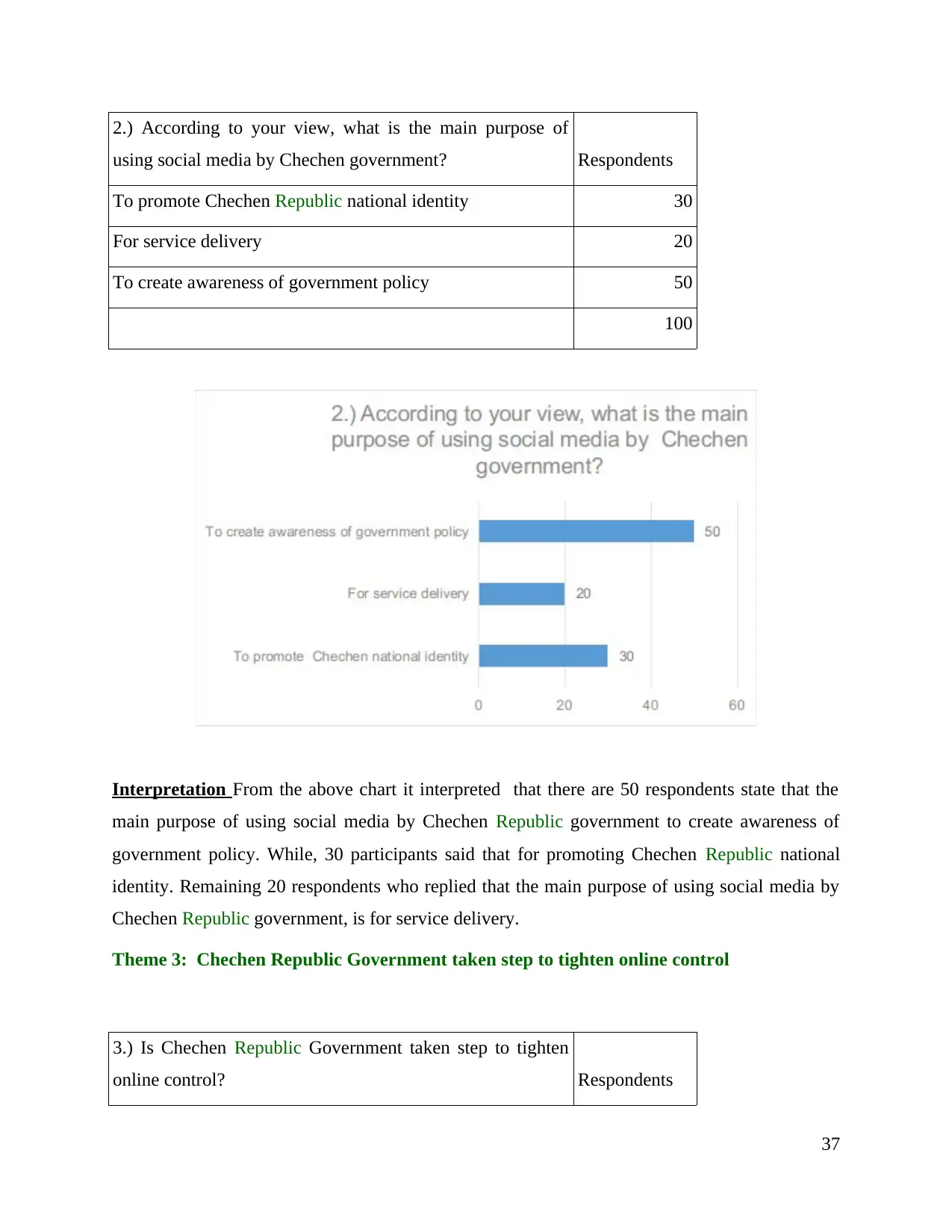
2.) According to your view, what is the main purpose of
using social media by Chechen government? Respondents
To promote Chechen Republic national identity 30
For service delivery 20
To create awareness of government policy 50
100
Interpretation From the above chart it interpreted that there are 50 respondents state that the
main purpose of using social media by Chechen Republic government to create awareness of
government policy. While, 30 participants said that for promoting Chechen Republic national
identity. Remaining 20 respondents who replied that the main purpose of using social media by
Chechen Republic government, is for service delivery.
Theme 3: Chechen Republic Government taken step to tighten online control
3.) Is Chechen Republic Government taken step to tighten
online control? Respondents
37
using social media by Chechen government? Respondents
To promote Chechen Republic national identity 30
For service delivery 20
To create awareness of government policy 50
100
Interpretation From the above chart it interpreted that there are 50 respondents state that the
main purpose of using social media by Chechen Republic government to create awareness of
government policy. While, 30 participants said that for promoting Chechen Republic national
identity. Remaining 20 respondents who replied that the main purpose of using social media by
Chechen Republic government, is for service delivery.
Theme 3: Chechen Republic Government taken step to tighten online control
3.) Is Chechen Republic Government taken step to tighten
online control? Respondents
37
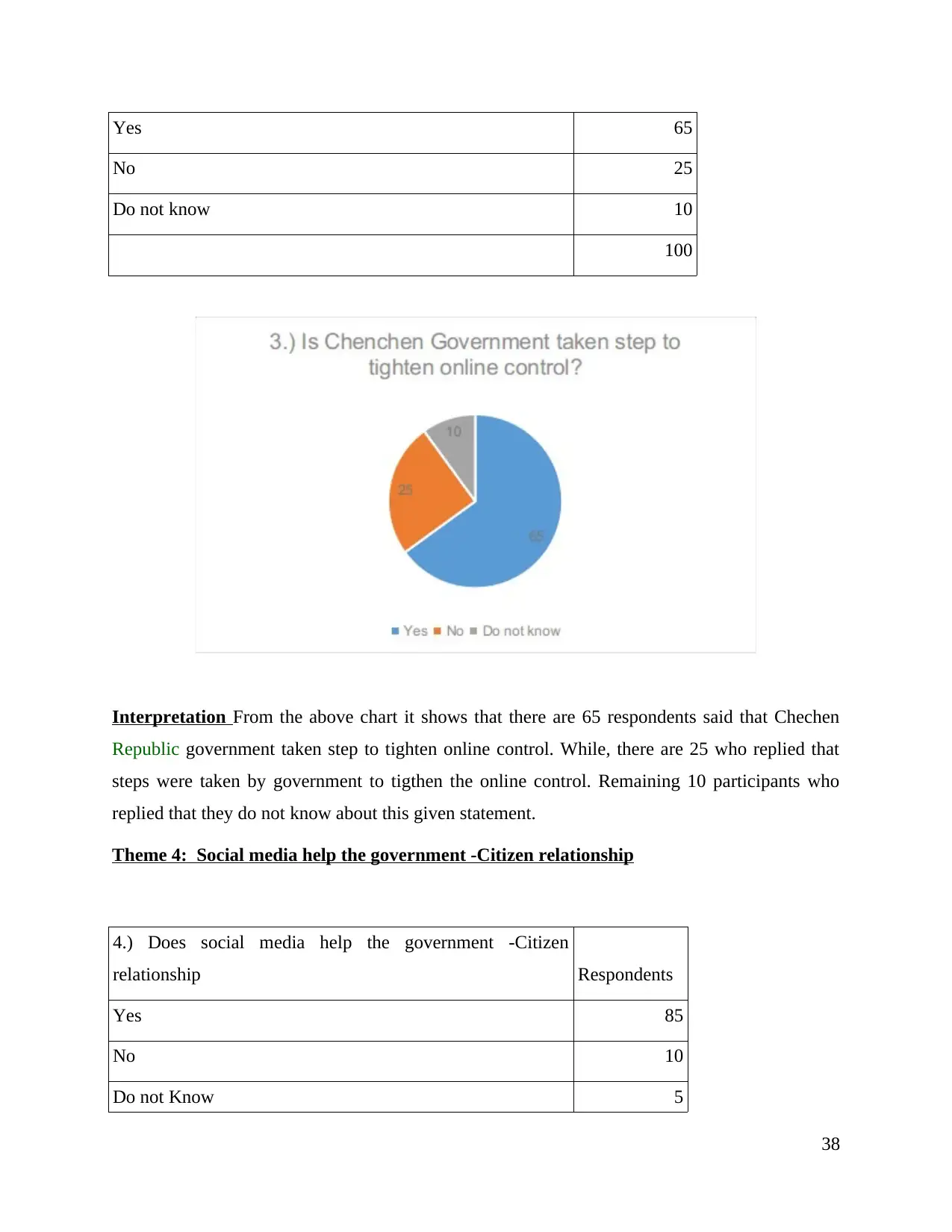
Yes 65
No 25
Do not know 10
100
Interpretation From the above chart it shows that there are 65 respondents said that Chechen
Republic government taken step to tighten online control. While, there are 25 who replied that
steps were taken by government to tigthen the online control. Remaining 10 participants who
replied that they do not know about this given statement.
Theme 4: Social media help the government -Citizen relationship
4.) Does social media help the government -Citizen
relationship Respondents
Yes 85
No 10
Do not Know 5
38
No 25
Do not know 10
100
Interpretation From the above chart it shows that there are 65 respondents said that Chechen
Republic government taken step to tighten online control. While, there are 25 who replied that
steps were taken by government to tigthen the online control. Remaining 10 participants who
replied that they do not know about this given statement.
Theme 4: Social media help the government -Citizen relationship
4.) Does social media help the government -Citizen
relationship Respondents
Yes 85
No 10
Do not Know 5
38
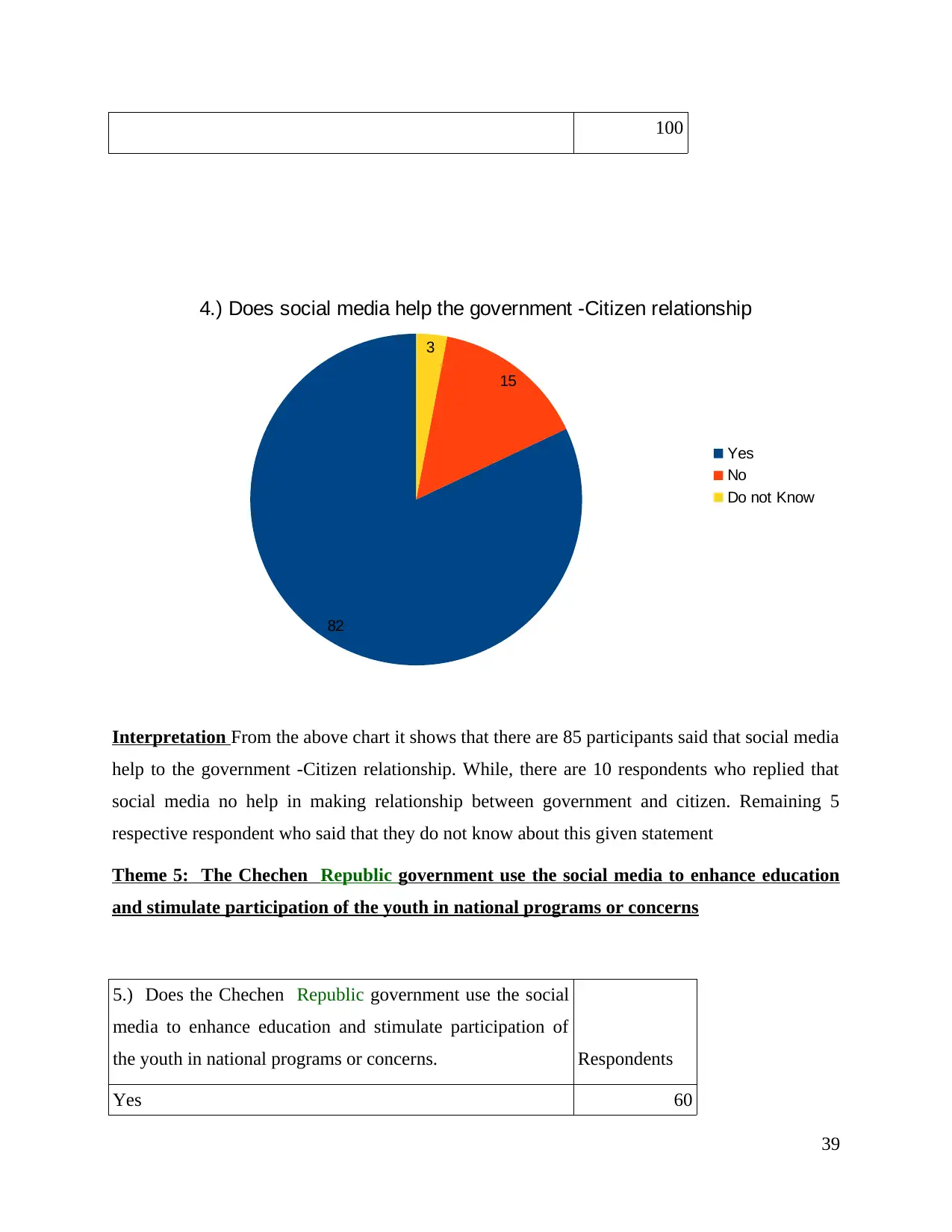
100
Interpretation From the above chart it shows that there are 85 participants said that social media
help to the government -Citizen relationship. While, there are 10 respondents who replied that
social media no help in making relationship between government and citizen. Remaining 5
respective respondent who said that they do not know about this given statement
Theme 5: The Chechen Republic government use the social media to enhance education
and stimulate participation of the youth in national programs or concerns
5.) Does the Chechen Republic government use the social
media to enhance education and stimulate participation of
the youth in national programs or concerns. Respondents
Yes 60
39
82
15
3
4.) Does social media help the government -Citizen relationship
Yes
No
Do not Know
Interpretation From the above chart it shows that there are 85 participants said that social media
help to the government -Citizen relationship. While, there are 10 respondents who replied that
social media no help in making relationship between government and citizen. Remaining 5
respective respondent who said that they do not know about this given statement
Theme 5: The Chechen Republic government use the social media to enhance education
and stimulate participation of the youth in national programs or concerns
5.) Does the Chechen Republic government use the social
media to enhance education and stimulate participation of
the youth in national programs or concerns. Respondents
Yes 60
39
82
15
3
4.) Does social media help the government -Citizen relationship
Yes
No
Do not Know
Paraphrase This Document
Need a fresh take? Get an instant paraphrase of this document with our AI Paraphraser
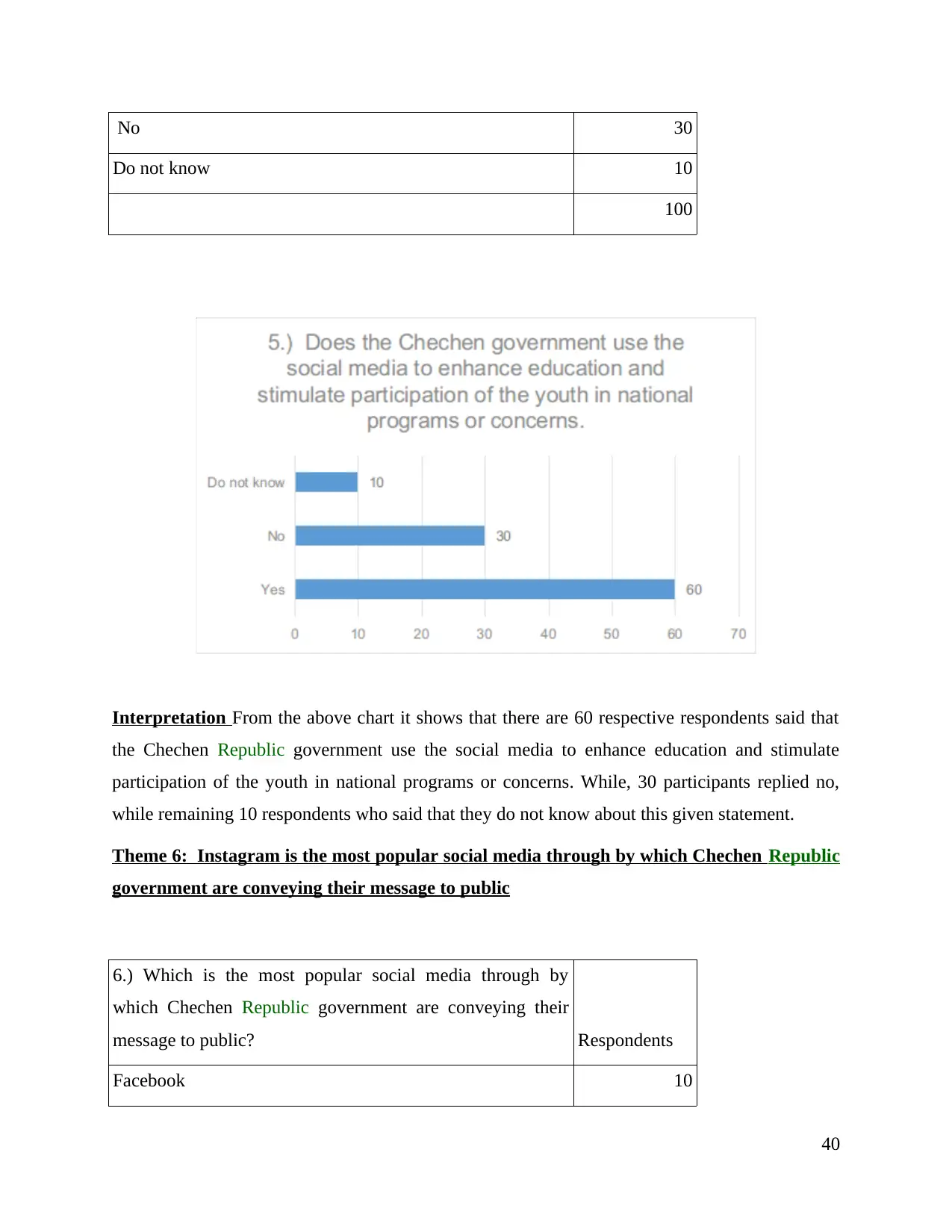
No 30
Do not know 10
100
Interpretation From the above chart it shows that there are 60 respective respondents said that
the Chechen Republic government use the social media to enhance education and stimulate
participation of the youth in national programs or concerns. While, 30 participants replied no,
while remaining 10 respondents who said that they do not know about this given statement.
Theme 6: Instagram is the most popular social media through by which Chechen Republic
government are conveying their message to public
6.) Which is the most popular social media through by
which Chechen Republic government are conveying their
message to public? Respondents
Facebook 10
40
Do not know 10
100
Interpretation From the above chart it shows that there are 60 respective respondents said that
the Chechen Republic government use the social media to enhance education and stimulate
participation of the youth in national programs or concerns. While, 30 participants replied no,
while remaining 10 respondents who said that they do not know about this given statement.
Theme 6: Instagram is the most popular social media through by which Chechen Republic
government are conveying their message to public
6.) Which is the most popular social media through by
which Chechen Republic government are conveying their
message to public? Respondents
Facebook 10
40
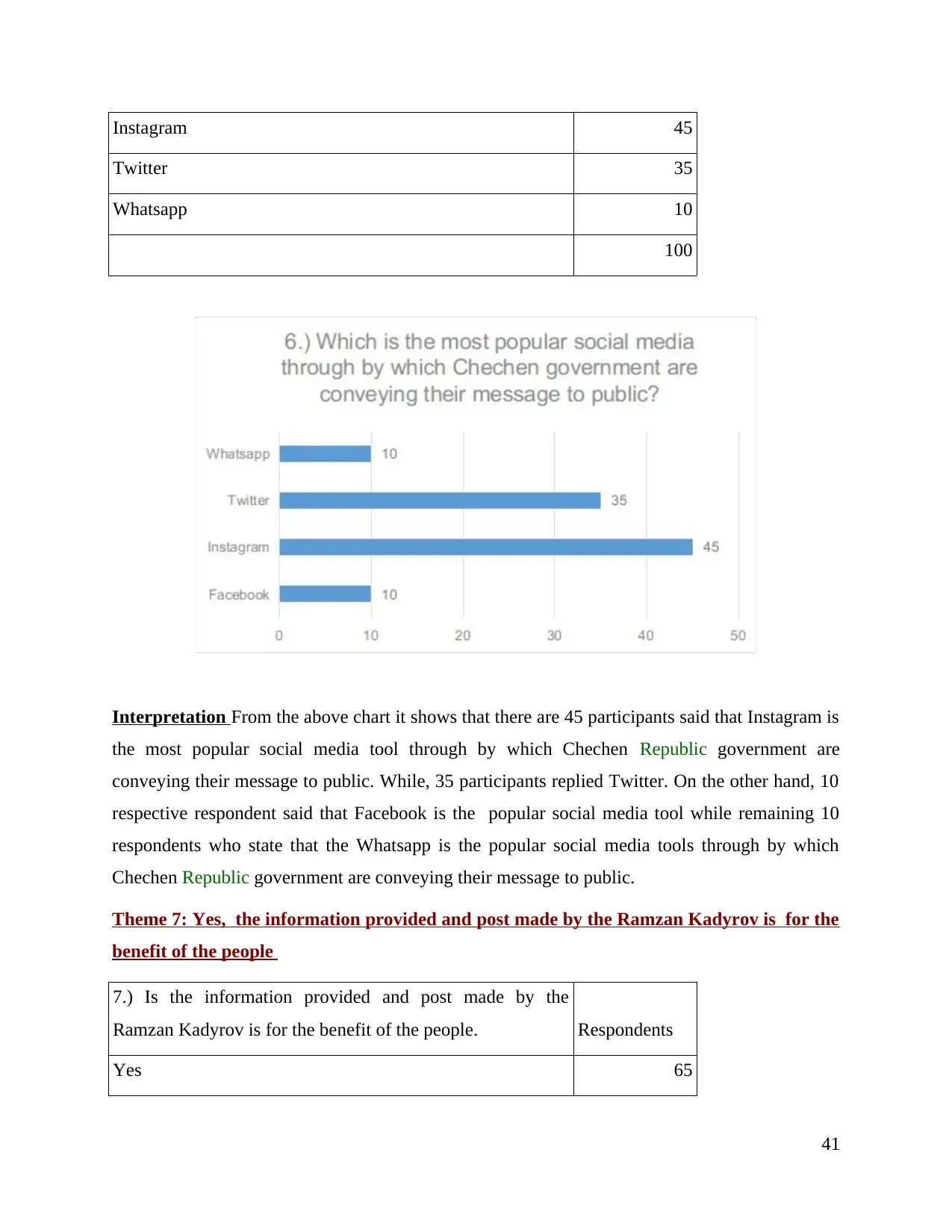
Instagram 45
Twitter 35
Whatsapp 10
100
Interpretation From the above chart it shows that there are 45 participants said that Instagram is
the most popular social media tool through by which Chechen Republic government are
conveying their message to public. While, 35 participants replied Twitter. On the other hand, 10
respective respondent said that Facebook is the popular social media tool while remaining 10
respondents who state that the Whatsapp is the popular social media tools through by which
Chechen Republic government are conveying their message to public.
Theme 7: Yes, the information provided and post made by the Ramzan Kadyrov is for the
benefit of the people
7.) Is the information provided and post made by the
Ramzan Kadyrov is for the benefit of the people. Respondents
Yes 65
41
Twitter 35
Whatsapp 10
100
Interpretation From the above chart it shows that there are 45 participants said that Instagram is
the most popular social media tool through by which Chechen Republic government are
conveying their message to public. While, 35 participants replied Twitter. On the other hand, 10
respective respondent said that Facebook is the popular social media tool while remaining 10
respondents who state that the Whatsapp is the popular social media tools through by which
Chechen Republic government are conveying their message to public.
Theme 7: Yes, the information provided and post made by the Ramzan Kadyrov is for the
benefit of the people
7.) Is the information provided and post made by the
Ramzan Kadyrov is for the benefit of the people. Respondents
Yes 65
41
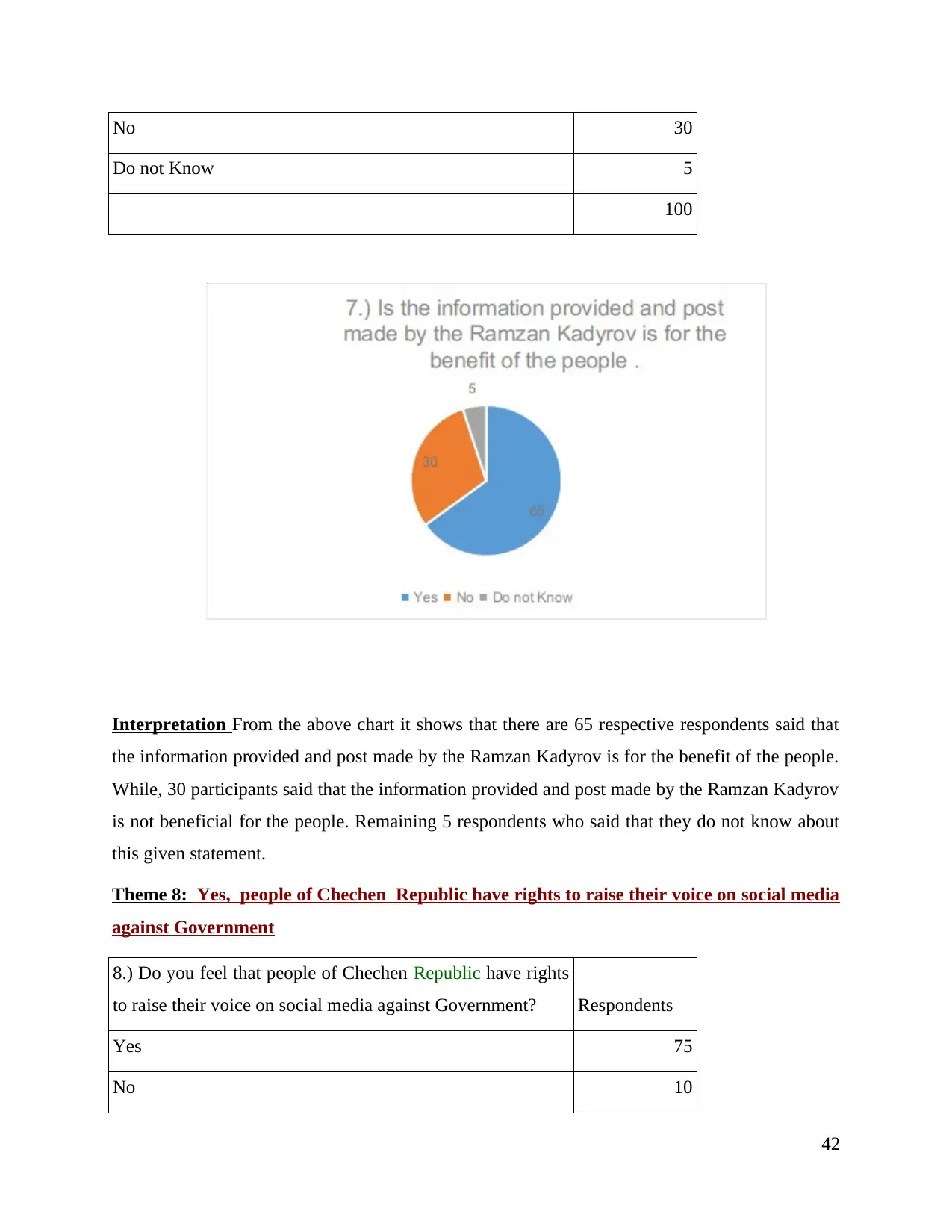
No 30
Do not Know 5
100
Interpretation From the above chart it shows that there are 65 respective respondents said that
the information provided and post made by the Ramzan Kadyrov is for the benefit of the people.
While, 30 participants said that the information provided and post made by the Ramzan Kadyrov
is not beneficial for the people. Remaining 5 respondents who said that they do not know about
this given statement.
Theme 8: Yes, people of Chechen Republic have rights to raise their voice on social media
against Government
8.) Do you feel that people of Chechen Republic have rights
to raise their voice on social media against Government? Respondents
Yes 75
No 10
42
Do not Know 5
100
Interpretation From the above chart it shows that there are 65 respective respondents said that
the information provided and post made by the Ramzan Kadyrov is for the benefit of the people.
While, 30 participants said that the information provided and post made by the Ramzan Kadyrov
is not beneficial for the people. Remaining 5 respondents who said that they do not know about
this given statement.
Theme 8: Yes, people of Chechen Republic have rights to raise their voice on social media
against Government
8.) Do you feel that people of Chechen Republic have rights
to raise their voice on social media against Government? Respondents
Yes 75
No 10
42
Secure Best Marks with AI Grader
Need help grading? Try our AI Grader for instant feedback on your assignments.
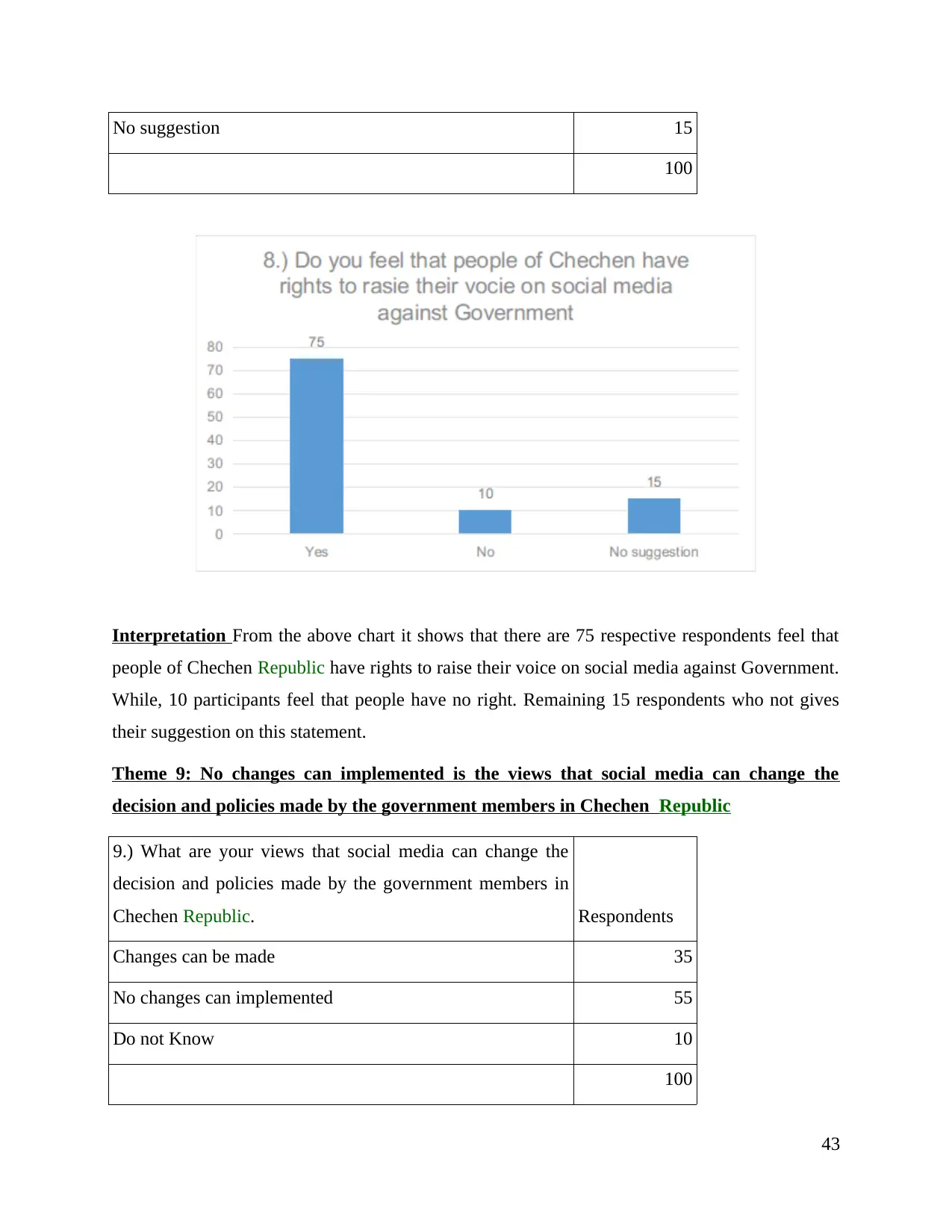
No suggestion 15
100
Interpretation From the above chart it shows that there are 75 respective respondents feel that
people of Chechen Republic have rights to raise their voice on social media against Government.
While, 10 participants feel that people have no right. Remaining 15 respondents who not gives
their suggestion on this statement.
Theme 9: No changes can implemented is the views that social media can change the
decision and policies made by the government members in Chechen Republic
9.) What are your views that social media can change the
decision and policies made by the government members in
Chechen Republic. Respondents
Changes can be made 35
No changes can implemented 55
Do not Know 10
100
43
100
Interpretation From the above chart it shows that there are 75 respective respondents feel that
people of Chechen Republic have rights to raise their voice on social media against Government.
While, 10 participants feel that people have no right. Remaining 15 respondents who not gives
their suggestion on this statement.
Theme 9: No changes can implemented is the views that social media can change the
decision and policies made by the government members in Chechen Republic
9.) What are your views that social media can change the
decision and policies made by the government members in
Chechen Republic. Respondents
Changes can be made 35
No changes can implemented 55
Do not Know 10
100
43
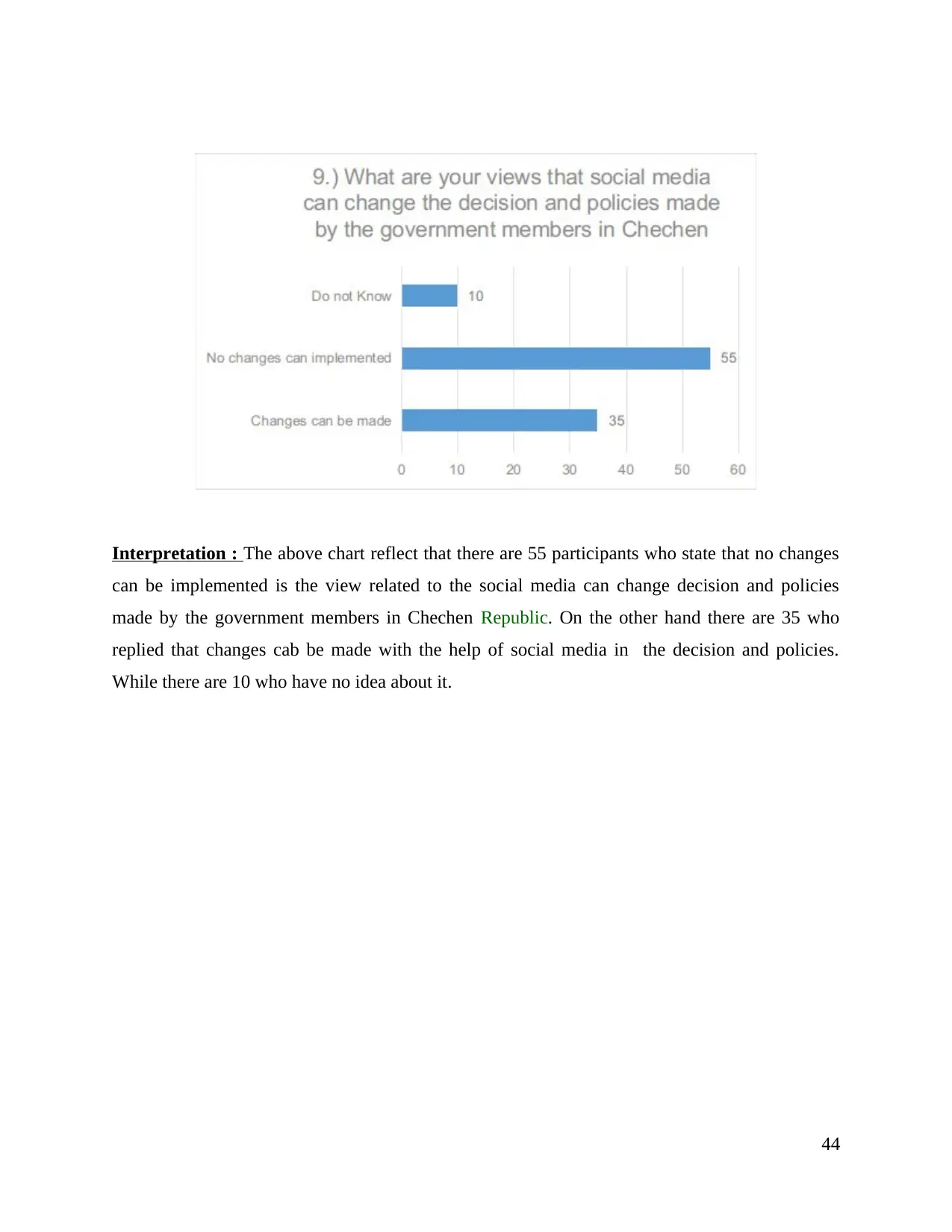
Interpretation : The above chart reflect that there are 55 participants who state that no changes
can be implemented is the view related to the social media can change decision and policies
made by the government members in Chechen Republic. On the other hand there are 35 who
replied that changes cab be made with the help of social media in the decision and policies.
While there are 10 who have no idea about it.
44
can be implemented is the view related to the social media can change decision and policies
made by the government members in Chechen Republic. On the other hand there are 35 who
replied that changes cab be made with the help of social media in the decision and policies.
While there are 10 who have no idea about it.
44
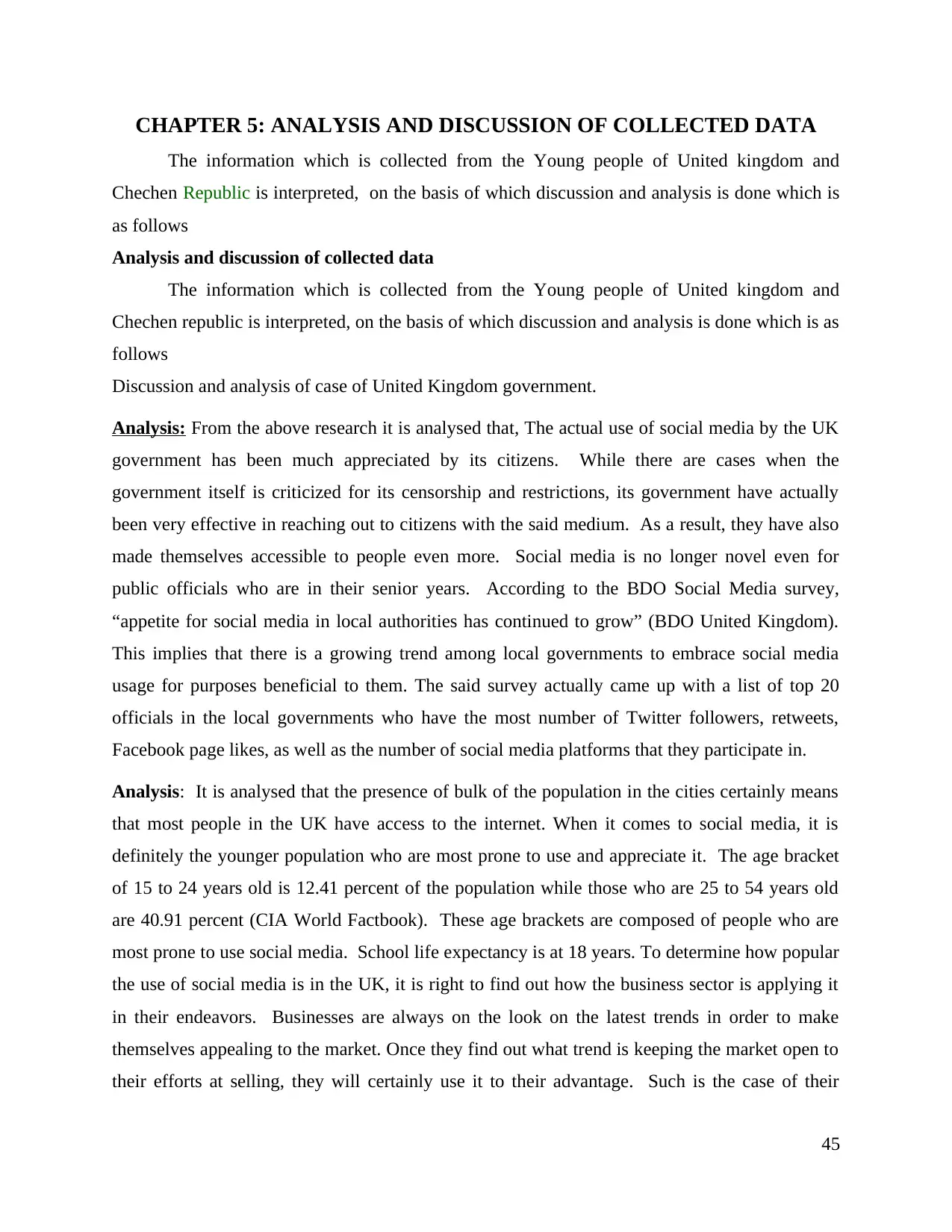
CHAPTER 5: ANALYSIS AND DISCUSSION OF COLLECTED DATA
The information which is collected from the Young people of United kingdom and
Chechen Republic is interpreted, on the basis of which discussion and analysis is done which is
as follows
Analysis and discussion of collected data
The information which is collected from the Young people of United kingdom and
Chechen republic is interpreted, on the basis of which discussion and analysis is done which is as
follows
Discussion and analysis of case of United Kingdom government.
Analysis: From the above research it is analysed that, The actual use of social media by the UK
government has been much appreciated by its citizens. While there are cases when the
government itself is criticized for its censorship and restrictions, its government have actually
been very effective in reaching out to citizens with the said medium. As a result, they have also
made themselves accessible to people even more. Social media is no longer novel even for
public officials who are in their senior years. According to the BDO Social Media survey,
“appetite for social media in local authorities has continued to grow” (BDO United Kingdom).
This implies that there is a growing trend among local governments to embrace social media
usage for purposes beneficial to them. The said survey actually came up with a list of top 20
officials in the local governments who have the most number of Twitter followers, retweets,
Facebook page likes, as well as the number of social media platforms that they participate in.
Analysis: It is analysed that the presence of bulk of the population in the cities certainly means
that most people in the UK have access to the internet. When it comes to social media, it is
definitely the younger population who are most prone to use and appreciate it. The age bracket
of 15 to 24 years old is 12.41 percent of the population while those who are 25 to 54 years old
are 40.91 percent (CIA World Factbook). These age brackets are composed of people who are
most prone to use social media. School life expectancy is at 18 years. To determine how popular
the use of social media is in the UK, it is right to find out how the business sector is applying it
in their endeavors. Businesses are always on the look on the latest trends in order to make
themselves appealing to the market. Once they find out what trend is keeping the market open to
their efforts at selling, they will certainly use it to their advantage. Such is the case of their
45
The information which is collected from the Young people of United kingdom and
Chechen Republic is interpreted, on the basis of which discussion and analysis is done which is
as follows
Analysis and discussion of collected data
The information which is collected from the Young people of United kingdom and
Chechen republic is interpreted, on the basis of which discussion and analysis is done which is as
follows
Discussion and analysis of case of United Kingdom government.
Analysis: From the above research it is analysed that, The actual use of social media by the UK
government has been much appreciated by its citizens. While there are cases when the
government itself is criticized for its censorship and restrictions, its government have actually
been very effective in reaching out to citizens with the said medium. As a result, they have also
made themselves accessible to people even more. Social media is no longer novel even for
public officials who are in their senior years. According to the BDO Social Media survey,
“appetite for social media in local authorities has continued to grow” (BDO United Kingdom).
This implies that there is a growing trend among local governments to embrace social media
usage for purposes beneficial to them. The said survey actually came up with a list of top 20
officials in the local governments who have the most number of Twitter followers, retweets,
Facebook page likes, as well as the number of social media platforms that they participate in.
Analysis: It is analysed that the presence of bulk of the population in the cities certainly means
that most people in the UK have access to the internet. When it comes to social media, it is
definitely the younger population who are most prone to use and appreciate it. The age bracket
of 15 to 24 years old is 12.41 percent of the population while those who are 25 to 54 years old
are 40.91 percent (CIA World Factbook). These age brackets are composed of people who are
most prone to use social media. School life expectancy is at 18 years. To determine how popular
the use of social media is in the UK, it is right to find out how the business sector is applying it
in their endeavors. Businesses are always on the look on the latest trends in order to make
themselves appealing to the market. Once they find out what trend is keeping the market open to
their efforts at selling, they will certainly use it to their advantage. Such is the case of their
45
Paraphrase This Document
Need a fresh take? Get an instant paraphrase of this document with our AI Paraphraser
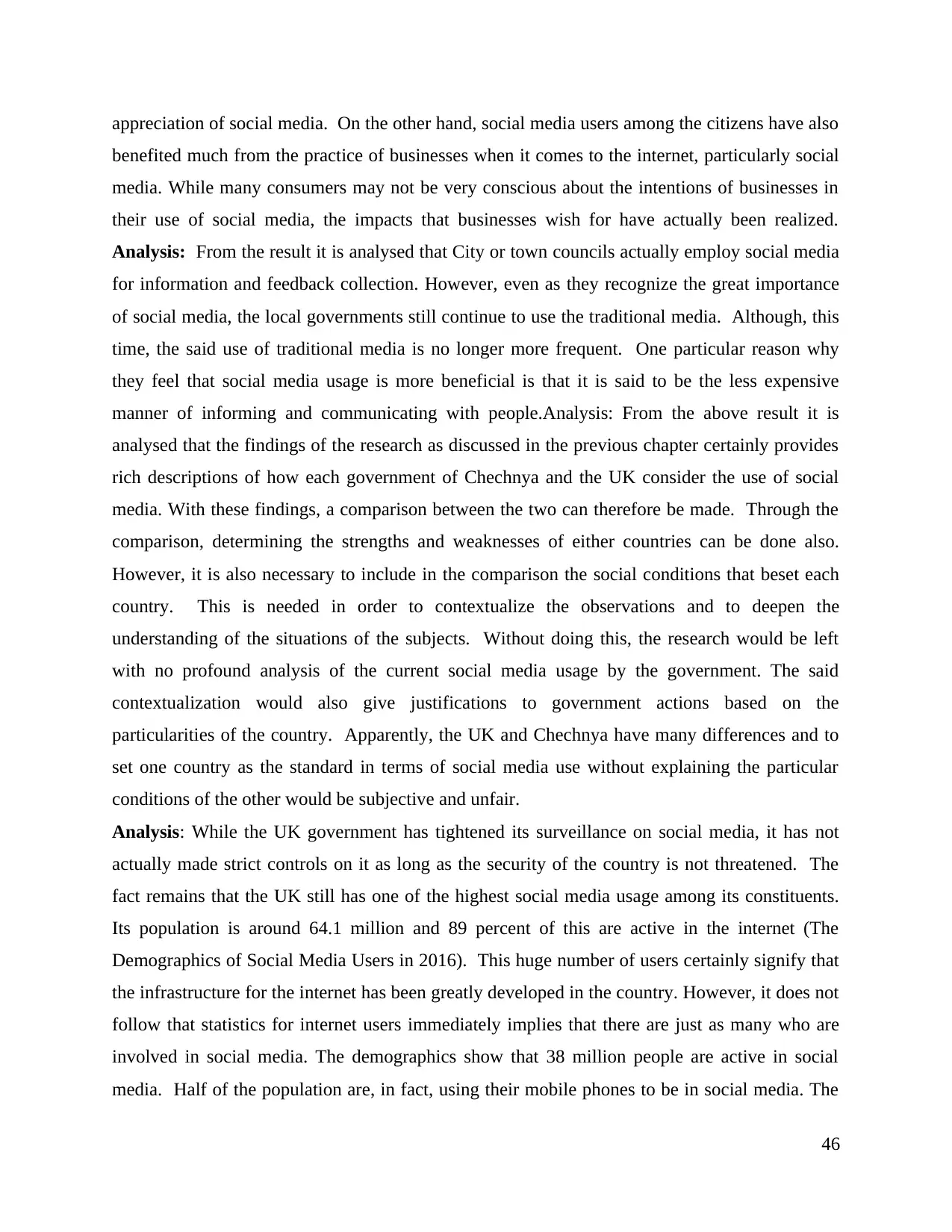
appreciation of social media. On the other hand, social media users among the citizens have also
benefited much from the practice of businesses when it comes to the internet, particularly social
media. While many consumers may not be very conscious about the intentions of businesses in
their use of social media, the impacts that businesses wish for have actually been realized.
Analysis: From the result it is analysed that City or town councils actually employ social media
for information and feedback collection. However, even as they recognize the great importance
of social media, the local governments still continue to use the traditional media. Although, this
time, the said use of traditional media is no longer more frequent. One particular reason why
they feel that social media usage is more beneficial is that it is said to be the less expensive
manner of informing and communicating with people.Analysis: From the above result it is
analysed that the findings of the research as discussed in the previous chapter certainly provides
rich descriptions of how each government of Chechnya and the UK consider the use of social
media. With these findings, a comparison between the two can therefore be made. Through the
comparison, determining the strengths and weaknesses of either countries can be done also.
However, it is also necessary to include in the comparison the social conditions that beset each
country. This is needed in order to contextualize the observations and to deepen the
understanding of the situations of the subjects. Without doing this, the research would be left
with no profound analysis of the current social media usage by the government. The said
contextualization would also give justifications to government actions based on the
particularities of the country. Apparently, the UK and Chechnya have many differences and to
set one country as the standard in terms of social media use without explaining the particular
conditions of the other would be subjective and unfair.
Analysis: While the UK government has tightened its surveillance on social media, it has not
actually made strict controls on it as long as the security of the country is not threatened. The
fact remains that the UK still has one of the highest social media usage among its constituents.
Its population is around 64.1 million and 89 percent of this are active in the internet (The
Demographics of Social Media Users in 2016). This huge number of users certainly signify that
the infrastructure for the internet has been greatly developed in the country. However, it does not
follow that statistics for internet users immediately implies that there are just as many who are
involved in social media. The demographics show that 38 million people are active in social
media. Half of the population are, in fact, using their mobile phones to be in social media. The
46
benefited much from the practice of businesses when it comes to the internet, particularly social
media. While many consumers may not be very conscious about the intentions of businesses in
their use of social media, the impacts that businesses wish for have actually been realized.
Analysis: From the result it is analysed that City or town councils actually employ social media
for information and feedback collection. However, even as they recognize the great importance
of social media, the local governments still continue to use the traditional media. Although, this
time, the said use of traditional media is no longer more frequent. One particular reason why
they feel that social media usage is more beneficial is that it is said to be the less expensive
manner of informing and communicating with people.Analysis: From the above result it is
analysed that the findings of the research as discussed in the previous chapter certainly provides
rich descriptions of how each government of Chechnya and the UK consider the use of social
media. With these findings, a comparison between the two can therefore be made. Through the
comparison, determining the strengths and weaknesses of either countries can be done also.
However, it is also necessary to include in the comparison the social conditions that beset each
country. This is needed in order to contextualize the observations and to deepen the
understanding of the situations of the subjects. Without doing this, the research would be left
with no profound analysis of the current social media usage by the government. The said
contextualization would also give justifications to government actions based on the
particularities of the country. Apparently, the UK and Chechnya have many differences and to
set one country as the standard in terms of social media use without explaining the particular
conditions of the other would be subjective and unfair.
Analysis: While the UK government has tightened its surveillance on social media, it has not
actually made strict controls on it as long as the security of the country is not threatened. The
fact remains that the UK still has one of the highest social media usage among its constituents.
Its population is around 64.1 million and 89 percent of this are active in the internet (The
Demographics of Social Media Users in 2016). This huge number of users certainly signify that
the infrastructure for the internet has been greatly developed in the country. However, it does not
follow that statistics for internet users immediately implies that there are just as many who are
involved in social media. The demographics show that 38 million people are active in social
media. Half of the population are, in fact, using their mobile phones to be in social media. The
46
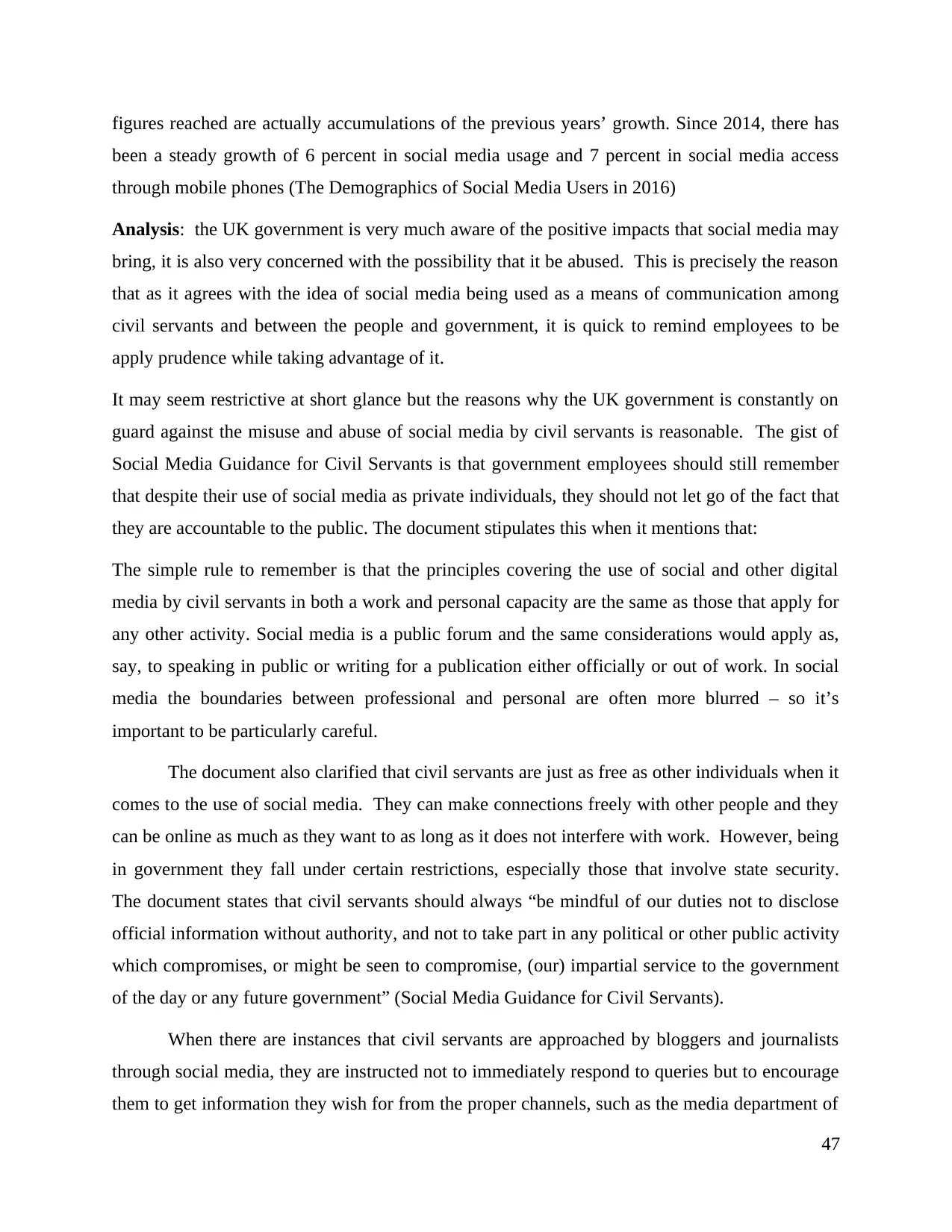
figures reached are actually accumulations of the previous years’ growth. Since 2014, there has
been a steady growth of 6 percent in social media usage and 7 percent in social media access
through mobile phones (The Demographics of Social Media Users in 2016)
Analysis: the UK government is very much aware of the positive impacts that social media may
bring, it is also very concerned with the possibility that it be abused. This is precisely the reason
that as it agrees with the idea of social media being used as a means of communication among
civil servants and between the people and government, it is quick to remind employees to be
apply prudence while taking advantage of it.
It may seem restrictive at short glance but the reasons why the UK government is constantly on
guard against the misuse and abuse of social media by civil servants is reasonable. The gist of
Social Media Guidance for Civil Servants is that government employees should still remember
that despite their use of social media as private individuals, they should not let go of the fact that
they are accountable to the public. The document stipulates this when it mentions that:
The simple rule to remember is that the principles covering the use of social and other digital
media by civil servants in both a work and personal capacity are the same as those that apply for
any other activity. Social media is a public forum and the same considerations would apply as,
say, to speaking in public or writing for a publication either officially or out of work. In social
media the boundaries between professional and personal are often more blurred – so it’s
important to be particularly careful.
The document also clarified that civil servants are just as free as other individuals when it
comes to the use of social media. They can make connections freely with other people and they
can be online as much as they want to as long as it does not interfere with work. However, being
in government they fall under certain restrictions, especially those that involve state security.
The document states that civil servants should always “be mindful of our duties not to disclose
official information without authority, and not to take part in any political or other public activity
which compromises, or might be seen to compromise, (our) impartial service to the government
of the day or any future government” (Social Media Guidance for Civil Servants).
When there are instances that civil servants are approached by bloggers and journalists
through social media, they are instructed not to immediately respond to queries but to encourage
them to get information they wish for from the proper channels, such as the media department of
47
been a steady growth of 6 percent in social media usage and 7 percent in social media access
through mobile phones (The Demographics of Social Media Users in 2016)
Analysis: the UK government is very much aware of the positive impacts that social media may
bring, it is also very concerned with the possibility that it be abused. This is precisely the reason
that as it agrees with the idea of social media being used as a means of communication among
civil servants and between the people and government, it is quick to remind employees to be
apply prudence while taking advantage of it.
It may seem restrictive at short glance but the reasons why the UK government is constantly on
guard against the misuse and abuse of social media by civil servants is reasonable. The gist of
Social Media Guidance for Civil Servants is that government employees should still remember
that despite their use of social media as private individuals, they should not let go of the fact that
they are accountable to the public. The document stipulates this when it mentions that:
The simple rule to remember is that the principles covering the use of social and other digital
media by civil servants in both a work and personal capacity are the same as those that apply for
any other activity. Social media is a public forum and the same considerations would apply as,
say, to speaking in public or writing for a publication either officially or out of work. In social
media the boundaries between professional and personal are often more blurred – so it’s
important to be particularly careful.
The document also clarified that civil servants are just as free as other individuals when it
comes to the use of social media. They can make connections freely with other people and they
can be online as much as they want to as long as it does not interfere with work. However, being
in government they fall under certain restrictions, especially those that involve state security.
The document states that civil servants should always “be mindful of our duties not to disclose
official information without authority, and not to take part in any political or other public activity
which compromises, or might be seen to compromise, (our) impartial service to the government
of the day or any future government” (Social Media Guidance for Civil Servants).
When there are instances that civil servants are approached by bloggers and journalists
through social media, they are instructed not to immediately respond to queries but to encourage
them to get information they wish for from the proper channels, such as the media department of
47
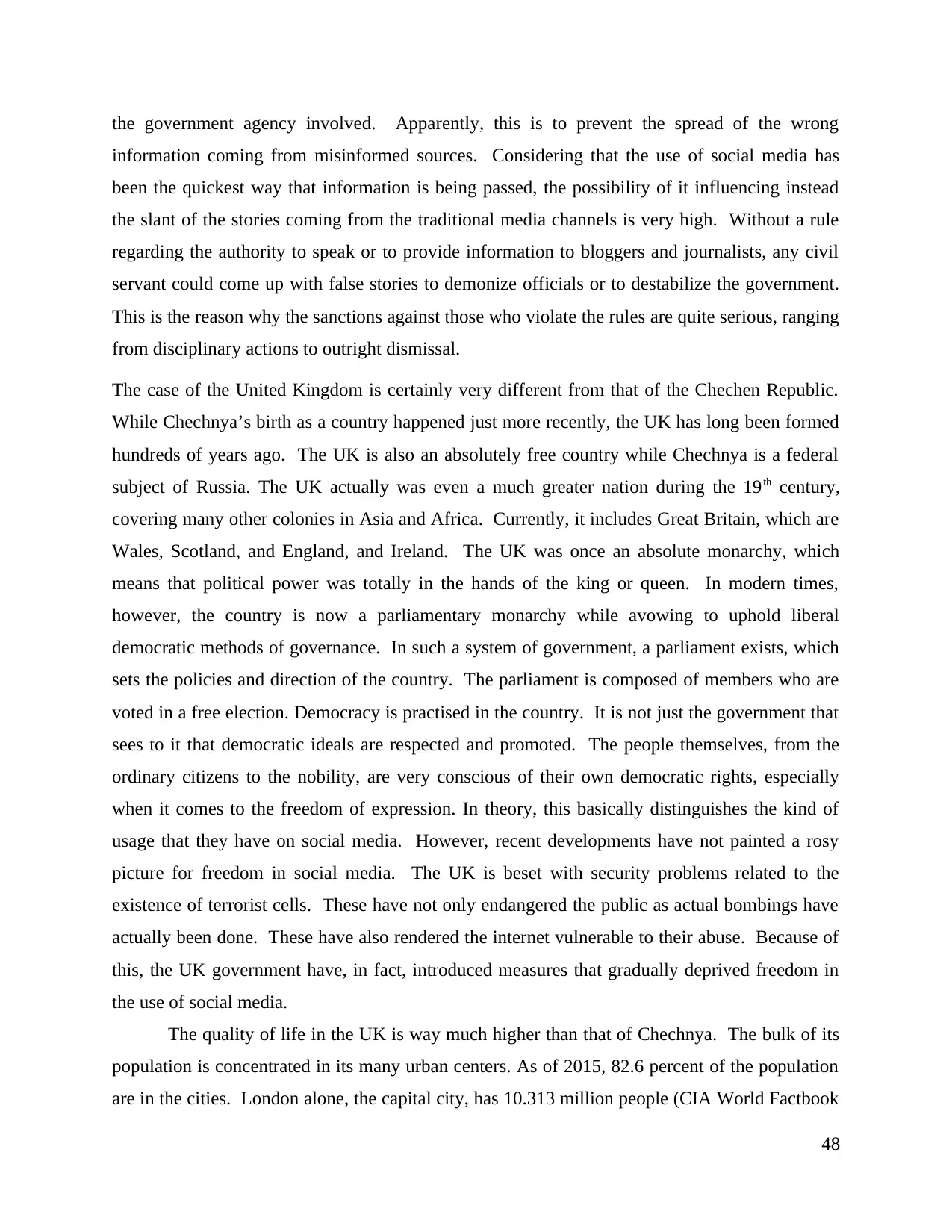
the government agency involved. Apparently, this is to prevent the spread of the wrong
information coming from misinformed sources. Considering that the use of social media has
been the quickest way that information is being passed, the possibility of it influencing instead
the slant of the stories coming from the traditional media channels is very high. Without a rule
regarding the authority to speak or to provide information to bloggers and journalists, any civil
servant could come up with false stories to demonize officials or to destabilize the government.
This is the reason why the sanctions against those who violate the rules are quite serious, ranging
from disciplinary actions to outright dismissal.
The case of the United Kingdom is certainly very different from that of the Chechen Republic.
While Chechnya’s birth as a country happened just more recently, the UK has long been formed
hundreds of years ago. The UK is also an absolutely free country while Chechnya is a federal
subject of Russia. The UK actually was even a much greater nation during the 19th century,
covering many other colonies in Asia and Africa. Currently, it includes Great Britain, which are
Wales, Scotland, and England, and Ireland. The UK was once an absolute monarchy, which
means that political power was totally in the hands of the king or queen. In modern times,
however, the country is now a parliamentary monarchy while avowing to uphold liberal
democratic methods of governance. In such a system of government, a parliament exists, which
sets the policies and direction of the country. The parliament is composed of members who are
voted in a free election. Democracy is practised in the country. It is not just the government that
sees to it that democratic ideals are respected and promoted. The people themselves, from the
ordinary citizens to the nobility, are very conscious of their own democratic rights, especially
when it comes to the freedom of expression. In theory, this basically distinguishes the kind of
usage that they have on social media. However, recent developments have not painted a rosy
picture for freedom in social media. The UK is beset with security problems related to the
existence of terrorist cells. These have not only endangered the public as actual bombings have
actually been done. These have also rendered the internet vulnerable to their abuse. Because of
this, the UK government have, in fact, introduced measures that gradually deprived freedom in
the use of social media.
The quality of life in the UK is way much higher than that of Chechnya. The bulk of its
population is concentrated in its many urban centers. As of 2015, 82.6 percent of the population
are in the cities. London alone, the capital city, has 10.313 million people (CIA World Factbook
48
information coming from misinformed sources. Considering that the use of social media has
been the quickest way that information is being passed, the possibility of it influencing instead
the slant of the stories coming from the traditional media channels is very high. Without a rule
regarding the authority to speak or to provide information to bloggers and journalists, any civil
servant could come up with false stories to demonize officials or to destabilize the government.
This is the reason why the sanctions against those who violate the rules are quite serious, ranging
from disciplinary actions to outright dismissal.
The case of the United Kingdom is certainly very different from that of the Chechen Republic.
While Chechnya’s birth as a country happened just more recently, the UK has long been formed
hundreds of years ago. The UK is also an absolutely free country while Chechnya is a federal
subject of Russia. The UK actually was even a much greater nation during the 19th century,
covering many other colonies in Asia and Africa. Currently, it includes Great Britain, which are
Wales, Scotland, and England, and Ireland. The UK was once an absolute monarchy, which
means that political power was totally in the hands of the king or queen. In modern times,
however, the country is now a parliamentary monarchy while avowing to uphold liberal
democratic methods of governance. In such a system of government, a parliament exists, which
sets the policies and direction of the country. The parliament is composed of members who are
voted in a free election. Democracy is practised in the country. It is not just the government that
sees to it that democratic ideals are respected and promoted. The people themselves, from the
ordinary citizens to the nobility, are very conscious of their own democratic rights, especially
when it comes to the freedom of expression. In theory, this basically distinguishes the kind of
usage that they have on social media. However, recent developments have not painted a rosy
picture for freedom in social media. The UK is beset with security problems related to the
existence of terrorist cells. These have not only endangered the public as actual bombings have
actually been done. These have also rendered the internet vulnerable to their abuse. Because of
this, the UK government have, in fact, introduced measures that gradually deprived freedom in
the use of social media.
The quality of life in the UK is way much higher than that of Chechnya. The bulk of its
population is concentrated in its many urban centers. As of 2015, 82.6 percent of the population
are in the cities. London alone, the capital city, has 10.313 million people (CIA World Factbook
48
Secure Best Marks with AI Grader
Need help grading? Try our AI Grader for instant feedback on your assignments.
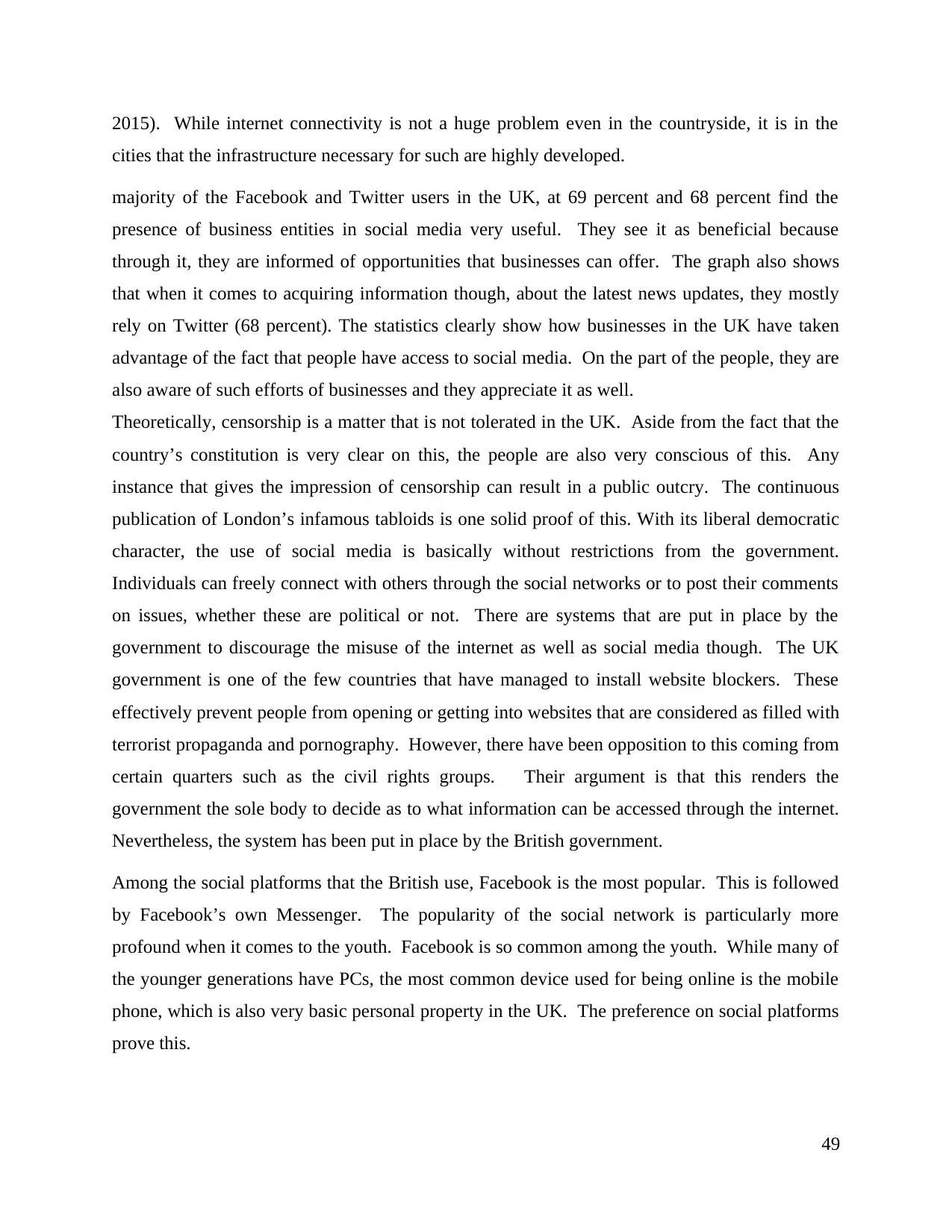
2015). While internet connectivity is not a huge problem even in the countryside, it is in the
cities that the infrastructure necessary for such are highly developed.
majority of the Facebook and Twitter users in the UK, at 69 percent and 68 percent find the
presence of business entities in social media very useful. They see it as beneficial because
through it, they are informed of opportunities that businesses can offer. The graph also shows
that when it comes to acquiring information though, about the latest news updates, they mostly
rely on Twitter (68 percent). The statistics clearly show how businesses in the UK have taken
advantage of the fact that people have access to social media. On the part of the people, they are
also aware of such efforts of businesses and they appreciate it as well.
Theoretically, censorship is a matter that is not tolerated in the UK. Aside from the fact that the
country’s constitution is very clear on this, the people are also very conscious of this. Any
instance that gives the impression of censorship can result in a public outcry. The continuous
publication of London’s infamous tabloids is one solid proof of this. With its liberal democratic
character, the use of social media is basically without restrictions from the government.
Individuals can freely connect with others through the social networks or to post their comments
on issues, whether these are political or not. There are systems that are put in place by the
government to discourage the misuse of the internet as well as social media though. The UK
government is one of the few countries that have managed to install website blockers. These
effectively prevent people from opening or getting into websites that are considered as filled with
terrorist propaganda and pornography. However, there have been opposition to this coming from
certain quarters such as the civil rights groups. Their argument is that this renders the
government the sole body to decide as to what information can be accessed through the internet.
Nevertheless, the system has been put in place by the British government.
Among the social platforms that the British use, Facebook is the most popular. This is followed
by Facebook’s own Messenger. The popularity of the social network is particularly more
profound when it comes to the youth. Facebook is so common among the youth. While many of
the younger generations have PCs, the most common device used for being online is the mobile
phone, which is also very basic personal property in the UK. The preference on social platforms
prove this.
49
cities that the infrastructure necessary for such are highly developed.
majority of the Facebook and Twitter users in the UK, at 69 percent and 68 percent find the
presence of business entities in social media very useful. They see it as beneficial because
through it, they are informed of opportunities that businesses can offer. The graph also shows
that when it comes to acquiring information though, about the latest news updates, they mostly
rely on Twitter (68 percent). The statistics clearly show how businesses in the UK have taken
advantage of the fact that people have access to social media. On the part of the people, they are
also aware of such efforts of businesses and they appreciate it as well.
Theoretically, censorship is a matter that is not tolerated in the UK. Aside from the fact that the
country’s constitution is very clear on this, the people are also very conscious of this. Any
instance that gives the impression of censorship can result in a public outcry. The continuous
publication of London’s infamous tabloids is one solid proof of this. With its liberal democratic
character, the use of social media is basically without restrictions from the government.
Individuals can freely connect with others through the social networks or to post their comments
on issues, whether these are political or not. There are systems that are put in place by the
government to discourage the misuse of the internet as well as social media though. The UK
government is one of the few countries that have managed to install website blockers. These
effectively prevent people from opening or getting into websites that are considered as filled with
terrorist propaganda and pornography. However, there have been opposition to this coming from
certain quarters such as the civil rights groups. Their argument is that this renders the
government the sole body to decide as to what information can be accessed through the internet.
Nevertheless, the system has been put in place by the British government.
Among the social platforms that the British use, Facebook is the most popular. This is followed
by Facebook’s own Messenger. The popularity of the social network is particularly more
profound when it comes to the youth. Facebook is so common among the youth. While many of
the younger generations have PCs, the most common device used for being online is the mobile
phone, which is also very basic personal property in the UK. The preference on social platforms
prove this.
49
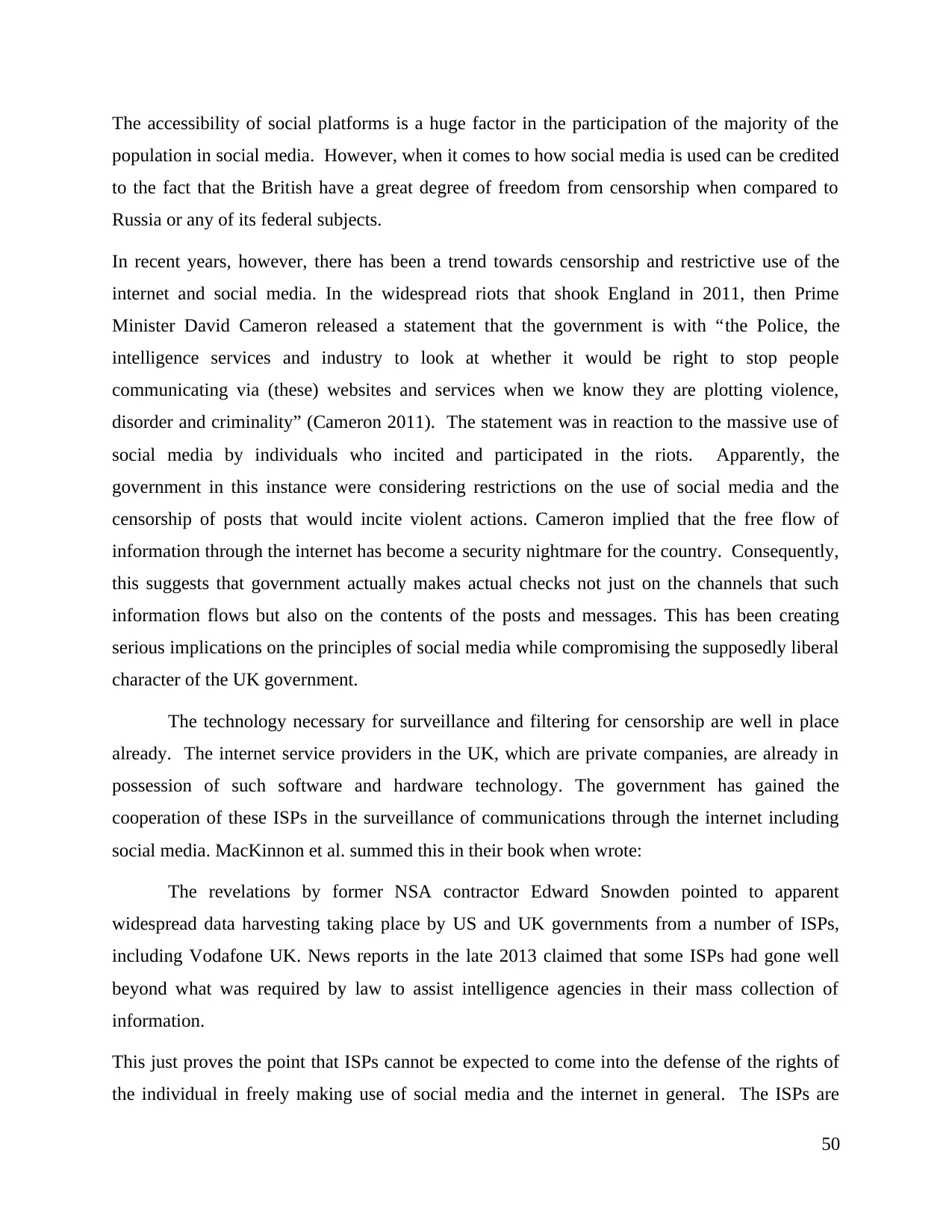
The accessibility of social platforms is a huge factor in the participation of the majority of the
population in social media. However, when it comes to how social media is used can be credited
to the fact that the British have a great degree of freedom from censorship when compared to
Russia or any of its federal subjects.
In recent years, however, there has been a trend towards censorship and restrictive use of the
internet and social media. In the widespread riots that shook England in 2011, then Prime
Minister David Cameron released a statement that the government is with “the Police, the
intelligence services and industry to look at whether it would be right to stop people
communicating via (these) websites and services when we know they are plotting violence,
disorder and criminality” (Cameron 2011). The statement was in reaction to the massive use of
social media by individuals who incited and participated in the riots. Apparently, the
government in this instance were considering restrictions on the use of social media and the
censorship of posts that would incite violent actions. Cameron implied that the free flow of
information through the internet has become a security nightmare for the country. Consequently,
this suggests that government actually makes actual checks not just on the channels that such
information flows but also on the contents of the posts and messages. This has been creating
serious implications on the principles of social media while compromising the supposedly liberal
character of the UK government.
The technology necessary for surveillance and filtering for censorship are well in place
already. The internet service providers in the UK, which are private companies, are already in
possession of such software and hardware technology. The government has gained the
cooperation of these ISPs in the surveillance of communications through the internet including
social media. MacKinnon et al. summed this in their book when wrote:
The revelations by former NSA contractor Edward Snowden pointed to apparent
widespread data harvesting taking place by US and UK governments from a number of ISPs,
including Vodafone UK. News reports in the late 2013 claimed that some ISPs had gone well
beyond what was required by law to assist intelligence agencies in their mass collection of
information.
This just proves the point that ISPs cannot be expected to come into the defense of the rights of
the individual in freely making use of social media and the internet in general. The ISPs are
50
population in social media. However, when it comes to how social media is used can be credited
to the fact that the British have a great degree of freedom from censorship when compared to
Russia or any of its federal subjects.
In recent years, however, there has been a trend towards censorship and restrictive use of the
internet and social media. In the widespread riots that shook England in 2011, then Prime
Minister David Cameron released a statement that the government is with “the Police, the
intelligence services and industry to look at whether it would be right to stop people
communicating via (these) websites and services when we know they are plotting violence,
disorder and criminality” (Cameron 2011). The statement was in reaction to the massive use of
social media by individuals who incited and participated in the riots. Apparently, the
government in this instance were considering restrictions on the use of social media and the
censorship of posts that would incite violent actions. Cameron implied that the free flow of
information through the internet has become a security nightmare for the country. Consequently,
this suggests that government actually makes actual checks not just on the channels that such
information flows but also on the contents of the posts and messages. This has been creating
serious implications on the principles of social media while compromising the supposedly liberal
character of the UK government.
The technology necessary for surveillance and filtering for censorship are well in place
already. The internet service providers in the UK, which are private companies, are already in
possession of such software and hardware technology. The government has gained the
cooperation of these ISPs in the surveillance of communications through the internet including
social media. MacKinnon et al. summed this in their book when wrote:
The revelations by former NSA contractor Edward Snowden pointed to apparent
widespread data harvesting taking place by US and UK governments from a number of ISPs,
including Vodafone UK. News reports in the late 2013 claimed that some ISPs had gone well
beyond what was required by law to assist intelligence agencies in their mass collection of
information.
This just proves the point that ISPs cannot be expected to come into the defense of the rights of
the individual in freely making use of social media and the internet in general. The ISPs are
50
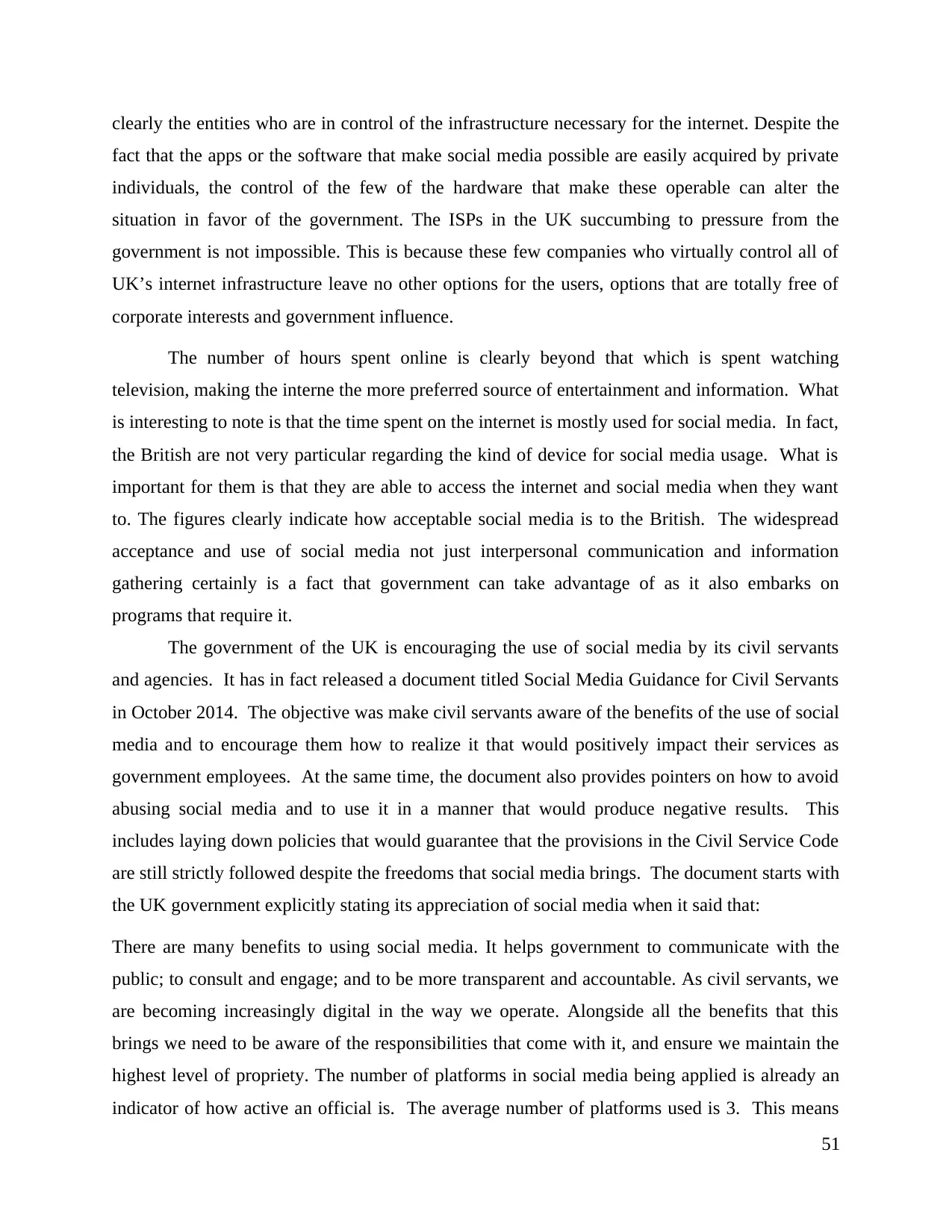
clearly the entities who are in control of the infrastructure necessary for the internet. Despite the
fact that the apps or the software that make social media possible are easily acquired by private
individuals, the control of the few of the hardware that make these operable can alter the
situation in favor of the government. The ISPs in the UK succumbing to pressure from the
government is not impossible. This is because these few companies who virtually control all of
UK’s internet infrastructure leave no other options for the users, options that are totally free of
corporate interests and government influence.
The number of hours spent online is clearly beyond that which is spent watching
television, making the interne the more preferred source of entertainment and information. What
is interesting to note is that the time spent on the internet is mostly used for social media. In fact,
the British are not very particular regarding the kind of device for social media usage. What is
important for them is that they are able to access the internet and social media when they want
to. The figures clearly indicate how acceptable social media is to the British. The widespread
acceptance and use of social media not just interpersonal communication and information
gathering certainly is a fact that government can take advantage of as it also embarks on
programs that require it.
The government of the UK is encouraging the use of social media by its civil servants
and agencies. It has in fact released a document titled Social Media Guidance for Civil Servants
in October 2014. The objective was make civil servants aware of the benefits of the use of social
media and to encourage them how to realize it that would positively impact their services as
government employees. At the same time, the document also provides pointers on how to avoid
abusing social media and to use it in a manner that would produce negative results. This
includes laying down policies that would guarantee that the provisions in the Civil Service Code
are still strictly followed despite the freedoms that social media brings. The document starts with
the UK government explicitly stating its appreciation of social media when it said that:
There are many benefits to using social media. It helps government to communicate with the
public; to consult and engage; and to be more transparent and accountable. As civil servants, we
are becoming increasingly digital in the way we operate. Alongside all the benefits that this
brings we need to be aware of the responsibilities that come with it, and ensure we maintain the
highest level of propriety. The number of platforms in social media being applied is already an
indicator of how active an official is. The average number of platforms used is 3. This means
51
fact that the apps or the software that make social media possible are easily acquired by private
individuals, the control of the few of the hardware that make these operable can alter the
situation in favor of the government. The ISPs in the UK succumbing to pressure from the
government is not impossible. This is because these few companies who virtually control all of
UK’s internet infrastructure leave no other options for the users, options that are totally free of
corporate interests and government influence.
The number of hours spent online is clearly beyond that which is spent watching
television, making the interne the more preferred source of entertainment and information. What
is interesting to note is that the time spent on the internet is mostly used for social media. In fact,
the British are not very particular regarding the kind of device for social media usage. What is
important for them is that they are able to access the internet and social media when they want
to. The figures clearly indicate how acceptable social media is to the British. The widespread
acceptance and use of social media not just interpersonal communication and information
gathering certainly is a fact that government can take advantage of as it also embarks on
programs that require it.
The government of the UK is encouraging the use of social media by its civil servants
and agencies. It has in fact released a document titled Social Media Guidance for Civil Servants
in October 2014. The objective was make civil servants aware of the benefits of the use of social
media and to encourage them how to realize it that would positively impact their services as
government employees. At the same time, the document also provides pointers on how to avoid
abusing social media and to use it in a manner that would produce negative results. This
includes laying down policies that would guarantee that the provisions in the Civil Service Code
are still strictly followed despite the freedoms that social media brings. The document starts with
the UK government explicitly stating its appreciation of social media when it said that:
There are many benefits to using social media. It helps government to communicate with the
public; to consult and engage; and to be more transparent and accountable. As civil servants, we
are becoming increasingly digital in the way we operate. Alongside all the benefits that this
brings we need to be aware of the responsibilities that come with it, and ensure we maintain the
highest level of propriety. The number of platforms in social media being applied is already an
indicator of how active an official is. The average number of platforms used is 3. This means
51
Paraphrase This Document
Need a fresh take? Get an instant paraphrase of this document with our AI Paraphraser
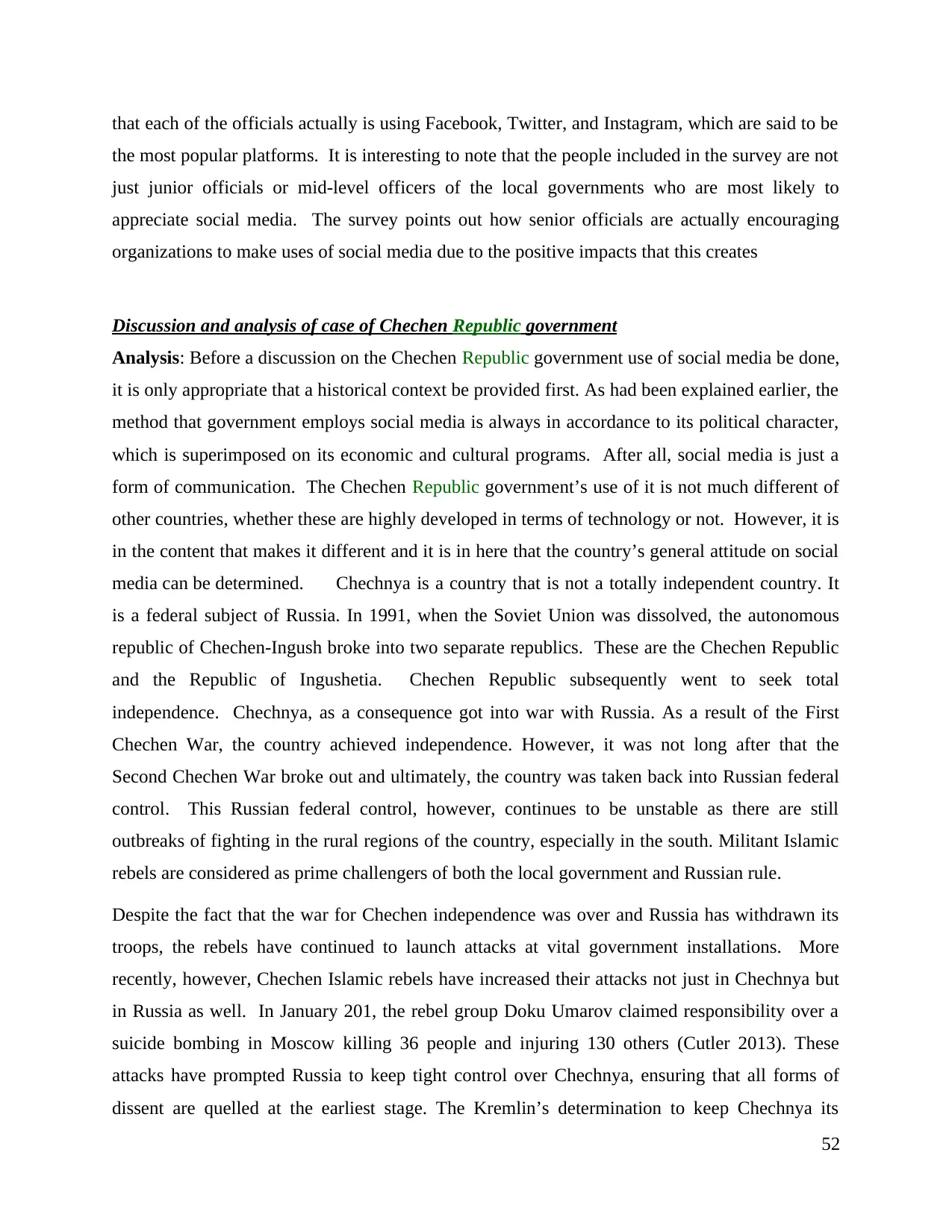
that each of the officials actually is using Facebook, Twitter, and Instagram, which are said to be
the most popular platforms. It is interesting to note that the people included in the survey are not
just junior officials or mid-level officers of the local governments who are most likely to
appreciate social media. The survey points out how senior officials are actually encouraging
organizations to make uses of social media due to the positive impacts that this creates
Discussion and analysis of case of Chechen Republic government
Analysis: Before a discussion on the Chechen Republic government use of social media be done,
it is only appropriate that a historical context be provided first. As had been explained earlier, the
method that government employs social media is always in accordance to its political character,
which is superimposed on its economic and cultural programs. After all, social media is just a
form of communication. The Chechen Republic government’s use of it is not much different of
other countries, whether these are highly developed in terms of technology or not. However, it is
in the content that makes it different and it is in here that the country’s general attitude on social
media can be determined. Chechnya is a country that is not a totally independent country. It
is a federal subject of Russia. In 1991, when the Soviet Union was dissolved, the autonomous
republic of Chechen-Ingush broke into two separate republics. These are the Chechen Republic
and the Republic of Ingushetia. Chechen Republic subsequently went to seek total
independence. Chechnya, as a consequence got into war with Russia. As a result of the First
Chechen War, the country achieved independence. However, it was not long after that the
Second Chechen War broke out and ultimately, the country was taken back into Russian federal
control. This Russian federal control, however, continues to be unstable as there are still
outbreaks of fighting in the rural regions of the country, especially in the south. Militant Islamic
rebels are considered as prime challengers of both the local government and Russian rule.
Despite the fact that the war for Chechen independence was over and Russia has withdrawn its
troops, the rebels have continued to launch attacks at vital government installations. More
recently, however, Chechen Islamic rebels have increased their attacks not just in Chechnya but
in Russia as well. In January 201, the rebel group Doku Umarov claimed responsibility over a
suicide bombing in Moscow killing 36 people and injuring 130 others (Cutler 2013). These
attacks have prompted Russia to keep tight control over Chechnya, ensuring that all forms of
dissent are quelled at the earliest stage. The Kremlin’s determination to keep Chechnya its
52
the most popular platforms. It is interesting to note that the people included in the survey are not
just junior officials or mid-level officers of the local governments who are most likely to
appreciate social media. The survey points out how senior officials are actually encouraging
organizations to make uses of social media due to the positive impacts that this creates
Discussion and analysis of case of Chechen Republic government
Analysis: Before a discussion on the Chechen Republic government use of social media be done,
it is only appropriate that a historical context be provided first. As had been explained earlier, the
method that government employs social media is always in accordance to its political character,
which is superimposed on its economic and cultural programs. After all, social media is just a
form of communication. The Chechen Republic government’s use of it is not much different of
other countries, whether these are highly developed in terms of technology or not. However, it is
in the content that makes it different and it is in here that the country’s general attitude on social
media can be determined. Chechnya is a country that is not a totally independent country. It
is a federal subject of Russia. In 1991, when the Soviet Union was dissolved, the autonomous
republic of Chechen-Ingush broke into two separate republics. These are the Chechen Republic
and the Republic of Ingushetia. Chechen Republic subsequently went to seek total
independence. Chechnya, as a consequence got into war with Russia. As a result of the First
Chechen War, the country achieved independence. However, it was not long after that the
Second Chechen War broke out and ultimately, the country was taken back into Russian federal
control. This Russian federal control, however, continues to be unstable as there are still
outbreaks of fighting in the rural regions of the country, especially in the south. Militant Islamic
rebels are considered as prime challengers of both the local government and Russian rule.
Despite the fact that the war for Chechen independence was over and Russia has withdrawn its
troops, the rebels have continued to launch attacks at vital government installations. More
recently, however, Chechen Islamic rebels have increased their attacks not just in Chechnya but
in Russia as well. In January 201, the rebel group Doku Umarov claimed responsibility over a
suicide bombing in Moscow killing 36 people and injuring 130 others (Cutler 2013). These
attacks have prompted Russia to keep tight control over Chechnya, ensuring that all forms of
dissent are quelled at the earliest stage. The Kremlin’s determination to keep Chechnya its
52
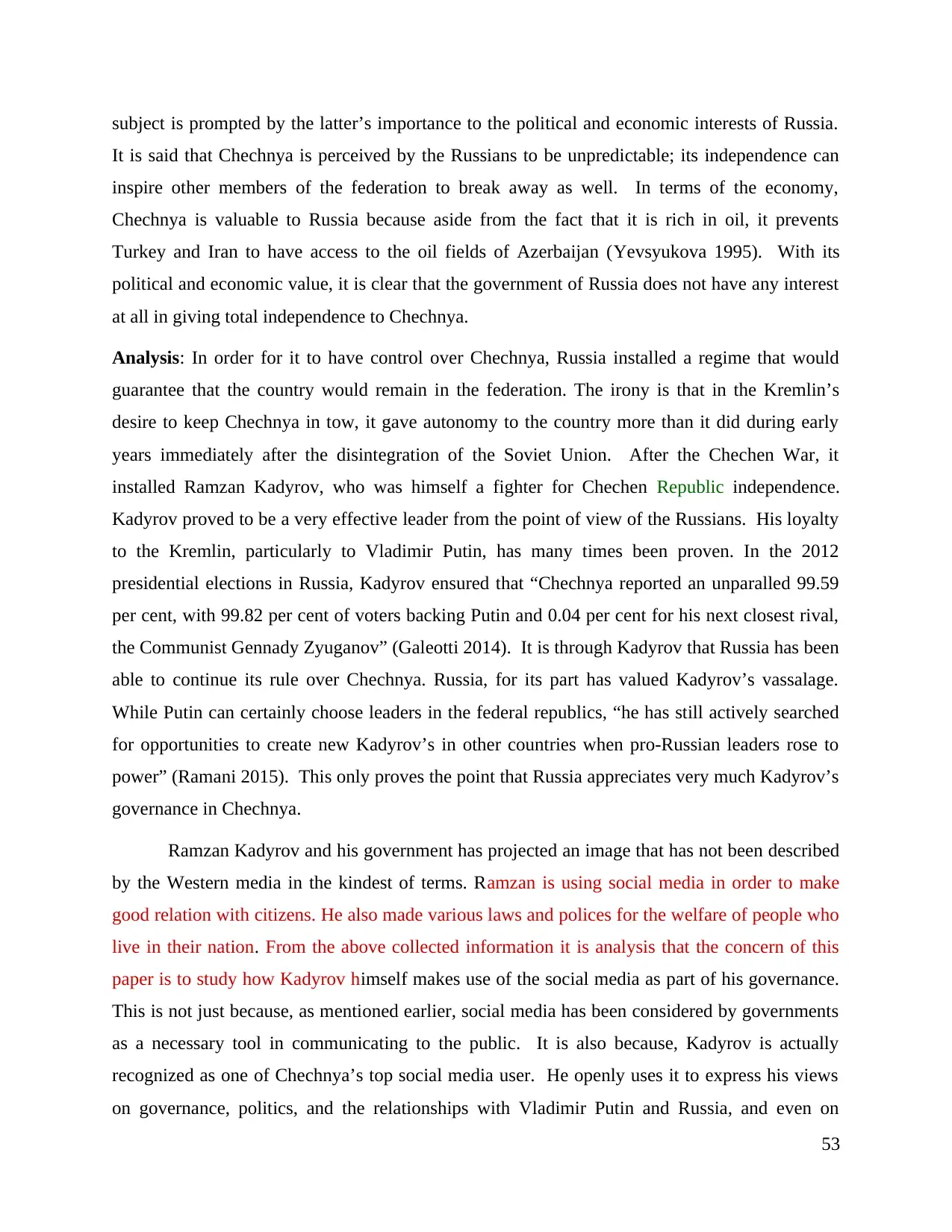
subject is prompted by the latter’s importance to the political and economic interests of Russia.
It is said that Chechnya is perceived by the Russians to be unpredictable; its independence can
inspire other members of the federation to break away as well. In terms of the economy,
Chechnya is valuable to Russia because aside from the fact that it is rich in oil, it prevents
Turkey and Iran to have access to the oil fields of Azerbaijan (Yevsyukova 1995). With its
political and economic value, it is clear that the government of Russia does not have any interest
at all in giving total independence to Chechnya.
Analysis: In order for it to have control over Chechnya, Russia installed a regime that would
guarantee that the country would remain in the federation. The irony is that in the Kremlin’s
desire to keep Chechnya in tow, it gave autonomy to the country more than it did during early
years immediately after the disintegration of the Soviet Union. After the Chechen War, it
installed Ramzan Kadyrov, who was himself a fighter for Chechen Republic independence.
Kadyrov proved to be a very effective leader from the point of view of the Russians. His loyalty
to the Kremlin, particularly to Vladimir Putin, has many times been proven. In the 2012
presidential elections in Russia, Kadyrov ensured that “Chechnya reported an unparalled 99.59
per cent, with 99.82 per cent of voters backing Putin and 0.04 per cent for his next closest rival,
the Communist Gennady Zyuganov” (Galeotti 2014). It is through Kadyrov that Russia has been
able to continue its rule over Chechnya. Russia, for its part has valued Kadyrov’s vassalage.
While Putin can certainly choose leaders in the federal republics, “he has still actively searched
for opportunities to create new Kadyrov’s in other countries when pro-Russian leaders rose to
power” (Ramani 2015). This only proves the point that Russia appreciates very much Kadyrov’s
governance in Chechnya.
Ramzan Kadyrov and his government has projected an image that has not been described
by the Western media in the kindest of terms. Ramzan is using social media in order to make
good relation with citizens. He also made various laws and polices for the welfare of people who
live in their nation. From the above collected information it is analysis that the concern of this
paper is to study how Kadyrov himself makes use of the social media as part of his governance.
This is not just because, as mentioned earlier, social media has been considered by governments
as a necessary tool in communicating to the public. It is also because, Kadyrov is actually
recognized as one of Chechnya’s top social media user. He openly uses it to express his views
on governance, politics, and the relationships with Vladimir Putin and Russia, and even on
53
It is said that Chechnya is perceived by the Russians to be unpredictable; its independence can
inspire other members of the federation to break away as well. In terms of the economy,
Chechnya is valuable to Russia because aside from the fact that it is rich in oil, it prevents
Turkey and Iran to have access to the oil fields of Azerbaijan (Yevsyukova 1995). With its
political and economic value, it is clear that the government of Russia does not have any interest
at all in giving total independence to Chechnya.
Analysis: In order for it to have control over Chechnya, Russia installed a regime that would
guarantee that the country would remain in the federation. The irony is that in the Kremlin’s
desire to keep Chechnya in tow, it gave autonomy to the country more than it did during early
years immediately after the disintegration of the Soviet Union. After the Chechen War, it
installed Ramzan Kadyrov, who was himself a fighter for Chechen Republic independence.
Kadyrov proved to be a very effective leader from the point of view of the Russians. His loyalty
to the Kremlin, particularly to Vladimir Putin, has many times been proven. In the 2012
presidential elections in Russia, Kadyrov ensured that “Chechnya reported an unparalled 99.59
per cent, with 99.82 per cent of voters backing Putin and 0.04 per cent for his next closest rival,
the Communist Gennady Zyuganov” (Galeotti 2014). It is through Kadyrov that Russia has been
able to continue its rule over Chechnya. Russia, for its part has valued Kadyrov’s vassalage.
While Putin can certainly choose leaders in the federal republics, “he has still actively searched
for opportunities to create new Kadyrov’s in other countries when pro-Russian leaders rose to
power” (Ramani 2015). This only proves the point that Russia appreciates very much Kadyrov’s
governance in Chechnya.
Ramzan Kadyrov and his government has projected an image that has not been described
by the Western media in the kindest of terms. Ramzan is using social media in order to make
good relation with citizens. He also made various laws and polices for the welfare of people who
live in their nation. From the above collected information it is analysis that the concern of this
paper is to study how Kadyrov himself makes use of the social media as part of his governance.
This is not just because, as mentioned earlier, social media has been considered by governments
as a necessary tool in communicating to the public. It is also because, Kadyrov is actually
recognized as one of Chechnya’s top social media user. He openly uses it to express his views
on governance, politics, and the relationships with Vladimir Putin and Russia, and even on
53
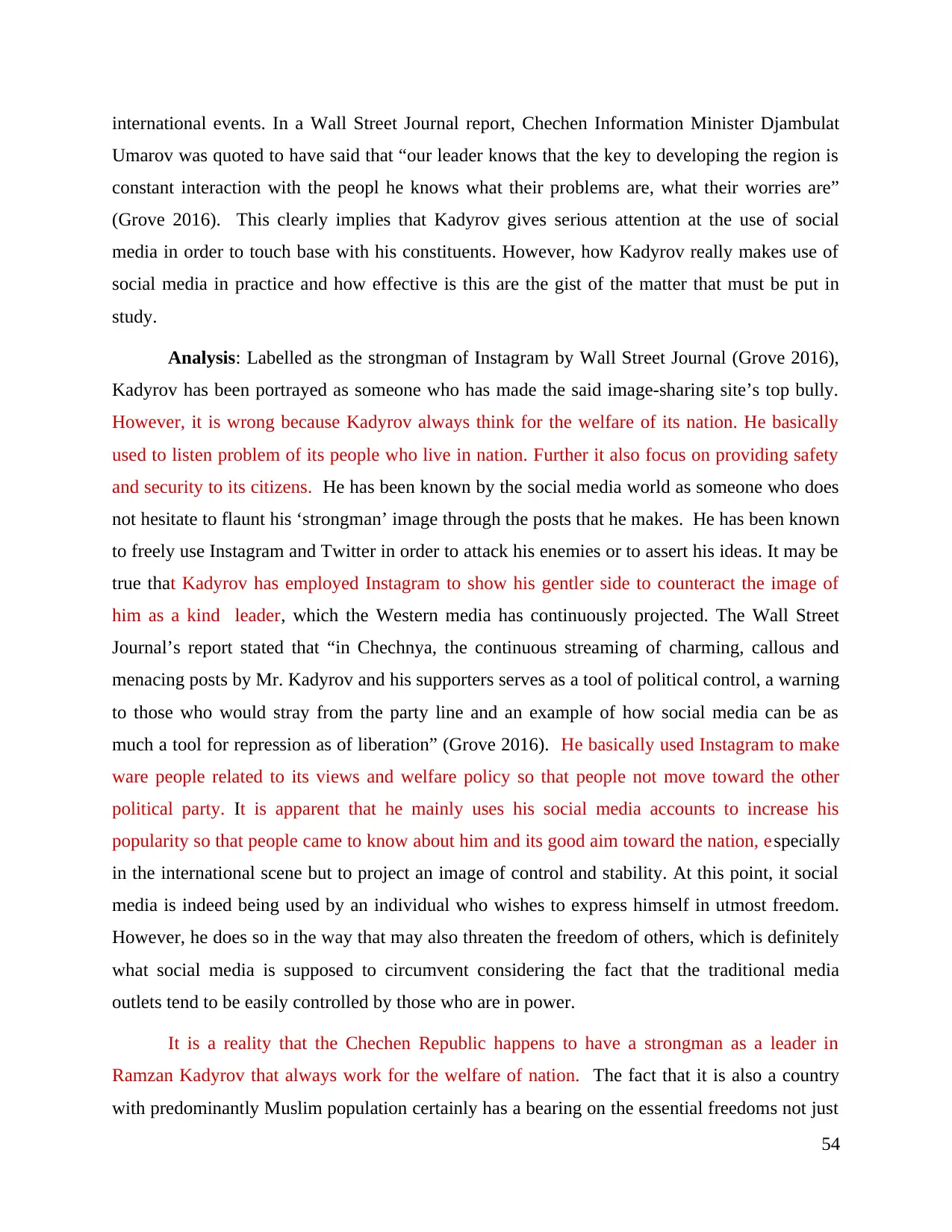
international events. In a Wall Street Journal report, Chechen Information Minister Djambulat
Umarov was quoted to have said that “our leader knows that the key to developing the region is
constant interaction with the peopl he knows what their problems are, what their worries are”
(Grove 2016). This clearly implies that Kadyrov gives serious attention at the use of social
media in order to touch base with his constituents. However, how Kadyrov really makes use of
social media in practice and how effective is this are the gist of the matter that must be put in
study.
Analysis: Labelled as the strongman of Instagram by Wall Street Journal (Grove 2016),
Kadyrov has been portrayed as someone who has made the said image-sharing site’s top bully.
However, it is wrong because Kadyrov always think for the welfare of its nation. He basically
used to listen problem of its people who live in nation. Further it also focus on providing safety
and security to its citizens. He has been known by the social media world as someone who does
not hesitate to flaunt his ‘strongman’ image through the posts that he makes. He has been known
to freely use Instagram and Twitter in order to attack his enemies or to assert his ideas. It may be
true that Kadyrov has employed Instagram to show his gentler side to counteract the image of
him as a kind leader, which the Western media has continuously projected. The Wall Street
Journal’s report stated that “in Chechnya, the continuous streaming of charming, callous and
menacing posts by Mr. Kadyrov and his supporters serves as a tool of political control, a warning
to those who would stray from the party line and an example of how social media can be as
much a tool for repression as of liberation” (Grove 2016). He basically used Instagram to make
ware people related to its views and welfare policy so that people not move toward the other
political party. It is apparent that he mainly uses his social media accounts to increase his
popularity so that people came to know about him and its good aim toward the nation, e specially
in the international scene but to project an image of control and stability. At this point, it social
media is indeed being used by an individual who wishes to express himself in utmost freedom.
However, he does so in the way that may also threaten the freedom of others, which is definitely
what social media is supposed to circumvent considering the fact that the traditional media
outlets tend to be easily controlled by those who are in power.
It is a reality that the Chechen Republic happens to have a strongman as a leader in
Ramzan Kadyrov that always work for the welfare of nation. The fact that it is also a country
with predominantly Muslim population certainly has a bearing on the essential freedoms not just
54
Umarov was quoted to have said that “our leader knows that the key to developing the region is
constant interaction with the peopl he knows what their problems are, what their worries are”
(Grove 2016). This clearly implies that Kadyrov gives serious attention at the use of social
media in order to touch base with his constituents. However, how Kadyrov really makes use of
social media in practice and how effective is this are the gist of the matter that must be put in
study.
Analysis: Labelled as the strongman of Instagram by Wall Street Journal (Grove 2016),
Kadyrov has been portrayed as someone who has made the said image-sharing site’s top bully.
However, it is wrong because Kadyrov always think for the welfare of its nation. He basically
used to listen problem of its people who live in nation. Further it also focus on providing safety
and security to its citizens. He has been known by the social media world as someone who does
not hesitate to flaunt his ‘strongman’ image through the posts that he makes. He has been known
to freely use Instagram and Twitter in order to attack his enemies or to assert his ideas. It may be
true that Kadyrov has employed Instagram to show his gentler side to counteract the image of
him as a kind leader, which the Western media has continuously projected. The Wall Street
Journal’s report stated that “in Chechnya, the continuous streaming of charming, callous and
menacing posts by Mr. Kadyrov and his supporters serves as a tool of political control, a warning
to those who would stray from the party line and an example of how social media can be as
much a tool for repression as of liberation” (Grove 2016). He basically used Instagram to make
ware people related to its views and welfare policy so that people not move toward the other
political party. It is apparent that he mainly uses his social media accounts to increase his
popularity so that people came to know about him and its good aim toward the nation, e specially
in the international scene but to project an image of control and stability. At this point, it social
media is indeed being used by an individual who wishes to express himself in utmost freedom.
However, he does so in the way that may also threaten the freedom of others, which is definitely
what social media is supposed to circumvent considering the fact that the traditional media
outlets tend to be easily controlled by those who are in power.
It is a reality that the Chechen Republic happens to have a strongman as a leader in
Ramzan Kadyrov that always work for the welfare of nation. The fact that it is also a country
with predominantly Muslim population certainly has a bearing on the essential freedoms not just
54
Secure Best Marks with AI Grader
Need help grading? Try our AI Grader for instant feedback on your assignments.
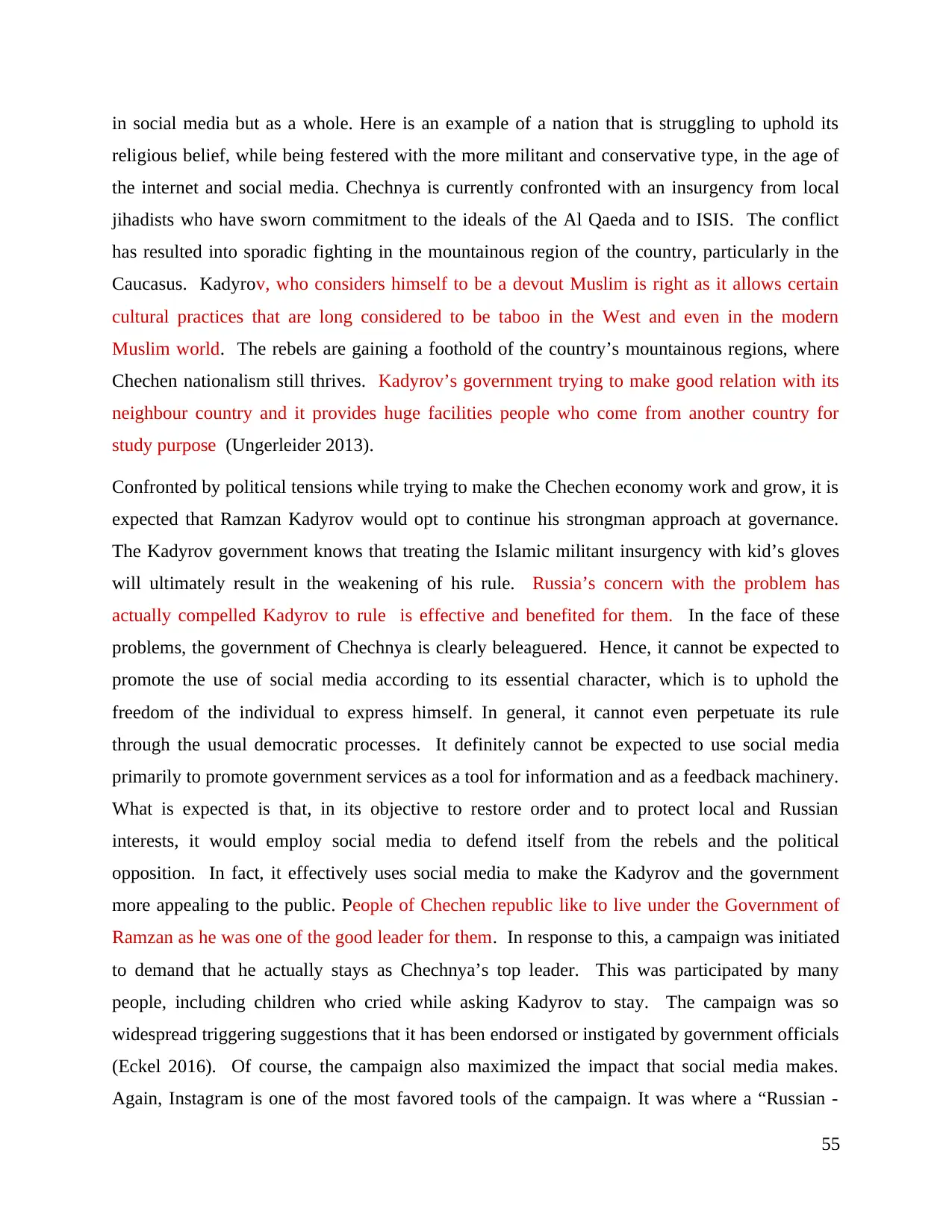
in social media but as a whole. Here is an example of a nation that is struggling to uphold its
religious belief, while being festered with the more militant and conservative type, in the age of
the internet and social media. Chechnya is currently confronted with an insurgency from local
jihadists who have sworn commitment to the ideals of the Al Qaeda and to ISIS. The conflict
has resulted into sporadic fighting in the mountainous region of the country, particularly in the
Caucasus. Kadyrov, who considers himself to be a devout Muslim is right as it allows certain
cultural practices that are long considered to be taboo in the West and even in the modern
Muslim world. The rebels are gaining a foothold of the country’s mountainous regions, where
Chechen nationalism still thrives. Kadyrov’s government trying to make good relation with its
neighbour country and it provides huge facilities people who come from another country for
study purpose (Ungerleider 2013).
Confronted by political tensions while trying to make the Chechen economy work and grow, it is
expected that Ramzan Kadyrov would opt to continue his strongman approach at governance.
The Kadyrov government knows that treating the Islamic militant insurgency with kid’s gloves
will ultimately result in the weakening of his rule. Russia’s concern with the problem has
actually compelled Kadyrov to rule is effective and benefited for them. In the face of these
problems, the government of Chechnya is clearly beleaguered. Hence, it cannot be expected to
promote the use of social media according to its essential character, which is to uphold the
freedom of the individual to express himself. In general, it cannot even perpetuate its rule
through the usual democratic processes. It definitely cannot be expected to use social media
primarily to promote government services as a tool for information and as a feedback machinery.
What is expected is that, in its objective to restore order and to protect local and Russian
interests, it would employ social media to defend itself from the rebels and the political
opposition. In fact, it effectively uses social media to make the Kadyrov and the government
more appealing to the public. People of Chechen republic like to live under the Government of
Ramzan as he was one of the good leader for them. In response to this, a campaign was initiated
to demand that he actually stays as Chechnya’s top leader. This was participated by many
people, including children who cried while asking Kadyrov to stay. The campaign was so
widespread triggering suggestions that it has been endorsed or instigated by government officials
(Eckel 2016). Of course, the campaign also maximized the impact that social media makes.
Again, Instagram is one of the most favored tools of the campaign. It was where a “Russian -
55
religious belief, while being festered with the more militant and conservative type, in the age of
the internet and social media. Chechnya is currently confronted with an insurgency from local
jihadists who have sworn commitment to the ideals of the Al Qaeda and to ISIS. The conflict
has resulted into sporadic fighting in the mountainous region of the country, particularly in the
Caucasus. Kadyrov, who considers himself to be a devout Muslim is right as it allows certain
cultural practices that are long considered to be taboo in the West and even in the modern
Muslim world. The rebels are gaining a foothold of the country’s mountainous regions, where
Chechen nationalism still thrives. Kadyrov’s government trying to make good relation with its
neighbour country and it provides huge facilities people who come from another country for
study purpose (Ungerleider 2013).
Confronted by political tensions while trying to make the Chechen economy work and grow, it is
expected that Ramzan Kadyrov would opt to continue his strongman approach at governance.
The Kadyrov government knows that treating the Islamic militant insurgency with kid’s gloves
will ultimately result in the weakening of his rule. Russia’s concern with the problem has
actually compelled Kadyrov to rule is effective and benefited for them. In the face of these
problems, the government of Chechnya is clearly beleaguered. Hence, it cannot be expected to
promote the use of social media according to its essential character, which is to uphold the
freedom of the individual to express himself. In general, it cannot even perpetuate its rule
through the usual democratic processes. It definitely cannot be expected to use social media
primarily to promote government services as a tool for information and as a feedback machinery.
What is expected is that, in its objective to restore order and to protect local and Russian
interests, it would employ social media to defend itself from the rebels and the political
opposition. In fact, it effectively uses social media to make the Kadyrov and the government
more appealing to the public. People of Chechen republic like to live under the Government of
Ramzan as he was one of the good leader for them. In response to this, a campaign was initiated
to demand that he actually stays as Chechnya’s top leader. This was participated by many
people, including children who cried while asking Kadyrov to stay. The campaign was so
widespread triggering suggestions that it has been endorsed or instigated by government officials
(Eckel 2016). Of course, the campaign also maximized the impact that social media makes.
Again, Instagram is one of the most favored tools of the campaign. It was where a “Russian -
55
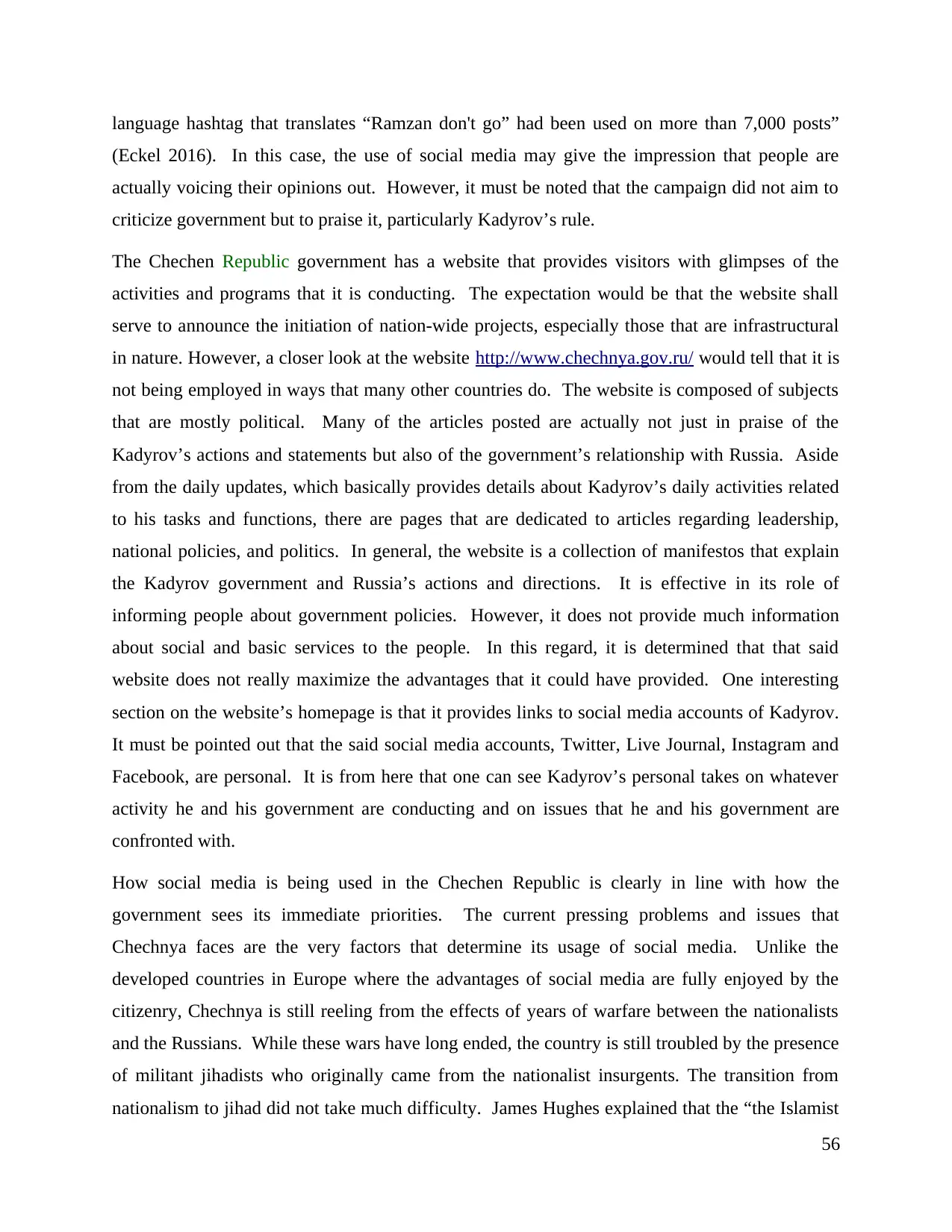
language hashtag that translates “Ramzan don't go” had been used on more than 7,000 posts”
(Eckel 2016). In this case, the use of social media may give the impression that people are
actually voicing their opinions out. However, it must be noted that the campaign did not aim to
criticize government but to praise it, particularly Kadyrov’s rule.
The Chechen Republic government has a website that provides visitors with glimpses of the
activities and programs that it is conducting. The expectation would be that the website shall
serve to announce the initiation of nation-wide projects, especially those that are infrastructural
in nature. However, a closer look at the website http://www.chechnya.gov.ru/ would tell that it is
not being employed in ways that many other countries do. The website is composed of subjects
that are mostly political. Many of the articles posted are actually not just in praise of the
Kadyrov’s actions and statements but also of the government’s relationship with Russia. Aside
from the daily updates, which basically provides details about Kadyrov’s daily activities related
to his tasks and functions, there are pages that are dedicated to articles regarding leadership,
national policies, and politics. In general, the website is a collection of manifestos that explain
the Kadyrov government and Russia’s actions and directions. It is effective in its role of
informing people about government policies. However, it does not provide much information
about social and basic services to the people. In this regard, it is determined that that said
website does not really maximize the advantages that it could have provided. One interesting
section on the website’s homepage is that it provides links to social media accounts of Kadyrov.
It must be pointed out that the said social media accounts, Twitter, Live Journal, Instagram and
Facebook, are personal. It is from here that one can see Kadyrov’s personal takes on whatever
activity he and his government are conducting and on issues that he and his government are
confronted with.
How social media is being used in the Chechen Republic is clearly in line with how the
government sees its immediate priorities. The current pressing problems and issues that
Chechnya faces are the very factors that determine its usage of social media. Unlike the
developed countries in Europe where the advantages of social media are fully enjoyed by the
citizenry, Chechnya is still reeling from the effects of years of warfare between the nationalists
and the Russians. While these wars have long ended, the country is still troubled by the presence
of militant jihadists who originally came from the nationalist insurgents. The transition from
nationalism to jihad did not take much difficulty. James Hughes explained that the “the Islamist
56
(Eckel 2016). In this case, the use of social media may give the impression that people are
actually voicing their opinions out. However, it must be noted that the campaign did not aim to
criticize government but to praise it, particularly Kadyrov’s rule.
The Chechen Republic government has a website that provides visitors with glimpses of the
activities and programs that it is conducting. The expectation would be that the website shall
serve to announce the initiation of nation-wide projects, especially those that are infrastructural
in nature. However, a closer look at the website http://www.chechnya.gov.ru/ would tell that it is
not being employed in ways that many other countries do. The website is composed of subjects
that are mostly political. Many of the articles posted are actually not just in praise of the
Kadyrov’s actions and statements but also of the government’s relationship with Russia. Aside
from the daily updates, which basically provides details about Kadyrov’s daily activities related
to his tasks and functions, there are pages that are dedicated to articles regarding leadership,
national policies, and politics. In general, the website is a collection of manifestos that explain
the Kadyrov government and Russia’s actions and directions. It is effective in its role of
informing people about government policies. However, it does not provide much information
about social and basic services to the people. In this regard, it is determined that that said
website does not really maximize the advantages that it could have provided. One interesting
section on the website’s homepage is that it provides links to social media accounts of Kadyrov.
It must be pointed out that the said social media accounts, Twitter, Live Journal, Instagram and
Facebook, are personal. It is from here that one can see Kadyrov’s personal takes on whatever
activity he and his government are conducting and on issues that he and his government are
confronted with.
How social media is being used in the Chechen Republic is clearly in line with how the
government sees its immediate priorities. The current pressing problems and issues that
Chechnya faces are the very factors that determine its usage of social media. Unlike the
developed countries in Europe where the advantages of social media are fully enjoyed by the
citizenry, Chechnya is still reeling from the effects of years of warfare between the nationalists
and the Russians. While these wars have long ended, the country is still troubled by the presence
of militant jihadists who originally came from the nationalist insurgents. The transition from
nationalism to jihad did not take much difficulty. James Hughes explained that the “the Islamist
56
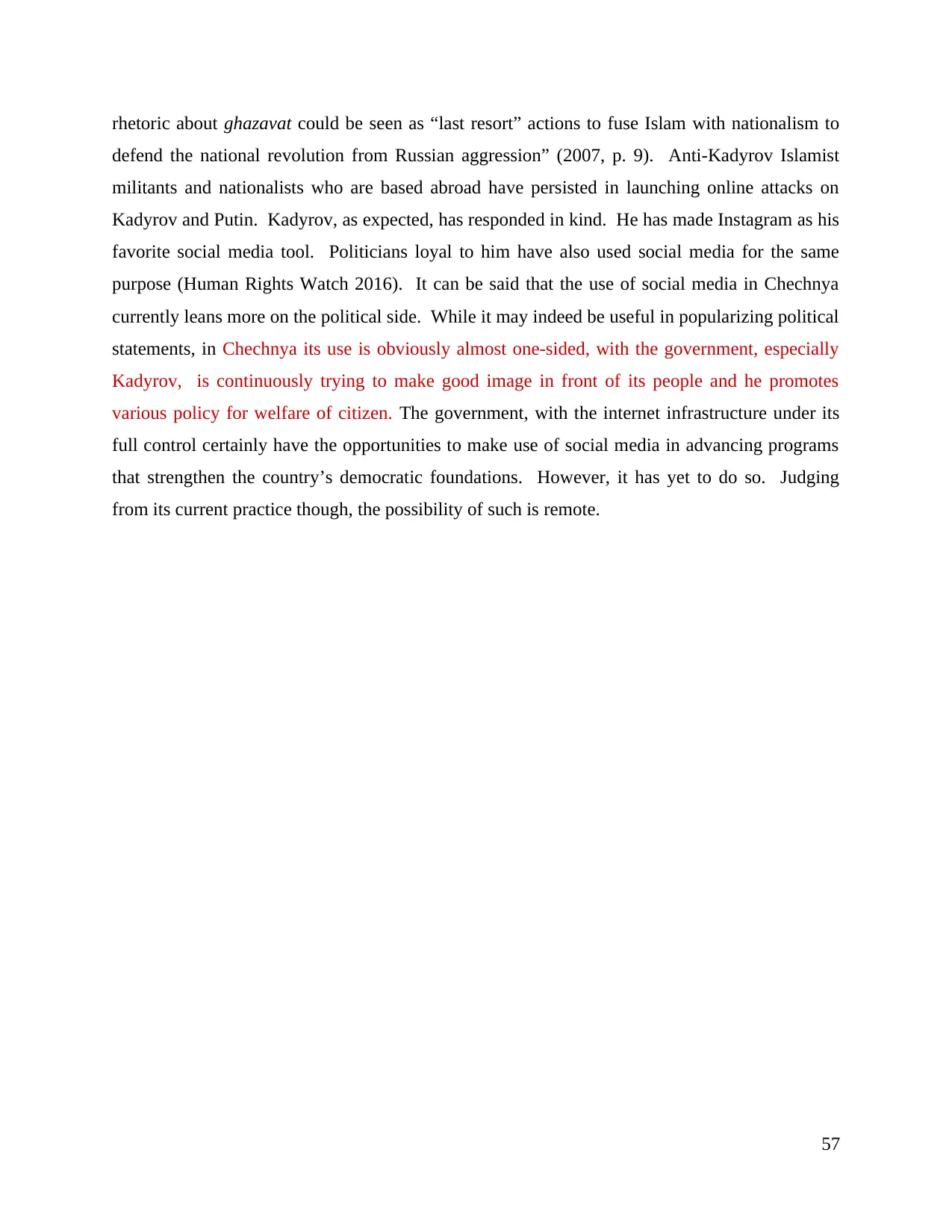
rhetoric about ghazavat could be seen as “last resort” actions to fuse Islam with nationalism to
defend the national revolution from Russian aggression” (2007, p. 9). Anti-Kadyrov Islamist
militants and nationalists who are based abroad have persisted in launching online attacks on
Kadyrov and Putin. Kadyrov, as expected, has responded in kind. He has made Instagram as his
favorite social media tool. Politicians loyal to him have also used social media for the same
purpose (Human Rights Watch 2016). It can be said that the use of social media in Chechnya
currently leans more on the political side. While it may indeed be useful in popularizing political
statements, in Chechnya its use is obviously almost one-sided, with the government, especially
Kadyrov, is continuously trying to make good image in front of its people and he promotes
various policy for welfare of citizen. The government, with the internet infrastructure under its
full control certainly have the opportunities to make use of social media in advancing programs
that strengthen the country’s democratic foundations. However, it has yet to do so. Judging
from its current practice though, the possibility of such is remote.
57
defend the national revolution from Russian aggression” (2007, p. 9). Anti-Kadyrov Islamist
militants and nationalists who are based abroad have persisted in launching online attacks on
Kadyrov and Putin. Kadyrov, as expected, has responded in kind. He has made Instagram as his
favorite social media tool. Politicians loyal to him have also used social media for the same
purpose (Human Rights Watch 2016). It can be said that the use of social media in Chechnya
currently leans more on the political side. While it may indeed be useful in popularizing political
statements, in Chechnya its use is obviously almost one-sided, with the government, especially
Kadyrov, is continuously trying to make good image in front of its people and he promotes
various policy for welfare of citizen. The government, with the internet infrastructure under its
full control certainly have the opportunities to make use of social media in advancing programs
that strengthen the country’s democratic foundations. However, it has yet to do so. Judging
from its current practice though, the possibility of such is remote.
57
Paraphrase This Document
Need a fresh take? Get an instant paraphrase of this document with our AI Paraphraser
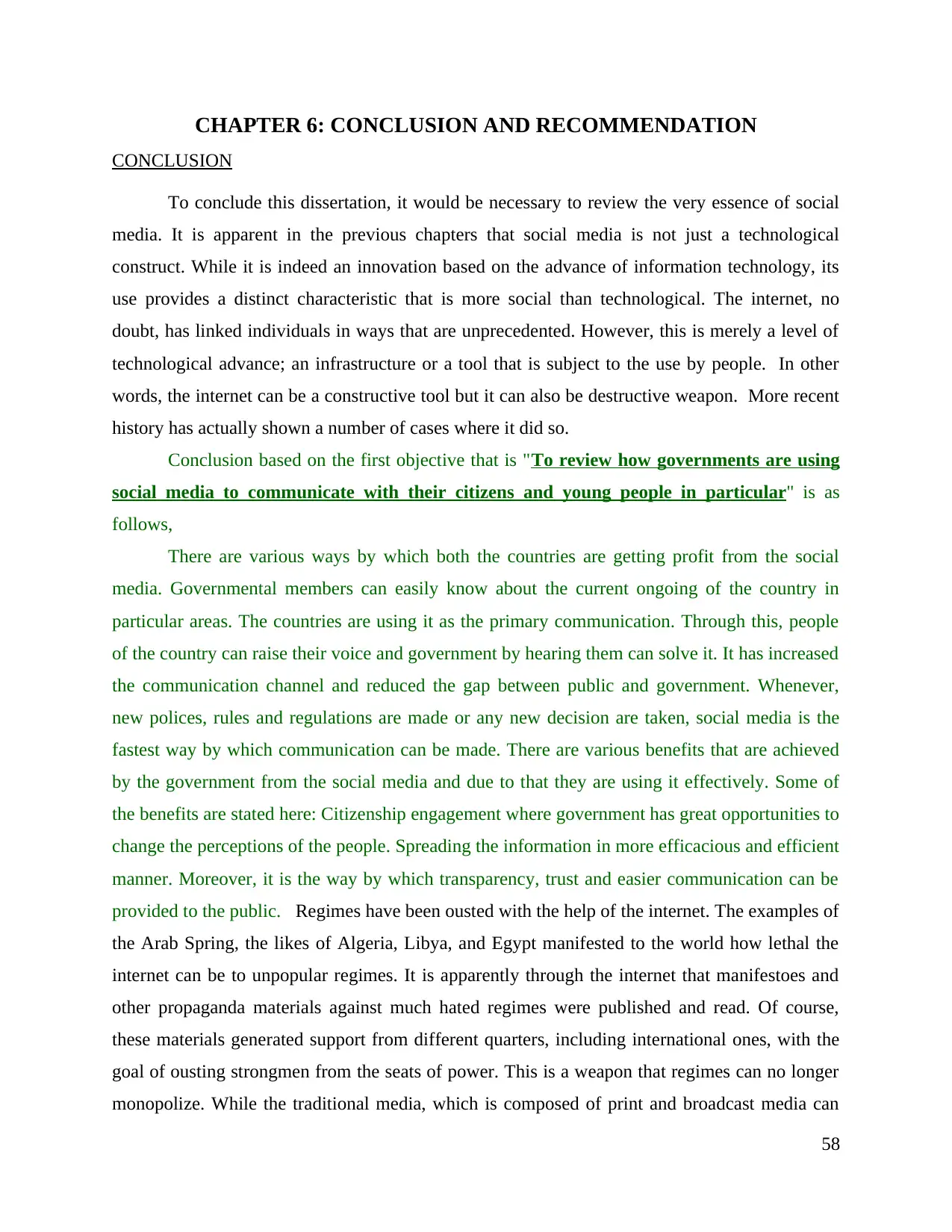
CHAPTER 6: CONCLUSION AND RECOMMENDATION
CONCLUSION
To conclude this dissertation, it would be necessary to review the very essence of social
media. It is apparent in the previous chapters that social media is not just a technological
construct. While it is indeed an innovation based on the advance of information technology, its
use provides a distinct characteristic that is more social than technological. The internet, no
doubt, has linked individuals in ways that are unprecedented. However, this is merely a level of
technological advance; an infrastructure or a tool that is subject to the use by people. In other
words, the internet can be a constructive tool but it can also be destructive weapon. More recent
history has actually shown a number of cases where it did so.
Conclusion based on the first objective that is "To review how governments are using
social media to communicate with their citizens and young people in particular" is as
follows,
There are various ways by which both the countries are getting profit from the social
media. Governmental members can easily know about the current ongoing of the country in
particular areas. The countries are using it as the primary communication. Through this, people
of the country can raise their voice and government by hearing them can solve it. It has increased
the communication channel and reduced the gap between public and government. Whenever,
new polices, rules and regulations are made or any new decision are taken, social media is the
fastest way by which communication can be made. There are various benefits that are achieved
by the government from the social media and due to that they are using it effectively. Some of
the benefits are stated here: Citizenship engagement where government has great opportunities to
change the perceptions of the people. Spreading the information in more efficacious and efficient
manner. Moreover, it is the way by which transparency, trust and easier communication can be
provided to the public. Regimes have been ousted with the help of the internet. The examples of
the Arab Spring, the likes of Algeria, Libya, and Egypt manifested to the world how lethal the
internet can be to unpopular regimes. It is apparently through the internet that manifestoes and
other propaganda materials against much hated regimes were published and read. Of course,
these materials generated support from different quarters, including international ones, with the
goal of ousting strongmen from the seats of power. This is a weapon that regimes can no longer
monopolize. While the traditional media, which is composed of print and broadcast media can
58
CONCLUSION
To conclude this dissertation, it would be necessary to review the very essence of social
media. It is apparent in the previous chapters that social media is not just a technological
construct. While it is indeed an innovation based on the advance of information technology, its
use provides a distinct characteristic that is more social than technological. The internet, no
doubt, has linked individuals in ways that are unprecedented. However, this is merely a level of
technological advance; an infrastructure or a tool that is subject to the use by people. In other
words, the internet can be a constructive tool but it can also be destructive weapon. More recent
history has actually shown a number of cases where it did so.
Conclusion based on the first objective that is "To review how governments are using
social media to communicate with their citizens and young people in particular" is as
follows,
There are various ways by which both the countries are getting profit from the social
media. Governmental members can easily know about the current ongoing of the country in
particular areas. The countries are using it as the primary communication. Through this, people
of the country can raise their voice and government by hearing them can solve it. It has increased
the communication channel and reduced the gap between public and government. Whenever,
new polices, rules and regulations are made or any new decision are taken, social media is the
fastest way by which communication can be made. There are various benefits that are achieved
by the government from the social media and due to that they are using it effectively. Some of
the benefits are stated here: Citizenship engagement where government has great opportunities to
change the perceptions of the people. Spreading the information in more efficacious and efficient
manner. Moreover, it is the way by which transparency, trust and easier communication can be
provided to the public. Regimes have been ousted with the help of the internet. The examples of
the Arab Spring, the likes of Algeria, Libya, and Egypt manifested to the world how lethal the
internet can be to unpopular regimes. It is apparently through the internet that manifestoes and
other propaganda materials against much hated regimes were published and read. Of course,
these materials generated support from different quarters, including international ones, with the
goal of ousting strongmen from the seats of power. This is a weapon that regimes can no longer
monopolize. While the traditional media, which is composed of print and broadcast media can
58
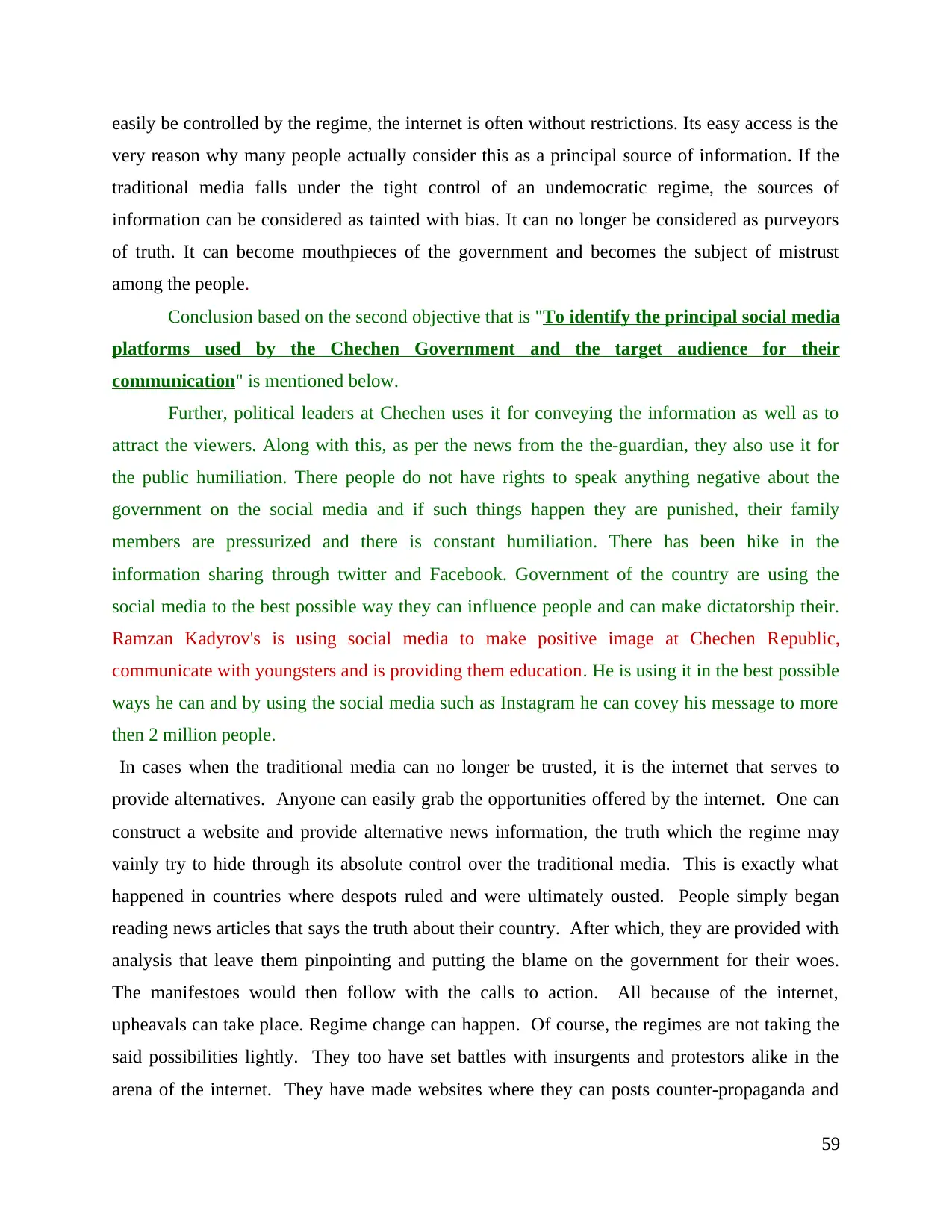
easily be controlled by the regime, the internet is often without restrictions. Its easy access is the
very reason why many people actually consider this as a principal source of information. If the
traditional media falls under the tight control of an undemocratic regime, the sources of
information can be considered as tainted with bias. It can no longer be considered as purveyors
of truth. It can become mouthpieces of the government and becomes the subject of mistrust
among the people.
Conclusion based on the second objective that is "To identify the principal social media
platforms used by the Chechen Government and the target audience for their
communication" is mentioned below.
Further, political leaders at Chechen uses it for conveying the information as well as to
attract the viewers. Along with this, as per the news from the the-guardian, they also use it for
the public humiliation. There people do not have rights to speak anything negative about the
government on the social media and if such things happen they are punished, their family
members are pressurized and there is constant humiliation. There has been hike in the
information sharing through twitter and Facebook. Government of the country are using the
social media to the best possible way they can influence people and can make dictatorship their.
Ramzan Kadyrov's is using social media to make positive image at Chechen Republic,
communicate with youngsters and is providing them education. He is using it in the best possible
ways he can and by using the social media such as Instagram he can covey his message to more
then 2 million people.
In cases when the traditional media can no longer be trusted, it is the internet that serves to
provide alternatives. Anyone can easily grab the opportunities offered by the internet. One can
construct a website and provide alternative news information, the truth which the regime may
vainly try to hide through its absolute control over the traditional media. This is exactly what
happened in countries where despots ruled and were ultimately ousted. People simply began
reading news articles that says the truth about their country. After which, they are provided with
analysis that leave them pinpointing and putting the blame on the government for their woes.
The manifestoes would then follow with the calls to action. All because of the internet,
upheavals can take place. Regime change can happen. Of course, the regimes are not taking the
said possibilities lightly. They too have set battles with insurgents and protestors alike in the
arena of the internet. They have made websites where they can posts counter-propaganda and
59
very reason why many people actually consider this as a principal source of information. If the
traditional media falls under the tight control of an undemocratic regime, the sources of
information can be considered as tainted with bias. It can no longer be considered as purveyors
of truth. It can become mouthpieces of the government and becomes the subject of mistrust
among the people.
Conclusion based on the second objective that is "To identify the principal social media
platforms used by the Chechen Government and the target audience for their
communication" is mentioned below.
Further, political leaders at Chechen uses it for conveying the information as well as to
attract the viewers. Along with this, as per the news from the the-guardian, they also use it for
the public humiliation. There people do not have rights to speak anything negative about the
government on the social media and if such things happen they are punished, their family
members are pressurized and there is constant humiliation. There has been hike in the
information sharing through twitter and Facebook. Government of the country are using the
social media to the best possible way they can influence people and can make dictatorship their.
Ramzan Kadyrov's is using social media to make positive image at Chechen Republic,
communicate with youngsters and is providing them education. He is using it in the best possible
ways he can and by using the social media such as Instagram he can covey his message to more
then 2 million people.
In cases when the traditional media can no longer be trusted, it is the internet that serves to
provide alternatives. Anyone can easily grab the opportunities offered by the internet. One can
construct a website and provide alternative news information, the truth which the regime may
vainly try to hide through its absolute control over the traditional media. This is exactly what
happened in countries where despots ruled and were ultimately ousted. People simply began
reading news articles that says the truth about their country. After which, they are provided with
analysis that leave them pinpointing and putting the blame on the government for their woes.
The manifestoes would then follow with the calls to action. All because of the internet,
upheavals can take place. Regime change can happen. Of course, the regimes are not taking the
said possibilities lightly. They too have set battles with insurgents and protestors alike in the
arena of the internet. They have made websites where they can posts counter-propaganda and
59
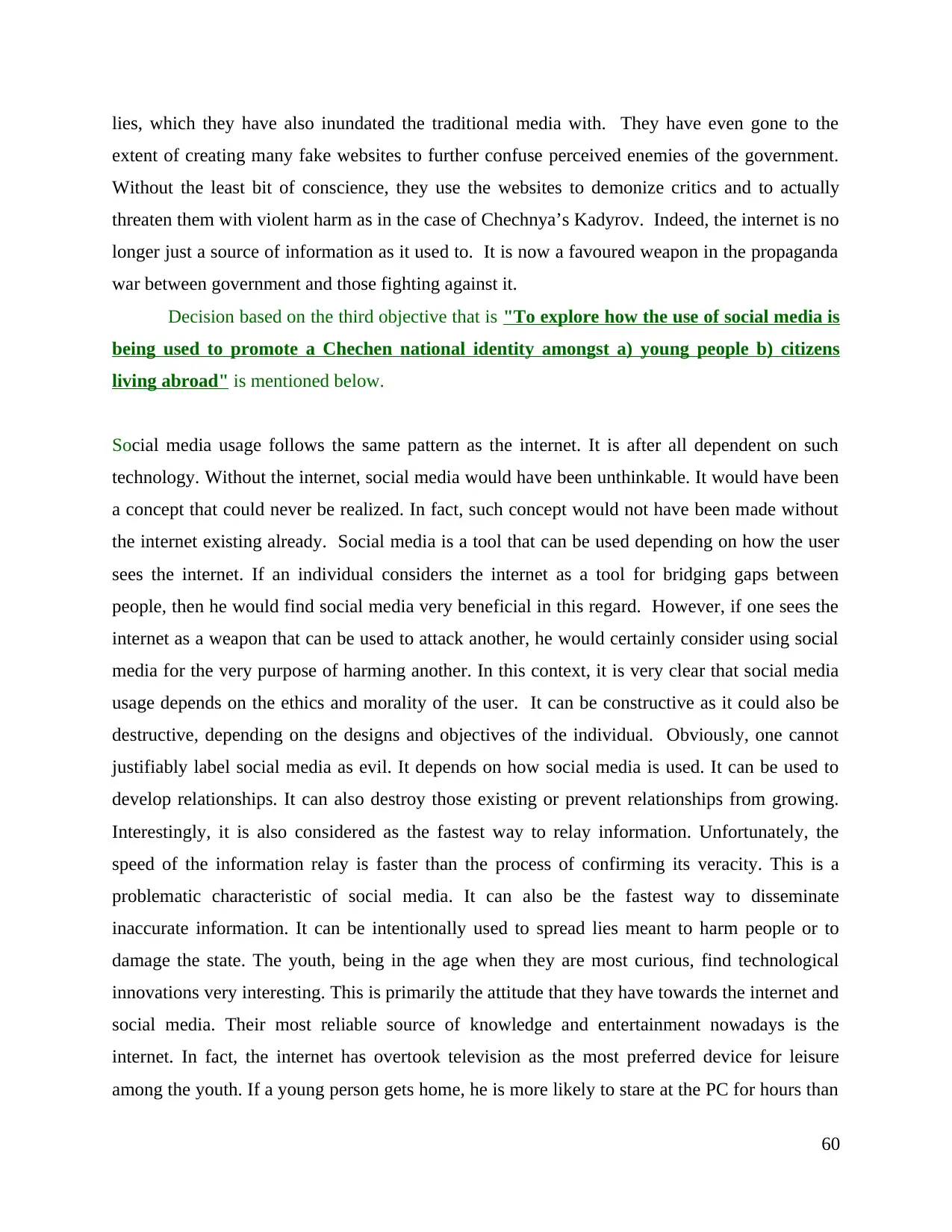
lies, which they have also inundated the traditional media with. They have even gone to the
extent of creating many fake websites to further confuse perceived enemies of the government.
Without the least bit of conscience, they use the websites to demonize critics and to actually
threaten them with violent harm as in the case of Chechnya’s Kadyrov. Indeed, the internet is no
longer just a source of information as it used to. It is now a favoured weapon in the propaganda
war between government and those fighting against it.
Decision based on the third objective that is "To explore how the use of social media is
being used to promote a Chechen national identity amongst a) young people b) citizens
living abroad" is mentioned below.
Social media usage follows the same pattern as the internet. It is after all dependent on such
technology. Without the internet, social media would have been unthinkable. It would have been
a concept that could never be realized. In fact, such concept would not have been made without
the internet existing already. Social media is a tool that can be used depending on how the user
sees the internet. If an individual considers the internet as a tool for bridging gaps between
people, then he would find social media very beneficial in this regard. However, if one sees the
internet as a weapon that can be used to attack another, he would certainly consider using social
media for the very purpose of harming another. In this context, it is very clear that social media
usage depends on the ethics and morality of the user. It can be constructive as it could also be
destructive, depending on the designs and objectives of the individual. Obviously, one cannot
justifiably label social media as evil. It depends on how social media is used. It can be used to
develop relationships. It can also destroy those existing or prevent relationships from growing.
Interestingly, it is also considered as the fastest way to relay information. Unfortunately, the
speed of the information relay is faster than the process of confirming its veracity. This is a
problematic characteristic of social media. It can also be the fastest way to disseminate
inaccurate information. It can be intentionally used to spread lies meant to harm people or to
damage the state. The youth, being in the age when they are most curious, find technological
innovations very interesting. This is primarily the attitude that they have towards the internet and
social media. Their most reliable source of knowledge and entertainment nowadays is the
internet. In fact, the internet has overtook television as the most preferred device for leisure
among the youth. If a young person gets home, he is more likely to stare at the PC for hours than
60
extent of creating many fake websites to further confuse perceived enemies of the government.
Without the least bit of conscience, they use the websites to demonize critics and to actually
threaten them with violent harm as in the case of Chechnya’s Kadyrov. Indeed, the internet is no
longer just a source of information as it used to. It is now a favoured weapon in the propaganda
war between government and those fighting against it.
Decision based on the third objective that is "To explore how the use of social media is
being used to promote a Chechen national identity amongst a) young people b) citizens
living abroad" is mentioned below.
Social media usage follows the same pattern as the internet. It is after all dependent on such
technology. Without the internet, social media would have been unthinkable. It would have been
a concept that could never be realized. In fact, such concept would not have been made without
the internet existing already. Social media is a tool that can be used depending on how the user
sees the internet. If an individual considers the internet as a tool for bridging gaps between
people, then he would find social media very beneficial in this regard. However, if one sees the
internet as a weapon that can be used to attack another, he would certainly consider using social
media for the very purpose of harming another. In this context, it is very clear that social media
usage depends on the ethics and morality of the user. It can be constructive as it could also be
destructive, depending on the designs and objectives of the individual. Obviously, one cannot
justifiably label social media as evil. It depends on how social media is used. It can be used to
develop relationships. It can also destroy those existing or prevent relationships from growing.
Interestingly, it is also considered as the fastest way to relay information. Unfortunately, the
speed of the information relay is faster than the process of confirming its veracity. This is a
problematic characteristic of social media. It can also be the fastest way to disseminate
inaccurate information. It can be intentionally used to spread lies meant to harm people or to
damage the state. The youth, being in the age when they are most curious, find technological
innovations very interesting. This is primarily the attitude that they have towards the internet and
social media. Their most reliable source of knowledge and entertainment nowadays is the
internet. In fact, the internet has overtook television as the most preferred device for leisure
among the youth. If a young person gets home, he is more likely to stare at the PC for hours than
60
Secure Best Marks with AI Grader
Need help grading? Try our AI Grader for instant feedback on your assignments.
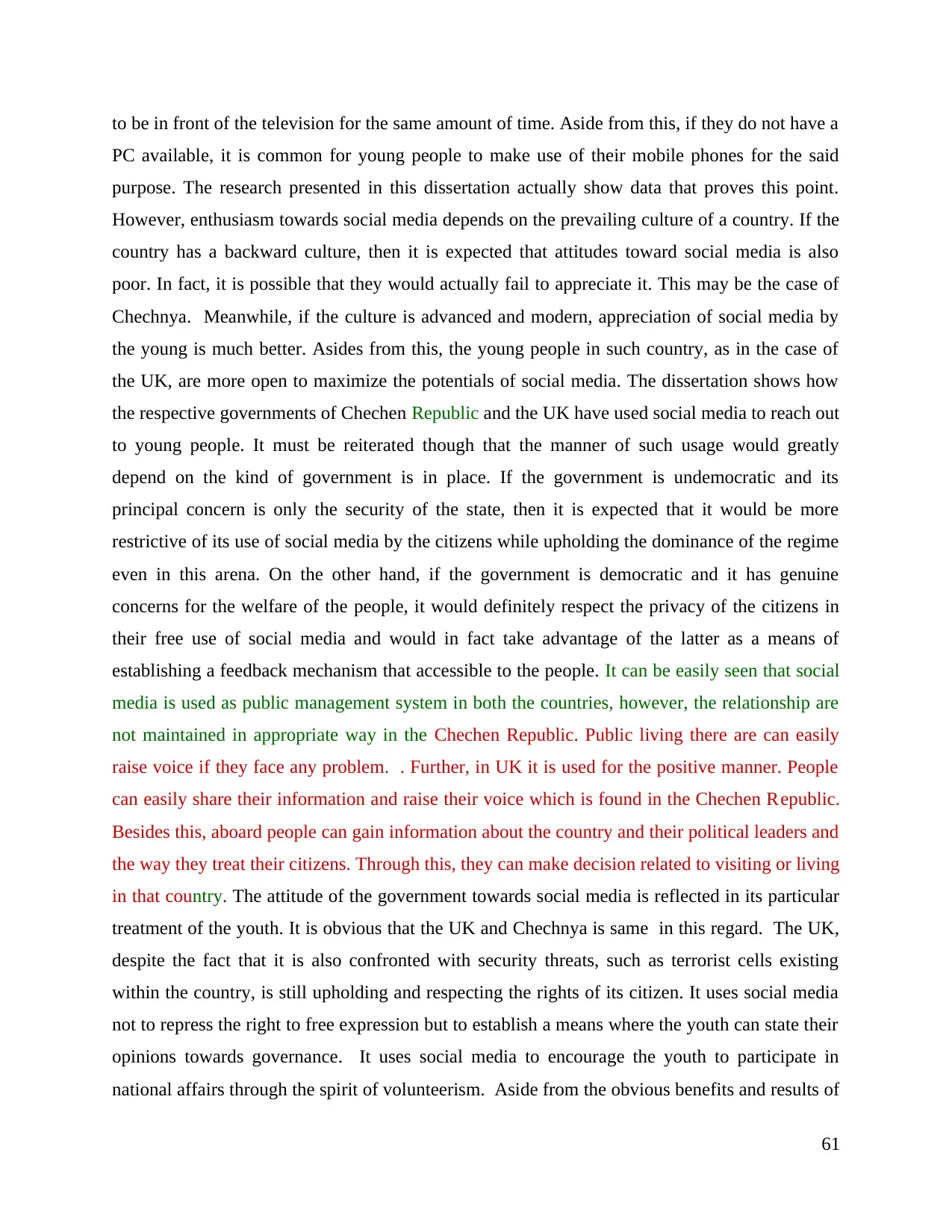
to be in front of the television for the same amount of time. Aside from this, if they do not have a
PC available, it is common for young people to make use of their mobile phones for the said
purpose. The research presented in this dissertation actually show data that proves this point.
However, enthusiasm towards social media depends on the prevailing culture of a country. If the
country has a backward culture, then it is expected that attitudes toward social media is also
poor. In fact, it is possible that they would actually fail to appreciate it. This may be the case of
Chechnya. Meanwhile, if the culture is advanced and modern, appreciation of social media by
the young is much better. Asides from this, the young people in such country, as in the case of
the UK, are more open to maximize the potentials of social media. The dissertation shows how
the respective governments of Chechen Republic and the UK have used social media to reach out
to young people. It must be reiterated though that the manner of such usage would greatly
depend on the kind of government is in place. If the government is undemocratic and its
principal concern is only the security of the state, then it is expected that it would be more
restrictive of its use of social media by the citizens while upholding the dominance of the regime
even in this arena. On the other hand, if the government is democratic and it has genuine
concerns for the welfare of the people, it would definitely respect the privacy of the citizens in
their free use of social media and would in fact take advantage of the latter as a means of
establishing a feedback mechanism that accessible to the people. It can be easily seen that social
media is used as public management system in both the countries, however, the relationship are
not maintained in appropriate way in the Chechen Republic. Public living there are can easily
raise voice if they face any problem. . Further, in UK it is used for the positive manner. People
can easily share their information and raise their voice which is found in the Chechen Republic.
Besides this, aboard people can gain information about the country and their political leaders and
the way they treat their citizens. Through this, they can make decision related to visiting or living
in that country. The attitude of the government towards social media is reflected in its particular
treatment of the youth. It is obvious that the UK and Chechnya is same in this regard. The UK,
despite the fact that it is also confronted with security threats, such as terrorist cells existing
within the country, is still upholding and respecting the rights of its citizen. It uses social media
not to repress the right to free expression but to establish a means where the youth can state their
opinions towards governance. It uses social media to encourage the youth to participate in
national affairs through the spirit of volunteerism. Aside from the obvious benefits and results of
61
PC available, it is common for young people to make use of their mobile phones for the said
purpose. The research presented in this dissertation actually show data that proves this point.
However, enthusiasm towards social media depends on the prevailing culture of a country. If the
country has a backward culture, then it is expected that attitudes toward social media is also
poor. In fact, it is possible that they would actually fail to appreciate it. This may be the case of
Chechnya. Meanwhile, if the culture is advanced and modern, appreciation of social media by
the young is much better. Asides from this, the young people in such country, as in the case of
the UK, are more open to maximize the potentials of social media. The dissertation shows how
the respective governments of Chechen Republic and the UK have used social media to reach out
to young people. It must be reiterated though that the manner of such usage would greatly
depend on the kind of government is in place. If the government is undemocratic and its
principal concern is only the security of the state, then it is expected that it would be more
restrictive of its use of social media by the citizens while upholding the dominance of the regime
even in this arena. On the other hand, if the government is democratic and it has genuine
concerns for the welfare of the people, it would definitely respect the privacy of the citizens in
their free use of social media and would in fact take advantage of the latter as a means of
establishing a feedback mechanism that accessible to the people. It can be easily seen that social
media is used as public management system in both the countries, however, the relationship are
not maintained in appropriate way in the Chechen Republic. Public living there are can easily
raise voice if they face any problem. . Further, in UK it is used for the positive manner. People
can easily share their information and raise their voice which is found in the Chechen Republic.
Besides this, aboard people can gain information about the country and their political leaders and
the way they treat their citizens. Through this, they can make decision related to visiting or living
in that country. The attitude of the government towards social media is reflected in its particular
treatment of the youth. It is obvious that the UK and Chechnya is same in this regard. The UK,
despite the fact that it is also confronted with security threats, such as terrorist cells existing
within the country, is still upholding and respecting the rights of its citizen. It uses social media
not to repress the right to free expression but to establish a means where the youth can state their
opinions towards governance. It uses social media to encourage the youth to participate in
national affairs through the spirit of volunteerism. Aside from the obvious benefits and results of
61
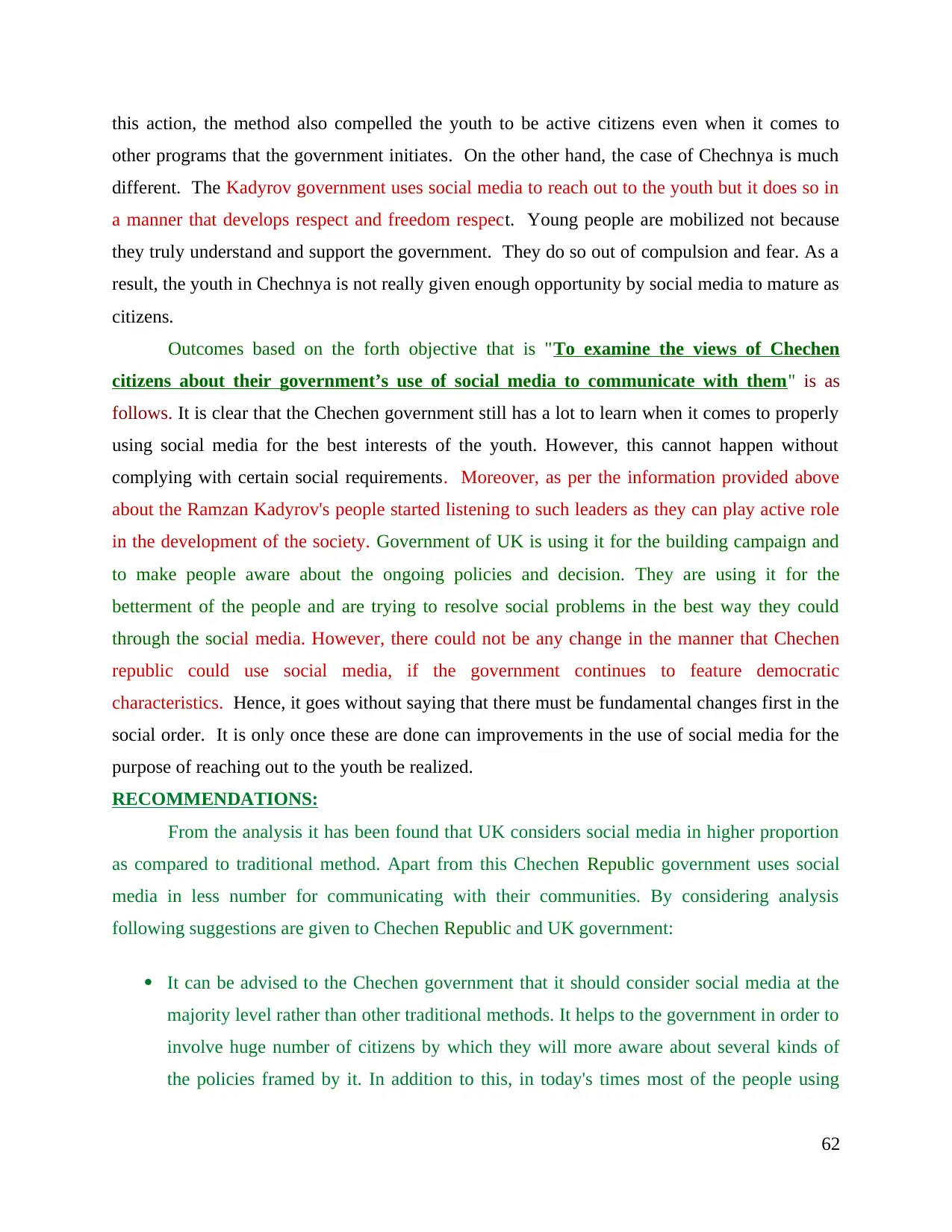
this action, the method also compelled the youth to be active citizens even when it comes to
other programs that the government initiates. On the other hand, the case of Chechnya is much
different. The Kadyrov government uses social media to reach out to the youth but it does so in
a manner that develops respect and freedom respect. Young people are mobilized not because
they truly understand and support the government. They do so out of compulsion and fear. As a
result, the youth in Chechnya is not really given enough opportunity by social media to mature as
citizens.
Outcomes based on the forth objective that is "To examine the views of Chechen
citizens about their government’s use of social media to communicate with them" is as
follows. It is clear that the Chechen government still has a lot to learn when it comes to properly
using social media for the best interests of the youth. However, this cannot happen without
complying with certain social requirements. Moreover, as per the information provided above
about the Ramzan Kadyrov's people started listening to such leaders as they can play active role
in the development of the society. Government of UK is using it for the building campaign and
to make people aware about the ongoing policies and decision. They are using it for the
betterment of the people and are trying to resolve social problems in the best way they could
through the social media. However, there could not be any change in the manner that Chechen
republic could use social media, if the government continues to feature democratic
characteristics. Hence, it goes without saying that there must be fundamental changes first in the
social order. It is only once these are done can improvements in the use of social media for the
purpose of reaching out to the youth be realized.
RECOMMENDATIONS:
From the analysis it has been found that UK considers social media in higher proportion
as compared to traditional method. Apart from this Chechen Republic government uses social
media in less number for communicating with their communities. By considering analysis
following suggestions are given to Chechen Republic and UK government:
It can be advised to the Chechen government that it should consider social media at the
majority level rather than other traditional methods. It helps to the government in order to
involve huge number of citizens by which they will more aware about several kinds of
the policies framed by it. In addition to this, in today's times most of the people using
62
other programs that the government initiates. On the other hand, the case of Chechnya is much
different. The Kadyrov government uses social media to reach out to the youth but it does so in
a manner that develops respect and freedom respect. Young people are mobilized not because
they truly understand and support the government. They do so out of compulsion and fear. As a
result, the youth in Chechnya is not really given enough opportunity by social media to mature as
citizens.
Outcomes based on the forth objective that is "To examine the views of Chechen
citizens about their government’s use of social media to communicate with them" is as
follows. It is clear that the Chechen government still has a lot to learn when it comes to properly
using social media for the best interests of the youth. However, this cannot happen without
complying with certain social requirements. Moreover, as per the information provided above
about the Ramzan Kadyrov's people started listening to such leaders as they can play active role
in the development of the society. Government of UK is using it for the building campaign and
to make people aware about the ongoing policies and decision. They are using it for the
betterment of the people and are trying to resolve social problems in the best way they could
through the social media. However, there could not be any change in the manner that Chechen
republic could use social media, if the government continues to feature democratic
characteristics. Hence, it goes without saying that there must be fundamental changes first in the
social order. It is only once these are done can improvements in the use of social media for the
purpose of reaching out to the youth be realized.
RECOMMENDATIONS:
From the analysis it has been found that UK considers social media in higher proportion
as compared to traditional method. Apart from this Chechen Republic government uses social
media in less number for communicating with their communities. By considering analysis
following suggestions are given to Chechen Republic and UK government:
It can be advised to the Chechen government that it should consider social media at the
majority level rather than other traditional methods. It helps to the government in order to
involve huge number of citizens by which they will more aware about several kinds of
the policies framed by it. In addition to this, in today's times most of the people using
62
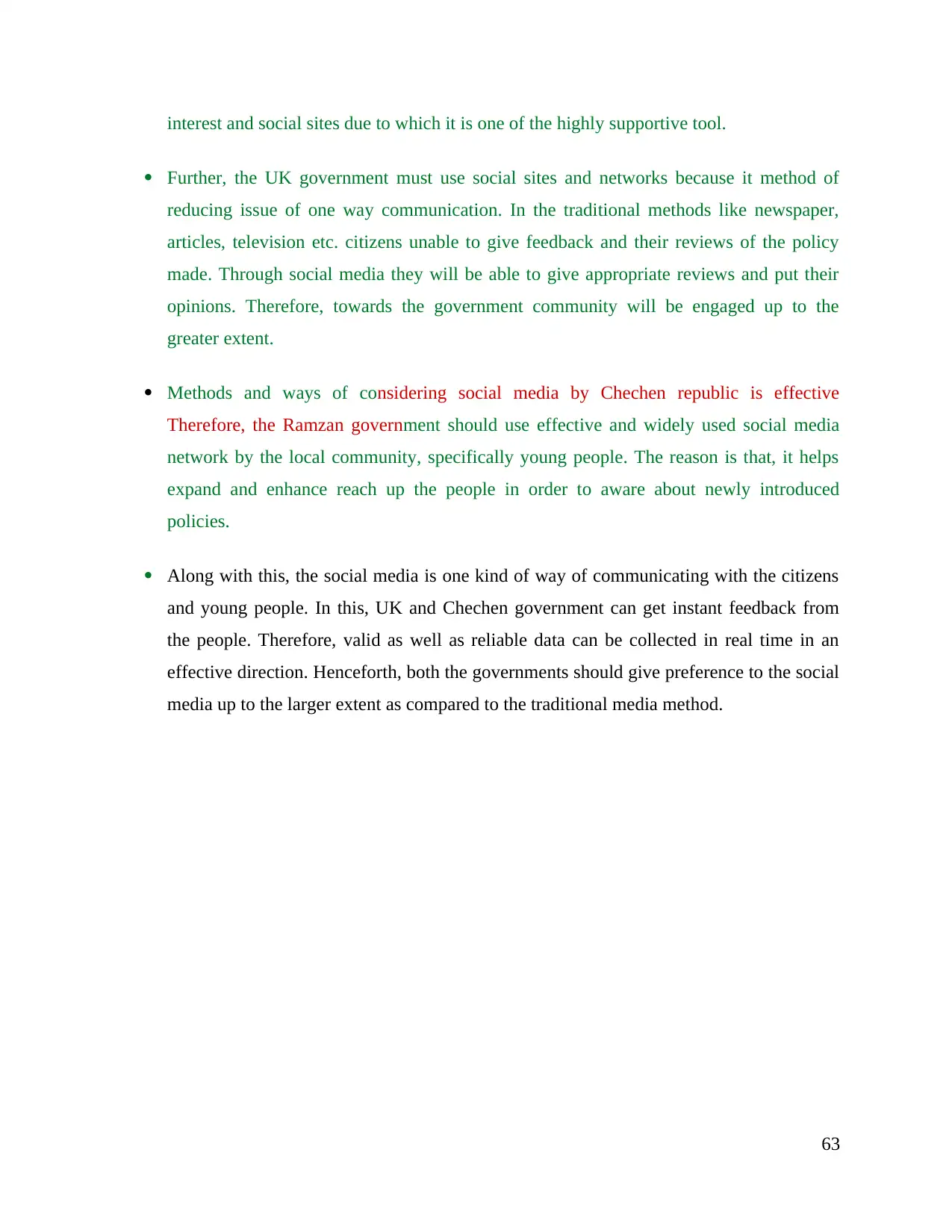
interest and social sites due to which it is one of the highly supportive tool.
Further, the UK government must use social sites and networks because it method of
reducing issue of one way communication. In the traditional methods like newspaper,
articles, television etc. citizens unable to give feedback and their reviews of the policy
made. Through social media they will be able to give appropriate reviews and put their
opinions. Therefore, towards the government community will be engaged up to the
greater extent.
Methods and ways of considering social media by Chechen republic is effective
Therefore, the Ramzan government should use effective and widely used social media
network by the local community, specifically young people. The reason is that, it helps
expand and enhance reach up the people in order to aware about newly introduced
policies.
Along with this, the social media is one kind of way of communicating with the citizens
and young people. In this, UK and Chechen government can get instant feedback from
the people. Therefore, valid as well as reliable data can be collected in real time in an
effective direction. Henceforth, both the governments should give preference to the social
media up to the larger extent as compared to the traditional media method.
63
Further, the UK government must use social sites and networks because it method of
reducing issue of one way communication. In the traditional methods like newspaper,
articles, television etc. citizens unable to give feedback and their reviews of the policy
made. Through social media they will be able to give appropriate reviews and put their
opinions. Therefore, towards the government community will be engaged up to the
greater extent.
Methods and ways of considering social media by Chechen republic is effective
Therefore, the Ramzan government should use effective and widely used social media
network by the local community, specifically young people. The reason is that, it helps
expand and enhance reach up the people in order to aware about newly introduced
policies.
Along with this, the social media is one kind of way of communicating with the citizens
and young people. In this, UK and Chechen government can get instant feedback from
the people. Therefore, valid as well as reliable data can be collected in real time in an
effective direction. Henceforth, both the governments should give preference to the social
media up to the larger extent as compared to the traditional media method.
63
Paraphrase This Document
Need a fresh take? Get an instant paraphrase of this document with our AI Paraphraser
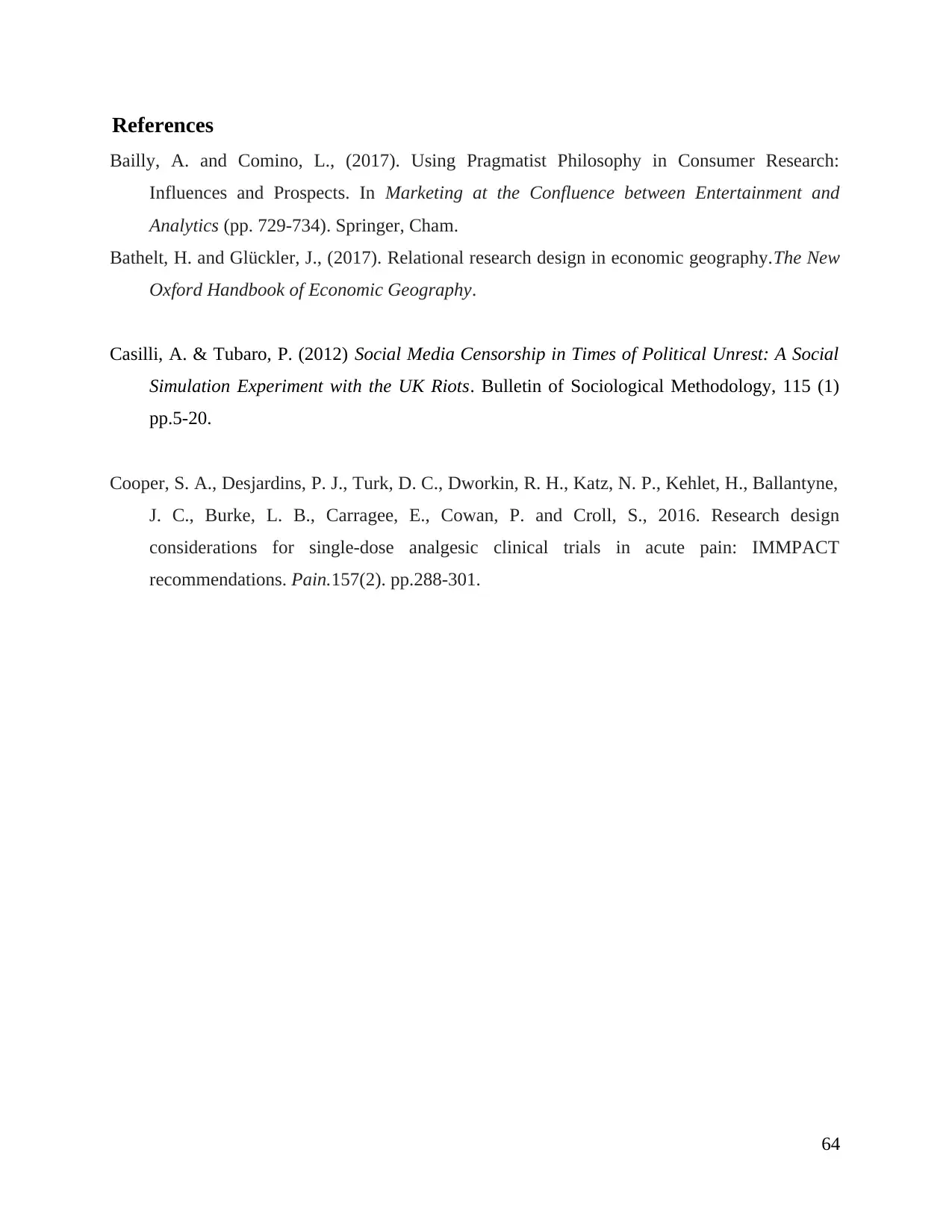
References
Bailly, A. and Comino, L., (2017). Using Pragmatist Philosophy in Consumer Research:
Influences and Prospects. In Marketing at the Confluence between Entertainment and
Analytics (pp. 729-734). Springer, Cham.
Bathelt, H. and Glückler, J., (2017). Relational research design in economic geography.The New
Oxford Handbook of Economic Geography.
Casilli, A. & Tubaro, P. (2012) Social Media Censorship in Times of Political Unrest: A Social
Simulation Experiment with the UK Riots. Bulletin of Sociological Methodology, 115 (1)
pp.5-20.
Cooper, S. A., Desjardins, P. J., Turk, D. C., Dworkin, R. H., Katz, N. P., Kehlet, H., Ballantyne,
J. C., Burke, L. B., Carragee, E., Cowan, P. and Croll, S., 2016. Research design
considerations for single-dose analgesic clinical trials in acute pain: IMMPACT
recommendations. Pain.157(2). pp.288-301.
64
Bailly, A. and Comino, L., (2017). Using Pragmatist Philosophy in Consumer Research:
Influences and Prospects. In Marketing at the Confluence between Entertainment and
Analytics (pp. 729-734). Springer, Cham.
Bathelt, H. and Glückler, J., (2017). Relational research design in economic geography.The New
Oxford Handbook of Economic Geography.
Casilli, A. & Tubaro, P. (2012) Social Media Censorship in Times of Political Unrest: A Social
Simulation Experiment with the UK Riots. Bulletin of Sociological Methodology, 115 (1)
pp.5-20.
Cooper, S. A., Desjardins, P. J., Turk, D. C., Dworkin, R. H., Katz, N. P., Kehlet, H., Ballantyne,
J. C., Burke, L. B., Carragee, E., Cowan, P. and Croll, S., 2016. Research design
considerations for single-dose analgesic clinical trials in acute pain: IMMPACT
recommendations. Pain.157(2). pp.288-301.
64
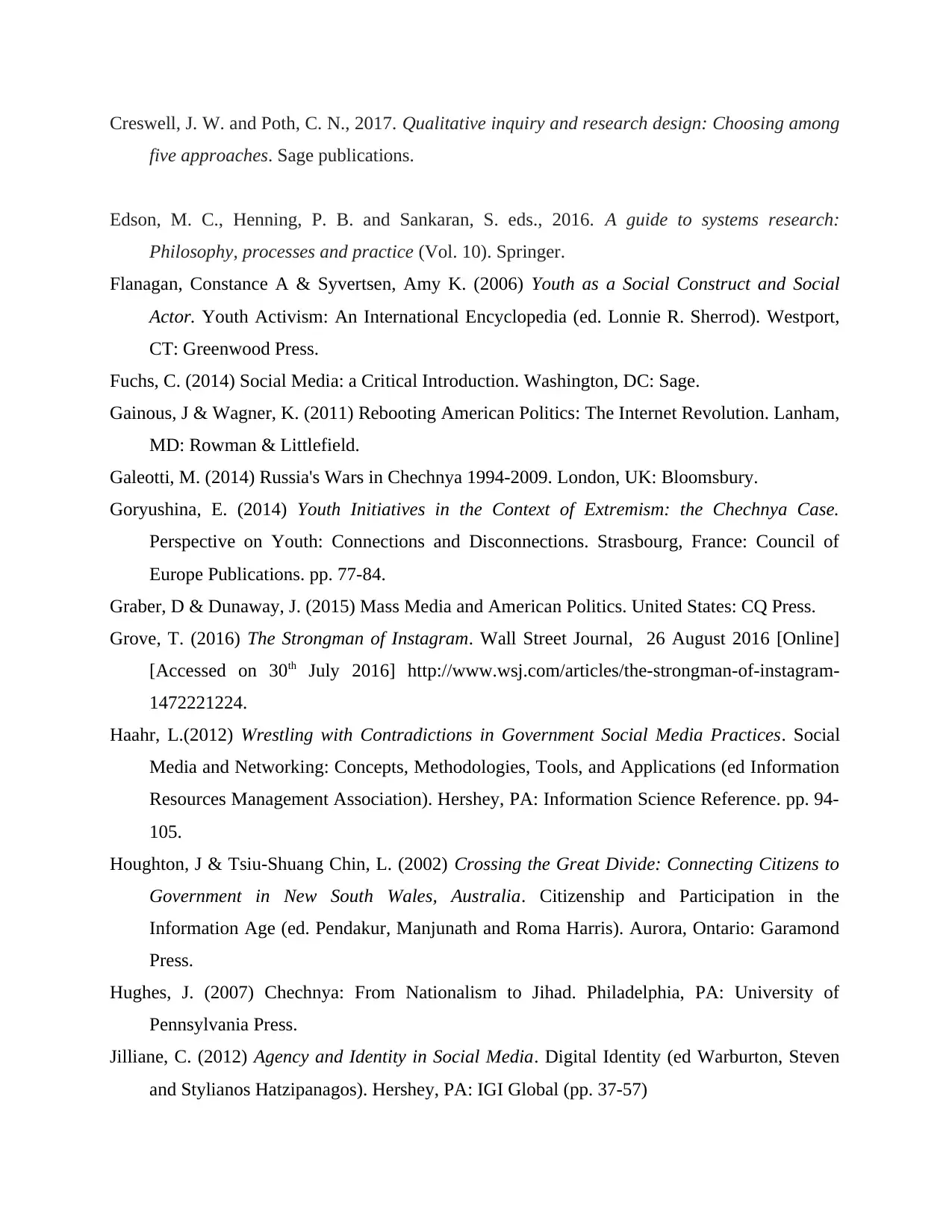
Creswell, J. W. and Poth, C. N., 2017. Qualitative inquiry and research design: Choosing among
five approaches. Sage publications.
Edson, M. C., Henning, P. B. and Sankaran, S. eds., 2016. A guide to systems research:
Philosophy, processes and practice (Vol. 10). Springer.
Flanagan, Constance A & Syvertsen, Amy K. (2006) Youth as a Social Construct and Social
Actor. Youth Activism: An International Encyclopedia (ed. Lonnie R. Sherrod). Westport,
CT: Greenwood Press.
Fuchs, C. (2014) Social Media: a Critical Introduction. Washington, DC: Sage.
Gainous, J & Wagner, K. (2011) Rebooting American Politics: The Internet Revolution. Lanham,
MD: Rowman & Littlefield.
Galeotti, M. (2014) Russia's Wars in Chechnya 1994-2009. London, UK: Bloomsbury.
Goryushina, E. (2014) Youth Initiatives in the Context of Extremism: the Chechnya Case.
Perspective on Youth: Connections and Disconnections. Strasbourg, France: Council of
Europe Publications. pp. 77-84.
Graber, D & Dunaway, J. (2015) Mass Media and American Politics. United States: CQ Press.
Grove, T. (2016) The Strongman of Instagram. Wall Street Journal, 26 August 2016 [Online]
[Accessed on 30th July 2016] http://www.wsj.com/articles/the-strongman-of-instagram-
1472221224.
Haahr, L.(2012) Wrestling with Contradictions in Government Social Media Practices. Social
Media and Networking: Concepts, Methodologies, Tools, and Applications (ed Information
Resources Management Association). Hershey, PA: Information Science Reference. pp. 94-
105.
Houghton, J & Tsiu-Shuang Chin, L. (2002) Crossing the Great Divide: Connecting Citizens to
Government in New South Wales, Australia. Citizenship and Participation in the
Information Age (ed. Pendakur, Manjunath and Roma Harris). Aurora, Ontario: Garamond
Press.
Hughes, J. (2007) Chechnya: From Nationalism to Jihad. Philadelphia, PA: University of
Pennsylvania Press.
Jilliane, C. (2012) Agency and Identity in Social Media. Digital Identity (ed Warburton, Steven
and Stylianos Hatzipanagos). Hershey, PA: IGI Global (pp. 37-57)
five approaches. Sage publications.
Edson, M. C., Henning, P. B. and Sankaran, S. eds., 2016. A guide to systems research:
Philosophy, processes and practice (Vol. 10). Springer.
Flanagan, Constance A & Syvertsen, Amy K. (2006) Youth as a Social Construct and Social
Actor. Youth Activism: An International Encyclopedia (ed. Lonnie R. Sherrod). Westport,
CT: Greenwood Press.
Fuchs, C. (2014) Social Media: a Critical Introduction. Washington, DC: Sage.
Gainous, J & Wagner, K. (2011) Rebooting American Politics: The Internet Revolution. Lanham,
MD: Rowman & Littlefield.
Galeotti, M. (2014) Russia's Wars in Chechnya 1994-2009. London, UK: Bloomsbury.
Goryushina, E. (2014) Youth Initiatives in the Context of Extremism: the Chechnya Case.
Perspective on Youth: Connections and Disconnections. Strasbourg, France: Council of
Europe Publications. pp. 77-84.
Graber, D & Dunaway, J. (2015) Mass Media and American Politics. United States: CQ Press.
Grove, T. (2016) The Strongman of Instagram. Wall Street Journal, 26 August 2016 [Online]
[Accessed on 30th July 2016] http://www.wsj.com/articles/the-strongman-of-instagram-
1472221224.
Haahr, L.(2012) Wrestling with Contradictions in Government Social Media Practices. Social
Media and Networking: Concepts, Methodologies, Tools, and Applications (ed Information
Resources Management Association). Hershey, PA: Information Science Reference. pp. 94-
105.
Houghton, J & Tsiu-Shuang Chin, L. (2002) Crossing the Great Divide: Connecting Citizens to
Government in New South Wales, Australia. Citizenship and Participation in the
Information Age (ed. Pendakur, Manjunath and Roma Harris). Aurora, Ontario: Garamond
Press.
Hughes, J. (2007) Chechnya: From Nationalism to Jihad. Philadelphia, PA: University of
Pennsylvania Press.
Jilliane, C. (2012) Agency and Identity in Social Media. Digital Identity (ed Warburton, Steven
and Stylianos Hatzipanagos). Hershey, PA: IGI Global (pp. 37-57)
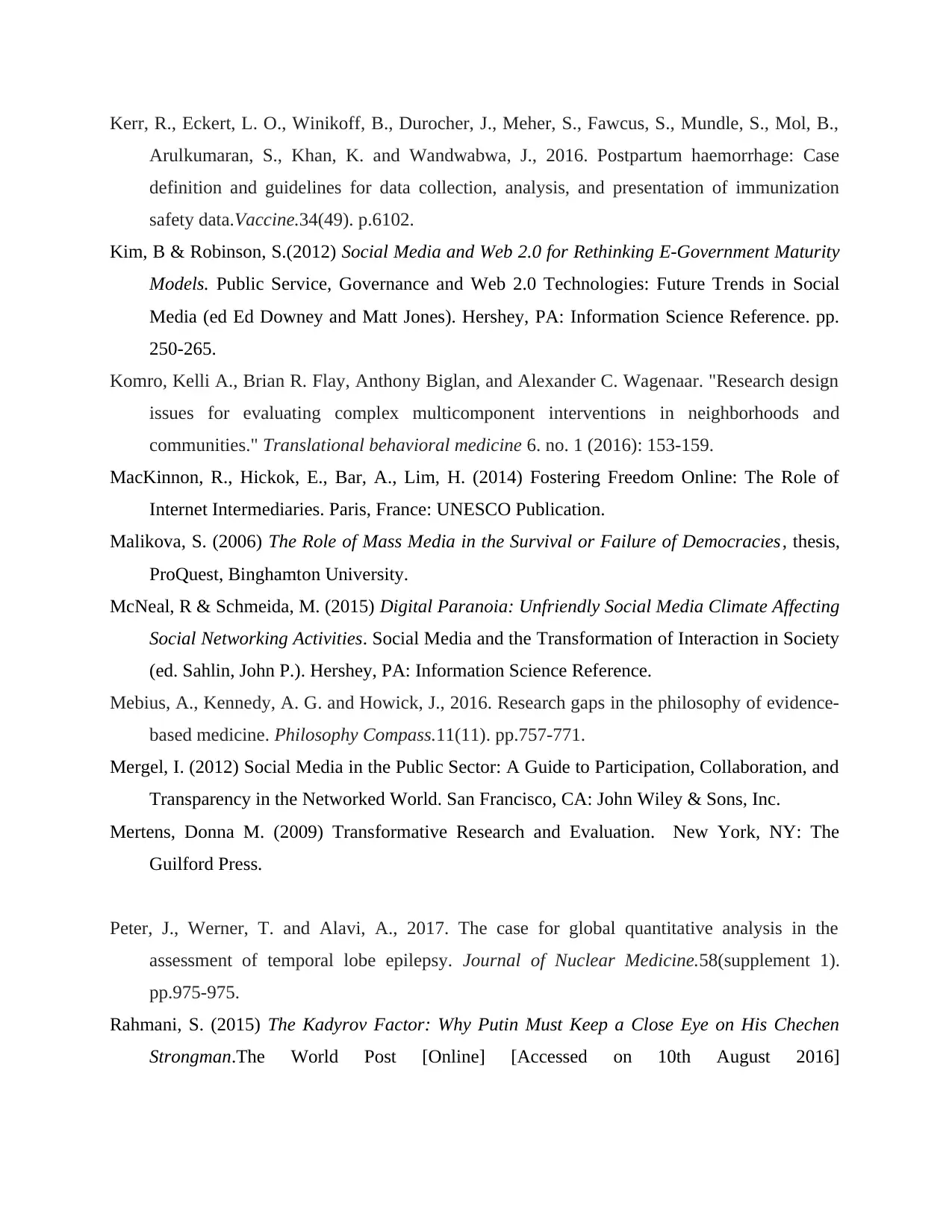
Kerr, R., Eckert, L. O., Winikoff, B., Durocher, J., Meher, S., Fawcus, S., Mundle, S., Mol, B.,
Arulkumaran, S., Khan, K. and Wandwabwa, J., 2016. Postpartum haemorrhage: Case
definition and guidelines for data collection, analysis, and presentation of immunization
safety data.Vaccine.34(49). p.6102.
Kim, B & Robinson, S.(2012) Social Media and Web 2.0 for Rethinking E-Government Maturity
Models. Public Service, Governance and Web 2.0 Technologies: Future Trends in Social
Media (ed Ed Downey and Matt Jones). Hershey, PA: Information Science Reference. pp.
250-265.
Komro, Kelli A., Brian R. Flay, Anthony Biglan, and Alexander C. Wagenaar. "Research design
issues for evaluating complex multicomponent interventions in neighborhoods and
communities." Translational behavioral medicine 6. no. 1 (2016): 153-159.
MacKinnon, R., Hickok, E., Bar, A., Lim, H. (2014) Fostering Freedom Online: The Role of
Internet Intermediaries. Paris, France: UNESCO Publication.
Malikova, S. (2006) The Role of Mass Media in the Survival or Failure of Democracies, thesis,
ProQuest, Binghamton University.
McNeal, R & Schmeida, M. (2015) Digital Paranoia: Unfriendly Social Media Climate Affecting
Social Networking Activities. Social Media and the Transformation of Interaction in Society
(ed. Sahlin, John P.). Hershey, PA: Information Science Reference.
Mebius, A., Kennedy, A. G. and Howick, J., 2016. Research gaps in the philosophy of evidence‐
based medicine. Philosophy Compass.11(11). pp.757-771.
Mergel, I. (2012) Social Media in the Public Sector: A Guide to Participation, Collaboration, and
Transparency in the Networked World. San Francisco, CA: John Wiley & Sons, Inc.
Mertens, Donna M. (2009) Transformative Research and Evaluation. New York, NY: The
Guilford Press.
Peter, J., Werner, T. and Alavi, A., 2017. The case for global quantitative analysis in the
assessment of temporal lobe epilepsy. Journal of Nuclear Medicine.58(supplement 1).
pp.975-975.
Rahmani, S. (2015) The Kadyrov Factor: Why Putin Must Keep a Close Eye on His Chechen
Strongman.The World Post [Online] [Accessed on 10th August 2016]
Arulkumaran, S., Khan, K. and Wandwabwa, J., 2016. Postpartum haemorrhage: Case
definition and guidelines for data collection, analysis, and presentation of immunization
safety data.Vaccine.34(49). p.6102.
Kim, B & Robinson, S.(2012) Social Media and Web 2.0 for Rethinking E-Government Maturity
Models. Public Service, Governance and Web 2.0 Technologies: Future Trends in Social
Media (ed Ed Downey and Matt Jones). Hershey, PA: Information Science Reference. pp.
250-265.
Komro, Kelli A., Brian R. Flay, Anthony Biglan, and Alexander C. Wagenaar. "Research design
issues for evaluating complex multicomponent interventions in neighborhoods and
communities." Translational behavioral medicine 6. no. 1 (2016): 153-159.
MacKinnon, R., Hickok, E., Bar, A., Lim, H. (2014) Fostering Freedom Online: The Role of
Internet Intermediaries. Paris, France: UNESCO Publication.
Malikova, S. (2006) The Role of Mass Media in the Survival or Failure of Democracies, thesis,
ProQuest, Binghamton University.
McNeal, R & Schmeida, M. (2015) Digital Paranoia: Unfriendly Social Media Climate Affecting
Social Networking Activities. Social Media and the Transformation of Interaction in Society
(ed. Sahlin, John P.). Hershey, PA: Information Science Reference.
Mebius, A., Kennedy, A. G. and Howick, J., 2016. Research gaps in the philosophy of evidence‐
based medicine. Philosophy Compass.11(11). pp.757-771.
Mergel, I. (2012) Social Media in the Public Sector: A Guide to Participation, Collaboration, and
Transparency in the Networked World. San Francisco, CA: John Wiley & Sons, Inc.
Mertens, Donna M. (2009) Transformative Research and Evaluation. New York, NY: The
Guilford Press.
Peter, J., Werner, T. and Alavi, A., 2017. The case for global quantitative analysis in the
assessment of temporal lobe epilepsy. Journal of Nuclear Medicine.58(supplement 1).
pp.975-975.
Rahmani, S. (2015) The Kadyrov Factor: Why Putin Must Keep a Close Eye on His Chechen
Strongman.The World Post [Online] [Accessed on 10th August 2016]
Secure Best Marks with AI Grader
Need help grading? Try our AI Grader for instant feedback on your assignments.
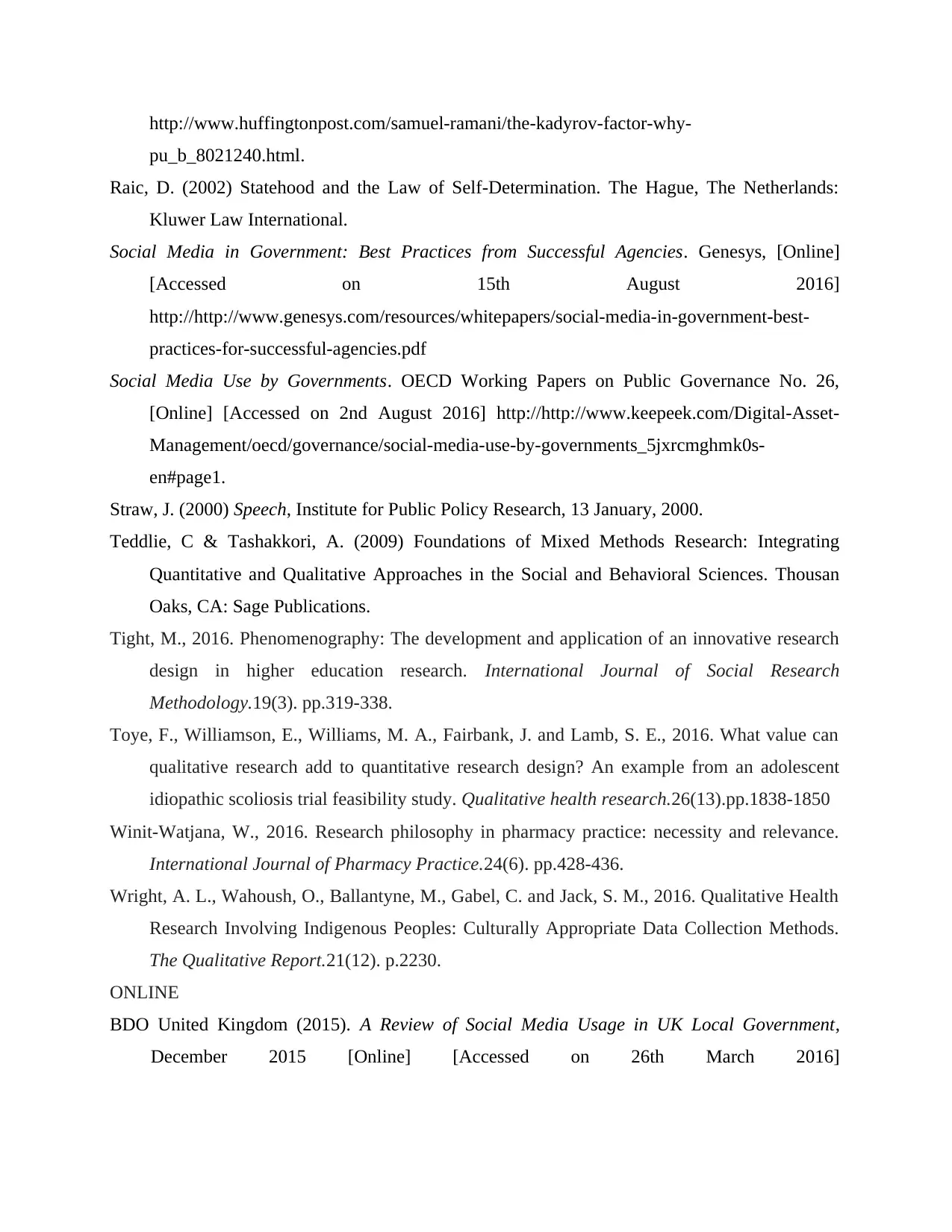
http://www.huffingtonpost.com/samuel-ramani/the-kadyrov-factor-why-
pu_b_8021240.html.
Raic, D. (2002) Statehood and the Law of Self-Determination. The Hague, The Netherlands:
Kluwer Law International.
Social Media in Government: Best Practices from Successful Agencies. Genesys, [Online]
[Accessed on 15th August 2016]
http://http://www.genesys.com/resources/whitepapers/social-media-in-government-best-
practices-for-successful-agencies.pdf
Social Media Use by Governments. OECD Working Papers on Public Governance No. 26,
[Online] [Accessed on 2nd August 2016] http://http://www.keepeek.com/Digital-Asset-
Management/oecd/governance/social-media-use-by-governments_5jxrcmghmk0s-
en#page1.
Straw, J. (2000) Speech, Institute for Public Policy Research, 13 January, 2000.
Teddlie, C & Tashakkori, A. (2009) Foundations of Mixed Methods Research: Integrating
Quantitative and Qualitative Approaches in the Social and Behavioral Sciences. Thousan
Oaks, CA: Sage Publications.
Tight, M., 2016. Phenomenography: The development and application of an innovative research
design in higher education research. International Journal of Social Research
Methodology.19(3). pp.319-338.
Toye, F., Williamson, E., Williams, M. A., Fairbank, J. and Lamb, S. E., 2016. What value can
qualitative research add to quantitative research design? An example from an adolescent
idiopathic scoliosis trial feasibility study. Qualitative health research.26(13).pp.1838-1850
Winit‐Watjana, W., 2016. Research philosophy in pharmacy practice: necessity and relevance.
International Journal of Pharmacy Practice.24(6). pp.428-436.
Wright, A. L., Wahoush, O., Ballantyne, M., Gabel, C. and Jack, S. M., 2016. Qualitative Health
Research Involving Indigenous Peoples: Culturally Appropriate Data Collection Methods.
The Qualitative Report.21(12). p.2230.
ONLINE
BDO United Kingdom (2015). A Review of Social Media Usage in UK Local Government,
December 2015 [Online] [Accessed on 26th March 2016]
pu_b_8021240.html.
Raic, D. (2002) Statehood and the Law of Self-Determination. The Hague, The Netherlands:
Kluwer Law International.
Social Media in Government: Best Practices from Successful Agencies. Genesys, [Online]
[Accessed on 15th August 2016]
http://http://www.genesys.com/resources/whitepapers/social-media-in-government-best-
practices-for-successful-agencies.pdf
Social Media Use by Governments. OECD Working Papers on Public Governance No. 26,
[Online] [Accessed on 2nd August 2016] http://http://www.keepeek.com/Digital-Asset-
Management/oecd/governance/social-media-use-by-governments_5jxrcmghmk0s-
en#page1.
Straw, J. (2000) Speech, Institute for Public Policy Research, 13 January, 2000.
Teddlie, C & Tashakkori, A. (2009) Foundations of Mixed Methods Research: Integrating
Quantitative and Qualitative Approaches in the Social and Behavioral Sciences. Thousan
Oaks, CA: Sage Publications.
Tight, M., 2016. Phenomenography: The development and application of an innovative research
design in higher education research. International Journal of Social Research
Methodology.19(3). pp.319-338.
Toye, F., Williamson, E., Williams, M. A., Fairbank, J. and Lamb, S. E., 2016. What value can
qualitative research add to quantitative research design? An example from an adolescent
idiopathic scoliosis trial feasibility study. Qualitative health research.26(13).pp.1838-1850
Winit‐Watjana, W., 2016. Research philosophy in pharmacy practice: necessity and relevance.
International Journal of Pharmacy Practice.24(6). pp.428-436.
Wright, A. L., Wahoush, O., Ballantyne, M., Gabel, C. and Jack, S. M., 2016. Qualitative Health
Research Involving Indigenous Peoples: Culturally Appropriate Data Collection Methods.
The Qualitative Report.21(12). p.2230.
ONLINE
BDO United Kingdom (2015). A Review of Social Media Usage in UK Local Government,
December 2015 [Online] [Accessed on 26th March 2016]
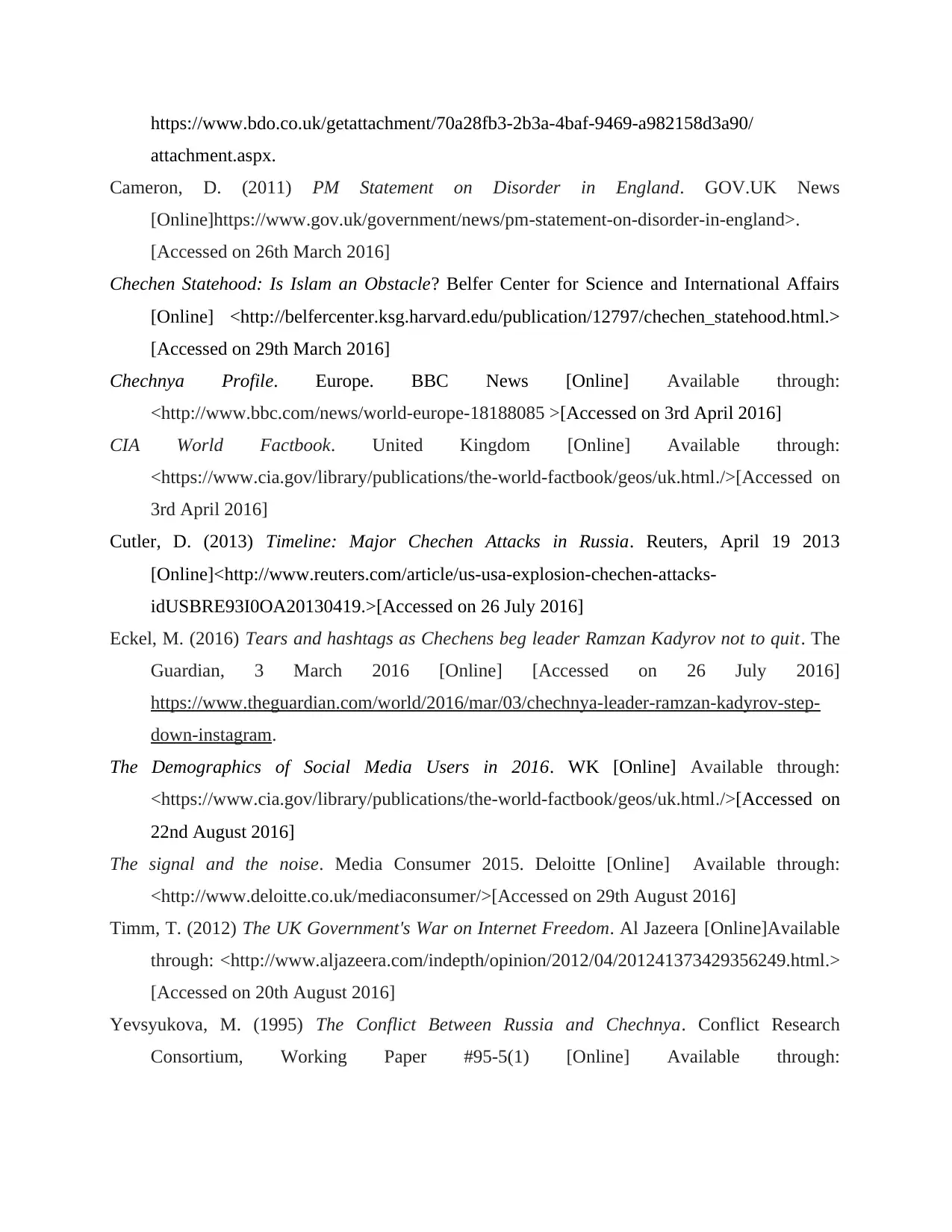
https://www.bdo.co.uk/getattachment/70a28fb3-2b3a-4baf-9469-a982158d3a90/
attachment.aspx.
Cameron, D. (2011) PM Statement on Disorder in England. GOV.UK News
[Online]https://www.gov.uk/government/news/pm-statement-on-disorder-in-england>.
[Accessed on 26th March 2016]
Chechen Statehood: Is Islam an Obstacle? Belfer Center for Science and International Affairs
[Online] <http://belfercenter.ksg.harvard.edu/publication/12797/chechen_statehood.html.>
[Accessed on 29th March 2016]
Chechnya Profile. Europe. BBC News [Online] Available through:
<http://www.bbc.com/news/world-europe-18188085 >[Accessed on 3rd April 2016]
CIA World Factbook. United Kingdom [Online] Available through:
<https://www.cia.gov/library/publications/the-world-factbook/geos/uk.html./>[Accessed on
3rd April 2016]
Cutler, D. (2013) Timeline: Major Chechen Attacks in Russia. Reuters, April 19 2013
[Online]<http://www.reuters.com/article/us-usa-explosion-chechen-attacks-
idUSBRE93I0OA20130419.>[Accessed on 26 July 2016]
Eckel, M. (2016) Tears and hashtags as Chechens beg leader Ramzan Kadyrov not to quit. The
Guardian, 3 March 2016 [Online] [Accessed on 26 July 2016]
https://www.theguardian.com/world/2016/mar/03/chechnya-leader-ramzan-kadyrov-step-
down-instagram.
The Demographics of Social Media Users in 2016. WK [Online] Available through:
<https://www.cia.gov/library/publications/the-world-factbook/geos/uk.html./>[Accessed on
22nd August 2016]
The signal and the noise. Media Consumer 2015. Deloitte [Online] Available through:
<http://www.deloitte.co.uk/mediaconsumer/>[Accessed on 29th August 2016]
Timm, T. (2012) The UK Government's War on Internet Freedom. Al Jazeera [Online]Available
through: <http://www.aljazeera.com/indepth/opinion/2012/04/201241373429356249.html.>
[Accessed on 20th August 2016]
Yevsyukova, M. (1995) The Conflict Between Russia and Chechnya. Conflict Research
Consortium, Working Paper #95-5(1) [Online] Available through:
attachment.aspx.
Cameron, D. (2011) PM Statement on Disorder in England. GOV.UK News
[Online]https://www.gov.uk/government/news/pm-statement-on-disorder-in-england>.
[Accessed on 26th March 2016]
Chechen Statehood: Is Islam an Obstacle? Belfer Center for Science and International Affairs
[Online] <http://belfercenter.ksg.harvard.edu/publication/12797/chechen_statehood.html.>
[Accessed on 29th March 2016]
Chechnya Profile. Europe. BBC News [Online] Available through:
<http://www.bbc.com/news/world-europe-18188085 >[Accessed on 3rd April 2016]
CIA World Factbook. United Kingdom [Online] Available through:
<https://www.cia.gov/library/publications/the-world-factbook/geos/uk.html./>[Accessed on
3rd April 2016]
Cutler, D. (2013) Timeline: Major Chechen Attacks in Russia. Reuters, April 19 2013
[Online]<http://www.reuters.com/article/us-usa-explosion-chechen-attacks-
idUSBRE93I0OA20130419.>[Accessed on 26 July 2016]
Eckel, M. (2016) Tears and hashtags as Chechens beg leader Ramzan Kadyrov not to quit. The
Guardian, 3 March 2016 [Online] [Accessed on 26 July 2016]
https://www.theguardian.com/world/2016/mar/03/chechnya-leader-ramzan-kadyrov-step-
down-instagram.
The Demographics of Social Media Users in 2016. WK [Online] Available through:
<https://www.cia.gov/library/publications/the-world-factbook/geos/uk.html./>[Accessed on
22nd August 2016]
The signal and the noise. Media Consumer 2015. Deloitte [Online] Available through:
<http://www.deloitte.co.uk/mediaconsumer/>[Accessed on 29th August 2016]
Timm, T. (2012) The UK Government's War on Internet Freedom. Al Jazeera [Online]Available
through: <http://www.aljazeera.com/indepth/opinion/2012/04/201241373429356249.html.>
[Accessed on 20th August 2016]
Yevsyukova, M. (1995) The Conflict Between Russia and Chechnya. Conflict Research
Consortium, Working Paper #95-5(1) [Online] Available through:
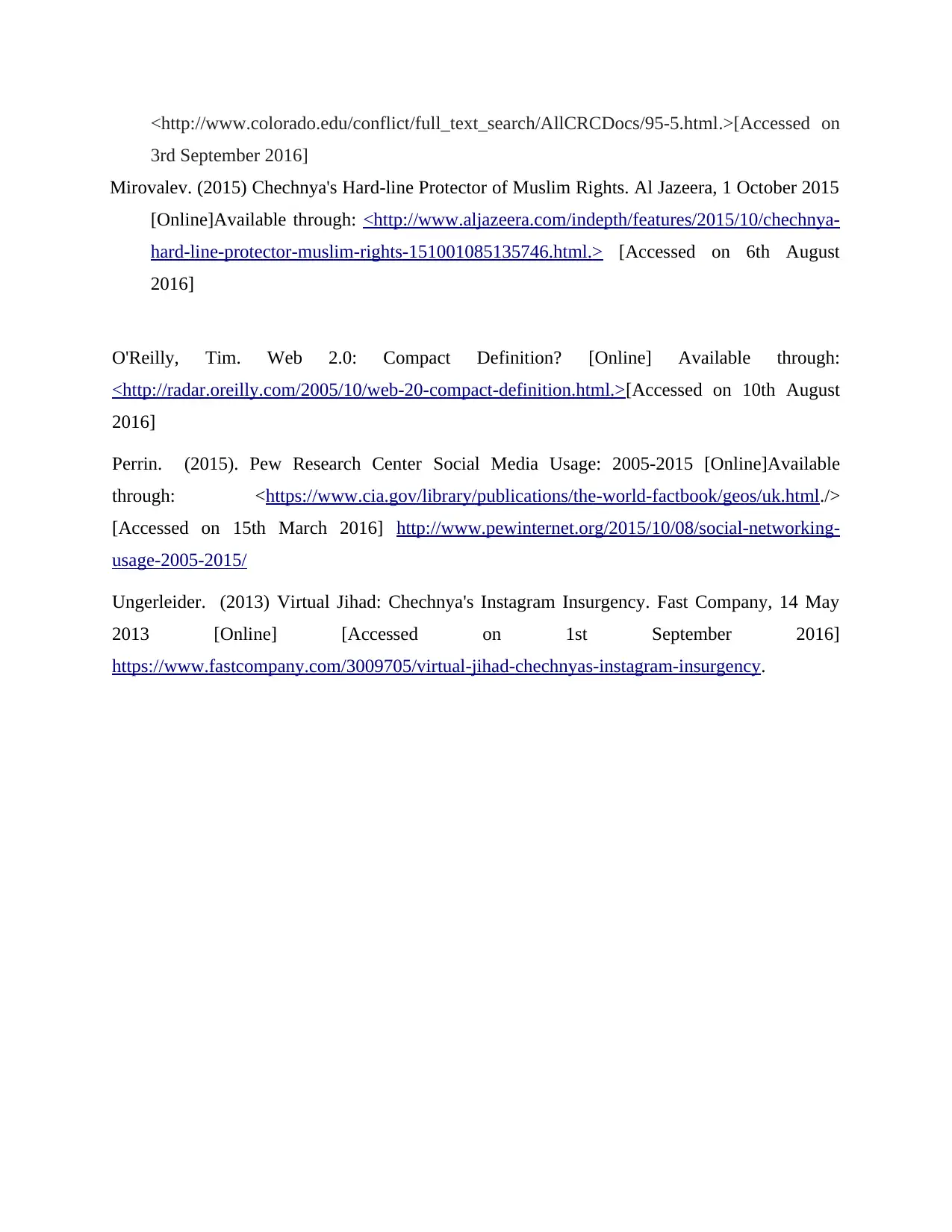
<http://www.colorado.edu/conflict/full_text_search/AllCRCDocs/95-5.html.>[Accessed on
3rd September 2016]
Mirovalev. (2015) Chechnya's Hard-line Protector of Muslim Rights. Al Jazeera, 1 October 2015
[Online]Available through: <http://www.aljazeera.com/indepth/features/2015/10/chechnya-
hard-line-protector-muslim-rights-151001085135746.html.> [Accessed on 6th August
2016]
O'Reilly, Tim. Web 2.0: Compact Definition? [Online] Available through:
<http://radar.oreilly.com/2005/10/web-20-compact-definition.html.>[Accessed on 10th August
2016]
Perrin. (2015). Pew Research Center Social Media Usage: 2005-2015 [Online]Available
through: <https://www.cia.gov/library/publications/the-world-factbook/geos/uk.html./>
[Accessed on 15th March 2016] http://www.pewinternet.org/2015/10/08/social-networking-
usage-2005-2015/
Ungerleider. (2013) Virtual Jihad: Chechnya's Instagram Insurgency. Fast Company, 14 May
2013 [Online] [Accessed on 1st September 2016]
https://www.fastcompany.com/3009705/virtual-jihad-chechnyas-instagram-insurgency.
3rd September 2016]
Mirovalev. (2015) Chechnya's Hard-line Protector of Muslim Rights. Al Jazeera, 1 October 2015
[Online]Available through: <http://www.aljazeera.com/indepth/features/2015/10/chechnya-
hard-line-protector-muslim-rights-151001085135746.html.> [Accessed on 6th August
2016]
O'Reilly, Tim. Web 2.0: Compact Definition? [Online] Available through:
<http://radar.oreilly.com/2005/10/web-20-compact-definition.html.>[Accessed on 10th August
2016]
Perrin. (2015). Pew Research Center Social Media Usage: 2005-2015 [Online]Available
through: <https://www.cia.gov/library/publications/the-world-factbook/geos/uk.html./>
[Accessed on 15th March 2016] http://www.pewinternet.org/2015/10/08/social-networking-
usage-2005-2015/
Ungerleider. (2013) Virtual Jihad: Chechnya's Instagram Insurgency. Fast Company, 14 May
2013 [Online] [Accessed on 1st September 2016]
https://www.fastcompany.com/3009705/virtual-jihad-chechnyas-instagram-insurgency.
Paraphrase This Document
Need a fresh take? Get an instant paraphrase of this document with our AI Paraphraser
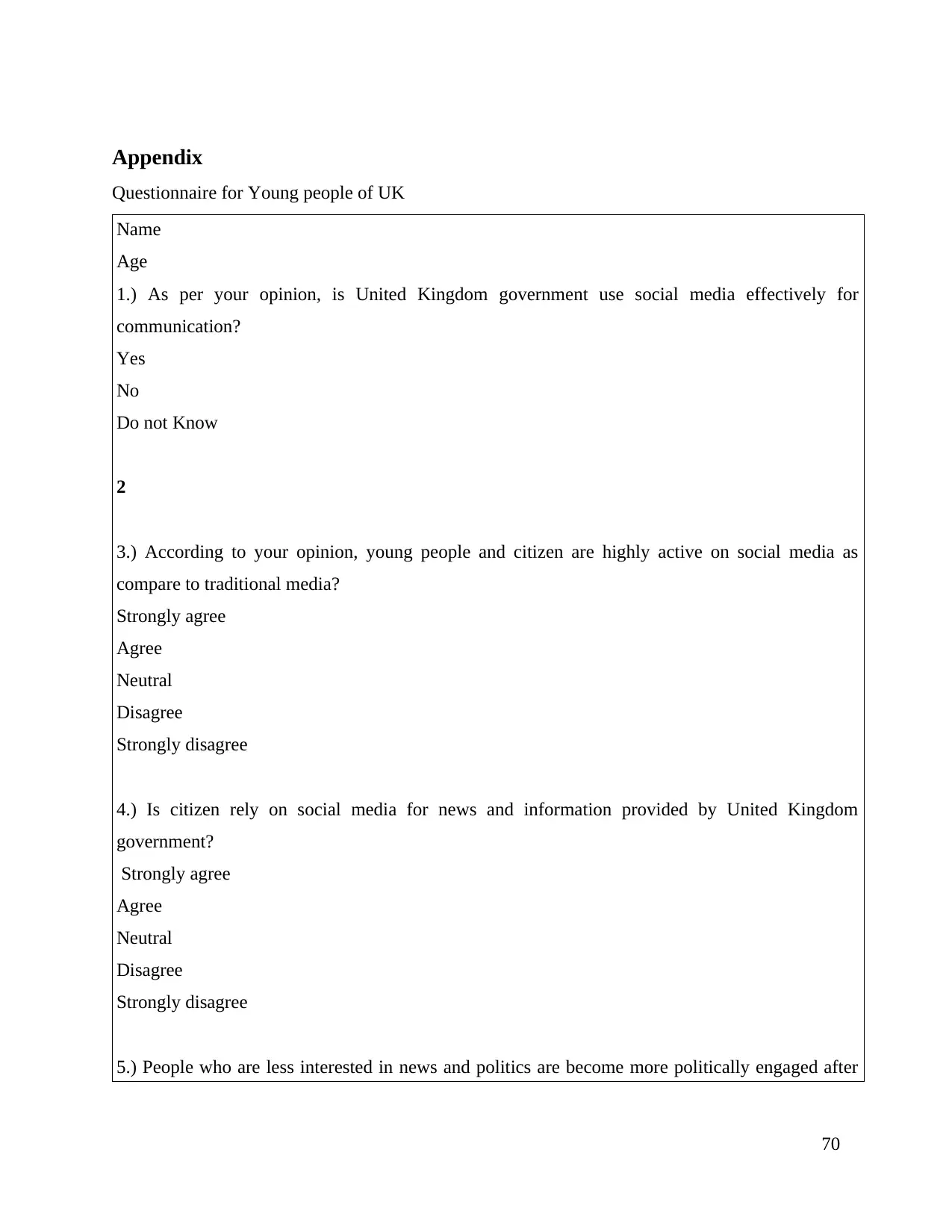
Appendix
Questionnaire for Young people of UK
Name
Age
1.) As per your opinion, is United Kingdom government use social media effectively for
communication?
Yes
No
Do not Know
2
3.) According to your opinion, young people and citizen are highly active on social media as
compare to traditional media?
Strongly agree
Agree
Neutral
Disagree
Strongly disagree
4.) Is citizen rely on social media for news and information provided by United Kingdom
government?
Strongly agree
Agree
Neutral
Disagree
Strongly disagree
5.) People who are less interested in news and politics are become more politically engaged after
70
Questionnaire for Young people of UK
Name
Age
1.) As per your opinion, is United Kingdom government use social media effectively for
communication?
Yes
No
Do not Know
2
3.) According to your opinion, young people and citizen are highly active on social media as
compare to traditional media?
Strongly agree
Agree
Neutral
Disagree
Strongly disagree
4.) Is citizen rely on social media for news and information provided by United Kingdom
government?
Strongly agree
Agree
Neutral
Disagree
Strongly disagree
5.) People who are less interested in news and politics are become more politically engaged after
70
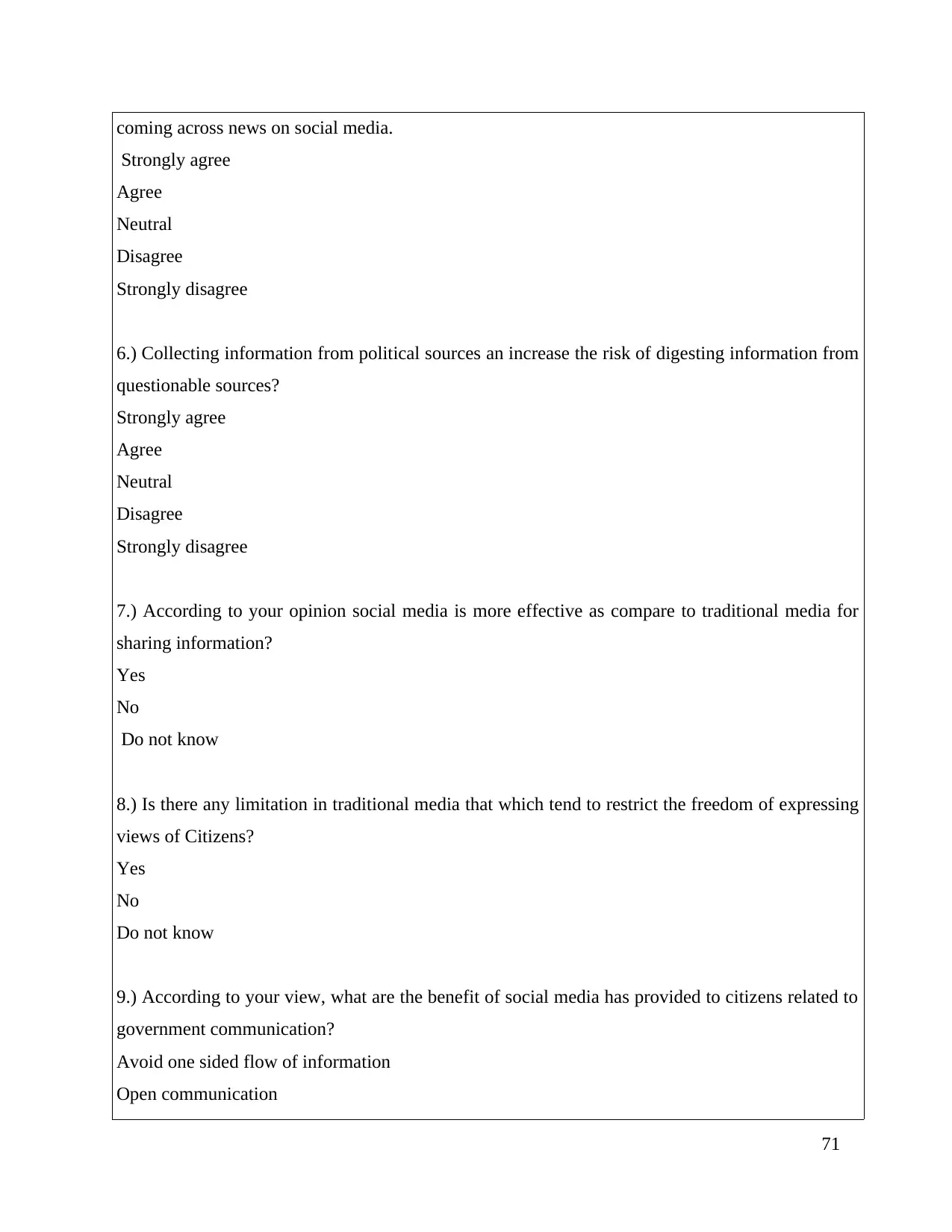
coming across news on social media.
Strongly agree
Agree
Neutral
Disagree
Strongly disagree
6.) Collecting information from political sources an increase the risk of digesting information from
questionable sources?
Strongly agree
Agree
Neutral
Disagree
Strongly disagree
7.) According to your opinion social media is more effective as compare to traditional media for
sharing information?
Yes
No
Do not know
8.) Is there any limitation in traditional media that which tend to restrict the freedom of expressing
views of Citizens?
Yes
No
Do not know
9.) According to your view, what are the benefit of social media has provided to citizens related to
government communication?
Avoid one sided flow of information
Open communication
71
Strongly agree
Agree
Neutral
Disagree
Strongly disagree
6.) Collecting information from political sources an increase the risk of digesting information from
questionable sources?
Strongly agree
Agree
Neutral
Disagree
Strongly disagree
7.) According to your opinion social media is more effective as compare to traditional media for
sharing information?
Yes
No
Do not know
8.) Is there any limitation in traditional media that which tend to restrict the freedom of expressing
views of Citizens?
Yes
No
Do not know
9.) According to your view, what are the benefit of social media has provided to citizens related to
government communication?
Avoid one sided flow of information
Open communication
71
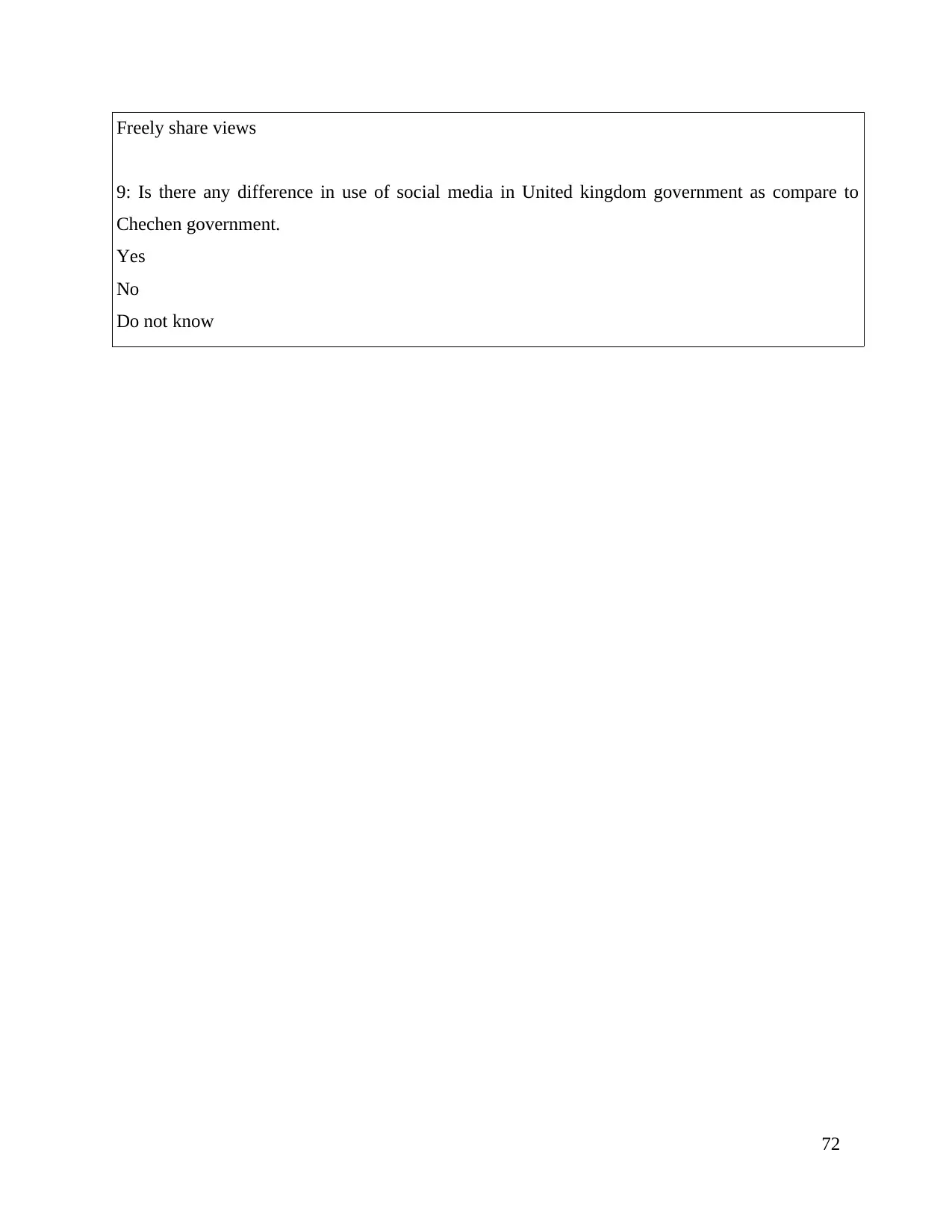
Freely share views
9: Is there any difference in use of social media in United kingdom government as compare to
Chechen government.
Yes
No
Do not know
72
9: Is there any difference in use of social media in United kingdom government as compare to
Chechen government.
Yes
No
Do not know
72
Secure Best Marks with AI Grader
Need help grading? Try our AI Grader for instant feedback on your assignments.
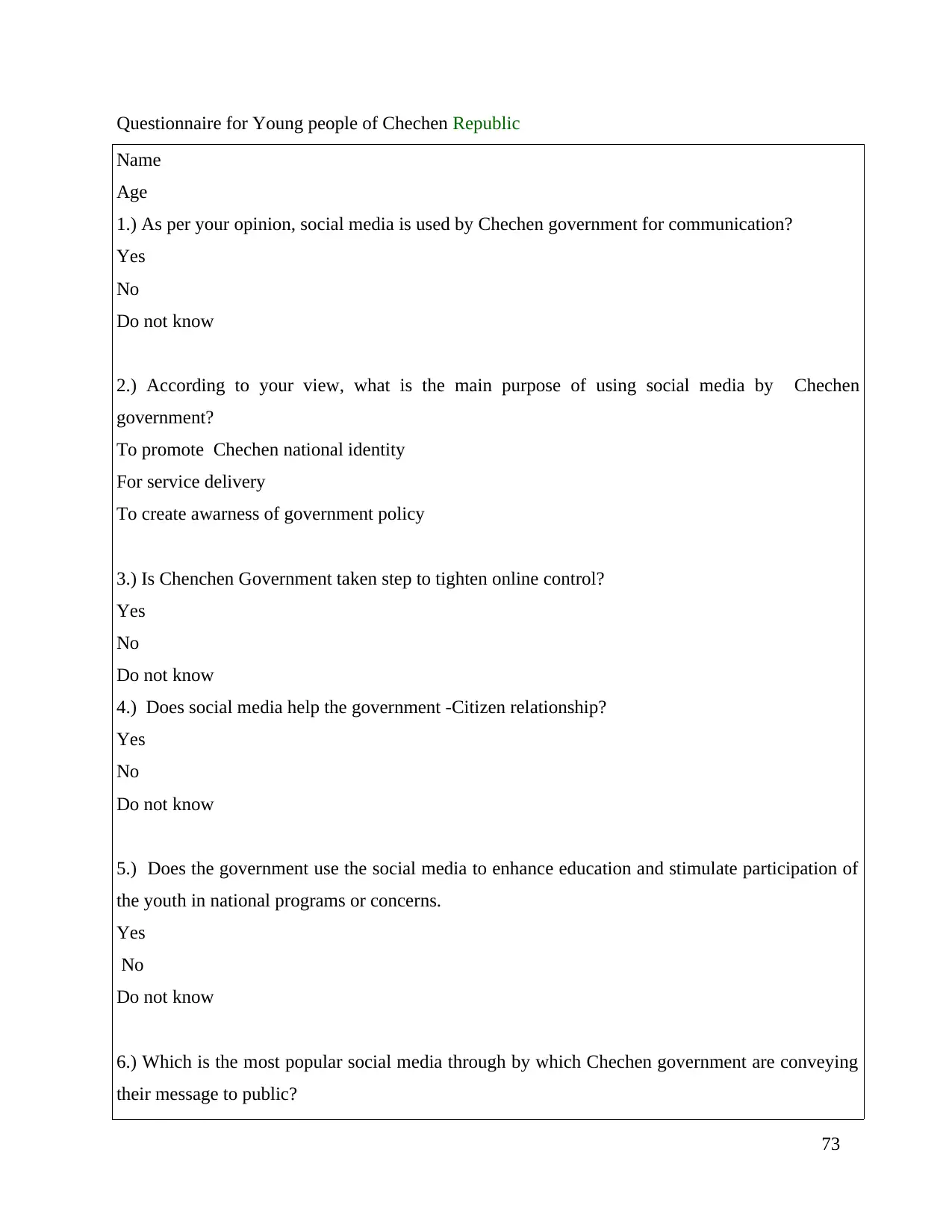
Questionnaire for Young people of Chechen Republic
Name
Age
1.) As per your opinion, social media is used by Chechen government for communication?
Yes
No
Do not know
2.) According to your view, what is the main purpose of using social media by Chechen
government?
To promote Chechen national identity
For service delivery
To create awarness of government policy
3.) Is Chenchen Government taken step to tighten online control?
Yes
No
Do not know
4.) Does social media help the government -Citizen relationship?
Yes
No
Do not know
5.) Does the government use the social media to enhance education and stimulate participation of
the youth in national programs or concerns.
Yes
No
Do not know
6.) Which is the most popular social media through by which Chechen government are conveying
their message to public?
73
Name
Age
1.) As per your opinion, social media is used by Chechen government for communication?
Yes
No
Do not know
2.) According to your view, what is the main purpose of using social media by Chechen
government?
To promote Chechen national identity
For service delivery
To create awarness of government policy
3.) Is Chenchen Government taken step to tighten online control?
Yes
No
Do not know
4.) Does social media help the government -Citizen relationship?
Yes
No
Do not know
5.) Does the government use the social media to enhance education and stimulate participation of
the youth in national programs or concerns.
Yes
No
Do not know
6.) Which is the most popular social media through by which Chechen government are conveying
their message to public?
73
1 out of 77
Related Documents
Your All-in-One AI-Powered Toolkit for Academic Success.
+13062052269
info@desklib.com
Available 24*7 on WhatsApp / Email
![[object Object]](/_next/static/media/star-bottom.7253800d.svg)
Unlock your academic potential
© 2024 | Zucol Services PVT LTD | All rights reserved.





